14 amazing places to go in Patagonia for adventure, wildlife and culture

Nov 29, 2021 • 10 min read

Whether you're looking for wildlife watching experiences or to soak in some hot springs, we have the top places to visit in Patagonia for you © E+ / Getty Images
Covering a massive chunk of southern Chile and Argentina, Patagonia is packed with outdoor adventure. It has some of South America’s best hiking , white water rafting, horseback riding, and wildlife-spotting, but it also gives you the opportunity to dig deeper – into its history, into cowboy culture, and even into the unexpected world of fusion dining at the end of the world.
This guide to the best places to visit in Patagonia will help answer all your questions about where you should go in this region of grasslands and mountains.

Torres del Paine National Park, Chile: go hiking and wildlife watching
You’ll see the characteristic bell-shaped Los Cuernos range and the trident granite towers of Las Torres long before you reach the most popular of Patagonia’s national parks. Torres del Paine is the only national park in Patagonia where you can arrange a multiday bunk-hut to bunk-hut hike while carrying nothing heavier than a day pack, or else opt for camping at well-equipped designated sites.
Chile’s pride and joy is the place for two unparalleled multi-day hikes. The "Circuit" takes you on a seven- to ten-day tour of the park’s undisputable highlights, from up-close-and-personal encounters with the two famous mountain ranges to the challenging crossing of John Gardner Pass, with unparalleled views of Glacier Grey from above. The three- to five-day "W" skips the backcountry trek and the pass crossing, but visits the three big-hitters: Glacier Grey, the French Valley, and Las Torres. Puma and guanaco sightings are frequent, particularly in the backcountry.
Ushuaia, Argentina: head here for cruises to the Antarctic
Every summer in the southern hemisphere finds Antarctica-bound travelers in Ushuaia , Argentina’s southernmost city, waiting to board one of the giant icebreakers in the harbor for the turbulent trip across stormy Drake’s Passage to the world’s remotest continent. You need at least a week to make the trip worthwhile, and money to spare. Last-minute "bargains" can sometimes be had, but you’ll need plenty of time on your hands to hang around, walking the steep streets overlooking the Beagle Channel, and hoping that there’s an empty berth with your name on it. Experienced deckhands can sign up to crew a yacht on weeks-long Antarctic trips.

El Calafate, Argentina: be in awe of vast glaciers
Every day, fleets of buses depart the compact, hugely popular Argentinian town of El Calafate for the Perito Moreno glacier – an accessible icy spectacle, and one of the world’s few advancing glaciers. A series of boardwalks lead to various viewpoints that allow you to contemplate this shining, blue-white wall of ice. Every now then, a muffled "crack" and splash signals the calving of a house-sized chunk of ice. Tour operators in El Calafate also arrange day-long catamaran cruises to more remote glaciers, such as Glacier Upsala Glacier Spegazzini on Lake Argentina. With its proliferation of boutique hotels and hostels, and a steak-, wine- and craft beer-heavy dining scene, El Calafate is a terrific jumping-off point for exploring the surrounding natural wonders.
Isla Navarino, Chile: experience end-of-the-world adventures
Whenever Puerto Williams – the "capital" of Chile’s Isla Navarino – is mentioned, Ushuaia turns green with envy because this tiny settlement of less than 3000 people beats the capital of Argentinian Tierra del Fuego to the title of southernmost permanently inhabited place on earth. Whether you’re swapping stories with centolla (king crab) fishers and Antarctica-bound research scientists at the town’s only bar, setting off to complete one of South America’s toughest multi-day treks – the Dientes de Navarino – or using Puerto Williams as a jumping-off spot to sail to Cape Horn, you’re likely to earn your adventurer’s stripes here.
Futaleufú, Chile: take on a white water rafting challenge
Imagine: you and rest of the rafting crew are hunkering down on your sides of the raft, waiting for the signal from the rafting guide to dig in and start rowing again like your life depends on it. Huge turquoise river waves are battering the inflatable boat and white water spray drenches you head to foot. You wipe the water out of your eyes and get ready to ride yet another set of Class VI rapids on one of the most challenging white water rivers in the world. The rafting trips take place between December and March, and there are numerous guesthouses in the namesake town that you can base yourself at before embarking on your white water adventure.

Península Valdés, Argentina: spot southern right whales
Picture this: you’re on a boat just off the coast of Península Valdés, a protected chunk of land in northeast Argentina, when a mighty spout of water shoots up from the sea. “Look, a whale!” someone yells, as the waves around you begin to churn with life. Every year, in mid-June, hundreds of southern right whales come to these frigid waters to breed and can often be spotted – sometimes from the shore – until mid-December. The peninsula – also home to sea lions, seals, and over 180 species of seabirds – is reached via the town of Puerto Madryn , where you can sign up for boat tours, kayaking, and diving excursions.
El Chaltén, Argentina: the starting point for amazing day hikes
Overlooked by the three-pronged Mount Fitz Roy peak, the tiny town of El Chaltén is the trekking capital of Argentinian Patagonia. Whether you’re tackling the exposed and challenging trek to the glacial Laguna de Los Tres, ambling though southern beech forest in the private Reserve Los Huemules in the hopes of spotting a huemul (endangered deer), or just walking to the waterfall at the north end of town, there are numerous day walk options to suit all abilities. Roughing it and camping is possible but not mandatory: every evening you can choose to return to your boutique guesthouse or hostel, and grab a hot meal and craft beer at one of the town’s numerous (and sophisticated) dining options, such as La Oveja Negra or Patagonicus .
Puerto Natales, Chile: great boutique accommodations and dining
Whether you’re a trekker or climber bound for Torres del Paine National Park, an ice climber or kayaker wanting to get up close and personal with glaciers, or looking to go horseback riding in the surrounding wilderness, you’ll find yourself in Puerto Natales – Chilean Patagonia’s second-largest town – sooner or later. It's the jumping-off point for every outdoor thrill imaginable. Luxury standouts include The Singular Patagonia (former abattoir turned 5-star hotel), Remota (estancia-meets-wilderness aesthetic), and the ship-like NOI Indigo , while boutique backpacker digs include Treehouse Patagonia, Wild and Yagan House . The dining scene runs the gamut from African-Patagonian fusion at Afrigonia, and inspired seasonal dishes at Lenga , to traditional steak and spit-roasted lamb at El Asador Patagonico, great pizza at Base Camp , and even original Calafate berry gin at the Last Hope Distillery .
Cueva de las Manos, Argentina: home to mysterious ancient rock art
In a hidden canyon, reachable by tour or your own wheels via the towns of Perito Moreno or Bajo Caracoles from the scenic Route 40, a boardwalk leads you past a vast overhanging rock face, decorated with ancient rock art. This Unesco World Heritage Site is one of the most prominent rock art sites in Southern America, with over 800 stencilled outlines of human hands, as well as puma, guanaco (wild cousin of the llama) and ñandú (small ostrich) footprints. The ancient inhabitants of the pampas created these black, white, and ochre stencils by blowing a mix of water and different types of soil against their hand or animal foot, for purposes unknown.
Punta Arenas, Chile: explore the port city's history
Before the opening of the Panama Canal in 1914, every ship rounding Cape Horn en route from Europe to California stopped in Punta Arenas for supplies. In the 19th century, Chile’s southernmost port city by the Magellan Strait grew wealthy from trade and sheep-farming, its riches reflected in the grand stone mansions of the wool barons, the wide avenues lined with cypresses, and the elaborate marble crypts of the city cemetery.
The cemetery is a fascinating place, the names reflecting the nationalities that shaped the city – Scottish, Croatian, Spanish, Scandinavian; you might even find the grave of Charles Milward, a relative of travel writer Bruce Chatwin. Learn about the indigenous peoples of Patagonia at the Museo Salesiano Maggiorino Borgatello , and get a glimpse into the bygone lives of some of the city’s most powerful families at the Museo Regional Braun Menendez . On the outskirts of the city, at the Museo Nao Victoria, you can admire the life-size replicas of Magellan’s ship, Darwin’s HMS Beagle , and the lifeboat that saved the lives of Ernest Shackleton and his crew in the Antarctic Ocean.
Puyuhuapi, Chile: soak in hot springs
If you’re driving or cycling Chile’s Carretera Austral, this historic fjordside town with its wood-shingled houses, founded in 1935 by four enterprising German settlers, makes for an excellent stopover. While thermal springs are common in Chile, Puyuhuapi is the only Patagonian town where you can soak your weary bones. Choose between Termas Ventisquero – the slightly scruffy springs a short walk from town, or arrange to stay in the plush Puyuhuapi Lodge , with private thermal pools and waterfalls, reachable via speedboat across the fjord.

The Pampas: go horseback riding and experience rural life
In popular imagination Patagonia is synonymous with the Pampas – grasslands that stretch as far as the eye can see – and its inhabitants, the intrepid cattle herders known as gauchos in Argentina and huasos in Chile. You’ll often see them on horseback all over rural Patagonia, wearing sheepskin ponchos and berets, and sipping from flasks of yerba-mate herbal tea. Visitors can experience this rural way of life by staying on an estancia (ranch). Estancia stays can be organized from Puerto Natales (Chile) or El Calafate (Argentina); these typically include horseback riding excursions, as well as spit-roasted lamb asado (Patagonian barbecue).
The Carretera Austral, Chile: take an epic road trip
"Southern Highway" is a bit of a misnomer, as you’ll discover if you drive Chile’s remote, iconic road. Originally constructed on Pinochet’s orders in the 1970s, and still only partially paved, it winds itself some 694 miles (1117km) from Hornopirén in the north to Villa O’Higgins in the south, traversing fog-shrouded, often rainy landscapes of lush southern forest and giant wild rhubarb, snow-tipped mountains, and misty fjords.
Allow at least a couple of weeks to explore the unique little towns and national parks along the way. It’s possible to rent a car either in Puerto Montt , north of Hornopirén, or else in Coyhaique , the only town of any size, located halfway along the Carretera Austral.
Punta Tombo, Argentina: see penguins and other birdlife
You smell the penguins before you see them. The presence of nearly a million Magellanic penguins – some hiding in their underground burrows, some ambling down to the sea to go fishing, others standing around and grooming themselves – is a powerful assault on your senses. The long, narrow peninsula that’s home to the largest and most accessible of the penguin colonies that dot Patagonia also attracts kelp gulls, cormorants, flightless steamer ducks, and black oystercatchers. Visitors can stroll along the boardwalks past the beach and the nesting areas; get here either via your own wheels (early in the morning) or by tour from the nearby town of Trelew.
You might also like: 12 unmissable hikes in Patagonia: wonder at the pristine wilderness I went on a solo trip to Patagonia (and I loved it) Argentina's best road trips promise adventure
Explore related stories

Budget Travel
Jun 17, 2024 • 6 min read
Experience the best of Argentina without devastating your wallet – here are our tips for traveling on a budget.

Jun 10, 2024 • 8 min read

Jun 5, 2024 • 5 min read

May 22, 2024 • 8 min read

Mar 14, 2024 • 8 min read

Jan 17, 2024 • 8 min read

Dec 1, 2023 • 6 min read

Oct 18, 2023 • 5 min read

Sep 26, 2023 • 7 min read

Sep 21, 2023 • 7 min read
- Search Please fill out this field.
- Manage Your Subscription
- Give a Gift Subscription
- Newsletters
- Sweepstakes
The Best Way to Experience Patagonia, According to a Travel Expert
Patagonia is the place that bucket lists were made for. Stretching across the southern tip of both Chile and Argentina, Patagonia is rugged, sparsely populated, and astonishingly beautiful. Vast plains are crisscrossed by puma and guanaco trails, Andean condors’ with their 10-foot wingspans sometimes circle 40 feet above your head, there are ancient glaciers to sail to and old-growth forests to explore.
Getting there is hardly a walk in the park and the weather is notoriously unpredictable — pack layers and be ready to be flexible—but, having just returned from the End of the World, I can say this: It is not only worth the journey, it is on my list of places to visit again.
How to Get There
The long and short of it? The journey to the End of the World is long, not short. If you are coming from North America, there is one big perk: it is a red-eye flight both ways and it is the same time zone so you maximize your vacation time and you don’t have to deal with jetlag. You have to fly through Santiago if you are headed to Punta Arenas or Puerto Natales on the Chilean side. You fly through Buenos Aires in Argentina if you are going to Ushuaia or if you are en route to the South Pole or an Antarctica cruise. Also, if you’re planning to visit during high season (the Southern Hemisphere’s summer, October to early May), book farther in advance than you think you need to.
LATAM Airlines has incredible connectivity in the area with year-round daily flights between Santiago and Punta Arenas — as well as Puerto Natales which is closer to Torres del Paine when it is high season — but they do sell out. For the international flight, LATAM’s 787s are awesome — definitely treat yourself to one of their lie-flat beds.
Where to Stay and What to Do
There are a number of luxury lodges to choose from, but Tierra Patagonia is my top pick. It is perhaps the best example out there of a hotel blending into its surroundings — and with a backdrop like Patagonia, this is a stunning achievement.
Tierra is located outside of the official boundaries of Torres del Paine — so unlike the other hotels in the area, there are not as many restrictions on activities (horseback riding, for example, is much more regulated if you are inside the national park). It is worth noting that Tierra’s location outside of the park is by no means a step down in terms of scenery. It is Patagonia after all, and the views of incredible jagged mountains, glaciers, desolate plains and awesome lakes are hardly exclusive to the official park land.
The Offerings
Despite being in the middle of nowhere, the service and offerings are on par with any five-star resort worldwide. The dining options are versatile — gourmet, vegetarian, hearty, healthy and the servers know all the details on the menu. It is really amazing given how remote the property is. It’s also thoroughly delicious, which is key because if you partake in Tierra’s activities, you will be hungry.
The full-service spa is top-notch. It is not a Swiss Mountain spa destination, but it is incredible considering its location. To give an example of the level of service and their attention to detail and flexibility, we had scheduled post-hike massages, but mid-hike, we took a detour because we wanted to go farther into the park. The spa concierge radioed our guide and after a very efficient back and forth, we were seamlessly on our way, massages postponed to match our new ETA.
Tierra also encourages a feeling of community and camaraderie at the resort. With only 40 rooms, it is impressive that they have created a social, welcoming common space — this may be helped by the many open bottles of Chilean wine, cocktails, tea and snacks laid out for guests. The general manager, Nick Russ, is also around and he is more than generous with his time. Equally generous with their attention, the guides who lead the hotel’s excursions come and go throughout the day and they are very experienced, well educated and simply, fun to talk to.
The guides are more than just knowledgeable and friendly—the level of personalization they work at is unmatched. A lot of hotels send incoming guests a lot of information to pre-plan the itinerary, but Tierra waits until you arrive to have a one-on-one itinerary planning session. This makes sure that unforeseeable factors like the weather and how you are feeling post-flight are factored into the plan. This personalized attention to detail and thorough understanding of specific abilities and objectives is something very similar to having a great relationship with a travel agent.
The Activities
Try a half-day hike around Lake Sarmiento, the hotel’s “backyard.” Expect to see eagles, condors, guanaco (which may be on the dinner menu), foxes and ñandú (a type of ostrich), fossilized thrombolites and incredible views of the Torres del Paine mountain range. Or, do a full-day hike culminating with an impressive view of Torres del Paine National Park’s three granite towers. It is an uphill climb—there are stops and viewpoints and the grade is not terribly steep, but it does require some sense of stamina. However, the view from the top is more than worth it. Do not wear new shoes and definitely bring layers.
Horseback Riding
Starting at the Cerro Guido ranch, you can don chaps and head off into the wilderness towards Sierra del Toro—the panoramic view of the Paine Massif is unforgettable.
Scenic Voyages
Heading to Macizo Paine and sailing to Grey Glacier is the best option if you want to see as much of the park as possible in the shortest amount of time. Your guide brings you through the west side of Torres del Paine National Park with short stops to key photo-op spots. Once you get to Lake Grey, there is an option to board the Grey II and sail out to the famous Grey Glacier.
Birdwatching
A half-day excursion that departs at dawn lets guests get a better look at (and better photos of) Torres del Paine National Park’s 120+ bird species: flamingos, caiquenes, ducks, ñandú (local type of ostrich), woodpeckers, caranchos, eagles and the highlight: the condor.
Flying Home
Instead of retracing our path and flying back to New York City via Santiago, we flew to Buenos Aires and stayed for a night in the city at Faena. I would recommend staying for at least two nights to see more of Argentina's capital — if you can make the logistics work, try to schedule your Buenos Aires stay to include a Sunday. There is a flea market every Sunday that showcases some of the best antiques and local food I’ve ever seen. And, of course, Faena’s Sunday brunch is a meat-lover’s dream.
Related Articles
Patagonia Region
The southern extreme of the planet offers magical experiences, tourism in patagonia: what to do in this region.
This is tourism in Patagonia . It’s magical because its waterfalls, plains, mountains, and native forests encompass a special mystique typical of the End of the World. It’s extraordinary because its landscapes are breathtaking. It’s legendary because what you experience there will be treasured forever.
About Patagonia
What to visit in Patagonia? Glaciers, lakes, forests, steppes, natural wonders declared UNESCO’s World Heritage Sites, among many more. Visiting this region is a one-way ticket to a parallel world where the landscape captivates everyone, the gastronomy delights all taste buds, and the stimuli increase every second. Land of native fauna, national parks, and fairy-tale villages: this is what the places in Argentinian Patagonia offer.
Must-see Attractions
The mythical route 40: its patagonian stops.
A national emblem crossing 11 provinces. In the south, mountains and lakes decorate it, raising the bet and reaffirming the weight of this route for the country.
Los Glaciares National Park, an Icy Paradise
The first to be declared a World Heritage Site. The glaciers in the park originate from the great Patagonian Ice Field, the largest ice field in the world after Antarctica.
Kayaking in Bariloche
You can paddle along the Nahuel Huapi and Moreno lakes in Río Negro. Bariloche offers thrilling water experiences and unbeatable landscapes nestling turquoise waves.
El Chaltén, National Capital of Trekking
This honour was awarded thanks to its impeccable trails marked out in nature. A magical journey that requires being in good physical condition, but that ensures that every second of the tour is worth the effort. The view of Cerro Fitz Roy is beyond compare.
Navigation on the Argentino Lake
Embark on an aquatic adventure through Argentinian Patagonia’s frozen landscapes. Glaciers become the ideal setting to contemplate a natural wonder.
Speed up at the End of the World
The routes connecting Ushuaia, in Tierra del Fuego, are perfect for a road trip surrounded by pure nature. Forests, valleys, mountains, lakes, and Patagonian flora and fauna .
Valdés Peninsula: a Marine Experience among Fantastic Animals
The phenomenon of the southern right whales is known worldwide. In Chubut, animals parade along the coast, offering an experience for all the senses: orcas, penguins, dolphins, and sea lions turn up to join the show.
Water Falling off from the Sky: Waterfalls
Santa Ana, and Dora, and Ñivinco, and Pichi Traful… There are thousands of alternatives to see waterfalls in Patagonia.
What is the weather like in Patagonia?
The region’s climates and temperatures vary across the different geographical points. The average annual temperature is around 10 ºC, with lower temperatures as you go to the south of Patagonia . During winter, in the southernmost extreme, heavy snowfalls are often, making it ideal for practising sports on the mountains. Winds also characterise the Patagonian climate, especially in summer.
Why is it called ‘Patagonia’?
Although the term does not have a clear origin, it is believed that the name derives from the nickname given to the original inhabitants by Magellan’s men, i.e., ‘Patagones’.
What is Argentinian Patagonia’s flora and fauna?
From deer, pumas, and foxes to guanacos, condors, and rheas. The enormous variety of animals living in Patagonia is wide due to the diversity of its landscapes and climates. In particular, the maritime group holds a special place with the arrival of southern right whales, which share a stage with Magellanic penguins, sea lions, orcas, and dolphins.
On the other hand, the flora embraces native forests and steppes, with examples of cypresses and larch trees, as well as typical bushes, such as the Magellan barberry. Lupins bloom in spring with their characteristic intense purple colour.
Can you drink water from rivers?
The western region of southern Patagonia has a valuable water network that constitutes one of the most important drinking water reservoirs in the world. So, if you are travelling to Patagonia , you must drink the water that flows along its crystal-clear rivers.
What provinces does the region of Patagonia include?
The Patagonia region is made up of 6 provinces: La Pampa, Neuquén, Río Negro, Chubut, Santa Cruz, and Tierra del Fuego.

The Best Patagonia Itinerary: 7 to 10 Days in Patagonia [Or More]
Patagonia is a fascinating place. With its wild weather, beautiful hiking trails, and picturesque glaciers, it’s an adventure playground.
I loved every minute of my trip to the region. But before I arrived, I had hundreds of questions (which you probably do too)!
“How many days in Patagonia?”
“Which is better: Chile or Argentina Patagonia”
“Can I visit Patagonia without a tour?”
Now that I’ve been there and spent over a month exploring the Chilean and Argentinian side, I’ve crafted this perfect 10 day itinerary for Patagonia.
It’s easily customizable to a 7 day itinerary but also includes other places to visit if you have 2 weeks in Patagonia.
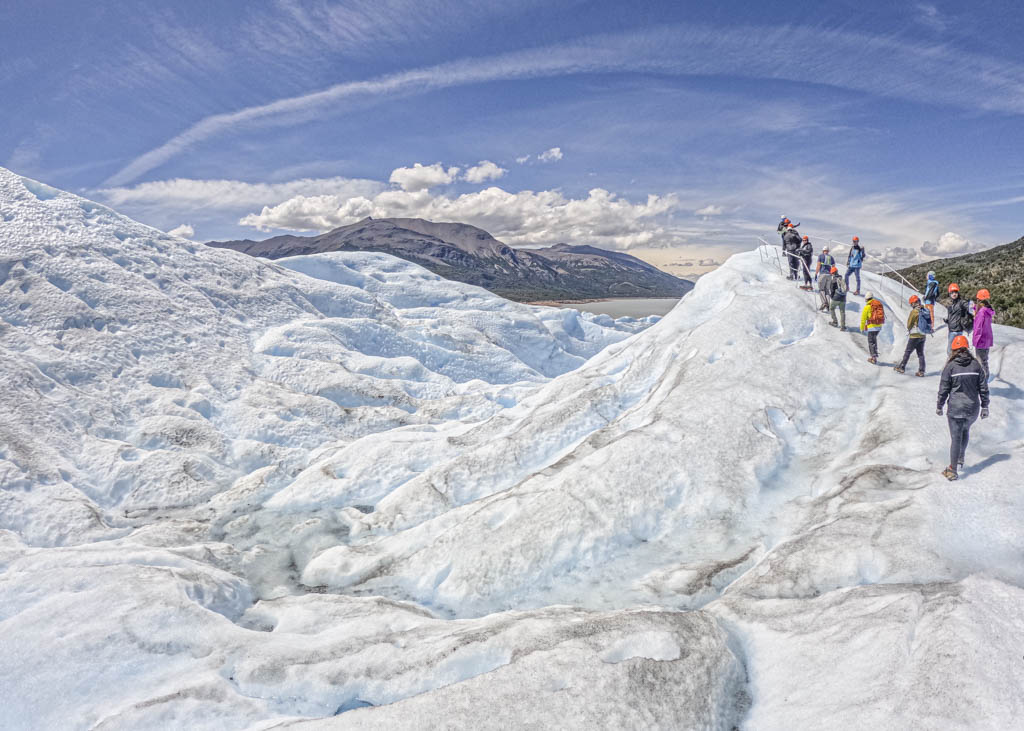
Torn Tackies contains affiliate links. If you make a purchase using one of these links, I may receive compensation at no extra cost to you. See my disclosure for more information.
Quick Navigation
10 Day Patagonia itinerary overview
- Day 1-3: El Chalten (2 nights)
- Day 4-5: El Calafate (2 nights)
- Day 6-10: Torres Del Paine (5 nights)
My Patagonia highlights
My overall favorite place in Patagonia: It’s an easy one! I loved the charming town of El Chalten in Argentinan Patagonia.
Most beautiful place: I still can’t get over how stunning Perito Moreno Glacier is! I did this Mini Trekking glacier tour from El Calafate, and it was one of my Patagonia highlights.
Best multi-day hike in Patagonia: The W Trek in Torres Del Paine, Chile. This hike allowed me to experience the real Patagonia. I had all four seasons in one day and saw landscapes I never knew existed.
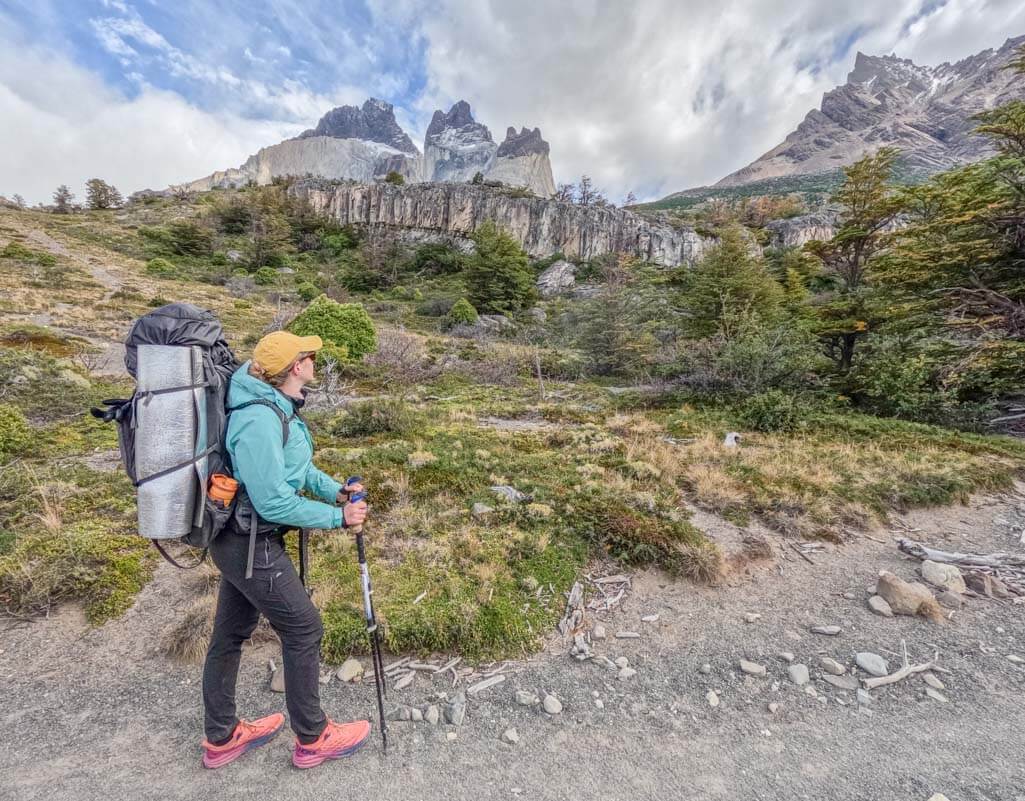
Day 1: Buenos Aires to El Chalten: Hike to Mirador Condores
Surrounded by snow-capped peaks, El Chalten is a small hiking town home to some of the best trails, which I’ve detailed in my El Chalten hiking guide.
It’s my favorite place in all of Patagonia. And if there’s one destination you cannot miss, it’s El Chalten.
If you’re coming from Buenos Aires, you’ll be traveling for most of the day. When you arrive in El Chalten, drop off your bags and put on your hiking shoes!
Mirador de los Condores is a quick and easy hike that’s perfect for day 1 of your Patagonia itinerary. It offers the best views of El Chalten and takes roughly 2 hours to complete.
Top tip: The sun sets after 9 pm in Patagonia during the summer, so you’ll have more than enough time for this hike, so long as you arrive before 6 pm.
How to get to El Chalten
There is no airport in El Chalten. The closest airport is in El Calafate, which services flights from Buenos Aires, Bariloche, and Mendoza in Argentina.
You’ll then need to take a 3.5-hour bus from El Calafate to El Chalten. I booked my bus through Bus Bud . You can check prices and availability here .
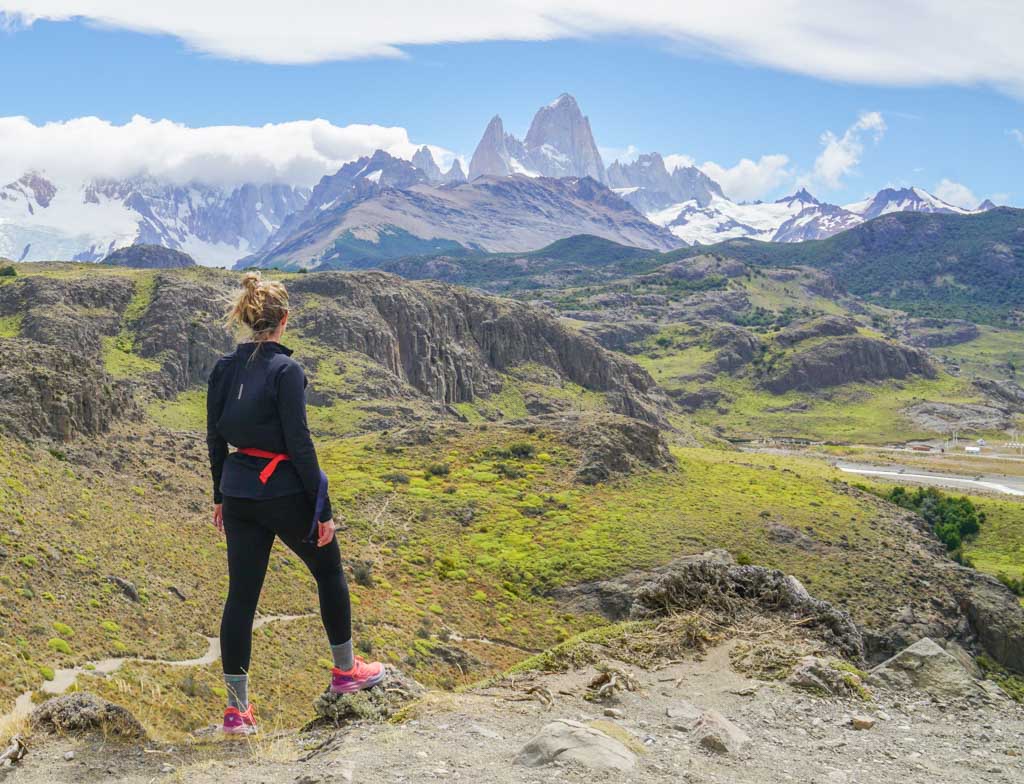
Where to stay in El Chalten
Patagonia is generally a lot more expensive than the other destinations in Argentina.
If you leave it too late, the more affordable options will be taken, and you’ll have to settle for something a bit further from town or out of your budget.
Apart Guillaumet is a basic accommodation option that ticks all the boxes, including an affordable price.
If you’re looking for something more luxurious, you can’t go wrong with Chalten Suites Hotel . There’s an onsite restaurant, and it’s just a stone’s throw away from the trails.
Day 2: Laguna de Los Tres hike (El Chalten)
Laguna De Los Tres is the crown jewel of El Chalten. It’s a turquoise blue lake at the base of the famous Fitz Roy mountain and offers picture-perfect views.
It’s a challenging 9-hour return hike to get from El Chalten to Laguna de los Tres. You’ll need to be prepared with food, water, and a lot of energy.
It was the hardest day hike I did in Patagonia (but so worth it).
You don’t need a guide for this hike or any others in El Chalten, as the routes are easy to follow and clearly marked. Read my guide on getting to Laguna de Los Tres for more details.
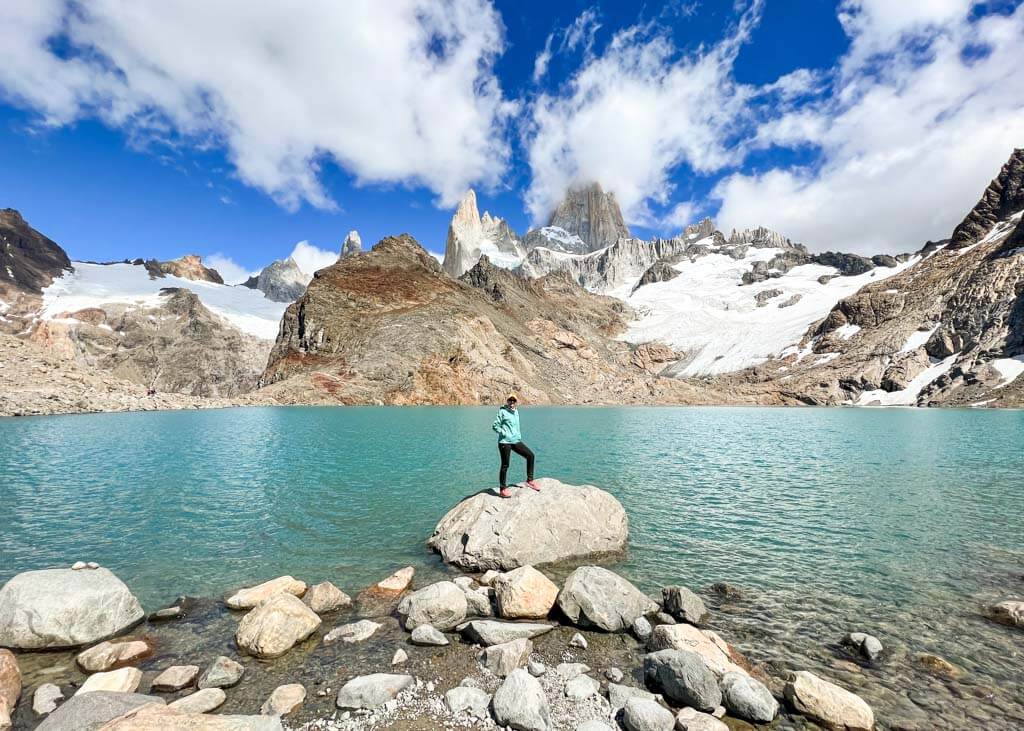
Day 3: Laguna Torre (El Chalten)
Laguna Torre is a vast glacier lake filled with small icebergs. The Cerro Torre Mountain range forms the backdrop and looks like something from a postcard.
The Laguna Torre hike is equally impressive as Laguna de los Tres. The difference? It’s a lot easier! It takes around 6 hours to complete, but most is a flat trail.
Try to start your hike before sunrise to beat the crowds. This will also ensure you’re back in El Chalten by lunchtime.
After the hike, hop on a bus back to El Calafate and spend the night here. It’s time to check out the most incredible glacier in the world!
Other things to do in El Chalten
If one hike in El Chalten is enough for you, or if you have more than 7 days in Patagonia, here are a few other amazing things to do around El Chalten.
White river rafting: I went river rafting in El Chalten and loved it. The rapids aren’t too intense, but they offer a nice break from all the hiking.
Rent a car and make a day trip to Lago del Desierto: Lago del Desierto is a beautiful lake surrounded by forests with picturesque mountain views. Check out Glacier Huemul on the way.
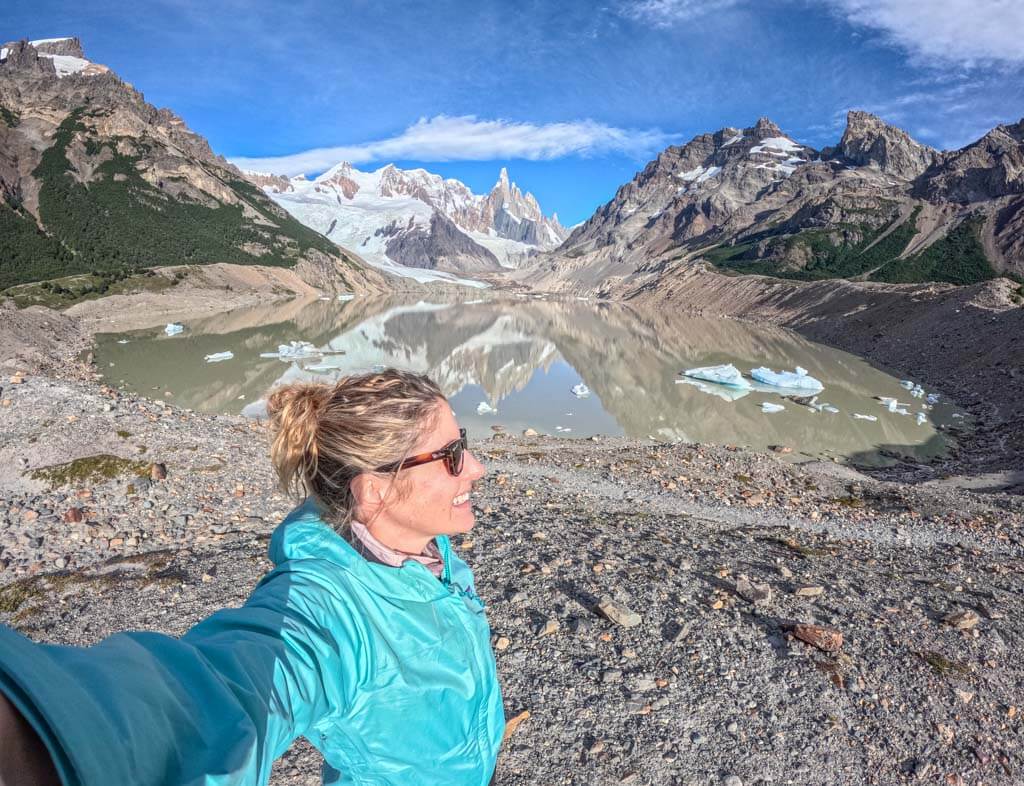
Day 4: Perito Moreno Glacier (El Calafate)
Today, you’ll wake up in El Calafate and make an exciting day trip to one of the most incredible sights I’ve ever seen, Perito Moreno Glacier.
It’s an iconic Patagonia attraction, and its beauty completely blew me away.
Perito Moreno Glacier is located in Los Glaciares National Park, about an hour’s drive west of El Calafate. There are a few ways to experience the glacier.
How to visit Perito Moreno Glacier
Perito Moreno walkways: If you’re on a budget, you can book a bus to the park and visit the walkways only. These comprise of 4 km of interconnected paths that offer panoramic views of the glacier.
Glacier trekking tour: I did this Minitrekking tour , which was well worth the money. Not only do you get to walk on the actual glacier, but it also includes a short boat trip. You’ll have some time to explore the walkways.
Ferry around Perito Moreno: The Minitrekking tour sells out fast, so a good backup option is this boat cruise , which allows you to get closer to the glacier.
Regardless of what tour you do, visiting Perito Moreno Glacier will be expensive! But it’s worth every cent.
Book your spot here , as there is limited availability.
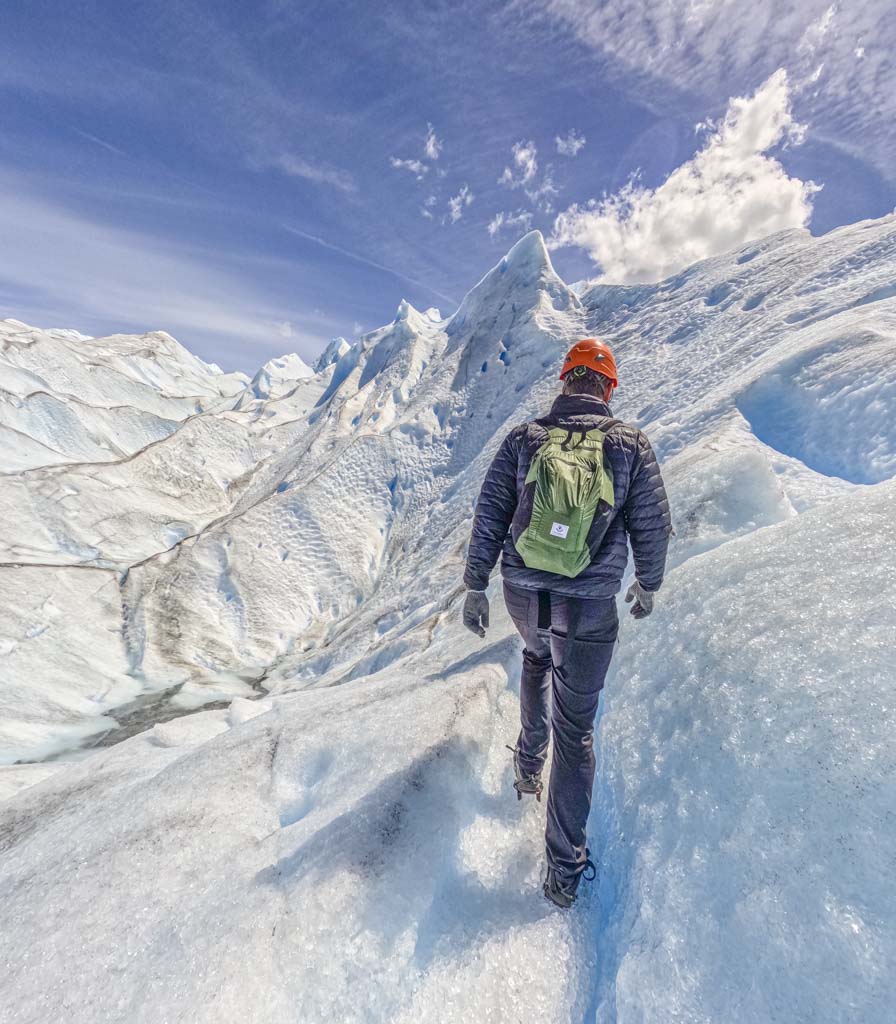
Where to stay in El Calafate
El Calafate is a bigger town than El Chalten, so your accommodation options are greater. It also means that some are closer to the main road than others.
I stayed at Folk Hostel , and it’s a great choice for backpackers. It’s close to the bus terminal, but you’re going to have to walk a bit further to get to the main town center.
Mirador del Lago Hotel has gorgeous large rooms with beautiful views. The breakfasts are exceptional, and it’s perfect for those looking for a more comfortable and luxurious stay.
Day 5 Patagonia itinerary: Puerto Natales
For the second half of your itinerary for Patagonia, there are a few places to visit.
I recommend crossing the border and checking out the Chilean side. You can then fly out of Santiago in Chile rather than crossing the border back into Argentina.
But depending on your time and interests, you may want to visit Bariloche or Ushuaia on the Argentinian side instead.
Where would I go? It’s an easy one! Torres Del Paine National Park in Chilean Patagonia. This park is home to the famous O and W Treks.
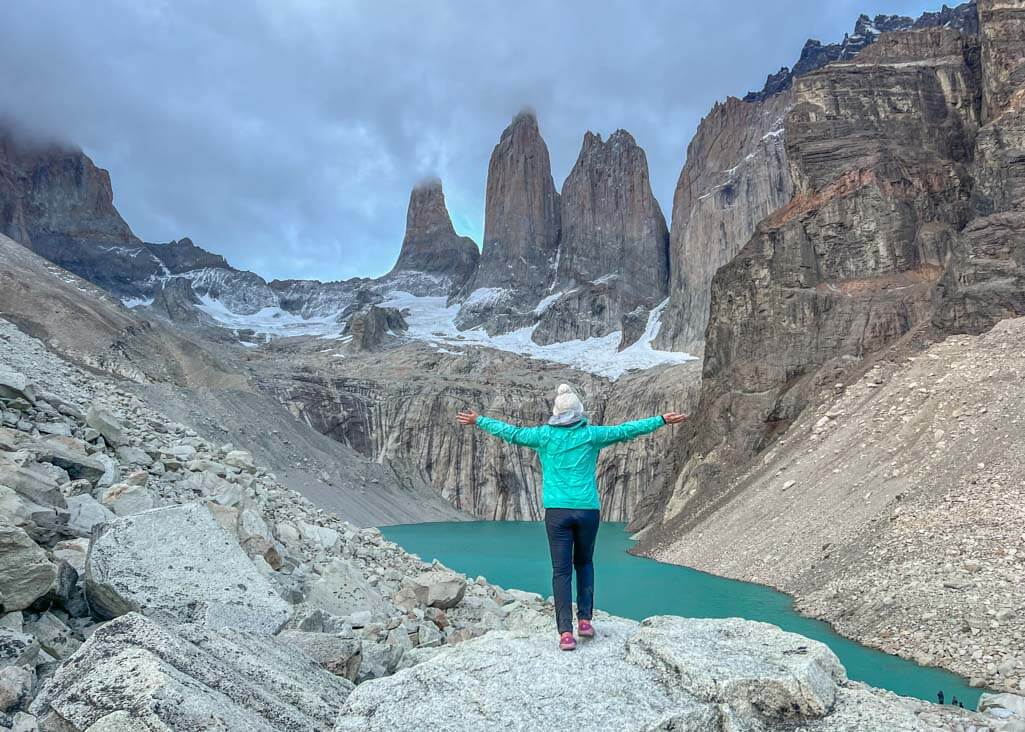
How to get from El Calafate (Argentina) to Puerto Natales (Chile)
Puerto Natales is the gateway to Chilean Patagonia.
Getting here involves an easy border crossing, which you’ll need to do via a bus from El Calafate in Argentina to Puerto Natales in Chile.
The bus drive takes 5 hours but allow for an extra hour at immigration. The buses are extremely comfortable, with large reclining seats. Check prices and availability here.
However, the town of Puerto Natales isn’t as charming as some other towns in Patagonia. So rather spend your first night in Puerto Natales and the rest in the national park.
Where to stay in Puerto Natales
I stayed at El Patagonico Hostel , a fantastic hostel in the heart of Puerto Natales. They offer private and dorm rooms and a big kitchen and lounge area. The price is hard to beat, and they’ll store your bags for free while you do the W Trek.
If you’re looking for a hotel with lake views, you can’t go wrong with The Singular Patagonia Hotel . The elegant rooms are some of the best you’ll find in Puerto Natales, and the staff are outstanding.
Day 6 – 10: W Trek (Torres Del Paine)
The W Trek is a 4-night/5-day trek through Torres Del Paine. It’s not as challenging as you think and can be done independently.
But the notorious Patagonia weather will affect your experience. During my W Trek (which you can read about here ), I experienced the most intense weather conditions.
Sunshine, rain, snow!
I was blown over numerous times while walking through French Valley and had to get down on my haunches to catch my breath. It rained heavily one day. The next, it was sunny and hot.
But despite not having perfect conditions and spectacular views throughout, braving this weather was one of my highlights. I got to experience Patagonia at its finest – the raw and harsh conditions were unlike anything I’d experienced before.
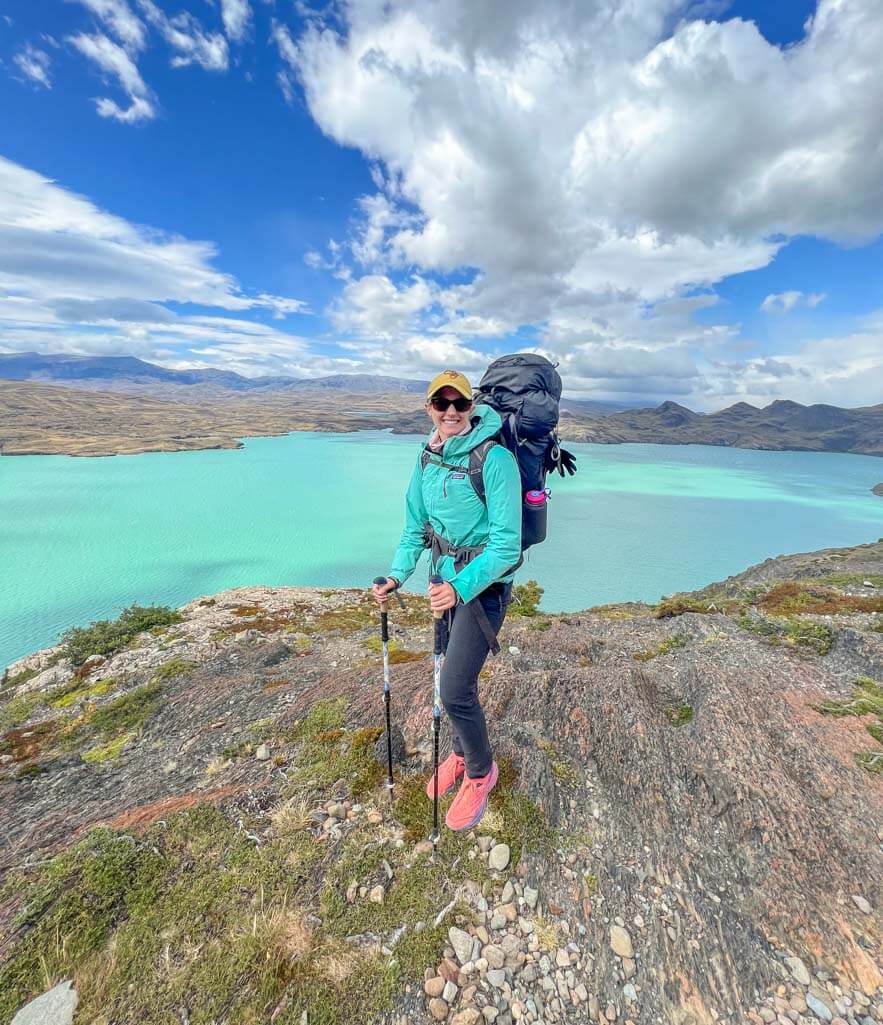
Accommodation on W Trek
If you’re doing the W Trek without a guide, you’ll need to organize your own accommodation. You can choose mountain huts or campsites, but the prices differ substantially.
Bookings open in July every year, and it’s a scramble to get a spot.
Two companies manage the accommodation along the W Trek: Vertice and Fantastico Sur (also known as Las Torres).
Booking your accommodation for the W Trek is a serious mission and highly time-consuming. But it’s the only downside of doing the W Trek independently.
Alternative option: Day trips to Torres Del Paine
Because of limited availability at campsites, your timing, or simply the fact that multi-day hikes are not everyone’s cup of tea, you can also visit Torres Del Paine on day trips from Puerto Natales.
If you’re choosing this option, it’s best to hire a car or take a day tour like this one .
Here are some day trip options:
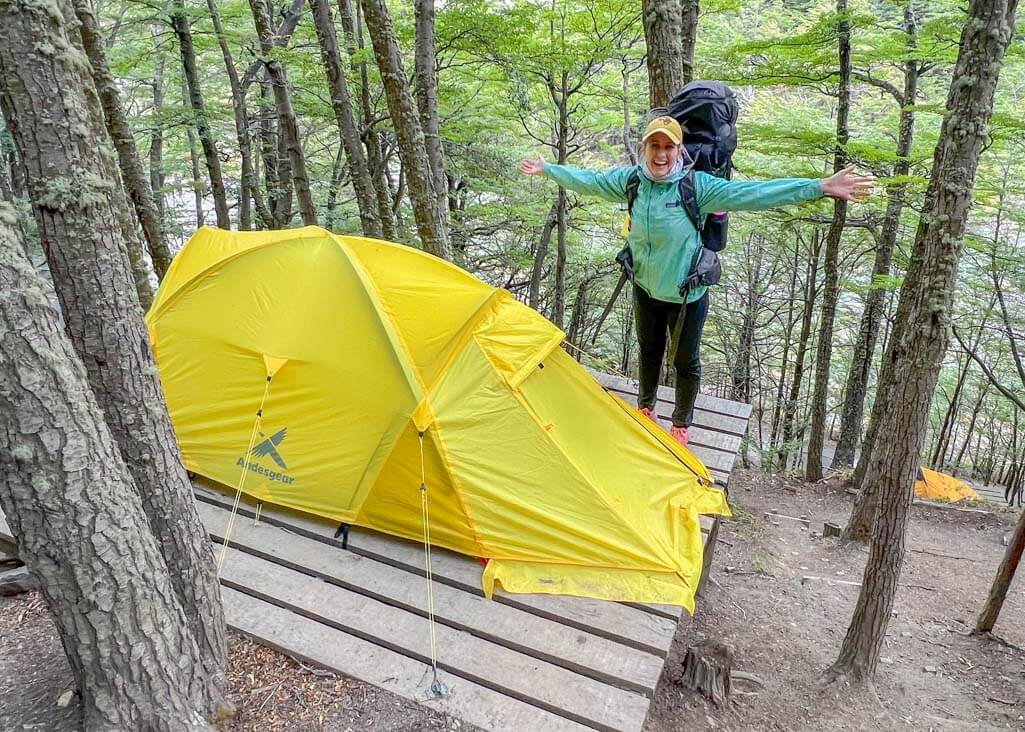
1. Mirador Las Torres (The Towers)
Mirador las Torres is an iconic site in Torres Del Paine. It’s the most popular section of the W Trek and gets busy with day trippers.
Getting to The Towers is a 9-hour return hike that starts challenging and does not get easier. The views are magnificent, though.
This is one of the best day tours from Puerto Natales to The Towers. Check price and availability here.
Top tip: If you’re following my Patagonia 10 day itinerary and struggled with the hike to Laguna de los Tres in El Chalten, skip Mirador Las Torres and opt for one of the below day hikes in Torres Del Paine instead.
2. French Valley
French Valley is the most picturesque day hike in Torres Del Paine National Park.
You’ll need to get on the first bus from Puerto Natales to the park and take the ferry to Refugio Paine Grande. From there, it’s a 2.5-hour hike to Refugio Italiano, which sits at the heart of French Valley.
3. Glacier Grey
Glacier Grey is the biggest glacier in Torres Del Paine and forms part of the western section of the W Trek.
You’ll need to catch the same catamaran as you would if you’re doing the French Valley day hike. But instead of following the trail that leads to French Valley on the right, you’ll go north to Refugio Grey.
Visiting Grey Glacier on a day trip is an ambitious yet achievable goal if you’re a fast hiker. It’s best to rather spend the night at Refugio Grey and head back to town the next day.
Top tip: If you’re planning a 7 day Patagonia itinerary and can only do 2 day hikes in Torres Del Paine, I suggest doing French Valley and Mirador Las Torres (The Towers).
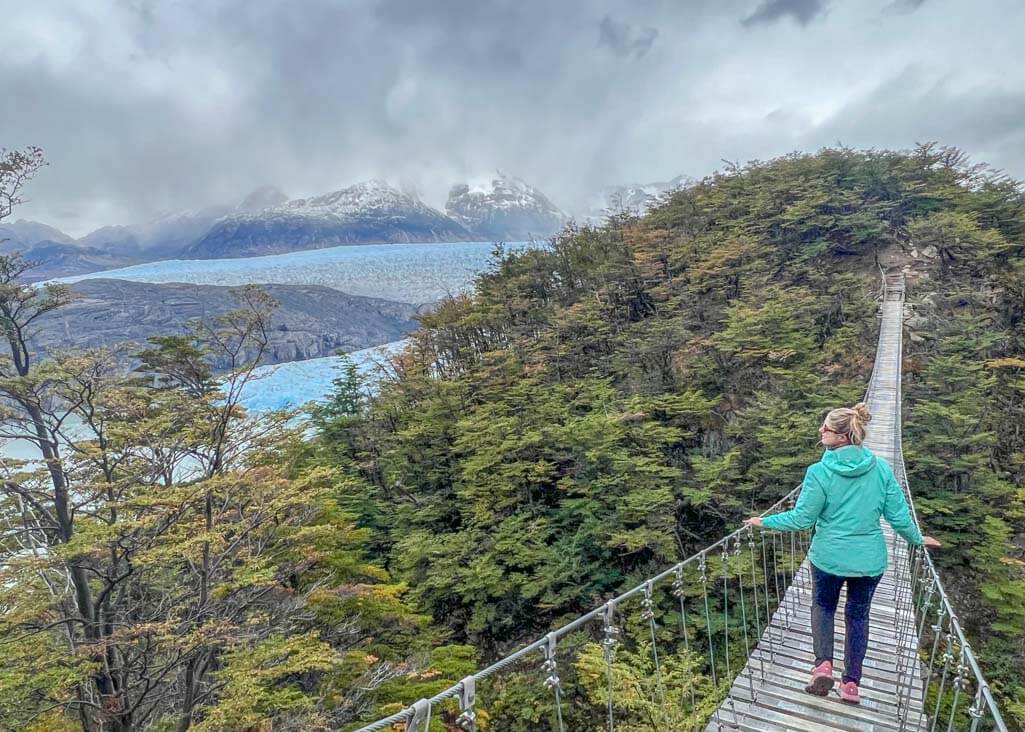
Other places to visit in Patagonia
Some travelers may want to avoid the border crossing from Argentina to Chile.
If this is the case for you, there’s the option to stay on the Argentinian side and explore more of Patagonia from there.
Bariloche is the lake district of Argentinian Patagonia. It’s strikingly different from all other places on this Patagonia trip itinerary.
Bariloche is ideal for travelers who want a break from hiking and prefer a mix of nature and comfort.
It’s best to spend 3 days in Bariloche and possibly even a night in San Martin de los Andes.
Day 1 in Bariloche
Try to arrive in Bariloche by lunchtime, so you have the afternoon to explore the town. The streets are lined with alpine-styled buildings, and the Centro Civico (the town square) is incredibly picturesque.
The Bariloche lakefront is a great place to hang out. It overlooks Nahuel Huapi Lake and is calming and serene.
A beautiful walking path leads from the Bariloche sign along the water’s edge. It passes a skate park and other sites, leading to an iconic Cathedral.
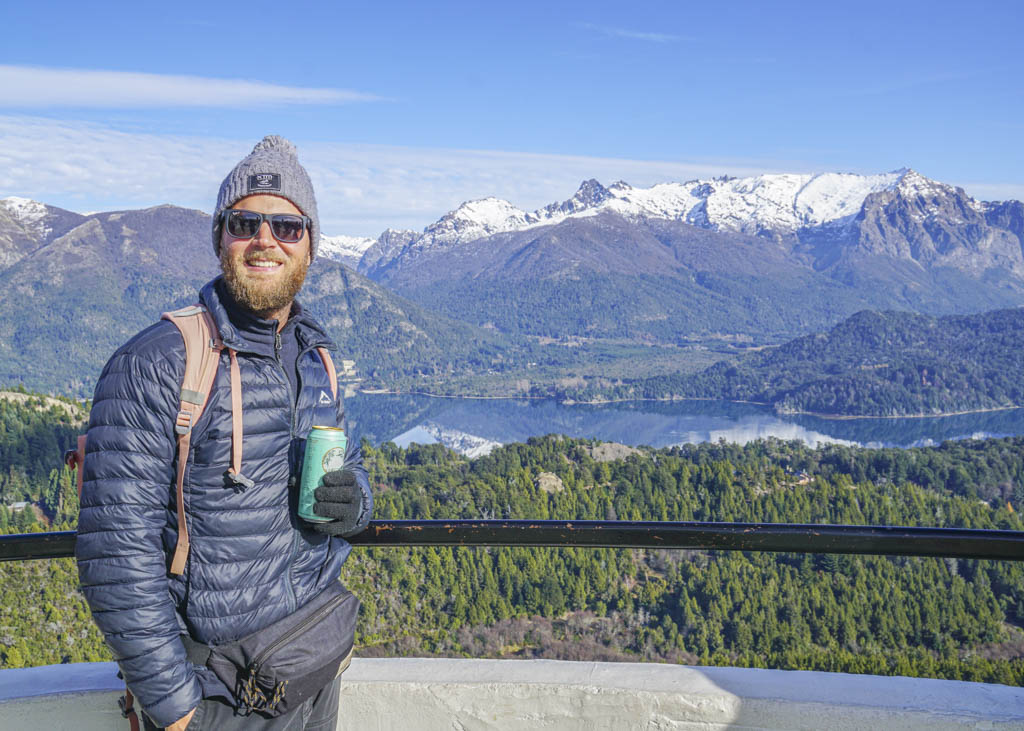
How to get to Bariloche
If you’re skipping the Chilean Patagonia side, or if you have more time in Patagonia and want to add Bariloche to your itinerary, you’ll need to get to Bariloche from El Calafate.
The easiest way is via a quick 2 hour flight between the towns.
Where to stay in Bariloche
Bariloche is a lot bigger than most Patagonia towns. There are many different areas to base yourself in. Unless you stay in the town center, you’ll need to use public buses or rent a car to get around.
I stayed at Trip Select Bariloche , just a short walk from the main road in Bariloche. The private rooms are simple yet comfortable and are great value for money.
Llao Llao Resort is one of the most luxurious places to stay in Bariloche. The location is everything, surrounded by mountain peaks with incredible views from every window. But you’ll need a car to get here.
Deciding where to stay can be overwhelming, so here’s my comprehensive guide to the best areas and accommodations in Bariloche.
Day 2 in Bariloche: Llao Llao National Park & Cerro Campanario
Llao llao national park.
An hour west of Bariloche lies Parque Municipal Llao Llao. It’s home to gorgeous hiking trails and spectacular views.
The most popular trail leads to Cerro Llao Llao, a panoramic viewpoint. You’ll walk up a steep zig-zag trail for 30 minutes to get here.
You can combine this with the Sendero de los Arrayanes trail. This loop track meanders through Parque Municipal Llao Llao, passing lush walkways and the picturesque Lake Moreno. It’s a flat trail and an excellent option for kids.
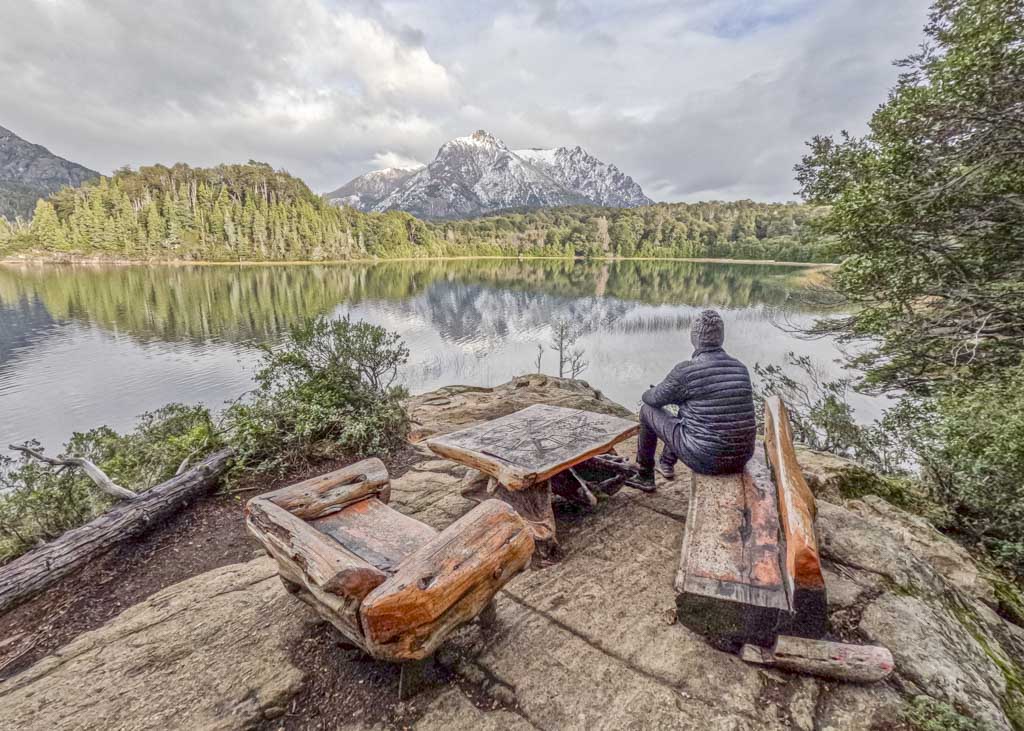
Cerro Campanario
After visiting Llao Llao National Park, make your way to Cerro Campanario. Here, you’ll find the most impressive viewpoint in Bariloche.
The best part? There’s no strenuous hike involved (unless you opt to walk instead of taking the chair lift to the top).
There are numerous viewpoints at the peak, and you’ll have 360-degree views overlooking the lake district. There’s also a small cafe and bar.
Day 8 in Bariloche: 7 Lakes drive or Refugio Frey hike
For the final day of your itinerary for Patagonia, you have two options. You can either explore the iconic 7 Lakes route or do the popular full-day hike to Refugio Frey.
7 Lakes Drive
The 7 Lakes route is one of the most scenic drives in all of Patagonia.
It starts in a lake-side town outside Bariloche called Villa la Angostura and goes north to San Martin de Los Andes.
Throughout the 7 Lakes Drive, you’ll pass seven stunning glacial lakes, dense forests, and picturesque mountain landscapes.
If you have the time, spend a night in San Martin de Los Andes. It will break up the long drive and is a quaint town to explore.
But if you only have a few days in Bariloche, you’ll need to squeeze this into one day, although two days are preferable.
This full-day tour from Bariloche stops at all the lakes. It’s an excellent option for solo travelers or those who would prefer not to rent a car.
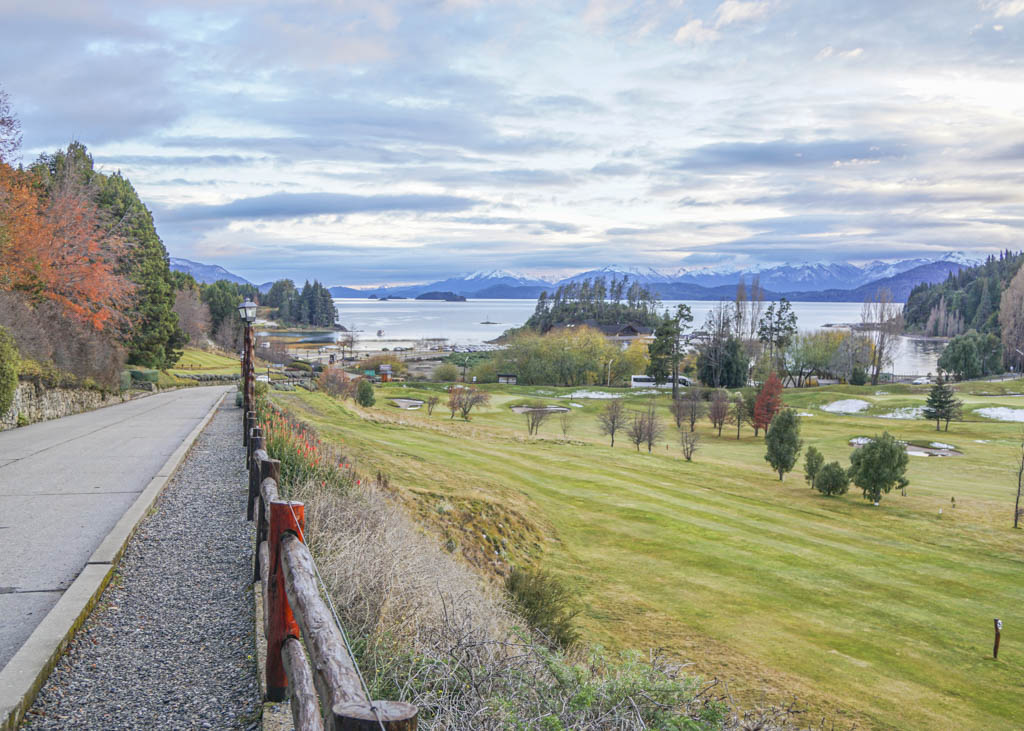
Hike to Refugio Frey
I highly recommend the Refugio Frey trek if you’d rather spend your day hiking around Bariloche as opposed to enjoying the views from a car.
It starts at Cerro Cathedral, which is Argentina’s largest ski resort. The trail ends at Refugio Frey, which sits in front of Laguna Toncek and is surrounded by craggy peaks.
The 22 km return hike takes 8 hours and is more challenging than the other hikes around Bariloche.
Best time to visit Patagonia
The best time to visit Patagonia is from October to April. The days are warmer and longer, providing ideal conditions for hiking and exploring.
Keep in mind that October and November will still be cold, and the glacier lakes may be iced up.
December through February are the best months to visit. But they’re also the busiest.
For less crowds and great weather, March is the ideal month to plan your Patagonia travel itinerary.
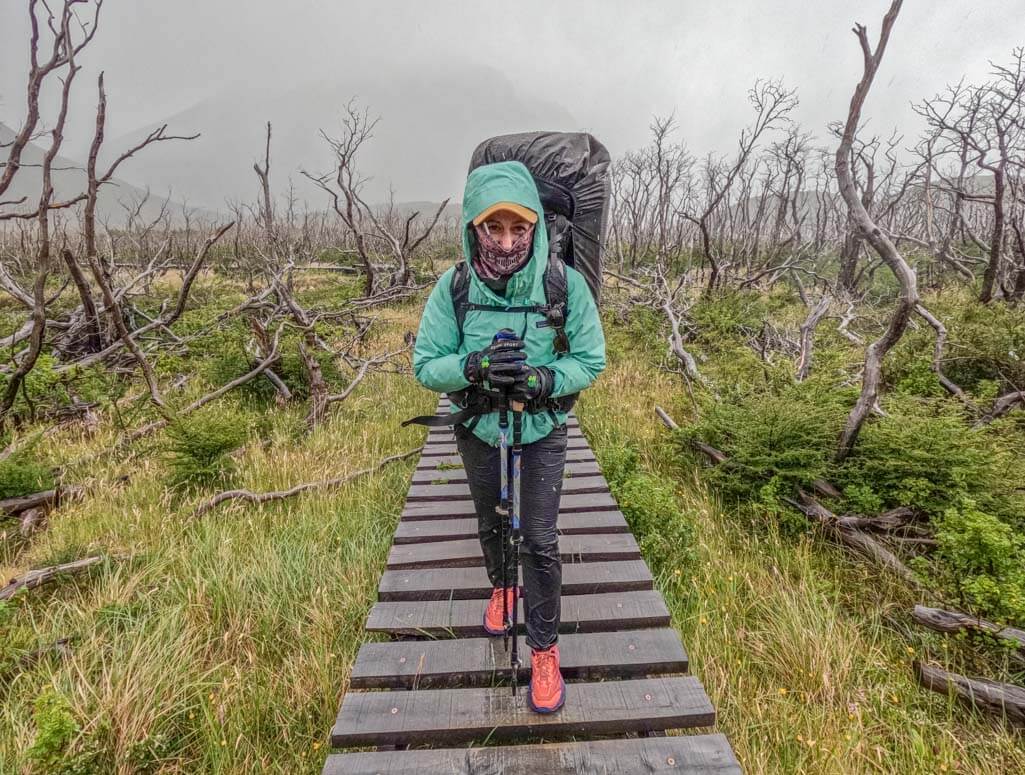
How many days should I spend in Patagonia?
You’ll need at least 7 days in Patagonia. But if you want to travel slower and visit all the attractions, you’ll need 2 weeks.
Which is better: Chilean or Argentina Patagonia
I loved Argentinian Patagonia! It’s home to my favorite places in Patagonia and has incredible hiking trails. It’s also a lot cheaper than the Chilean side.
Which is the best month to visit Patagonia?
If I could choose any month, it would be March. This is the end of high season, so the crowds are fewer. But the weather is still optimal, and you can expect long, sunny days.
Where do you fly into for Patagonia?
You can either fly into Buenos Aires in Argentina or Santiago in Chile. To get to the Patagonia region from there, you must fly to El Calafate or Bariloche in Argentina. Or Puerto Natales in Chile.
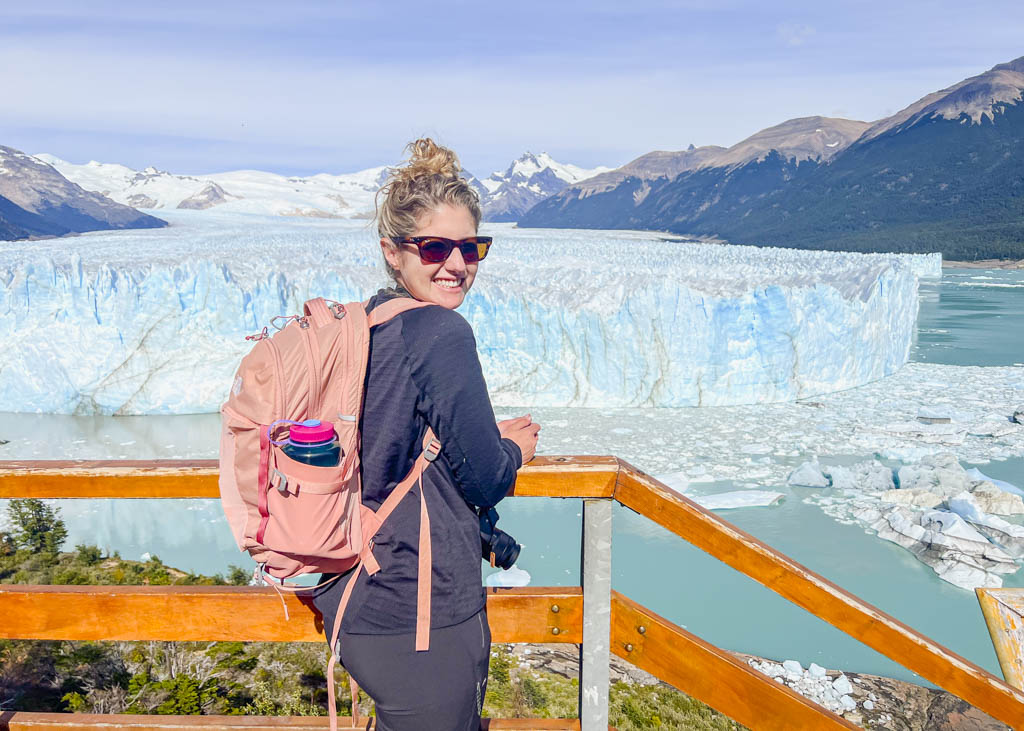
Final thoughts on my itinerary for Patagonia
I spent 7 months backpacking South America, and some of my best memories are from Patagonia.
But remember one thing about the region.
You can do all the planning and preparation for your trip, but unfortunately, you can’t prepare for the weather. It can be unforgiving, even during the summer months, which are said to be the best times to visit.
But no matter what Patagonia brings, embrace it. Enjoy the stunning scenery and take in the power of Mother Nature.
Like it? Pin it!
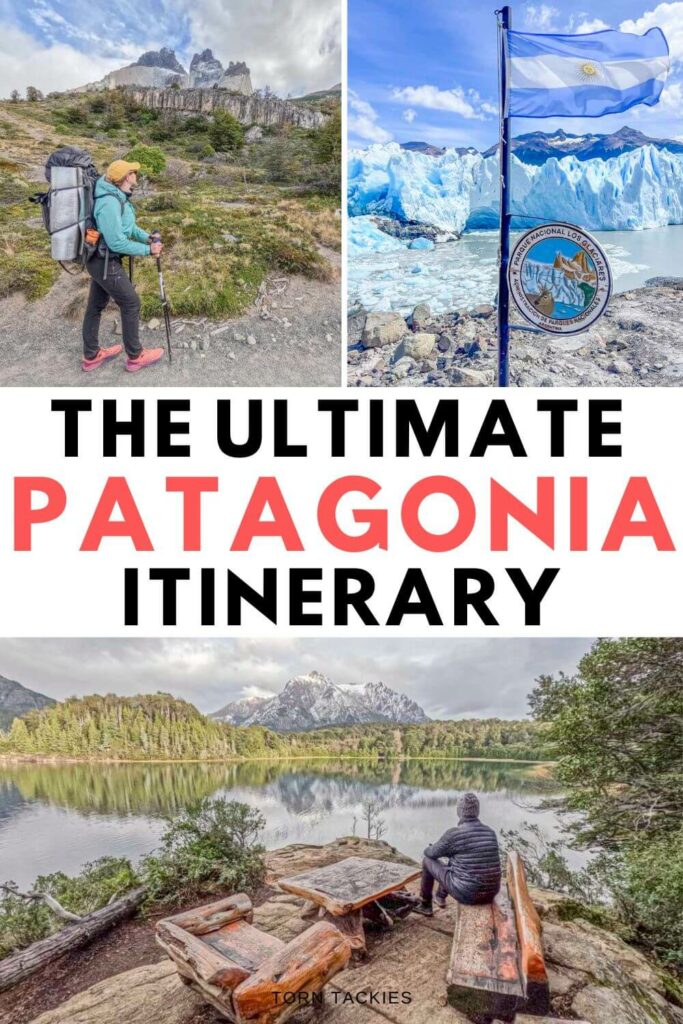
Planning your Patagonia itinerary and have any questions? Drop me a message in the comments section below.
Looking for more Patagonia travel inspiration? Check out my other posts!
- Hiking Mirador De Los Condores in El Chalten
- The Ultimate W Trek Packing List

Hi, I'm Carryn. I’m an adventure travel blogger trying to figure out my way through life by traveling and exploring. Join me as I share my travel guides and tips for life abroad. Find out more about me here .
Where to stay in Cusco (before Inca trail): Best hotels and areas
The best argentina itinerary: how to spend 2 weeks in argentina, leave a comment cancel reply.
A Beginner's Guide to Argentinian Patagonia

A vast and remote region in South America that 402,000 square miles across Argentina and Chile, Patagonia is naturally divided by the Andes, though most of it — about 90% — is Argentinian.
Five provinces (Neuquén, Río Negro, Chubut, Santa Cruz and Tierra del Fuego) make up Argentinian Patagonia, one of the country's more popular destinations for wildlife such as the southern right whale and condor, and extreme outdoor pursuits such as skiing and glacier trekking.
Ready to plan your first trip to Argentinian Patagonia? Here's everything you need to know.
When to Go to Argentinian Patagonia
While hotel, activities and restaurant prices are elevated for local tourists, the Argentinian peso remains weak against the dollar at 43 to 1 following a 2018 devaluation , so it's still a great value. Summer (January to March) and winter (June to August) are peak seasons.
Given that the most southerly point of Argentinian Patagonia is 620 miles from Antarctica, expect the unexpected on the weather front. While the mercury in Tierra del Fuego rarely rises above 60 degrees — where you can also experience four seasons in just a few hours — the Lake District enjoys a sunny summer with average 68 degree days. But always be prepared with extra layers.
Getting Around Argentinian Patagonia
As Argentinian Patagonia is much larger than its Chilean counterpart, at least 12 days are recommended to get a feel for the area. Or, you can fly into one region and enjoy it with a two-night stay. Long-distance buses that are very comfortable and designed for trips of 24 hours or more are a great way to travel between these small southern cities. Otherwise, you can rent a car or fly. There is no rail network.
Accommodation suits all budgets, from well-equipped campsites to five-star hotels. Budget-conscious travelers should check out Cabo Raso in Chubut and Hotel Tirol in Bariloche. For a more luxurious experience, consider staying at Océano Patagonia in Valdés, Correntoso — a participating member of Small Luxury Hotels where you can earn and redeem World of Hyatt points in the Lakes District — or Arakur Ushuaia , a member of Leading Hotels of the World, which has its own loyalty program called the Leaders Club .
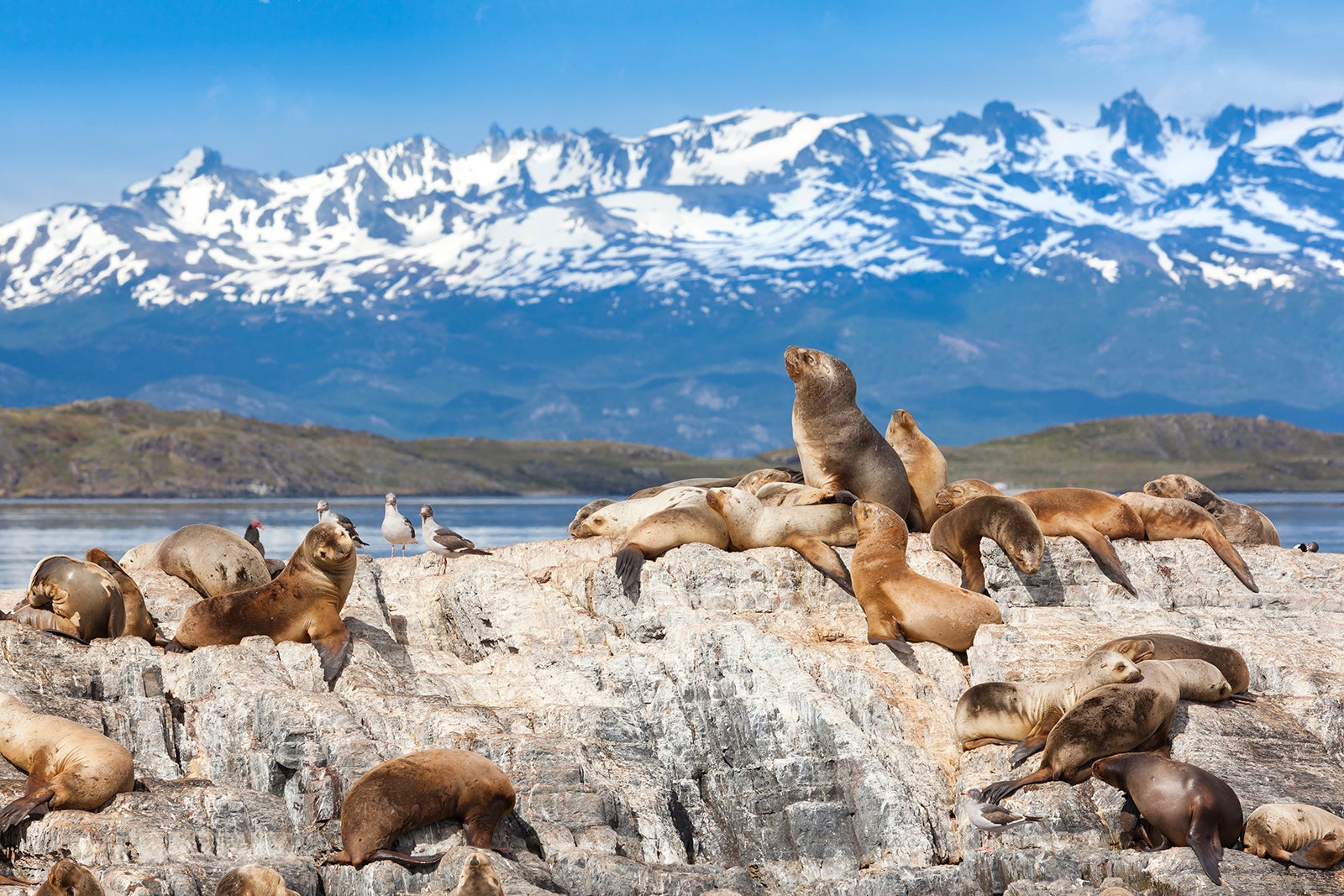
The Difference Between Argentinian and Chilean Patagonia
With a bout 90% — or 361,800 square miles — of Patagonia belonging to Argentina, the eastern side of the region offers a wide array of activities, such as mountaineering, kayaking, snow sports and fly fishing. Isolated small towns and ranches dot this enormous landmass between the Atlantic and Southern Oceans and the Andes; the reason outlaw Butch Cassidy pitched up in this remote region. From north to south, this is what to do in Argentinian Patagonia.
What to Do in the Lake District, Río Negro and Neuquén
Dramatic-looking Ruta de los Siete Lagos is picturesque with its crystalline waters and snow-capped peaks, so consider renting a car to appreciate the Seven Lakes Road. Fly into San Carlos de Bariloche to sample the craft beer route — part of the legendary 3,227-mile Ruta 40, which spans the length of Argentina — at pubs such as Microcervecería Patagonia, then work off the pints on a López Bay hike ; Cerro Catedral ski resort opens between June and September.
Drive north to Villa La Angostura's two lakes, Correntoso and Espejo, where fly fishermen go crazy for trout. Stay at the luxurious Correntoso for doorstep casting and dine at Tinto Bistro — owned by Martin Zorreguieta, brother of Queen Máxima of the Netherlands — in town. Finish the Siete Lagos circuit enjoying Lake Lacar near San Martín de los Andes , gateway to Lanín National Park and Cerro Chapelco ski resort.
The Lake District packs out during July, Argentina and Chile's winter holiday season; for quieter moments, try late August for powder, and December for spring weather and watersports such as kayaking and stand-up paddleboarding.
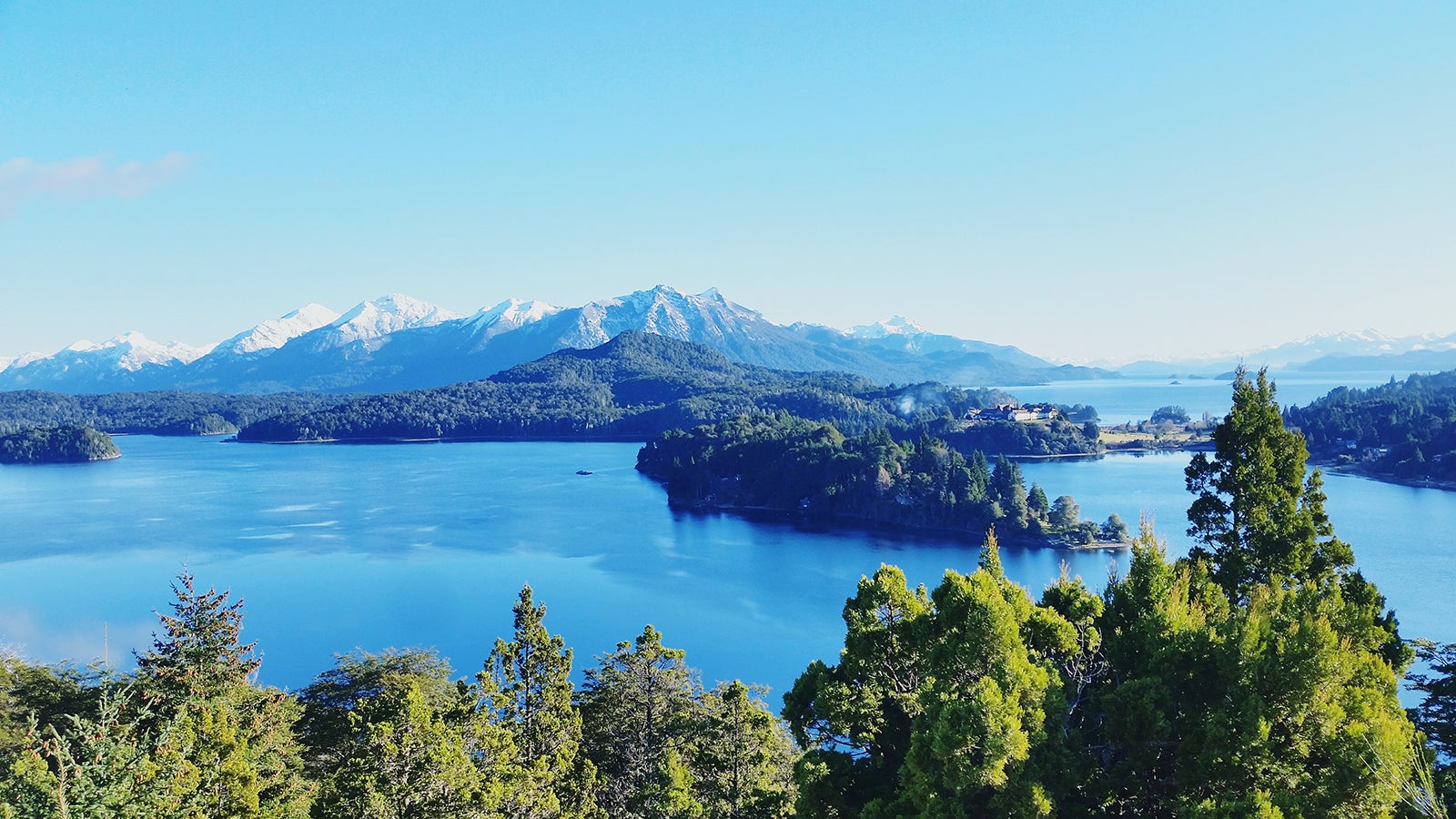
What to Do in the Valdés Peninsula and Chubut
Ringside whale-watching seats are the main draw at Valdés Peninsula , a UNESCO World Heritage Site on the Atlantic coast, and boats depart daily between June and November from Puerto Pirámides to spot the southern right. Known for their white callosities and so-called sailing technique (playfully raising fins in the air), this whale comes here to mate and calve. Wildlife fans can also observe seals, sea lions and orcas, while ostrich-like rhea and guanaco (a relative of the llama) roam the terrain.
Nearby are Welsh-founded settlements Puerto Madryn and Trelew. The latter is a small-town outpost harboring Hotel Touring Club, today a café, where you can see the room where Butch Cassidy holed up, and the MEF Paleontology Museum , which houses 17,000 fossils and remains of titanosaur, the world's largest dinosaur. Argentina's most-populated penguin colony, Punta Tombo, is also nearby, as is Gaiman, where the Welsh character remains strong and there are an array of teahouses.
Argentinians flock here for summer vacation in January and February, when average temperatures reach 80 degrees; visitors numbers also peak in July during whale-watching season.
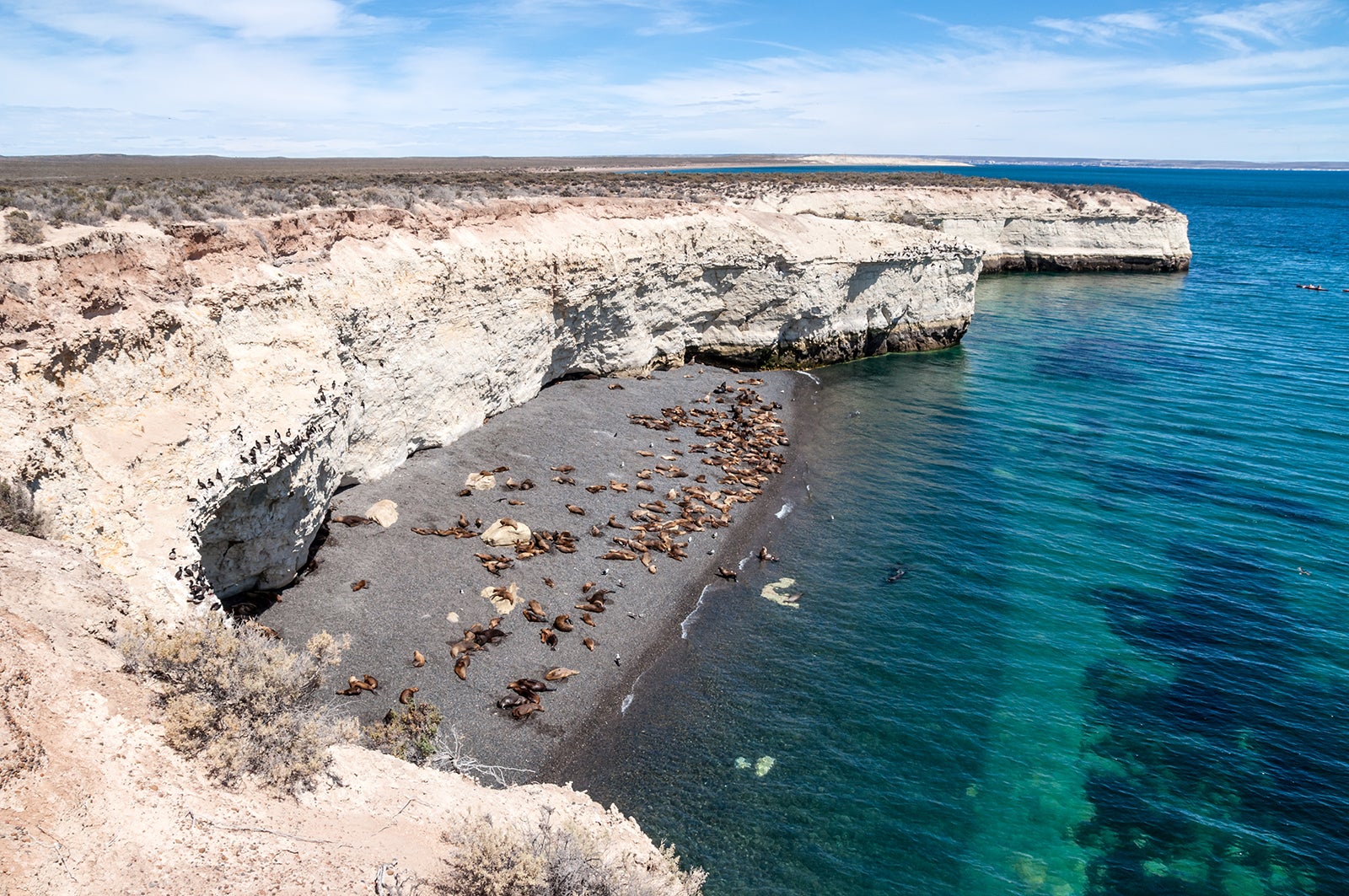
What to Do in Los Glaciares National Park, Santa Cruz
Watch it, snap it, patiently await for a rupture to fall, kayak near it, even scale it — there's little doubt that the vast, electric-blue Perito Moreno Glacier in Los Glaciares National Park is breathtaking.
Many glaciers are retreating due to climate change , but Perito Moreno keeps advancing, its light-blue 240-foot-high face and three-mile-wide behind slowly feeding Lago Argentino. If a selfie with this frozen behemoth onboard a catamaran isn't enough, consider taking an icy hike on top of it (crampons provided). The glacier has been a UNESCO World Heritage Site since 1981 and is located near El Calafate.
Other glacial showstoppers in the national park include Spegazzini, Upsala and Viedma. Take a boat excursion to enjoy all four, disembarking at Onelli Bay for a short hike through the forest and a different perspective.
Summer (January to March) is peak season with average temperatures reaching 64 degrees. Daylight can last 17 hours. Spring and autumn mean cooler weather, but fewer selfie sticks.
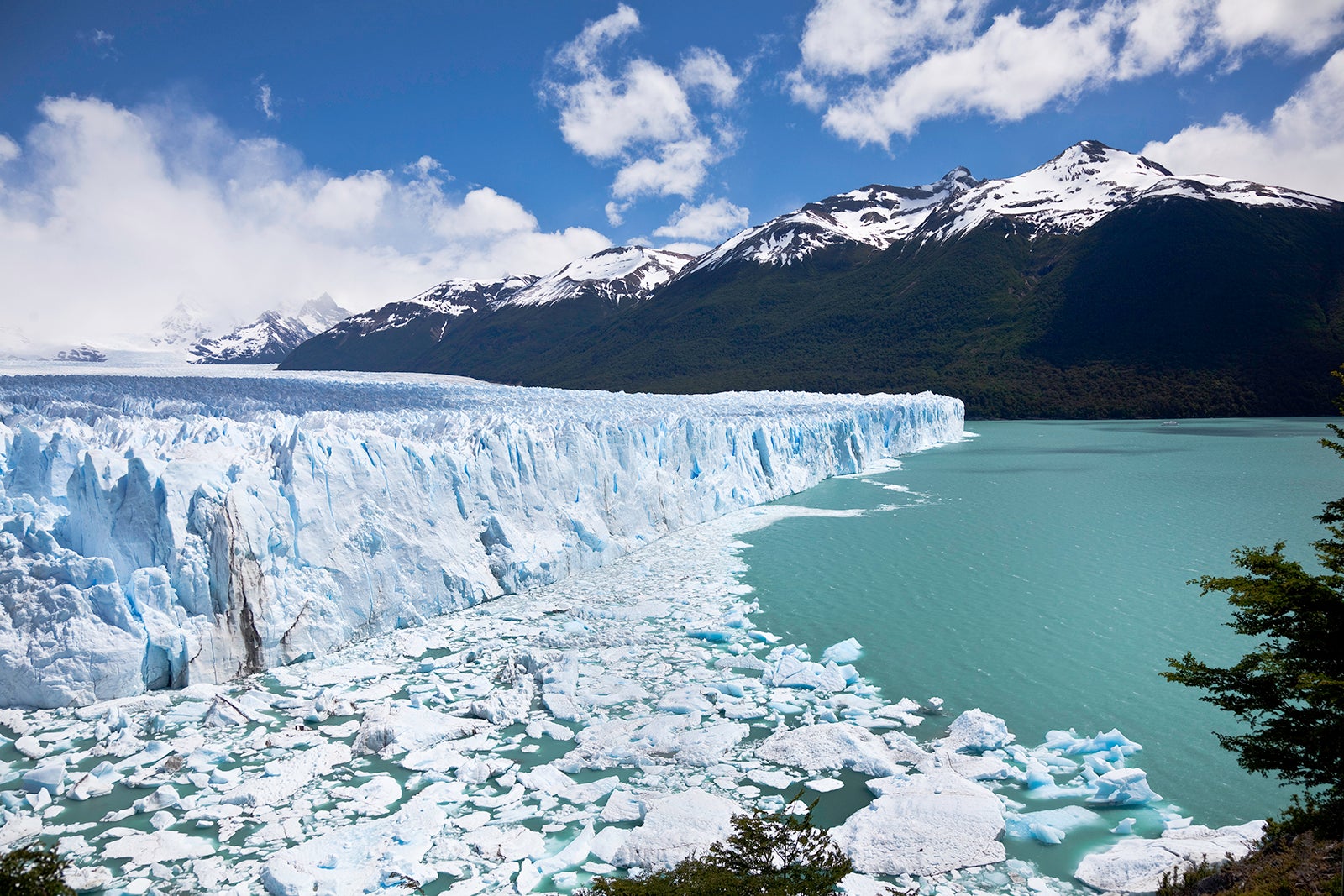
What to Do in Ushuaia and Tierra del Fuego
Flying over snowy, meringue-like peaks and down the Beagle Channel to arrive at Ushuaia — a 3.5-hour flight from Buenos Aires — is thrilling. This is, after all, the most southerly city on the planet, where four seasons in one day are the norm and you're at the whim of Mother Nature. Nestled on the shores of the legendary strait, whose icy waters were traversed by the nomadic Yaghan indigenous people 10,000 years before Charles Darwin, modern-day Ushuaia (pronounced: Oohs-why-ah) offers wilderness and nature with a touch of contemporary trading outpost.
This is actually the end of the world, so the weather is usually chilly. Visiting in summer (January to March) is peak season and brings top day temperatures of 60 degrees, making it ideal for hiking in Tierra del Fuego national park and spotting guanaco and sheldgeese. To glimpse maritime fauna such as sea lions, imperial cormorants, dolphins and pygmy right whales, circumnavigate the red-and-white Les Eclaireurs lighthouse in the Beagle Channel. Between October and April, a visit to Isla Martillo provides plenty of wobbly, flightless comedy, when Magellanic and King penguins turn this island into a colony.
For an unforgettable sea-to-plate dining experience, book into Puerto Pirata, a tiny four-table eatery a 90-minute drive from Ushuaia, where you sail out into the Beagle Channel with fishermen to haul in centolla (king crab) before it's prepared fresh just for you. Other great restaurants back in town include Kalma and Chez Manu for fine dining and Volver for seafood.
Ushuaia is a jumping off point for cruise ships on South America tours, but it's also the jump-on point for ships navigating Cape Horn (September to April) and Antarctica expeditions, (November to February).

The 25 Best Places to Visit in Patagonia: Wilderness, Wildlife, and Quirky Culture
By Author Steph Dyson
Posted on Last updated: 24th January 2024
Craggy, snow-dappled mountains; deeply grooved glaciers that burst into waterfalls; isolated, wind-ravaged national parks: this is Patagonia, one of South America’s most wild, yet mesmerizing destinations.
Despite a definite surge in tourists visiting the region in the past decade, it remains an iconic symbol of the savage beauty of South American terrain and a rewarding trip for the intrepid few who venture this far south.
Ever since I first arrived in South America in 2014, I’ve been transfixed. This is a bewitching but utterly strange part of South America: Welsh tea houses nestle alongside typical Argentine estancias, the black fins of orcas can be spotted from isolated, Atlantic shores, and egg-blue glaciers hang precipitously above hidden lakes.
Patagonia is vast, achingly beautiful, and, in many parts, perilously wild.
My first visit came back in 2016 after I won a travel writing competition (here’s my winning entry if you’re interested), giving me a place on a 34-day overlanding tour, a trip that gave me plenty of ideas about the places visitors can’t miss on a trip to Patagonia.
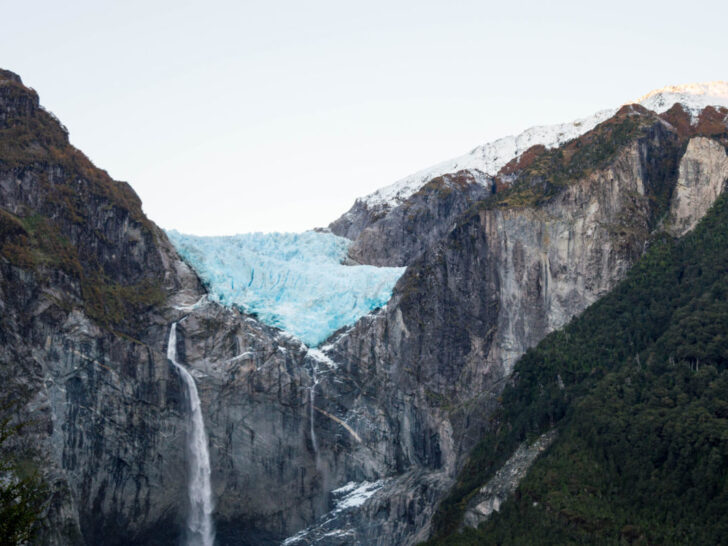
Since then, I’ve been back multiple times over the years, each time wowed by the incredible landscapes, history, and wildlife that this remarkable place has to offer.
The unmissable places to visit in Chilean and Argentine Patagonia
From acapella-singing king penguin colonies to national parks right at the end of the world, Patagonia is absolutely everything I had hoped for – and then some. I guarantee it will be the same for you.
It was a hard task to trim down my favorite places in Patagonia, but here they are.
Click to navigate this article:
Northern Patagonia
Patagonia is split into two distinct sections: northern and southern, with vast distances between the two. Read my guide about where Patagonia is to help you better understand the geography of this vast region straddling Chile and Argentina and to work out exactly where all of the places I mention below are located.
1. Bariloche and Nahuel Huapi National Park, Argentina
Argentine Patagonia’s northernmost tip, Bariloche (sometimes known as San Carlos de Bariloche) is the country’s self-declared capital of hiking.
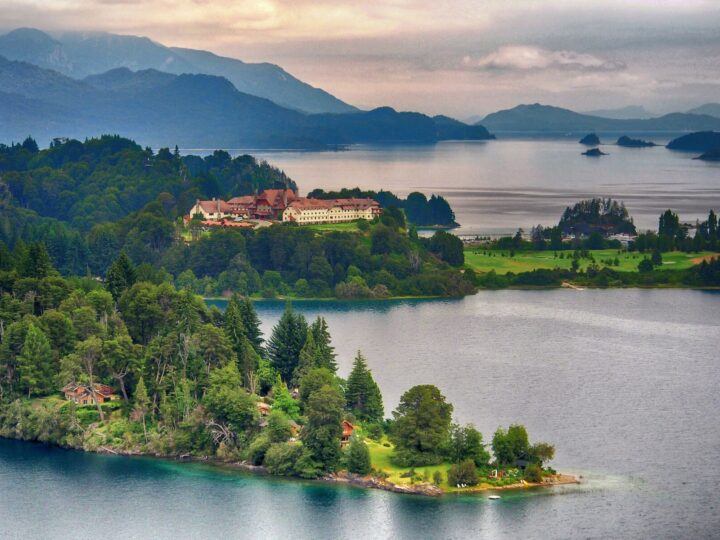
Situated on the cusp of the Andes Mountains within the vast expanse of Parque Nacional Nahuel Huapi (Nahuel Huapi National Park) and within the Argentine Lakes District, it’s truly an adventurer’s playground.
Hikes up into the mountains that tower above the town are the main attractions here, although cyclists will delight in Bariloche’s road and mountain trails, many of which circumnavigate the gorgeous lakes for which the region is known.
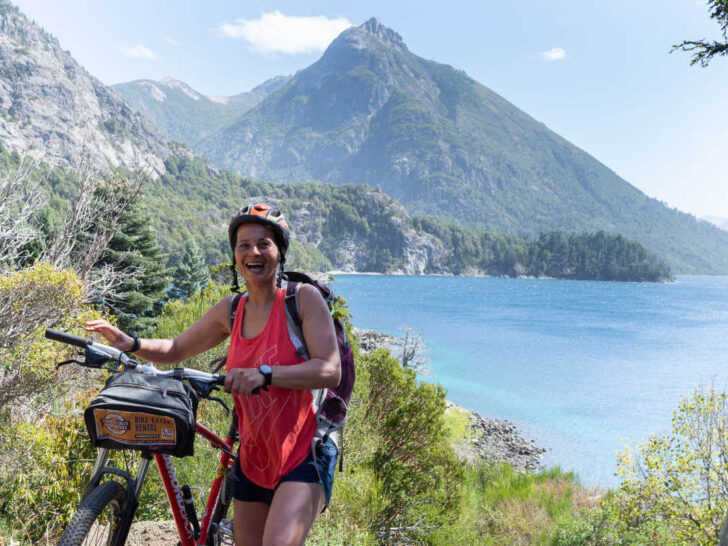
Planning Your Trip to Patagonia?
Save time, stress & money with a customized travel itinerary planned for you by a Patagonia expert
What previous clients have said:
Steph at Worldly Adventurer was amazing! It is clear that Steph has the experience and knowledge of travel in South America to help us customize a once-in-a-lifetime trip itinerary! She was responsive and friendly and really cared to understand what we wanted out of our experience. Steph did not just give us a ‘cookie-cutter’ itinerary but really tweaked and provided recommendations based on what we wanted out of the trip. I highly recommend using Steph for your travel planning to South America!
If more sedate adventures hold more interest for you, the Ruta de los Siete Lagos , a 110-kilometer drive that skirts seven of the region’s most picturesque lakes as it passes through thick pine forests and beneath the 2,000-meter snow-drizzled mountains, is one of Patagonia’s best.
How to visit Bariloche
- It’s easy enough to reach Bariloche thanks to frequent flights from Buenos Aires (two hours) or by hopping over the border from Puerto Varas in Chile.
- Long-distance buses from El Chaltén (24 hours) are not for the faint of heart.
- High season here is December through February (like much of Patagonia), so book accommodation in advance.
- Outside of these months, Bariloche becomes one of Argentine’s prime skiing resorts.
2. The Valdés Peninsula, Argentina
Tucked on the Atlantic Coast of Argentina are some of the country’s finest wildlife treasures. Península Valdés (the Valdés Peninsula) is a UNESCO World Heritage Site thanks to its abundance of wildlife, with everything from sea lions and elephant seals and Magellanic penguins found on its shores.
Inland, its plains are dotted with guanaco and rhea – species you’ll also find in southern Patagonia.
But the real stars of the show are the endangered southern right whales , who come to the waters off the coast of the peninsula to breed between June and the end of the year.
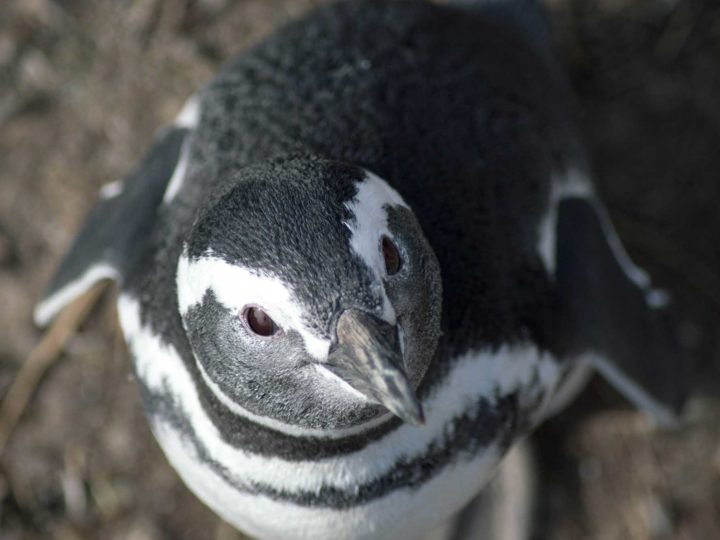
And, if you’re lucky, you might even spot the pod of orcas that migrate here between mid-February and mid-April to implement hunting techniques not seen anywhere else on the planet: they intentionally beach themselves in order to snatch baby sea lions directly from the shore.
Argentina economy update
The Argentine economy is a huge mess at the moment, with inflation expected to hit 200% this year. Using Argentine pesos can therefore be a nightmare – and mean you lose a lot of money. The blue dollar (an unofficial exchange rate that gives you a better conversion than the official rate) is around, but if you want to avoid carrying lots of cash, you can now pay using your credit card and get an exchange rate similar to the blue dollar rate. You must choose to pay in Argentine pesos (not USD!) to secure this rate.
Both Mastercard and Visa give you what is called the MEP rate, which is almost as good as the blue dollar rate. Mastercard will charge you the official rate but refund you the money a few days later; Visa will charge you the MEP rate from the beginning.
If you do want to have some Argentine pesos for paying in cash (which I highly recommend as you will need them for some restaurants and attractions), it’s best to use Western Union, whereby you send cash to yourself using the Western Union app and then withdraw it in Argentine pesos from one of their branches in Argentina. Bear in mind, those in El Calafate and Ushuaia can run dry of notes, so it can be easiest to do this in Buenos Aires.
Additionally, you can bring USD (unmarked and untorn hundred dollar bills), which you can exchange at “cuevas” (unofficial exchange houses). These will be able to give you the blue dollar rate and any hotel owner will be able to tell you where your nearest one is. Souvenir shops in most parts of the country will be able to give you pesos in exchange for dollar bills – although they might not give you the best rate.
Avoid cash machines. Currently, the maximum withdrawal is the equivalent of $15 USD in Argentine pesos and it will cost you $10 USD in fees.
You’ll also find South America’s largest Magellanic penguin colony , Punta Tombo , a two-and-a-half-hour drive south when you can walk between the burrows of the over one million penguins that nest here.
How to visit The Valdés Peninsula
- The closest town to the peninsula is Puerto Madryn and this is the best place from which to organize a tour out onto the ocean or across the peninsula itself.
- These cost from $100 USD and typically only take place between September and March. The best months for wildlife watching are September through November, when sea lions, penguins, and dolphins are present. Whale watching is only possible between June and November, however.
3. The Welsh Villages, Argentina
Argentina’s Chubut Province lays claim to one of Patagonia’s most curious cultures. The towns of Trelew and Gaiman were founded by 153 hardy Welsh settlers, who traveled across the Atlantic in 1865 to make this remote part of Patagonia their home.
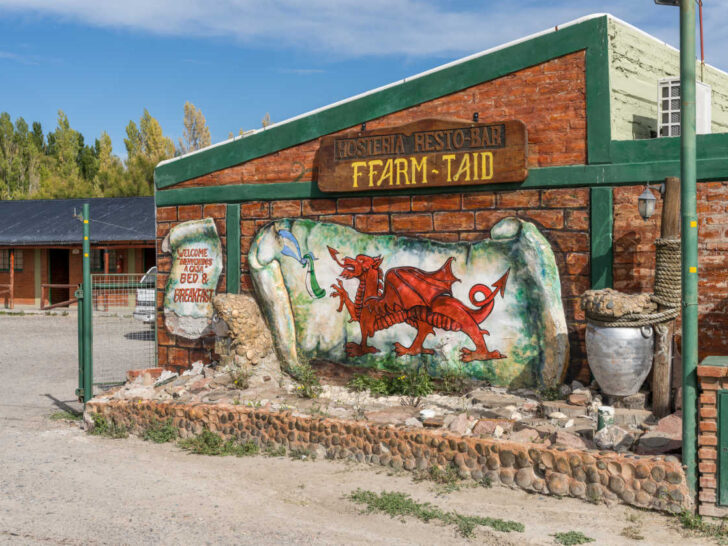
While the towns themselves have grown throughout the subsequent century, they remain a hub of Welsh-Argentine culture.
You can stop at a quintessentially Welsh tea house where you’ll find Welsh dressers dripping with tea towels printed with the Welsh flag and hear the local people still conversing in Welsh (although they also speak Spanish, too).
How to visit Trelew and Gaiman
- The two towns lie an hour’s-drive south of Puerto Madryn and can be easily reached with a tour.
- You can also reach the towns by bus and stay in one of the handful of B&Bs located here.
4. Puerto Varas, Chile
On the banks of Chile’s second-largest lake, Lago Llanquihue, and with views of the perfectly conical Volcán Osorno and Volcán Calbuco, Puerto Varas is the most vibrant and visited of the towns in Chile’s Lake District.
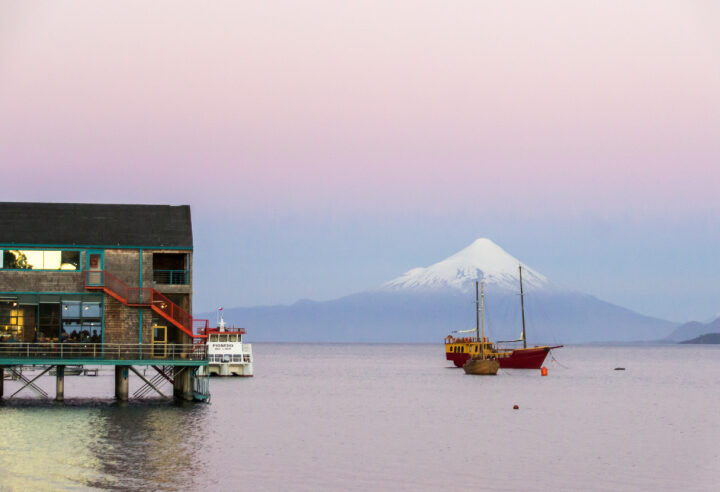
German-inspired architecture and pretty lakeside surroundings are just a part of the attraction; as one of Chile’s prime adventure hotspots , Puerto Varas also within easy reach of a wide variety of activities.
These span everything from cycling (the 100-kilometer loop of Lago Llanquihue, or a shorter stretch, is a popular excursion) to white-water rafting in Class III and IV rapids on the Río Petrohué.
Hikers will also find plenty to keep them busy, whether summiting the 2,654-meter peak of Volcán Osorno or going for a shorter stroll in Parque Nacional Vicente Pérez Rosales (Vicente Pérez Rosales National Park).
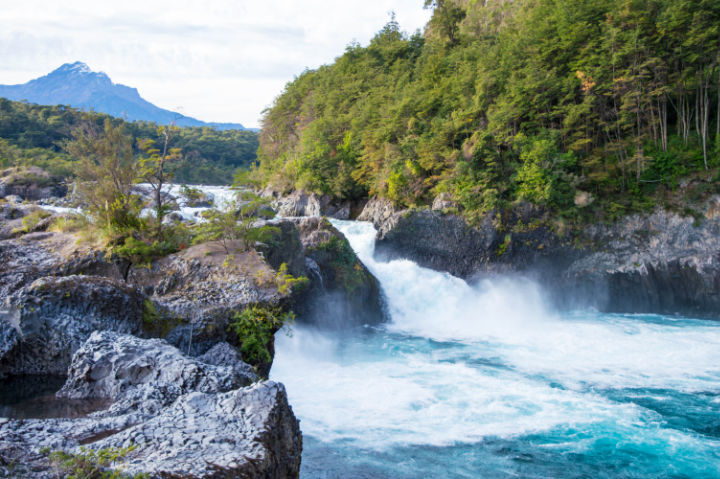
At the end of January, the annual music and theatre festival is held in nearby Frutillar, whose pretty theatre hangs on wooden stilts over the lake and is host to some of the best international acts – many of whom don’t even perform in the Chilean capital, Santiago.
How to visit Puerto Varas
- Puerto Varas is only a 20-minute drive from Puerto Montt’s El Tepual Airport, one of the main transport hubs for Patagonia.
- Multiple flights per day connect with Santiago (two hours), Balmaceda (one hour), and Punta Arenas (two hours). Less frequent departures fly to Puerto Natales (two hours).
- Read our complete guide to Puerto Varas for more inspiration.
5. Chiloé, Chile
Separated from mainland Chile by the Chaco Canal, the magical Chiloé Archipelago dances to the beat of its own drum. Their relaxed pace of life combines with a fierce pride in their roots as residents of these islands, where you’ll find a remarkable blend of unique architecture, stunning old-growth forests, and rare native wildlife.
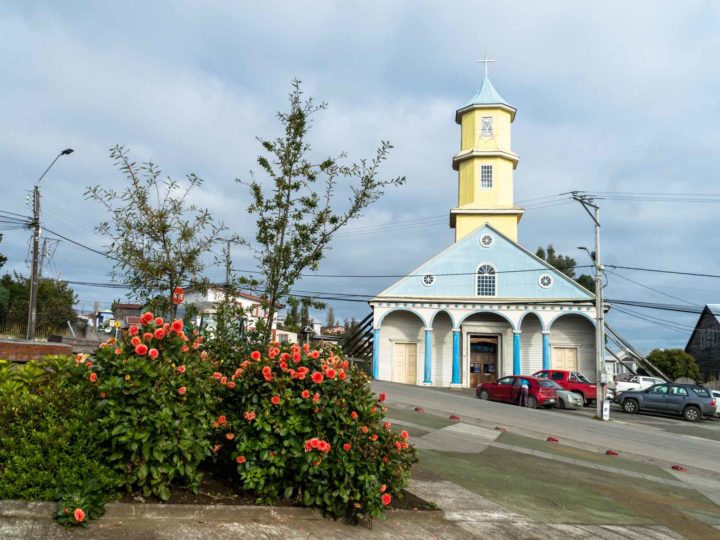
The archipelago’s best-known attractions are its remarkable churches . Built entirely from wood and without a single nail (the islanders’ skills with woodwork are a part of their culture of boat building), the 60 remaining churches are a true sight to see.
Many are painted in startlingly bright colors and 16 have been designated as UNESCO World Heritage sites .
But the churches aren’t the only curious features of Chilote architecture. Along the Gamboa River estuary of the islands’ capital, Castro, you’ll find wooden, former fishermen’s dwellings known as palafitos hovering above the waters. Similarly painted in a kaleidoscope of bright colors, many of these homes have been converted into unique boutique lodgings .
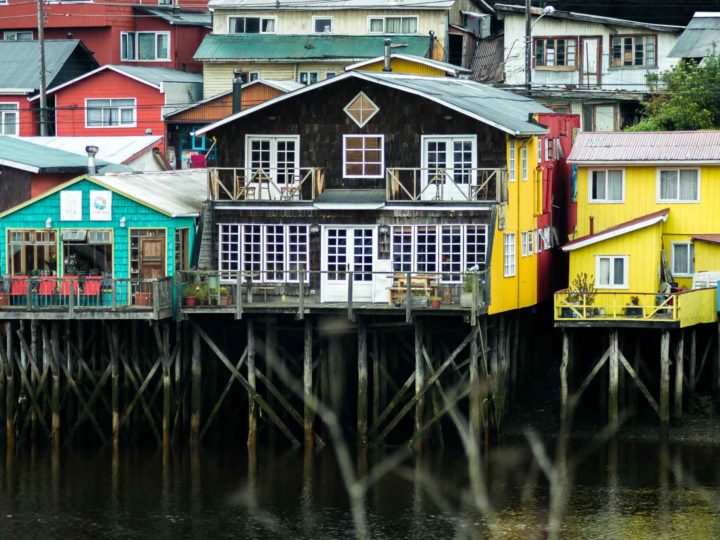
Further afield and a scattering of national parks and reserves preserve the lush, unique ecosystems of Valdivian temperate rainforests harboring rare endemic species, including the pudú, the world’s smallest deer.
Combine this with a rich culture of food – including a traditional fish stew known as curanto that is cooked in the ground – and Chiloé is one of Chilean Patagonia’s most unique destinations.
How to visit Chiloé
- It’s a four-hour drive from Puerto Montt’s El Tepual Airport to reach Castro, the islands’ capital.
- The easiest way to explore the island – which is Chile’s second largest – is with your own car as public transport between the towns and more remote areas is both slow and infrequent.
- A stay of at least two days is recommended to explore this magical place – it’s easily one of my favorite parts of Chile !
6. Pumalín Douglas Tompkins National Park, Chile
Offering a glimpse of Patagonia at its most unspoiled and the results of conservation of a mammoth scale, Parque Nacional Pumalín Douglas Tompkins (Pumalín Douglas Tompkins National Park) is a unique natural treasure.
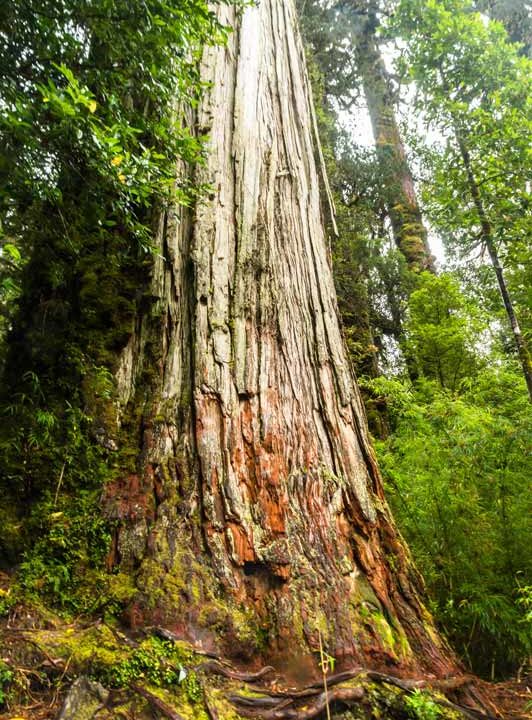
It protects virgin Valdivian temperate rainforest, millennia-old groves of towering alerce trees, and the still-steaming cone of Volcán Chaitén.
Here, carefully planned trails pass waterfalls, earthy forests of southern beach, myrtle, and laurel, and dramatic viewpoints of the mountains and volcanoes that dot the skyline.
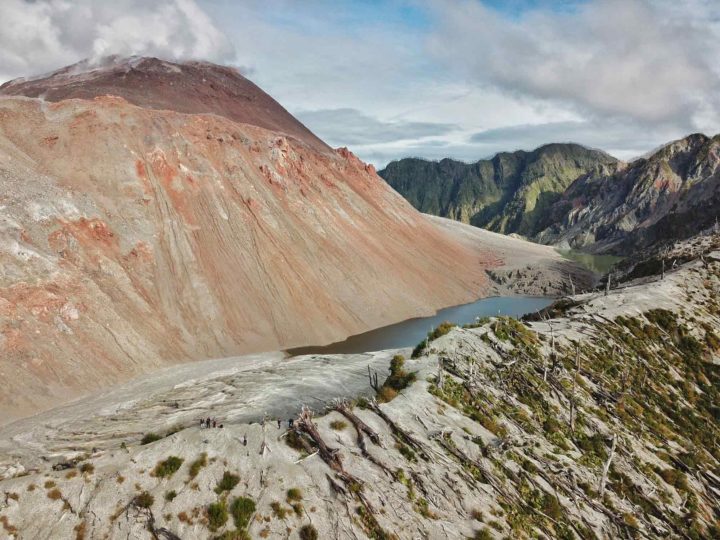
It’s easily one of my favorite national parks in Patagonia, not just for its accessible hiking but for its remarkable scenery. Nature lovers are guaranteed to be in their element here.
If you only do one trail here, make it the trek up to the crater of Volcán Chaitén . With striking views and a sense of the dramatic damage caused by the 2008 volcanic eruption, this route climbs up to the edges of the volcano.
The views across its 3.5-kilometer crater and behind you across the forests of the national park to the Chilean fjords beyond are possibly some of the most incredible in Patagonia.
How to visit Pumalín Douglas Tompkins National Park
- The nearby town of Chaitén is the gateway to the national park, offering basic lodgings and a handful of tours. Facilities within the park itself including campgrounds and cabins .
- You can reach Chaitén and the park via a handful of different ferry routes. From Hornopirén – which marks the northern tip of Ruta 7 or the Carretera Austral – and Puerto Montt in the north and Castro and Quellón in the southwest.
- More information about the park and its trails here .
7. Futaleufú, Chile
Wedged in a river basin 10 kilometers from the Argentine border, Futaleufú is a charming town that takes pride in its unofficial designation as Chile’s white-water rafting capital. After all, its 47 world-class rapids – with names including Inferno, Purgatory, and the Angel’s Dance – attract rafters the world over.
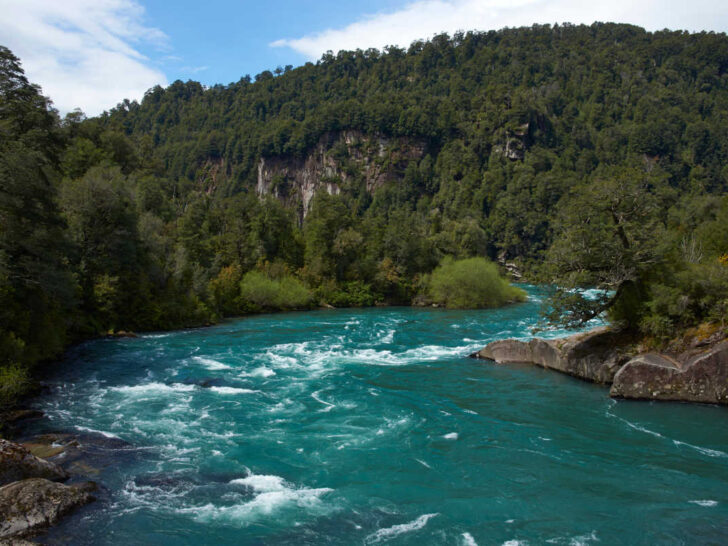
However, you don’t need any experience in rafting to take on the Río Futaleufú. Brilliant local outfitters – many run by safety-conscious US ex-pats – can give you a taste of the river’s world-renowned waters, just without the sense of peril that the most experienced white-water rafters seek.
White-water and more relaxed kayaking and hiking in the surrounding hills (which form the foothills of the Andes Mountains) are other good reasons to visit, even if you’re not too keen on rafting.
How to visit Futaleufú
- With its proximity to the Argentine border, Futaleufύ can be reached by bus from Esqual (two hours), the largest town in the area.
- From Chile, it’s a 3.5-hour drive east from Chaitén, with daily buses connecting you to the Carretera Austral and the towns south.
- White-water rafting costs from $75,000 CLP ($92 USD) and I recommend local operator Patagonia Elements who have robust safety measures and brilliant guides.
8. Queulat National Park and Puyuhuapi, Chile
With fewer than 800 inhabitants, the sleepy little fishing village of Puyuhuapi feels like rural Germany – or a fairy tale – with its clutch of historic Bavarian-style wooden houses. Founded by four Germans in 1935, but only connected to the rest of Chile by road in 1977, Puyuhaupi has an alluring remoteness.
While most will find themselves stopping overnight on a road trip north or south along the Carretera Austral , the true attraction of this part of Chilean Patagonia is Parque Nacional Queulat (Queulat National Park).
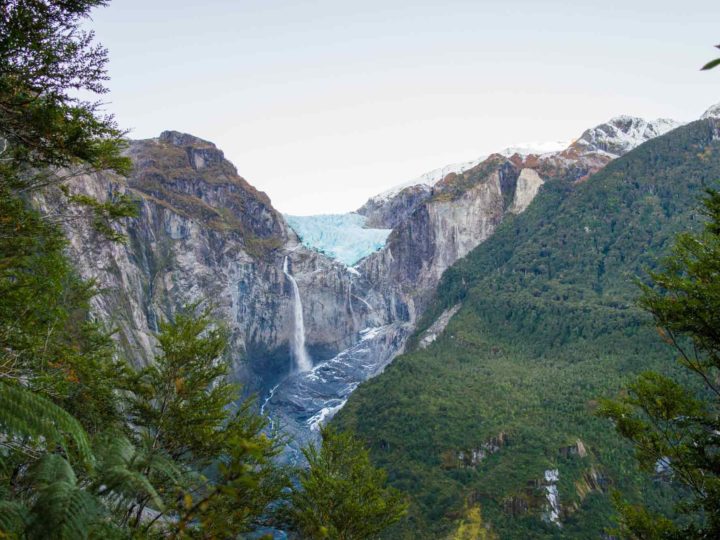
The park’s most bewitching sight is the dramatic egg-blue Ventisquero Colgante del Queulat (Queulat Hanging Glacier) clinging precariously to the mountain above the park.
The glacier’s exaggerated blues are perfectly contrasted against the dark green of the forest. Evergreen southern beeches line the hills around icy Laguna Témpranos, the lake at the heart of the park – and which captures the great hunks of ice that splinter from the glacier’s snout.
From the park entrance, there’s a short hike up to a viewpoint from which you can spy the glacier in all its magnificence. When you reach the end of the trail, stop and breathe: this is the remote, bewitching Patagonia you’ve been seeking.
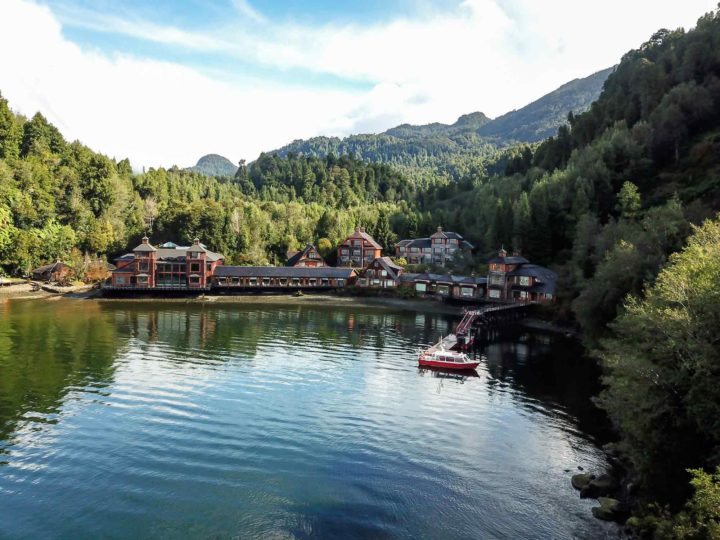
If you need to relax sore legs after the hike, then spend a night or two at the nearby Puyuhuapi Lodge & Spa ($375 USD double), which is tucked away into the fjords and can only be reached by boat.
How to visit Queulat National Park and Puyuhuapi
- Puyuhuapi is a 2.5-hour drive south of Chaitén or a 4.5-hour drive north of Balmaceda, the only airport in this part of Patagonia.
- Balmaceda is served by a couple of daily flights from Santiago and Puerto Montt.
- Experiencia Austral can organize tours into the park from Puyuhuapi, as well as bike rental if you wish to get there under your own steam.
9. Cerro Castillo National Park, Chile
Dubbed the “new Torres del Paine”, Parque Nacional Cerro Castillo (Cerro Castillo National Park) has a lot of similarities with its better-known, southern park – but it’s a quieter, far less crowded version.
The landscapes here are dominated by metamorphic basalt rock, which reveals the region’s origins and comes to a head in the knobbled spires of the eponymous Cerro Castillo (Castle Hill) – which, yes, is shaped a bit like a castle.
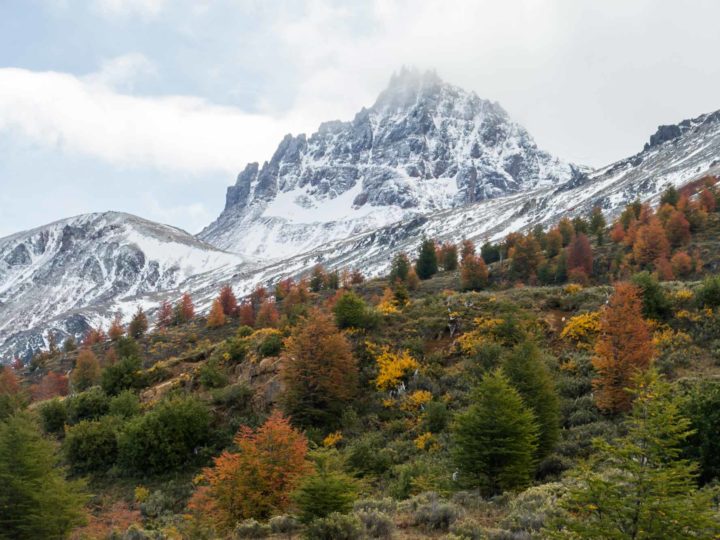
Throw in cyan lagoons, Calafate bushes, lenga forests that turn deep red in a fall, and craggy ridges and you’ve got a still mostly off-the-radar adventurer’s playground.
And, whether you’re keen on a challenging but worthwhile one-day hike up to the base of Cerro Castillo, or a five-day trek that traverses the more remote parts of the park, the hiking here is some of the best in Patagonia.
How to visit Cerro Castillo National Park
- The town of Villa Cerro Castillo sits at the southern reaches of the park and is the best place to stay if you’re planning on hiking. Trailheads for both the one-day Sendero Mirador Laguna Cerro Castillo and the five-day Cerro Castillo Traverse are out of town, so you’ll need your own transportation – or rely on hitchhiking – to get to them.
- Villa Cerro Castillo is served by all buses heading between Coyhaique (north) and Cochrane (south), which tend to leave once daily.
- A far easier way to visit is with your own vehicle; it’s just a one-hour drive southwest of Balmaceda, the region’s only airport, and where you can organize car rental .
- More information about the park and its trails here and here (with a map).
10. The Marble Caves, Puerto Río Tranquilo, Chile
Visiting the Marble Caves (Capillas de Mármol) had been top of my list of where to go in Patagonia before I started traveling – and visiting certainly didn’t disappoint.
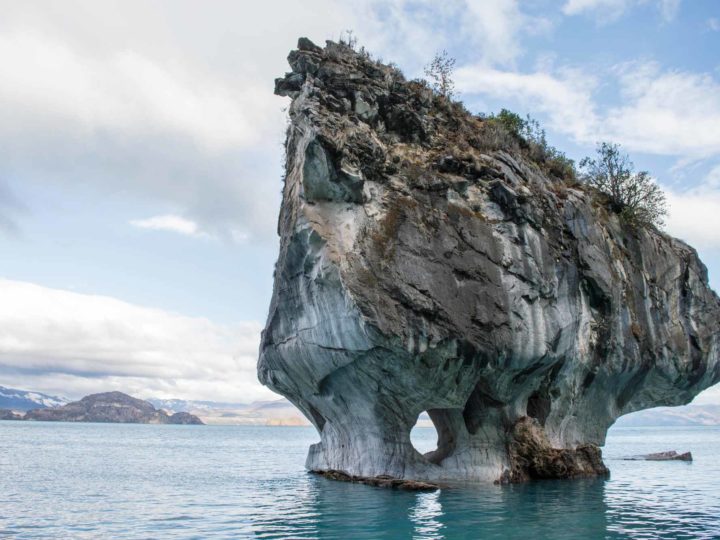
These dreamlike rock formations are a collection of rainbow-hued rock caves, where softer limestone has been eroded by the wind and waves of Lago General Carrera to leave a series of grottos.
You can reach the caves in either a speedboat or by kayak from Puerto Río Tranquilo and you’ll be close enough to touch the rock, whose veined grey, black, white, and blue hues are a reflection of the equally dazzling lake waters beneath.
Both seem to change color according to the temperament of the weather.
The town of Puerto Río Tranquilo is itself small and unassuming, but you can head east towards the coast and into Parque Nacional Laguna San Rafael (San Rafael National Park) for ice trekking on the 18-kilometer-long Glaciar Exploradores or to take a boat ride out to the dramatic Ventisquero San Rafael , a glacier famed for its regular calving and tucked deep in the Chilean fjords.
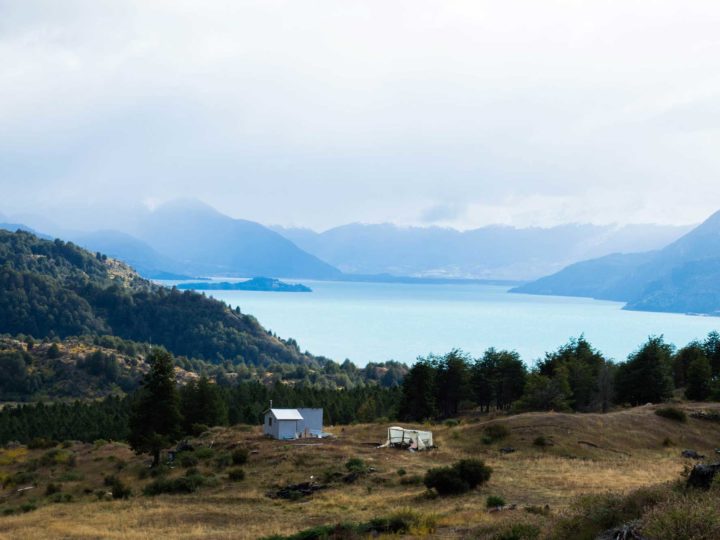
Taking a boat (or a kayak tour) allows you to get close enough to touch the strange, dappled marble – that’s apparently a few million years “undercooked” when compared with the marble that we conventionally use.
How to visit the Marble Caves
- Speedboat and kayak tours depart from Puerto Río Tranquilo, from where it’s a short journey to reach the caves. Operators offering both line the lake shore in town.
- The light is best in the morning, although high winds can cause tours to be canceled due to dangerous conditions on the lake.
- Puerto Río Tranquilo is most easily reached via hire car as part of a road trip along Chile’s Carretera Austral , however, daily buses do pass through the town heading both north and south.
11. The Cave of Hands, Argentina
A surprising addition to my top list of highlights in Patagonia, La Cueva de las Manos (or the Cave of Hands) is a remarkable, 13,000-9,500-year-old set of cave paintings close to the town (not the glacier) of Perito Moreno, Argentina.
The stone walls of the main, and several, smaller caves are littered with inverse handprints: paint made from natural minerals is believed to have been blown through hollow animal bones to create the effect of spray paint.
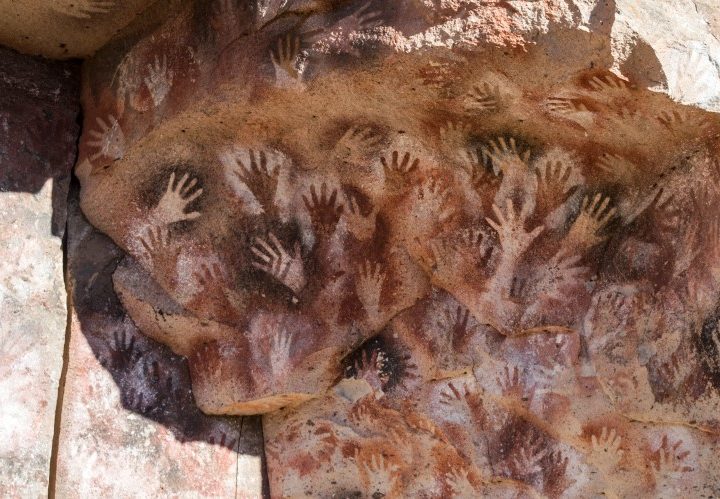
There are literally thousands of ancient hand prints whose changing styles and forms mark the varying artistic tastes of the different tribes who over the course of almost 4,000 years made this, presumably, sacred place their home.
This incredible mural features additional images of guanaco hunting scenes (an animal similar to the llama), representations of the sun, and slightly trippy, enormous Shaman images.
There’s also the fascinating inclusion of a number of six-fingered hands, as well as the outlines of tiny, baby hands, which those working at the site assume must have belonged to children of significant tribe members.
A designated UNESCO World Heritage Site , it’s certainly worth the detour from the main road.
How to visit the Cueva de Las Manos
- The Cave of Hands is pretty far off the beaten path, a two-hire drive south along Ruta 40 from the town of Perito Moreno (not the glacier – that’s 400 kilometers south!). Some of the drive here is along a dirt road, too.
- Entrance costs $8.5 USD and includes a guided tour of the site. The guides are also very informative – although you’ll be lucky if they speak a lot of English.
- It’s possible to take a tour to reach the cave from Los Antiguos, a 2.5-hour drive north. It’s far easier to visit with your own hire vehicle.
- The official site has further information.
12. Patagonia National Park, Chile
I can’t understate this: Parque Nacional Patagonia (Patagonia National Park) is one of the finest national parks along the Carretera Austral if not all of Patagonia. You could spend weeks roaming the mountain and admiring the park’s lakes, many of which are bluer than the sky.
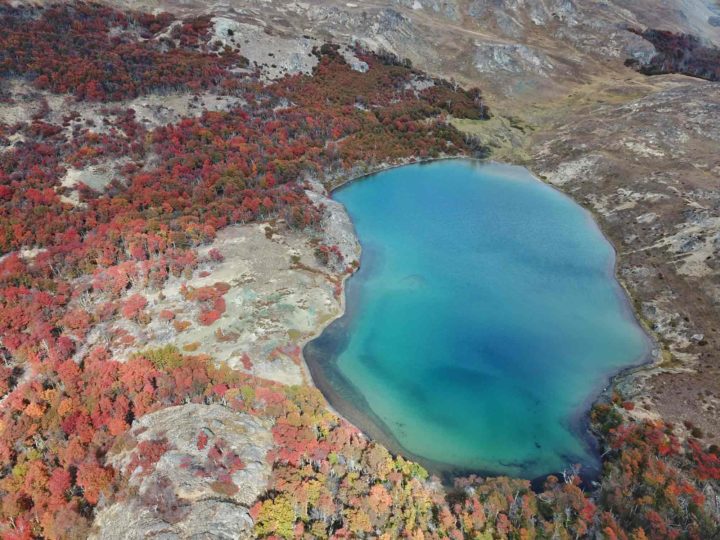
Like most of Patagonia’s national parks, hiking is the main draw, with a truly outstanding array of single and multi-day hikes that promise an eclectic mix of terrain and the possibility of interaction with many of the region’s endangered animals, including guanaco puma, Andean condors, pampas cats, and the huemul deer.
Slightly complicatedly, the park is split into three sections: Sector Jeinimeni , which is only accessible from the village of Chile Chico, on the border with Argentina; Sector Valle Chacabuco , which is an hour’s drive north of Cochrane; and Sector Tamango , which is a short drive east of Cochrane.
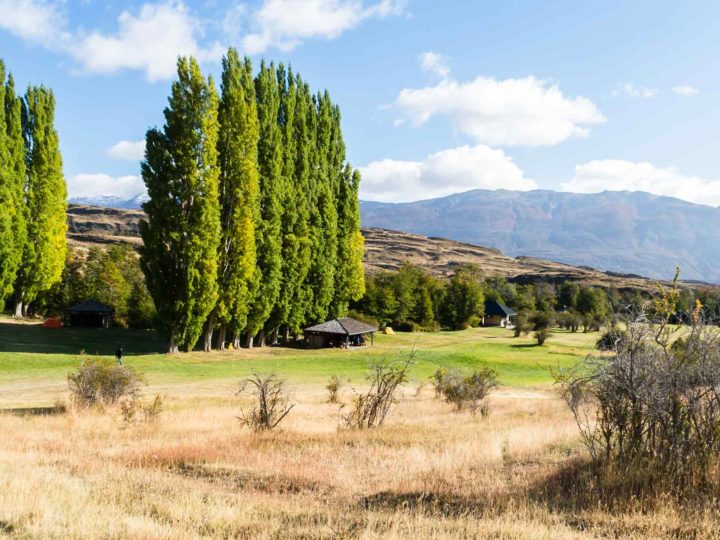
Each promises different, but equally magical, landscapes, but if you’ve only got time for one, head to Sector Valle Chacabuco. At its heart is the sweeping Río Chacabuco valley that’s bounded by mountains dripping with southern beech forests in the west and arid steppe in the east. The hiking here is fantastic.
How to visit Patagonia National Park
- It’s not possible to drive between the different sectors within the park itself and the entry points to each are far from each other. Multi-day hikes (only for experienced trekkers with camping gear and GPS) allow you to cross between the different sectors, however.
- Sector Valle Chacabuco has the most infrastructure, with an ultra-luxury hotel , visitors’ center, restaurant, and campgrounds with restrooms and solar-panel heated showers. The road is unpaved but easily navigable by car.
- Sector Jeinemini has a handful of short trails plus an interesting blend of mountains and stark, desert-like terrain. There’s a basic campground here, too. You can arrange tours in Chile Chico or drive by yourself; you’ll need 4WD.
- Sector Tamango has ten well-marked trails and a basic campground.
- More information about the park and its trails here .
13. Caleta Tortel, Chile
Nothing quite prepares you for Caleta Tortel , easily the most magical of the settlements along the Carretera Austral.
This village clings to a green-fringed hill along the turquoise waters of the Baker Channel, which is fed by the electric-blue Rio Baker and glacial melt from the Northern and Southern Patagonian ice fields.
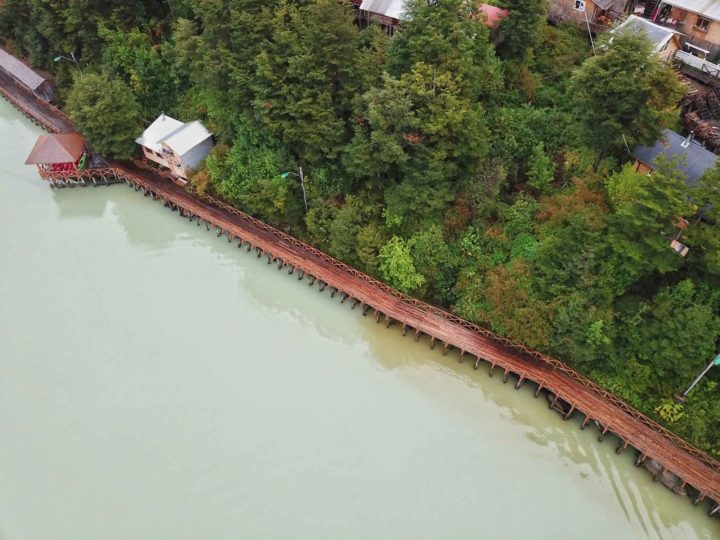
But the most unusual fact about Caleta Tortel is that there are no roads ; instead, of pavement are 10 kilometers of cypress-wood walkways, at some points seemingly hovering above the water. At intervals, pretty hexagonal wooden platforms with roofs provide a welcome breather and a vantage point to appreciate the magic of this unique settlement.
The village’s quirky boardwalks are the main attraction and a short day trip here is often enough to feed your curiosity. However, if you stay longer, you can visit the nearby Steffens and Jorge Montt Glaciers or go kayaking on the remarkably hued waters of the channel.
A less picturesque excursion is to visit the bleak Isla de los Muertos , where 33 cypress crosses bear testament to the pioneers of the region, who died in mysterious circumstances.
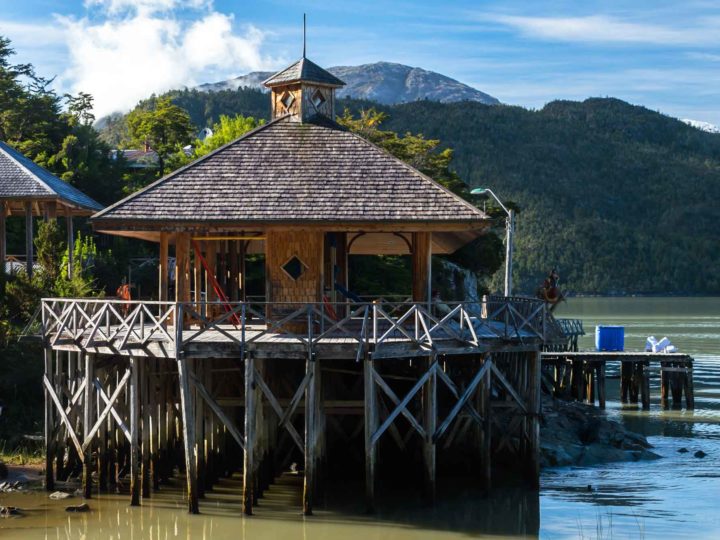
Theories abound about their untimely end, including a scurvy epidemic or their accidental poisoning with arsenic, and boat tours can take you to visit the tiny cemetery on this abandoned island.
How to visit Caleta Tortel
- There are buses a couple of times a week from Cochrane, a 2.5-hour drive north, as well as daily from Villa O’Higgins (a 3.5-hour drive south).
- Accommodations and restaurants are extremely basic in Caleta Tortel, so if you’re planning on staying, it’s worth using Google Maps to find accommodation (little of it is on Booking.com) and contact the owners directly using Whatsapp.
- If arriving with your own vehicle, there is a free car park at the entrance to the village.
14. Villa O’Higgins, Chile
From Caleta Tortel, the gravel Carretera Austral continues southeast, running along the mountains as deep river valleys open up beneath.
This 98-kilometer final stretch, the most remote and wild, includes a short ferry crossing at Puerto Yungay, before you continue to the very southern tip of the Carretera Austral. Remarkably, Villa O’Higgins was only connected by road in 1999; before that, it was only possible to arrive in a light aircraft.
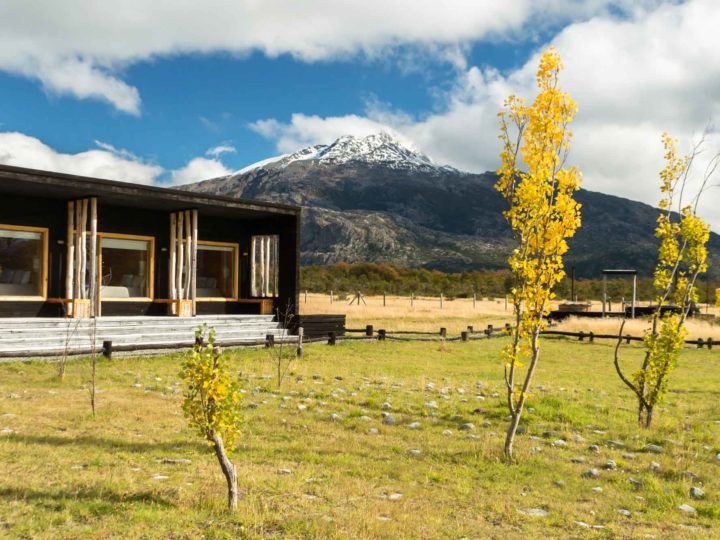
Few places are imbued with the same feeling of mystique as this remote village, emphasized by the fact that few of the Carretera Austral’s many travelers ever make it here.
Although there’s not much to see in the village, it’s a gateway to hiking trails through virgin lands, boat trips of nearby glaciers, plus Patagonia’s most extreme border crossing.
How to visit Villa O’Higgins
- A couple of buses per week connect Villa O’Higgins with Cochrane and Caleta Tortel, the two closest towns. You can also cross over to El Chaltén via a very complicated – and unreliable – combination of ferry and hiking .
- The easiest means of arriving is with your own car; the vehicle ferry that crosses the Mitchell Fiord from Puerto Yungay operates on a first-come, first-served basis every two hours; it’s free.
- Keep your eyes peeled on this final stretch of the Carretera Austral; it’s where I finally saw a rare huemul deer!
15. The Patagonian Fjords, Chile
The stark wildernesses of Patagonia are likely what first caught your eye about this destination. And while many of the region’s national parks hint at the drama in the remotest corners of Patagonia, if you really want to find it, a boat journey is the best means.
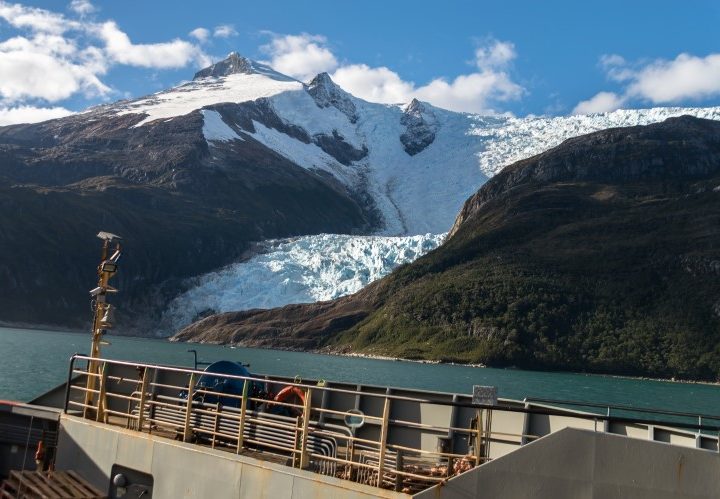
The Chilean fjords are some of the most spectacular places I’ve ever visited. In the north, these narrow channels disappear into thick vegetation masking endemic species of deer, hummingbirds, and, in the air above, even Andean condors.
As you head south, tidewater glaciers drip down from the shoreline, dolphins splash in the waters surrounding the boat, and whales surface, approaching your vessel curiously. Each day on board, the landscape is constructed of the grey ocean against the rich green of the coastline.
I’ve taken almost all possible passenger ferries around Patagonia , which, while more basic than the expensive private cruises, give you an affordable means of seeing the region at its most special.
Those of note include the TABSA ferries from Caleta Tortel/Puerto Yungay (the southern end of the Carretera Austral) to Puerto Natales and their sailing from Punta Arenas to Puerto Williams , which includes the incredible Glacier Alley, a row of eight tidewater glaciers that spill down from the Darwin Ice Field.
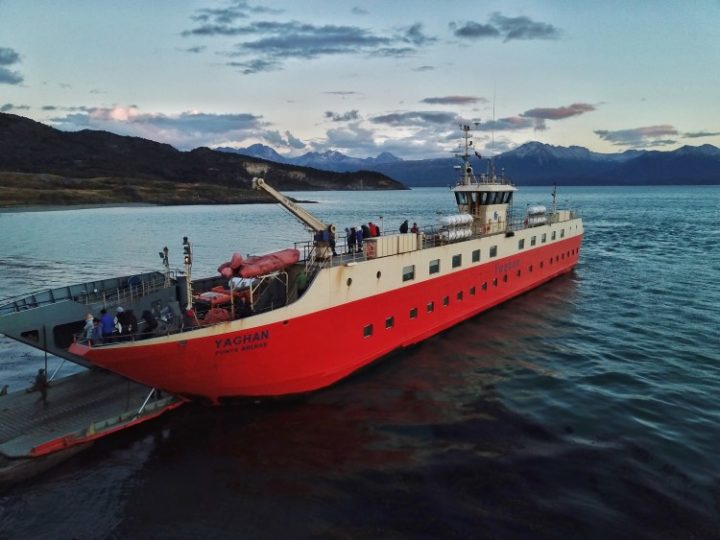
The Navimag ferry from Puerto Montt to Puerto Natales is a much more expensive affair – but still worth it for the incredible views. You can read my experiences of this Patagonian boat journey .
How to visit the Patagonian Fjords
- Passenger ferries used by local people moving between remote parts of Patagonia are some of the most affordable ways to travel and ensure access to some of the most jaw-dropping scenery in the region.
- They’re also an excellent means of traversing long distances in Patagonia.
- Many include space for cars; all require advance booking at least a few weeks in advance (and more in January and February).
Southern Patagonia
Southern Patagonia is generally more visited than Northern Patagonia (aside from Bariloche and Puerto Varas) and is home to some of the region’s most celebrated destinations. Find out the best way to reach these destinations in my guide to how to travel to Patagonia .
16. El Chaltén and Los Glaciares National Park, Argentina
Frontier town El Chaltén was founded in 1985 to strengthen Argentina’s sovereignty. It has since transformed into one of Argentine Patagonia’s most visited towns due to its access to – and magical views of – the thick granite spires of Monte Fitz Roy. These rise out of the northern sector of Parque Nacional Los Glaciares (Los Glaciares National Park) .
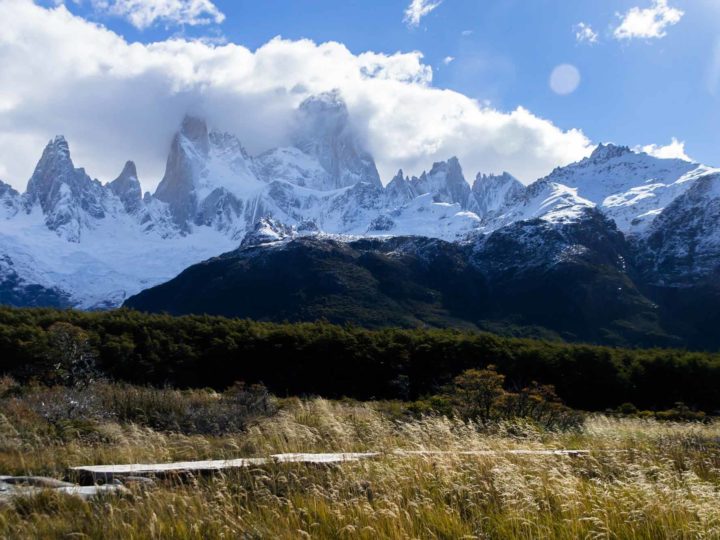
While glaciers are the park’s calling cards – the most famous of which is the Perito Moreno (see above) – hiking is its other huge draw.
The iconic shape of 3,375-meter Monte Fitz Roy (Mount Fitz Roy) is more than memorable; and the hiking route up to the lake that sits beneath – Laguna de los Tres – a challenging but utterly worthwhile effort.
There’s plenty more hiking to satisfy even the most adventurous Patagonian travelers and the more you roam around the park, the higher your chances of spotting its wildlife, which range from pumas and rare huemul deer to armadillos and Andean condors.
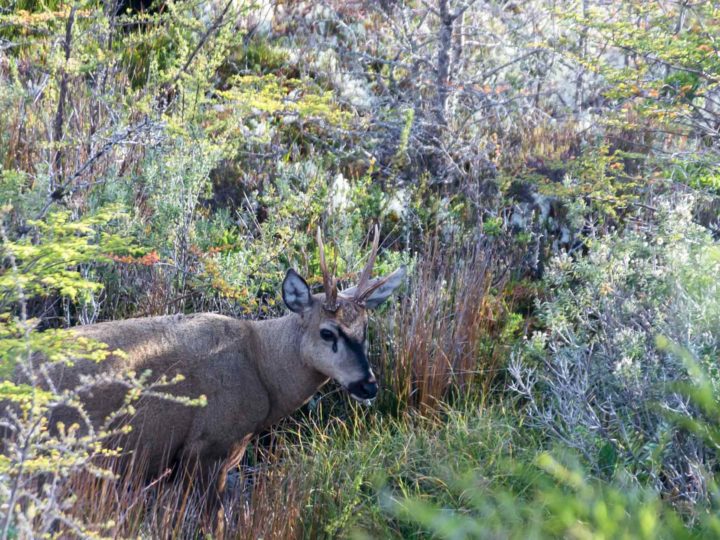
Photographers can also delight in the changing light across the three prongs of Monte Fitz Roy – although with frequent cloud cover over this mountain, the best photos require patience.
How to visit El Chaltén and Los Glaciares National Park
- El Chatén is well-connected by bus to El Calafate – but it’s a much longer schlep overland to the northern Patagonian towns of Los Antigous and Bariloche.
- Hiking the trails in Los Glaciares National Park is easy enough to do independently; more challenging routes such as the four-day Huemul Circuit require significant hiking experience.
- El Chaltén heaves with tourists between December and February, so always make hotel reservations well in advance if arriving during these months.
17. El Calafate and the Perito Moreno Glacier, Argentina
On the milky-green waters of Lago Argentino, the small town of El Calafate is on many people’s Patagonia itinerary for one reason and one reason only: the dramatic Glaciar Perito Moreno .
Located just over an hour’s drive west and within Parque Nacional Los Glaciares (Los Glaciares National Park), this 25,000-hectare glacier knees in the gray-blue waters of Lago Argentino, calving with remarkable frequency stark blue bergs of ice. This might not be even close to one of Patagonia’s largest glaciers, but trust me: it’s incredible.
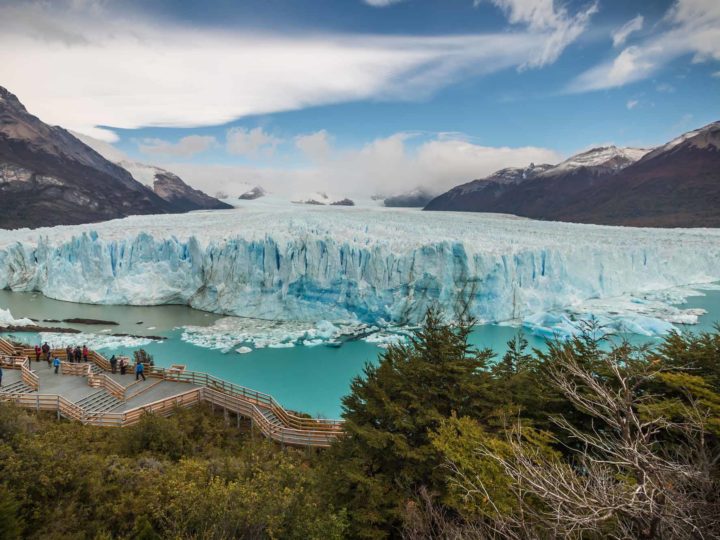
You can get within a few hundred meters of its snout thanks to various boardwalks that offer views from a multitude of different angles. If that’s not enough ice for you, you can join a trekking tour on the ice itself ; it’s a demanding activity but allows you to peer into the yawning crevasses that cover the glacier.
Beyond the Perito Moreno Glacier, El Calafate hasn’t got that much else to offer, unless you’re keen to learn more about the region’s gauchos – Patagonian cowboys – and dine on a traditional feast of roasted lamb.
A number of working ranches with tourist accommodation now give you the opportunity to stay in beautiful locations and learn more about this part of Patagonia’s history. I highly recommend Estancia La Estela , which is located a 1.5-hour drive north of El Calafate on the shores of Lago Videma.
How to visit El Calafate and the Perito Moreno Glacier
- El Calafate is easily reached by a three-hour flight directly from Buenos Aires , while bus links connect it to El Chaltén further north and to Puerto Natales, just across the border in Chile.
- Various bus companies run between El Calafate and the national park for around $30 USD return and it’s easy enough to explore the boardwalks independently.
- Read our complete guide to visiting the Perito Moreno Glacier for further information.
18. Torres del Paine National Park, Chile
Soaring granite peaks and sparkling crystalline lakes with mirror-like reflections of jaw-dropping mountains — the sublime scenery of Parque Nacional Torres del Paine (Torres del Paine National Park) has become a symbol of Patagonia at its wildest and most beautiful.
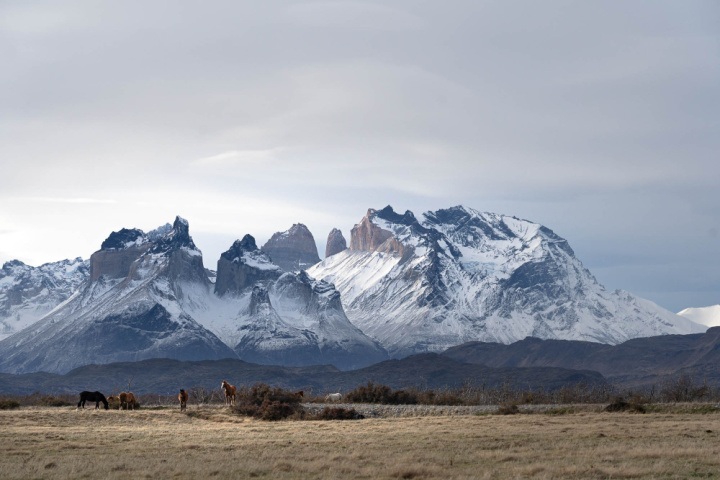
This park’s most prominent feature is the Paine Massif: crooked peaks that are part of the Andes and around which the park’s main hiking routes traverse. On the east side of the Paine Massif, beyond a deep river valley, three weathered spires of rock known as the Torres del Paine are what draw the vast majority of visitors.
I’ve visited the park three times through the years, experiencing the epic array of adventure activities that await. You can trek either an O-shaped circuit or a W-route around the Paine Massif, as you stumble upon everything from the park’s glaciers and hidden, mountain valleys to the torres (towers) themselves.
Wildlife is also rich here , with herds of guanaco (the smaller wild relative of the llama) nibbling grass on the park’s vast open plains, often stalked by the puma whose numbers mean the park now has one of the largest concentrations on the planet . They pose little danger to visitors – but are profoundly exciting sightings for wildlife lovers.
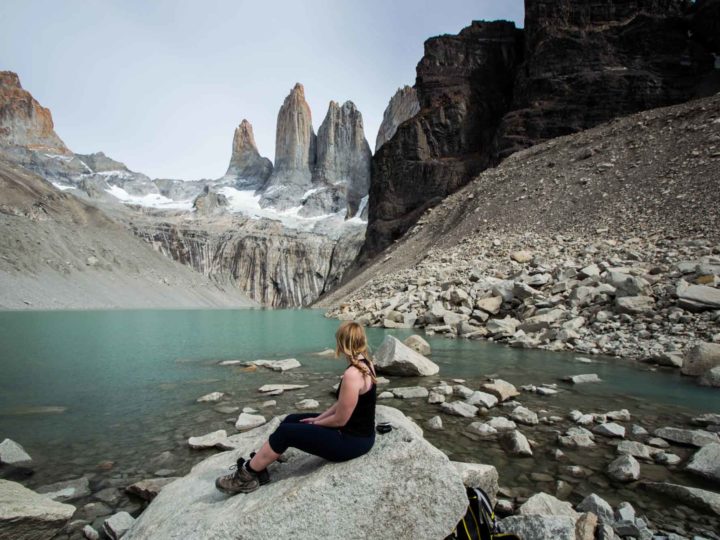
Kayaking among icebergs, boating out to the face of glaciers, horseback riding along the shores of one of the park’s many lakes: adventure takes many forms here. And for those looking for a gentler, more luxurious adventure, the park’s array of hotels – some of which rank among the best in the country – won’t disappoint.
Honestly, if there’s just one place you visit in Patagonia, make it this one.
How to visit Torres del Paine National Park
- The closest town to the national park is Puerto Natales, from where it’s possible to take a bus or rent a car to get into the park.
- The cost of entry depends upon how long you stay; for up to three days, it cost $35 USD for adults and $17 USD for children. For stays over three days, the entry price is $49 USD for adults and children.
- Logistics vary wildly depending on whether you’re planning a day trip, multi-day hike, or multi-day stay in one of the park’s excellent hotels . The best place to start is with this comprehensive guide to Torres del Paine National Park .
- It’s easy enough to visit independently, but if you’re looking for more help, I offer a travel planning service for the region and can also highly recommend Chile Nativo , a local operator that offers a 5% discount if you use the code WorldlyAdventurer as a referral discount.
- Find out how to hike the W or the O trek .
19. Puerto Natales, Chile
On the eastern shore of Seno Última Esperanza (Last Hope Sound), the small town of Puerto Natales has impressive views west across sprawling Peninsula Antonio Varas and the knife-edge peaks of Parque Nacional Bernardo O’Higgins (Bernardo O’Higgins National Park) , one of the most remote in Patagonia.
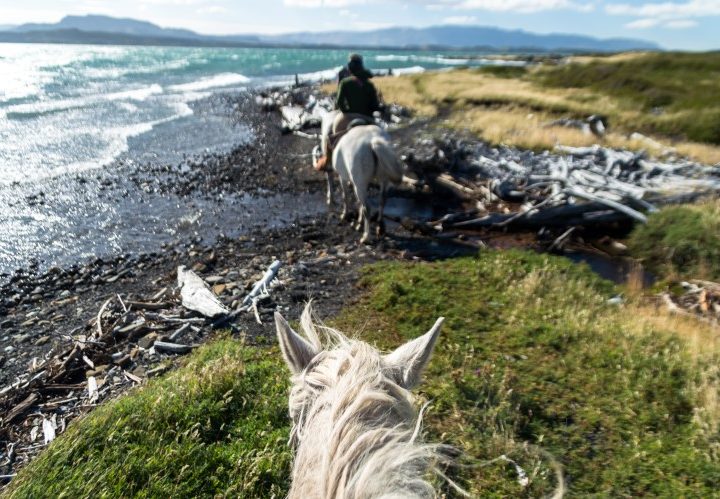
While most will merely pass through on their way to Torres del Paine National Park, Puerto Natales is worth a day or two in its own right. This town played a major role in the sheep and wool trade when the surrounding steppe was dotted with estancias (ranches).
Some still remain, showing visitors sheep shearing and sheep dog demonstrations, taking them on horseback rides, and feeding them the ultimate Patagonian meal: cordero al palo (barbecued lamb).
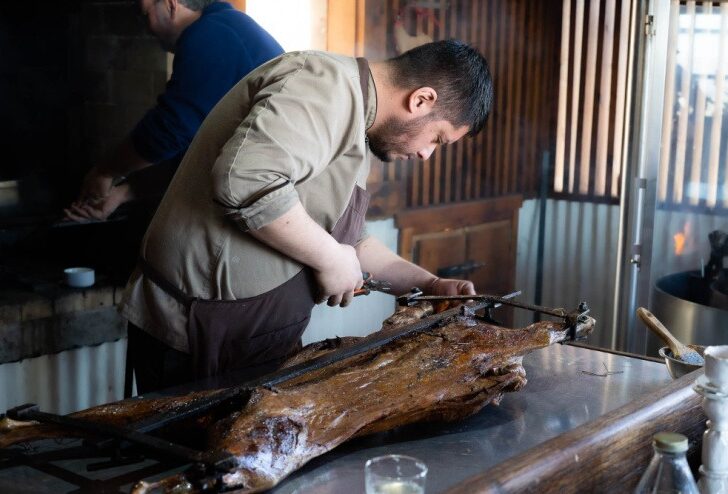
Watery adventures into the fjords also await here; you can head deep into Parque Nacional Bernardo O’Higgins to see the Balmaceda and Serrano Glaciers in a protected area that only receives 35,000 annual visitors but is Chile’s largest.
How to visit Puerto Natales
- Puerto Natales is easiest reached by bus from Punta Arenas (three hours) or from El Calafate (five hours), across the Argentine border. The latter only operates once per day in high season (occasionally twice) and you must reserve at least a couple of days in advance.
- Most of the attractions surrounding Puerto Natales can be visited as part of a tour; read my review of visiting Estancia La Peninsula , a typical Patagonian ranch.
- Only a handful of companies offer the tour into Parque Nacional Bernardo O’Higgins; Turismo 21 de Mayo is one of them.
20. Punta Arenas, Chile
Along the strait of Magellan, Punta Arenas , the capital of Chile’s southernmost region doesn’t quite have the romance or mystic appeal you might envisage. After all, it’s often harassed by grisly weather – there are ropes in the main square to help when the wind blows strong enough to take you with it. Look a little harder, though, and you’ll find it has a certain charm.
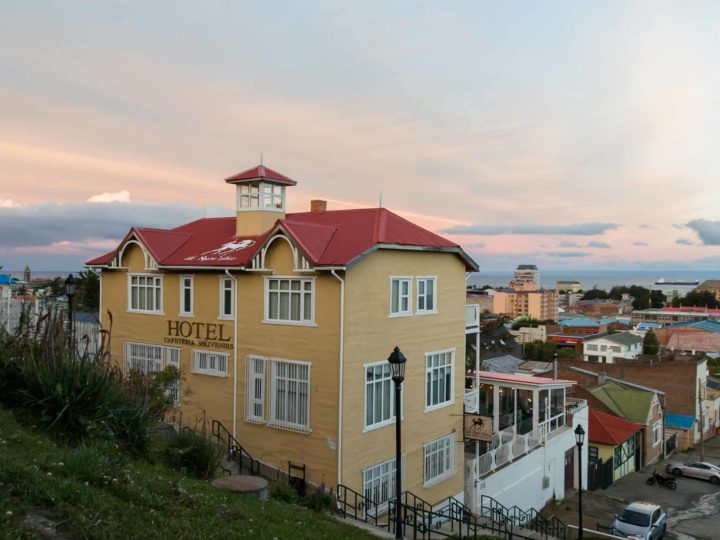
Around the central plaza, decadent old mansions, a legacy of Punta Arenas’s wool boom, spread into the side streets. Many less grandiose buildings are painted in a kaleidoscope of colors, offering a sharp contrast with the gunmetal gray of sea and sky.
This town is the gateway to southern Chilean Patagonia (mostly notable Torres del Paine National Park), but it’s still a destination in its own right.
At the center of the city, the Palacio Sara Braun features 19th-century furniture that crossed the Atlantic, while the Museo Regional de Magallanes is in another neoclassical palace, preserving original furniture from its wool days, as well as exhibits touching upon the region’s indigenous history – and their near extinction at the hands of the European colonizers.
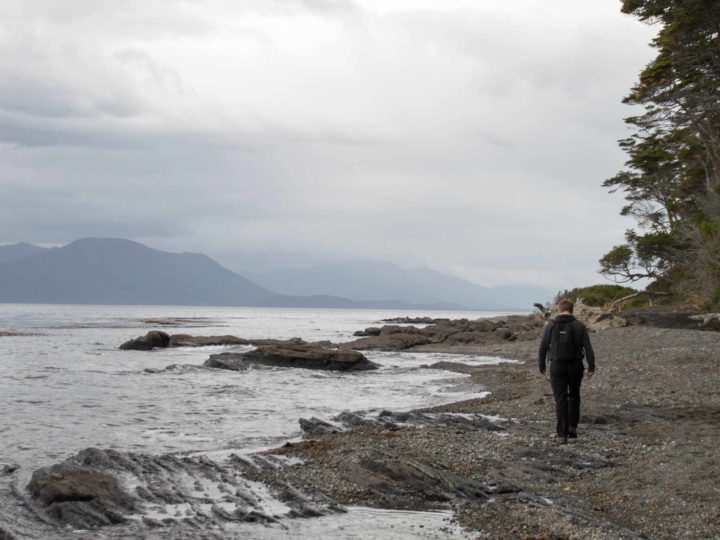
Driving out west from town along the final few kilometers of Ruta 9 before the road ends and nothing but ocean and the toothy mountains of Tierra del Fuego beyond is another highlight. It’s one showing you that it is, in fact, possible to find the magic that you were expecting from a town here at the very tip of the South American continent.
Just beyond – and accessible with a tour from the city, Parque Marino Francisco Coloane (Francisco Coloane Marine Park) receives migrating humpback whales, who come here between December and May – in what is their only non-polar feeding location.
How to visit Punta Arenas
- Punta Arenas is the major transport hub for Southern Chilean Patagonia. Flights from Santiago (3.5 hours) and Puerto Montt (two hours) land here multiple times per day and buses depart for Puerto Natales every hour.
- It’s also possible to take the long, long route to Ushuaia by bus (11 hours), with departures normally once per day in high season.
- A handful of operators run trips out to Francisco Coloane Marine Park. Solo Expediciones operate one-day tours, while Far South Expeditions have three-day expeditions.
21. Chilean Tierra del Fuego
Sparsely inhabited and barely developed, Tierra del Fuego is separated from the Strait of Magellan and is the largest island in both Chile and Argentina. Most infrastructure is concentrated in the latter – which means intrepid visitors looking to explore the former are in for a treat.
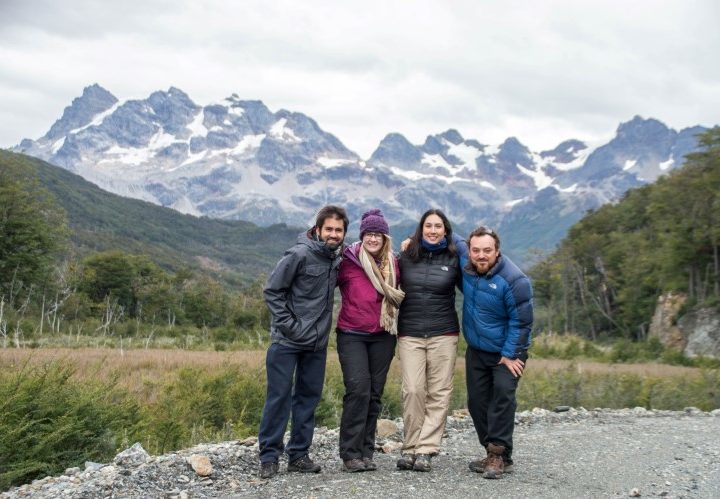
The Chilean side of Tierra del Fuego is a version of Patagonia that has barely changed since the time of its original indigenous inhabitants. The steppe is made heavy with sharply defined low clouds and the terrain soon because ragged, with chiseled mountain ranges and deep valleys thick with peat bog, where wilderness is king.
A road trip through Chilean Tierra del Fuego is the ultimate journey. The handful of towns that dot this largely uninhabited terrain have only passing interest for most visitors; it’s the landscapes that bewitch, with the extremely remote Parque Karukinka a place where few hikers even traverse its trails.
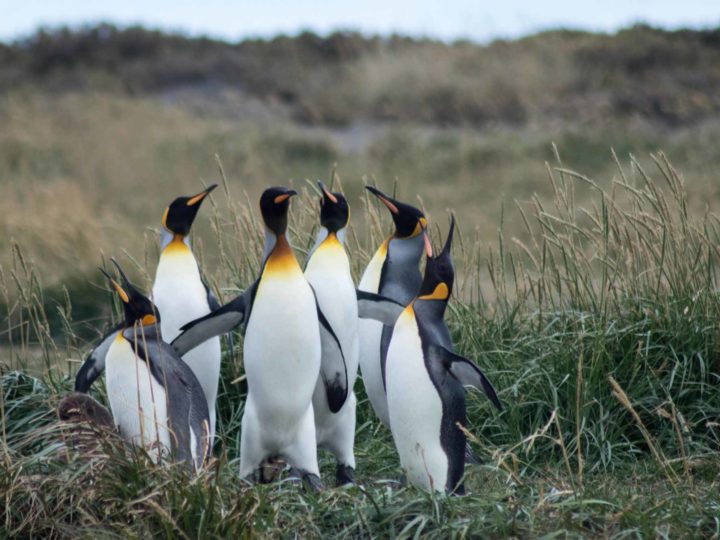
The king penguin colony at Bahia Inútil is another major attraction, home to a population of around 60 birds and the only such colony in the Americas.
How to visit Chilean Tierra del Fuego
- I traveled as part of a trip with Lodge Deseado, an incredible high-end lodge based near Lago Deseado in Tierra del Fuego. You can read about my experiences in this guide to Tierra del Fuego .
- A handful of companies offer adventures deep into Tierra del Fuego, but expect to pay a premium for the experience. I highly recommend Chile Nativo’s tours (get a 5% discount when you mention Worldly Adventurer as your referrer), a local operator with decades of experience in Patagonia.
- It’s also possible to travel independently into Tierra del Fuego, which is what I did. You need a 4WD, food and water to last, a Chilean Entel sim card, and GPS. There’s only one gas station when you go south from San Martin. For more information, download this guide or read this more recent article .
- For the king penguin colony, I recommend taking a tour that departs from Punta Arenas by ferry across to Porvenir (such as this one ) or one that involves a direct flight to Tierra del Fuego (such as this one ). Visit the official website of the park here .
22. Ushuaia, aka The End of the World, Argentina
Ushuaia has come to be known as “The End of the World” , with a sign claiming as such in its downtown. While that’s not entirely true – Puerto Williams across the Beagle Channel takes that trophy – it does feel like you’ve reached the very extremes of the South American continent.
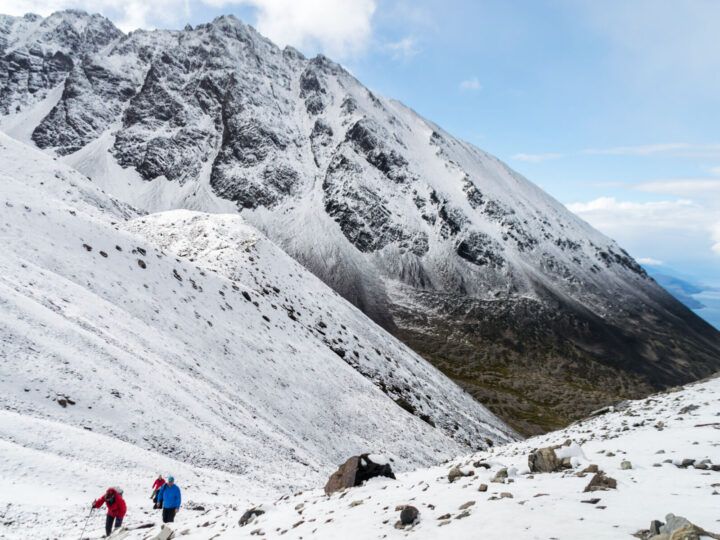
For many years, Ushuaia was a mere Argentine backwater housing prisoners transferred here from Buenos Aires (it’s worth heading over to the Museo Marítimo y del Presidio in what was the prison to learn more), but now it’s a buzzing city and the embarkation point for most cruises to Antarctica.
One of its main draws is its location: backed by the snowy teeth of the Martial Mountains and giving onto the frigid waters of the Beagle Channel, it’s a dramatic place.
It’s also a hub for hiking. You’ll want to head southwest to Parque Nacional Tierra del Fuego (Tierra del Fuego National Park) for some of the best scenery, although a couple of hikes, such as to Glaciar Martial, are accessible directly from town.
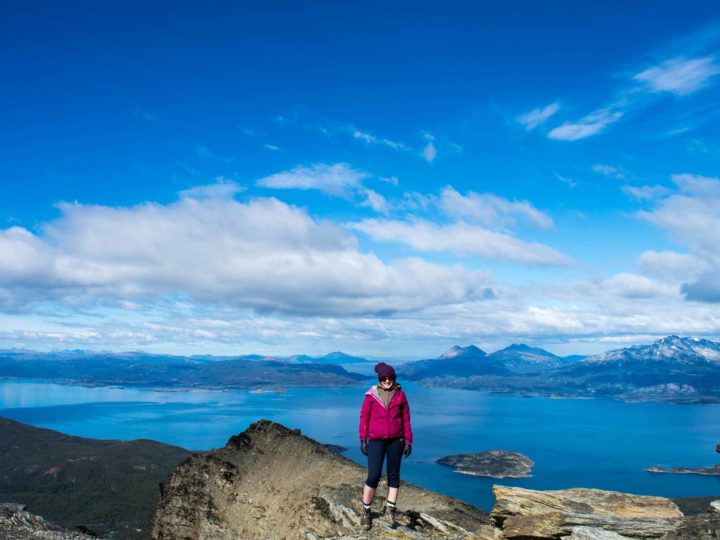
Wildlife lovers will also be in their element . Nearby, bountiful colonies of Magellanic penguins, sea lions, and fur seal colonies can be reached by boats from Ushuaia’s port.
How to visit Ushuaia
- It’s a bit of a pain to get here: either an 11-hour bus ride from Chile’s Punta Arenas or a one-hour 15-minute flight from El Calafate.
- Prices are high in Ushuaia because of the influx of wealthy tourists heading to Antarctica and hotels can get booked up quickly during high season (December through February).
- Read our Patagonia travel itineraries article to learn more about how to fit a trip to Ushuaia into your itinerary.
23. Puerto Williams, Chile
Clinging to the southern shores of the Beagle Channel on the largely uninhabited Isla Navarino, the town of Puerto Williams is overshadowed by the bright lights of Ushuaia, 50 kilometers northwest across the water.
With 2,900 people living here, it is the southernmost settlement in the world, although few tourists venture this far.
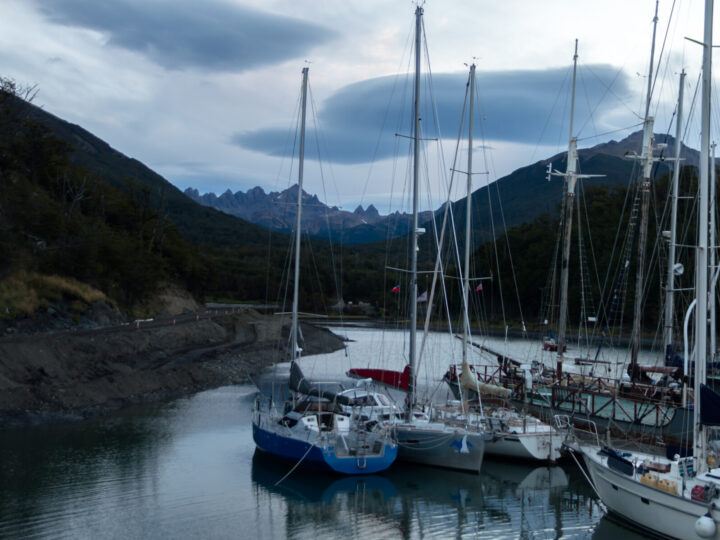
There are reasons for this: it’s challenging to reach and, when you have, it can feel like there are more horses than people – you’ll see horses foraging in people’s front gardens.
But this remote and often rain- and windswept corner of Chilean Patagonia offers the region’s wildest and most spectacular hiking in the Dientes de Navarino , an extremely challenging five-day trek, which circumnavigates the toothy mountain ridge behind the village.
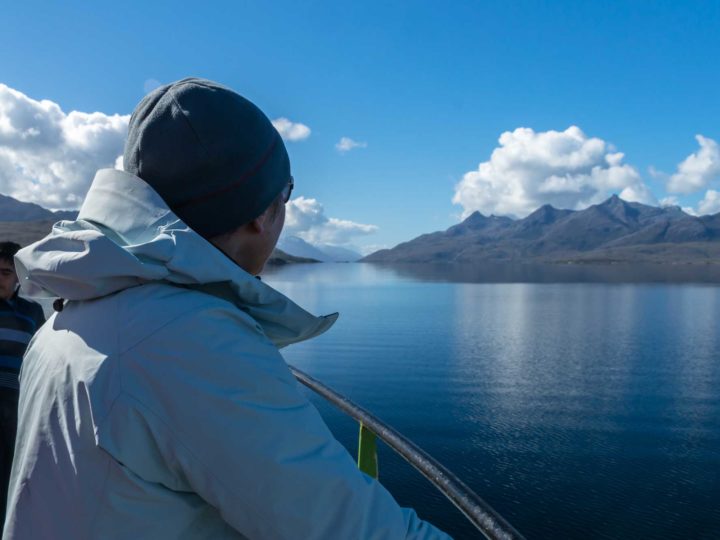
For a true glimpse of Patagonia, few places can compete with Puerto Williams. Getting here by speedboat, plane, or the 32-hour ferry is part of the adventure.
How to visit Puerto Williams
- 10-seater Twin Otter plans operated by local carrier DAP connect Puerto Williams with Punta Arenas six days a week; because of their small size, they can be booked up weeks in advance.
- My favorite way of reaching Puerto Williams is aboard the TABSA Yaghan ferry , which plies the fjords down from Punta Arenas, including passing the incredible Glacier Alley.
- You can hike the Dientes de Navarino trail independently (info here ), but extensive trekking experience is recommended. Alternatively, organize your trip with a local operator such as Explora Isla Navarino .
24. Cape Horn, Chile
Only 10,000 visitors a year stand on Cabe Horn , the famed headland of the treeless Isla Hornos (Horn Island).
Cruises that venture through the Chilean fjords normally attempt to dock here, at what has been mistakenly called the southernmost point of South America (Águide Islet of the Diego Ramirez Islands, 112 kilometers southwest actually takes that crown).
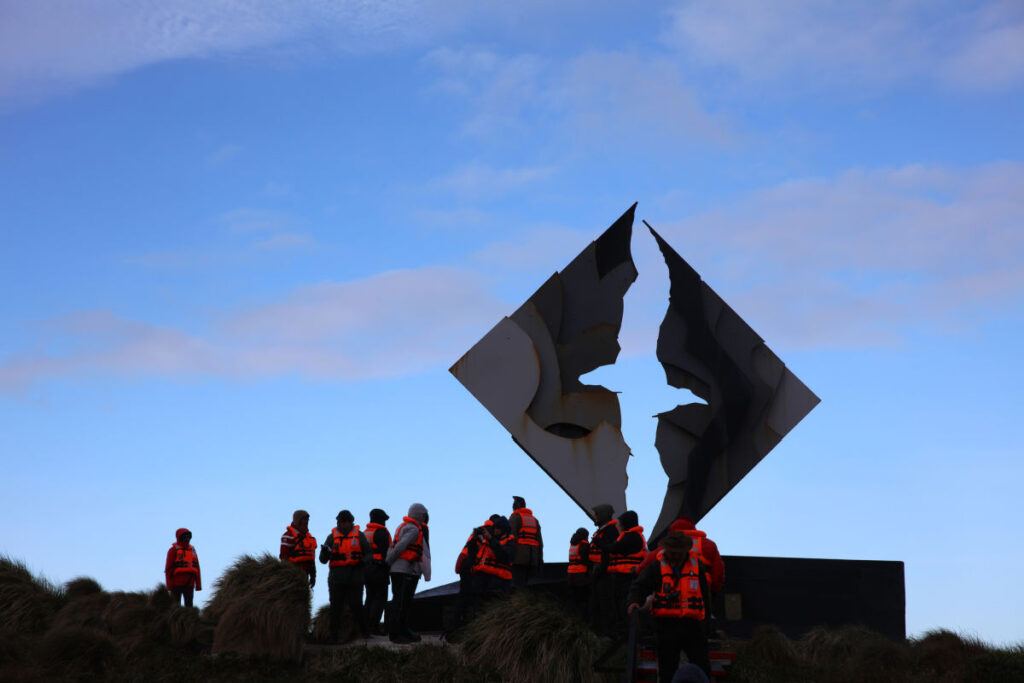
Much of the thrill of the experience is overcoming the odds – and the often brutal winds and waves – at this remote island’s shores, a feeling of conquering the might and majesty of nature’s most powerful and violent forces; this is where the Pacific and Atlantic Oceans meet, after all.
Once you land, a wind-battered trail clambers up to an exposed cliff top with a seven-meter tall steel memorial in the shape of the silhouette of an albatross to remember mariners who died “rounding the Horn”.
Despite not being the official end of the Americas, standing on this headland looking out over the roiling ocean beyond, the end of the earth doesn’t feel far off.
How to visit Cape Horn
- The easiest way to visit Cape Horn is aboard a cruise ship with Australis . All of their cruises attempt to land on the island and depart from either Punta Arenas or Ushuaia.
25. Antarctica
The White Continent, aka Antarctica, with its mind-numbingly vast landscapes of ice reflected to infinity in the glittering ocean beneath, is the stuff of travelers’ dreams.
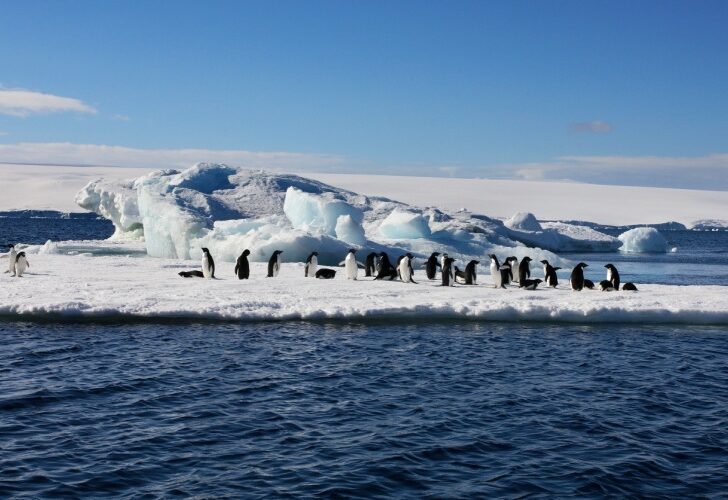
Few can ignore the pull of this unblemished landscape, rich with an incredible variety of wildlife , that ranges from seven different species of whales to Gentoo, Chinstrap, and Adelie penguins (plus king penguins if you head to South Georgia) and six species of seal.
But it’s not just the thrill of spotting wildlife in this raw habitat; it’s the experience of treading on land where few others go and finding yourself face-to-face with the vastness of the world — and what we stand to lose as a result of the climate crisis.
How to visit Antarctica
- You can only visit Antarctica by cruise (or an incredibly expensive flight). The former is the best option and I highly recommend a small ship expedition cruise (which means you’ll be allowed to get off the boat at every stop on the itinerary – something not guaranteed for large ships!
- I recommend Swoop Antarctica, whose staff have extensive, first-hand experience in sailing to Antarctica. They sell all the different routes to Antarctica: classic cruises to the Antarctic Peninsula , more unusual trips to wildlife-rich South Georgia and the Falklands , or cruises to the much harder-to-reach Antarctic Circle .
Looking for more Patagonia travel inspiration? You’ve come to the right place! After multiple visits to Patagonia over the past eight years, I’ve written a wealth of information about the region. Start with these Patagonia itineraries , learn when the best time to visit Patagonia is , and consider planning a road trip in Patagonia with our detailed guide.

What I Wish I Knew Before Visiting Argentine Patagonia
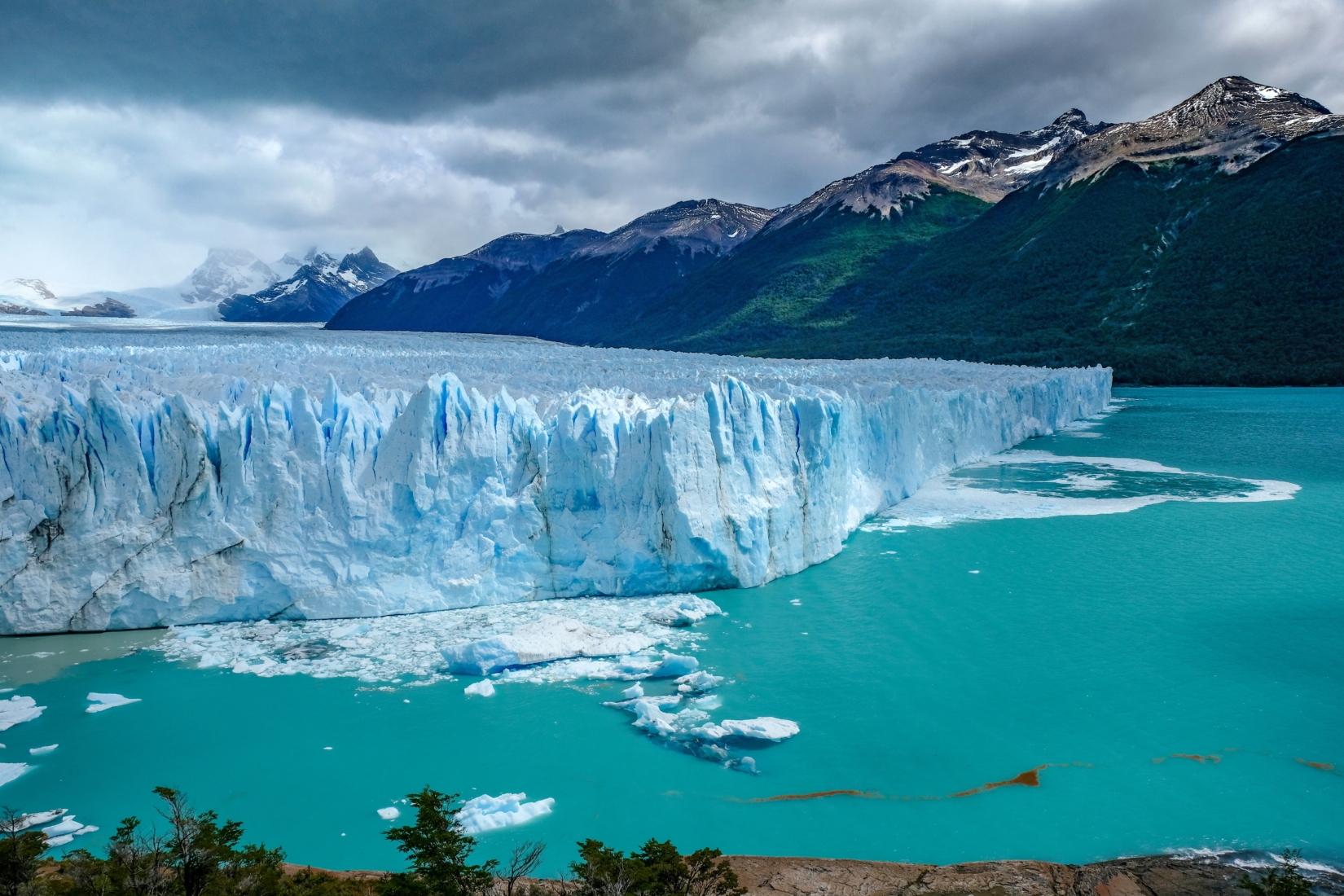
Argentine Patagonia is a land of true extremes, of sights and sweeping vistas that you need to see to believe. Here, the mountain tops of the Fitz Roy skewer the clouds. There, the rolling pampas are dotted with sheep farms. Suddenly, killer whales splash through the oceans. Then, a colossal ice sheet fragments from the Andean glaciers on high. If we could design a region for adventure travelers, it really would look something like Argentinian Patagonia!
This ultimate guide to Argentine Patagonia offers a look at this amazing corner of South America. It ranges from an introduction of the lake district of Bariloche and the penguin-spotted channels of Tierra del Fuego to advice on the best activities and must-see attractions in Patagonia and what to pack for your trip. We’ll also cover details about the best times to visit, what the weather is like, and the practicalities of getting there. Let’s jump into it!
Inside this Guide
My experience in argentine patagonia, where is argentinian patagonia, how to get there, when is the best time to visit, what to pack for argentine patagonia, top travel destinations while visiting argentinian patagonia, must-see attractions in argentinian patagonia, top hikes in argentinian patagonia.
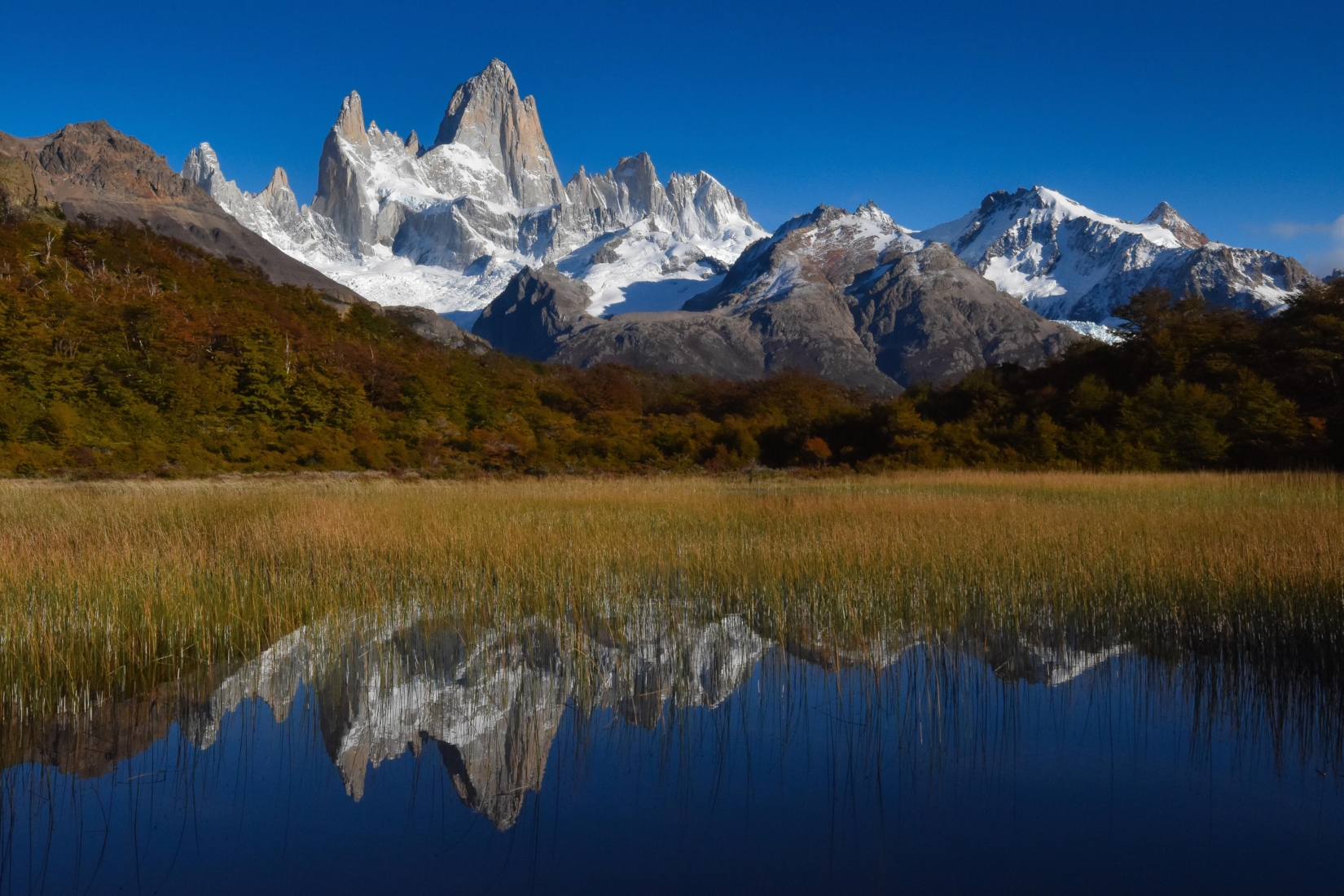
Just a mention of the name Patagonia is always enough to get the hairs standing on the back of my neck. And if you ask me about the Argentinian part of that great wilderness, I begin to recall images of the jagged Fitz Roy , the ice-shaking Perito Moreno Glacier, the dramatic landscape of Tierra del Fuego, and the inky lakes of Bariloche.
I’ve now trekked and traversed these lands and wonders extensively. But the former sense of majesty and mystique that visiting Argentinian Patagonia inspired has never fully left me. Whenever I pack the crampons and lace the boots for a trip to this frontier of South America, I fizz with a mix of excitement, joy, and apprehension, all fueled by the prospect of returning to what I now know to be unquestionably one of the most savage, yet sublime, parts of the planet.
The magic of destinations like Patagonia helped me to make a career out of travel. I’m so fortunate to have founded The Explorer’s Passage , the world’s premier adventure travel company. We pride ourselves in assisting travelers to experience the most unique corners of the planet through meticulously executed trips. Join us for a jaunt to Argentina and rest assured we’ll take care of all the details so you can enjoy your trip in the most intimate, exhilarating ways possible.
Argentinian Patagonia is a seriously vast region. It encompasses more than a quarter of the latitudes of South America as a whole, running just shy of 1,000 miles (1,609 km) from the winding Rio Negro (generally accepted to be its northern border) to the fragmented isles of Tierra del Fuego on the cusp of Cape Horn.
The greater region of Patagonia is shared between Argentina and Chile. The land area of both is similar from north to south but the Chilean side is nowhere near as wide. It encompasses a long run of the snow-capped Andes and a sliver of coastal plains before bending into the Magellan Strait. The Argentine side, meanwhile, hits nearly 500 miles (805 km) at its widest point, rolling from alpine lakes and glaciers to barren pampas and steppes. If you’re also interested in exploring the Chilean side of Patagonia, check out our W Trek Adventure !
The extreme far Southern Patagonia is a fragment of the Isla Grande de Tierra del Fuego. That, in turn, is entirely separated from the Argentina mainland, sharing a sole land border with Chilean Patagonia to the west. There are also a number of offshore territories that belong to the region, including the seal-spotted Isla de los Estados, which is considered to be the very end of the Andes mountain chain within southern Patagonia

As you might imagine, getting to Argentine Patagonia, this far-flung corner of South America, isn’t as simple as jetting into Buenos Aires for a night in the tango halls. But it’s also not super difficult. The reason? Flights. While the majority of international links into Argentina still head straight to the capital’s Ministro Pistarini International Airport (also known as Ezeiza International Airport), there are plenty of domestic connections that help you make the hop – and it’s still a hefty hop, mind you – into Patagonia.
The most popular air route services to get to Argentinian Patagonia from Buenos Aires are the ones that go direct to El Calafate (taking just over 3 hours) and to the stunning mountain resort of Bariloche (taking 2.5 hours). You can also go straight to Ushuaia, the most southerly city in the world, in as little as 3.5 hours.
Prefer traveling via land? Don’t worry – the old-school way of getting to southern Patagonia is still very much alive. Buses link to Bariloche from Buenos Aires in around a full day’s travel, though the ride is a real adventure going straight across the heart of the country, providing nice views while getting to Argentine Patagonia.
There are others that make the long road trip down the iconic Ruta 40 (one of South America’s most breathtaking highways) from Bariloche to the trekking hub of El Chaltén, usually taking upwards of 25 hours in all, providing amazing views and scenery as you travel to Patagonia.
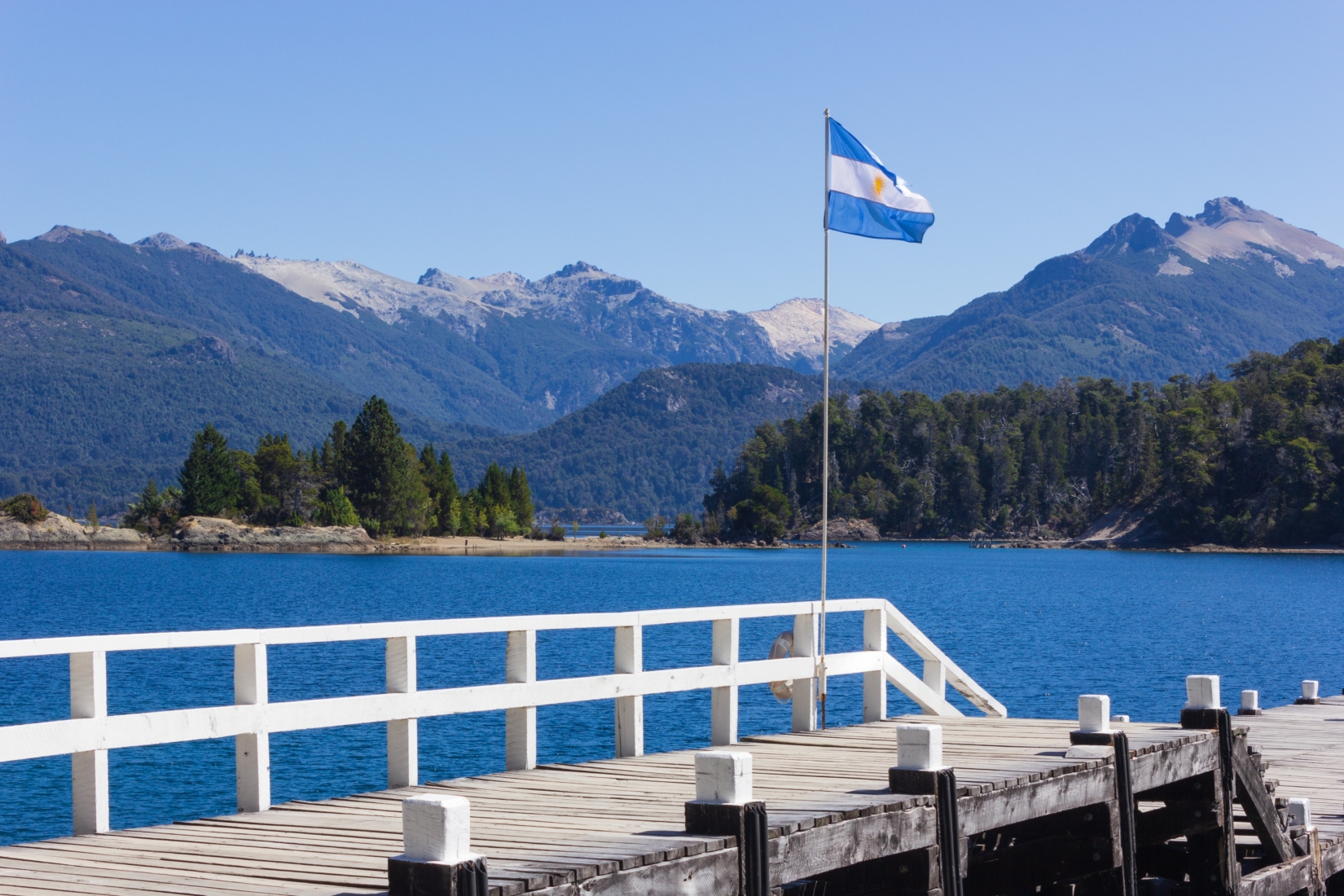
It’s hard to predict what the weather will be like in regions like Patagonia that sit at the very ends of the Earth. However, there is a clear four-season pattern that can offer some insights into the sort of conditions you can expect during certain months to give you a good idea of what to pack according to the time of your trip to Argentine Patagonia. Let’s take a closer look…
- Winter (June to August) – Winter can be harsh in this extremity of the continent. Down in Ushuaia, it’s possible to see thermometers ebb to around 20°F (-7°C), but most days it’s between 30 to 50°F (-1 to 10°C). It will get warmer as you head north, but the Andes create huge snow systems that can cover the major hiking hubs of El Calafate and El Chaltén.
Trails don’t completely close per se, but it’s virtually impossible to complete the longer routes while touring Argentinian Patagonia at this time of year. At best, you’ll be looking at short day hikes and will need to be wary of changeable conditions. The real upshot of traveling here in the winter is the excellent skiing. Bariloche is the center of that, with a season that typically runs from April to October.
- Spring (September to November) – Spring is a time of serious transition that can mean hefty temperature fluctuations in the Andes. Those hitting the walking hubs around Fitz Roy might get wildflower displays and milder winds than in the summer, but layering is key while visiting Argentinian Patagonia during this time of the year as below-freezing nights follow positively balmy, sun-drenched days in the 60°F (15 to 20°C) range.
However, rainfall does ease off, getting to a yearly low of just over 1.5 inches (40 mm) in El Chaltén in November, making this the start of a few good months to consider visiting. What’s more, spring is prime time for whale watching on the rugged Argentinian Atlantic coast or enjoying beautiful scenery in the Argentine lake district.
- Summer (December to February) – Often seen as the runaway best time to come trekking in Patagonia, the summer is about clear, dry days and cool nights. Temperatures in the main hiking areas tend to hover around the 60s and low 70s (15 to 22°C), but stay closer to 55°F (13°C) in Ushuaia. December sees the annual peak for sunshine hours, providing exceptional weather for touring and exploring all of the must-see attractions that Argentine Patagonia has to offer.
Rainfall tends to be lower towards the start of the season, sticking to 2 inches (50 mm) in December. All that means is the trails of El Chaltén are in fine condition and the glacier face at Perito Moreno is most likely to showcase its incredible calving process. The downside? The prices are higher and there are always crowds around, not to mention the winds from the west can be very strong. For these reasons, not everyone agrees that these popular months are the best time to visit.
- Fall (March to May) – The fall months are the wettest across the whole region which must be considered when planning your trip and what to pack for Argentine Patagonia. Take El Chaltén for example, precipitation levels there can be almost double in April than they are in September. The weather in Patagonia naturally has an adverse effect on the quality of the trails and the views – rains mean clouds and clouds can mean bad photos.
But all is not lost. It doesn’t rain all the time during the autumn and when it clears, you’ll be able to see the ochre, orange, and red changing of the forests in the subalpine zones. Plus, there tend to be way fewer trekkers around at this time, helping to cut prices and up that feeling of total seclusion during your visit to Argentine Patagonia.

As previously mentioned, the weather in Argentine Patagonia can be very unpredictable with temperatures ranging from 20 to 70°F (-7 to 22°C) depending on the time of year you decide to visit. Plus, rain and snow are also fairly common in this region, so it is important to bring along waterproof outerwear and trekking boots to keep dry while touring or trekking in these parts. Your best bet for packing for Argentine Patagonia is to layer up and be prepared to shed a few layers as the day gets warmer and your body heats up while trekking.
Aside from considering the ranging temperatures and weather in Argentine Patagonia, it is also important to take into account the sunny days while packing for your trip. A good pair of polarized sunglasses and plenty of sunscreen will be your best friend to protect against blinding sun rays reflecting off of ice, snow, and water in this region. This will be especially helpful when you spend hours in direct sunlight while trekking.
Below you’ll find a basic list of the essential items we recommend you bring while visiting Patagonia.
- Trekking boots (waterproof)
- Long thermal underwear, shirts, and pants
- Light fleece jacket
- Protective outer-layer jacket (waterproof)
- Sunscreen and insect repellent
- Quick dry towel
- Trekking backpack
Additionally, we’ve got a more general guide for what to pack in your daypack while trekking if you just don’t know where to start!
Patagonia isn’t just one destination. It’s hundreds. They’re all wedged into this 400,000-square mile (1,036,000-sq km) block of South America, ranging from the spiked Andean peaks to wave-lashed shorelines. Some of the most enticing places of the lot are located on Argentina’s side of the border, too.
Here are some of our top picks for cities and towns to visit:
- El Chaltén – They call El Chaltén the “National Capital of Trekking in Argentina.” The town, a ramshackle and surprising mix of backpacker hostels and sleek mountain spas, sits at the foot of the great Fitz Roy massif, attracting many travelers seeking to knock “trekking in Patagonia” off their bucket list.
Look west and you’ll see the toothed tops of what some consider to be the most incredible part of the Andes, rising 11,170 feet (3,405 m) above sea level. There are trails galore, from the 11.8-mile (19-km) romp to the Laguna Torre to the soaring panoramic Pliegue Tumbado walk, allowing for anyone to find a hike in Argentinian Patagonia that suits their abilities. Back in the El Chaltén town center, there’s a real frontier vibe, with swinging-door saloons and timber taverns selling hearty Argentine steaks and stews .
- El Calafate – The gateway city to the eye-watering Parque Nacional Los Glaciares is tucked into what’s surely one of the most incredible clefts in the Andes of western Argentina. Most people come to this part of southern Patagonia to catch a glimpse of one thing: Perito Moreno Glacier, one of the must-see attractions in Argentine Patagonia that we’ll cover more about later. That hulking tongue of moving ice can be seen calving bergs into the glistening glacier lake that forms right in front of it. There are other draws besides the Perito Moreno Glacier, too – 4X4 excursions, trekking in Los Glaciares, helicopter flyovers, and stargazing are all on the menu.
- Bariloche – Full name: San Carlos de Bariloche. Reputation: “Patagonia’s most charming town,” at least according to Travel + Leisure and oodles of folks who’ve gone. Set along the shores of inky Nahuel Huapi Lake within the Argentine lake district, this elegant escape in the Andes can often feel more like Switzerland than South America. Bariloche is topped by churches that would look right at home in Geneva and has a framing of snow-capped mountains. There’s skiing to be done in the winter on the slopes of Catedral Alta, as well as hiking up Cerro Llao Llao and Cerro Campanario depending on the weather in Patagonia during your visit. And the wonderful Argentinian Lake District unfolds on its doorstep.
- Ushuaia – Plonked on the 54th parallel, Ushuaia is the world’s southernmost city located at the tip of Argentine Patagonia. It spreads out before the sloshing waters of the Beagle Channel beneath the Martial Glacier, the terminus of both the Pan-American Highway and Argentina National Route 3. To put it another way: This is very much the end of the road, unless, of course, you’re headed to Antarctica via a sea voyage, which mainly departs from here. In this case, check out our Antarctica Cruise Guide for all the information you’ll need to reach the base of the globe.
Adventurers visiting Ushuaia in Argentine Patagonia have plenty to do, from seafaring in the Tierra del Fuego and meeting penguin colonies to climbing windblown peaks above the shipwreck-dotted San Pablo Cape.
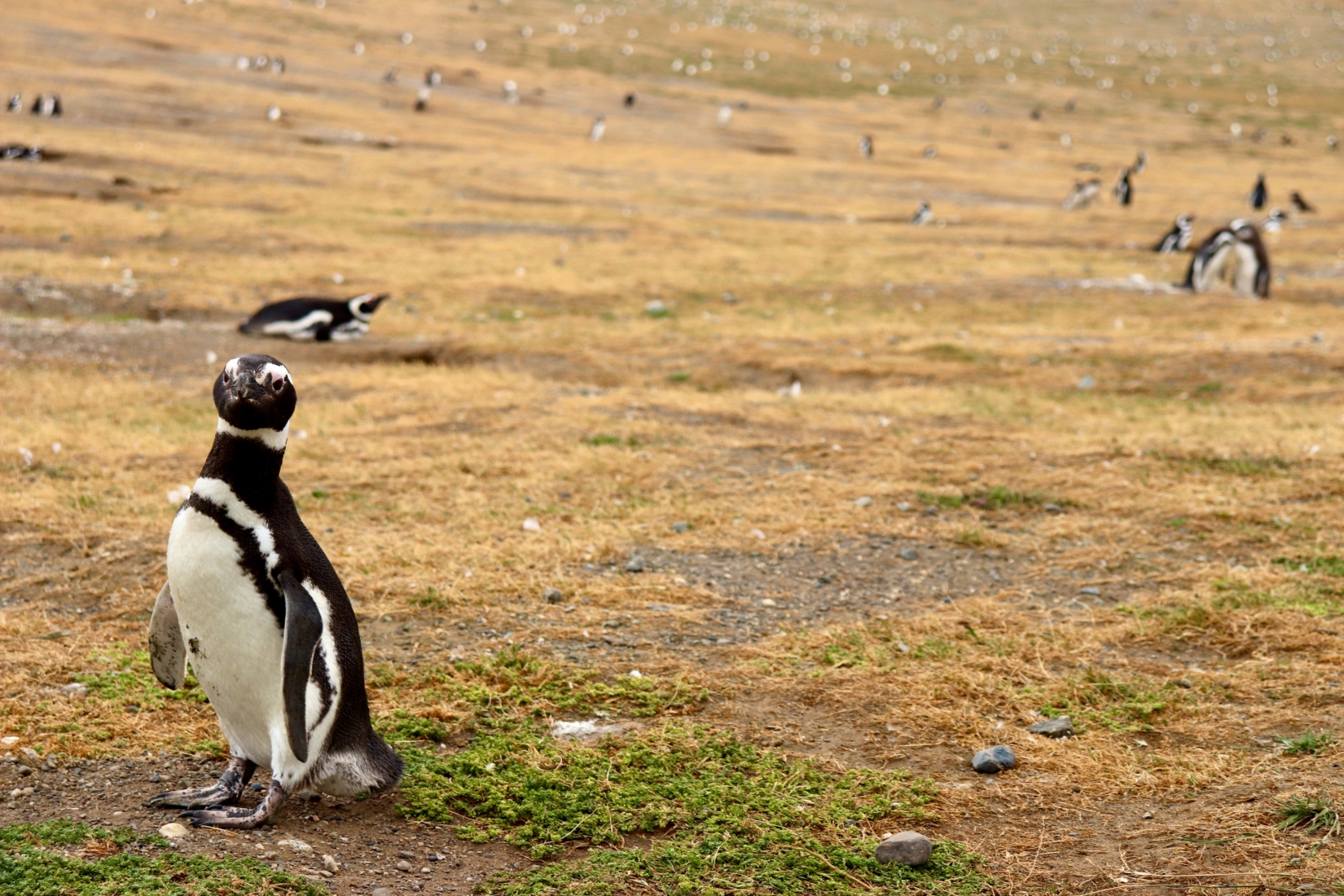
- Puerto Madryn – One part industrial and one part wild, Puerto Madryn is the entry point to the legendary Península Valdés . That’s the area you’ll want to focus on while touring Argentine Patagonia, particularly in the months between June and January, when the southern right whales pass through en masse, attracting many tourists to travel to Patagonia. Even without the cetaceans, it’s a pretty epic region dotted with pink-tinged salt pans and beset by primeval steppe.
Make sure to stop in these villages and cities for a multifaceted trip that is sure to excite.
It’s easy to see why Argentinian Patagonia can be a favorite on an outdoorsy, adventure seeker’s list of top destinations. The sights and activities are largely majestic jagged peaks and scenic hikes on the trails that weave around them. Plus, the penguin and whale spotting is not to be missed.
Plan to see these popular attractions when you go:
- Fitz Roy – Cerro Fitz Roy spikes the skies to the west of El Chaltén town, heralding arguably the most iconic mountain massif in South America, drawing in lots of tourists to Argentine Patagonia. It’s almost impossible to believe it’s real, what with pinnacle after pinnacle of granite monolith lurching straight from the edge of a gleaming glacier. Conquering the top on your Patagonia trek is a serious mountaineering undertaking. Most trekkers stick to viewpoints around the Laguna de los Tres just below (more on that later).
- Perito Moreno Glacier – Set at an opening in the Andes some 50 miles (80.5 km) to the west of El Calafate in southern Patagonia, the Perito Moreno Glacier has been wowing travelers for decades. Covering nearly 100 square miles (259 sq km) of a wide valley in the Los Glaciares National Park, it’s arguably the best place in the world to see the process of calving (when glaciers fragment into icebergs where they meet the water).
You can also hike right on top of the Perito Moreno Glacier. Choose between mini trekking options to sample crampon trekking, or go for the Big Ice adventure – a challenging hike lasting 12 hours that takes you across much more of the glacier surface. Hiking the Perito Moreno Glacier is sure to be an awe-inspiring experience for any travelers visiting Argentine Patagonia.
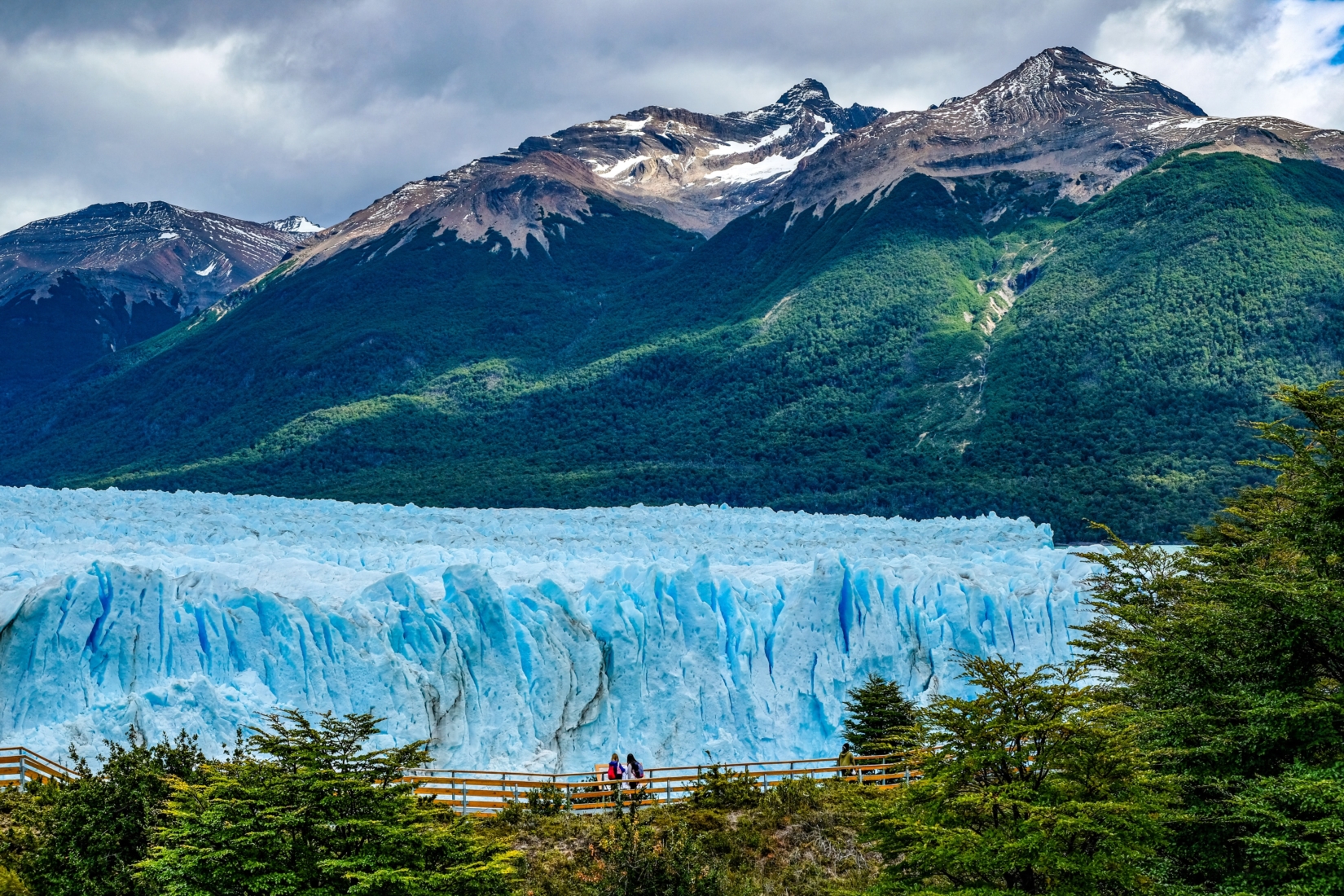
- Tierra del Fuego – Tierra del Fuego is where the end of South America fragments into the Atlantic Ocean at the tip of Patagonia. Like so many parts of this region, it’s shared between Chile and Argentina, but it’s the latter that has the main base: Ushuaia, the southernmost city in the world, that we covered above. Tierra del Fuego visitors will often start the day with a hike to the scenic Glacier Martial and then venture out by water to spot Gentoo penguins and sea lions on the Beagle Channel and beyond.
- Whale watching – Argentinian Patagonia actually has some of the finest whale watching on the continent. That’s despite the fact that there’s really only one destination that has the infrastructure and natural gifts for it. You’re looking for the duo of Puerto Madryn and the whole Península Valdés. The main species to spot are southern right whales and orcas, along with all manner of dolphins and penguins. The best time to visit Patagonia for whale watching is between June and December.
- Trekking – Last but most certainly not least, the trekking. Argentinian Patagonia can rival even the mighty Himalaya on this front. There are treks of all shapes and sizes, levels, and styles fit for anyone. We’ll take a look at the most famous Patagonia treks in just a moment but suffice to say that there are routes that let you get up close and personal with jagged mountains like the Fitz Roy and others that let you tread on colossal glaciers such as the famous Perito Moreno Glacier.
Spring and summer are generally considered the best time to travel to Patagonia if you wish to hit the trails, as many of the routes close completely due to snowfall during the other seasons.
If you’re interested in hiking Torres del Paine on the Chilean side of Patagonia, check out our 19 Things to Know Before Hiking the W Trek .
A 1,000-mile (1,069-km) string of the Andes bisects the whole of Patagonia, delineating much of the border between Chile and Argentina. But Argentina gets the eastern section of the mountains, which is generally considered to be the premier trekking part. It’s where you can tread on epic trails, such as:
- Laguna de los Tres – The Laguna de los Tres is the piece de resistance of El Chaltén, the trekking capital of the country. It begins in the town itself, then passes through woods of fire trees and barberry bushes, then emerges onto exposed slopes with a steep ascent onto a glacier-carved moraine. That’s where the glimmering waters of the Laguna de los Tres unfold, right beneath the hulking granite spires of the Fitz Roy. There’s really no better viewpoint around. Sunrise hikes in Patagonia are extra special since you see the peaks glow radiant pinks and reds in the first rays of the day.
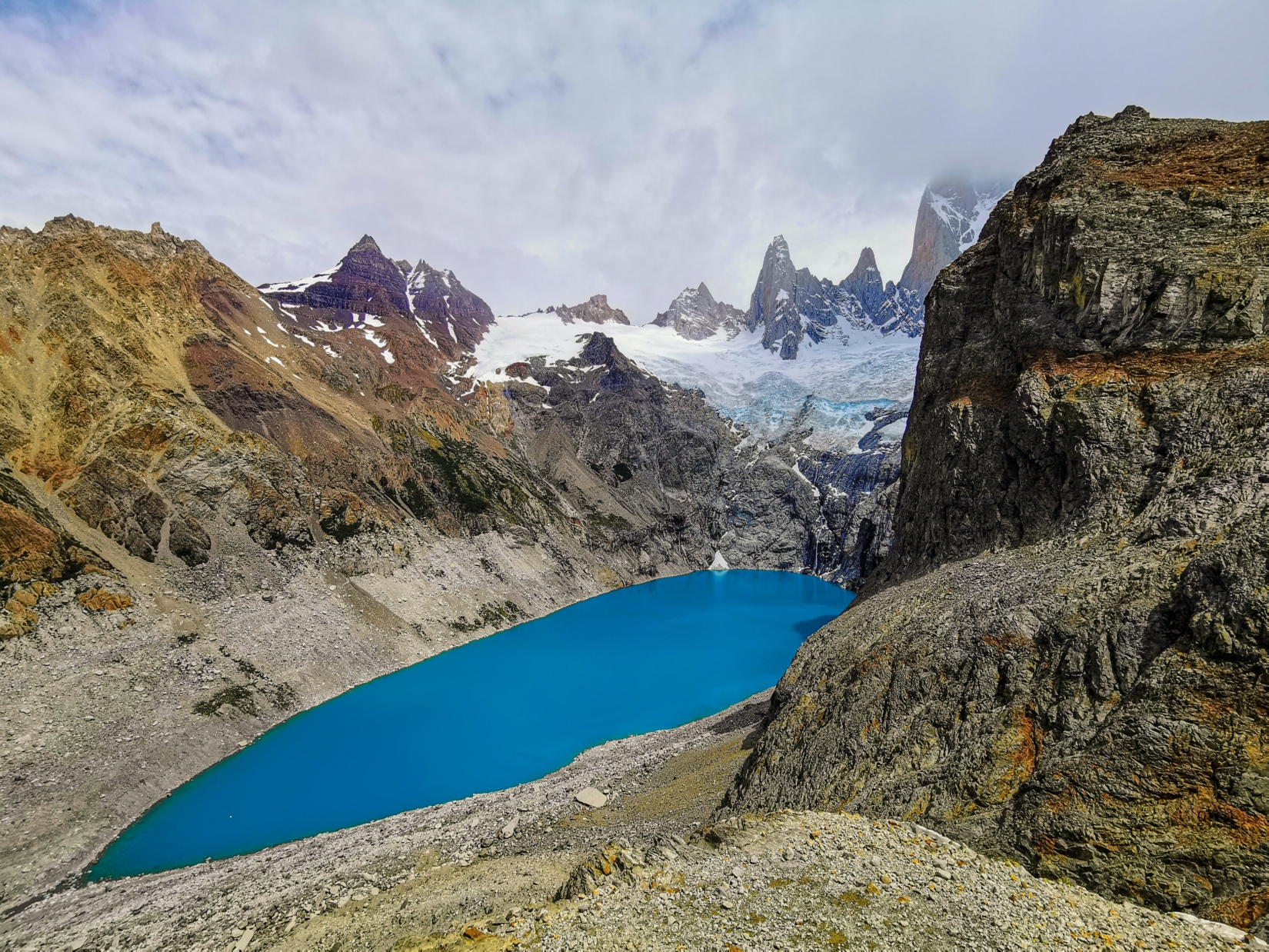
- Laguna Torre – A 9-hour hike through the valley behind the Fitz Roy massif can bring you into the domain of the Laguna Torre. It’s a needle-like stack of stone that’s considered one of the hardest climbing feats in the world. You won’t be harnessing up to do that, but the journey there offers sublime views of the Grande Glacier and an inky mountain lake framed by the summit itself. A good option is to stay in the backcountry campground – that will let you complete the hike at sunrise, when the Laguna Torre peak looks, simply, stunning.
- Big Ice – Helping you scratch a line from the bucket list, the Big Ice tour is a trek actually on top of the Perito Moreno Glacier. There are shorter options known as mini treks, but this is the true expedition for exploring the nooks and crannies of the creaking ice field as it cascades down from the heights of Cerro Pietrobelli. Days start with a hike along a tough moraine before you cross to the glacier itself to see, firsthand, pristine ice caves and crevasses cut into the surface all throughout your hike in Patagonia.
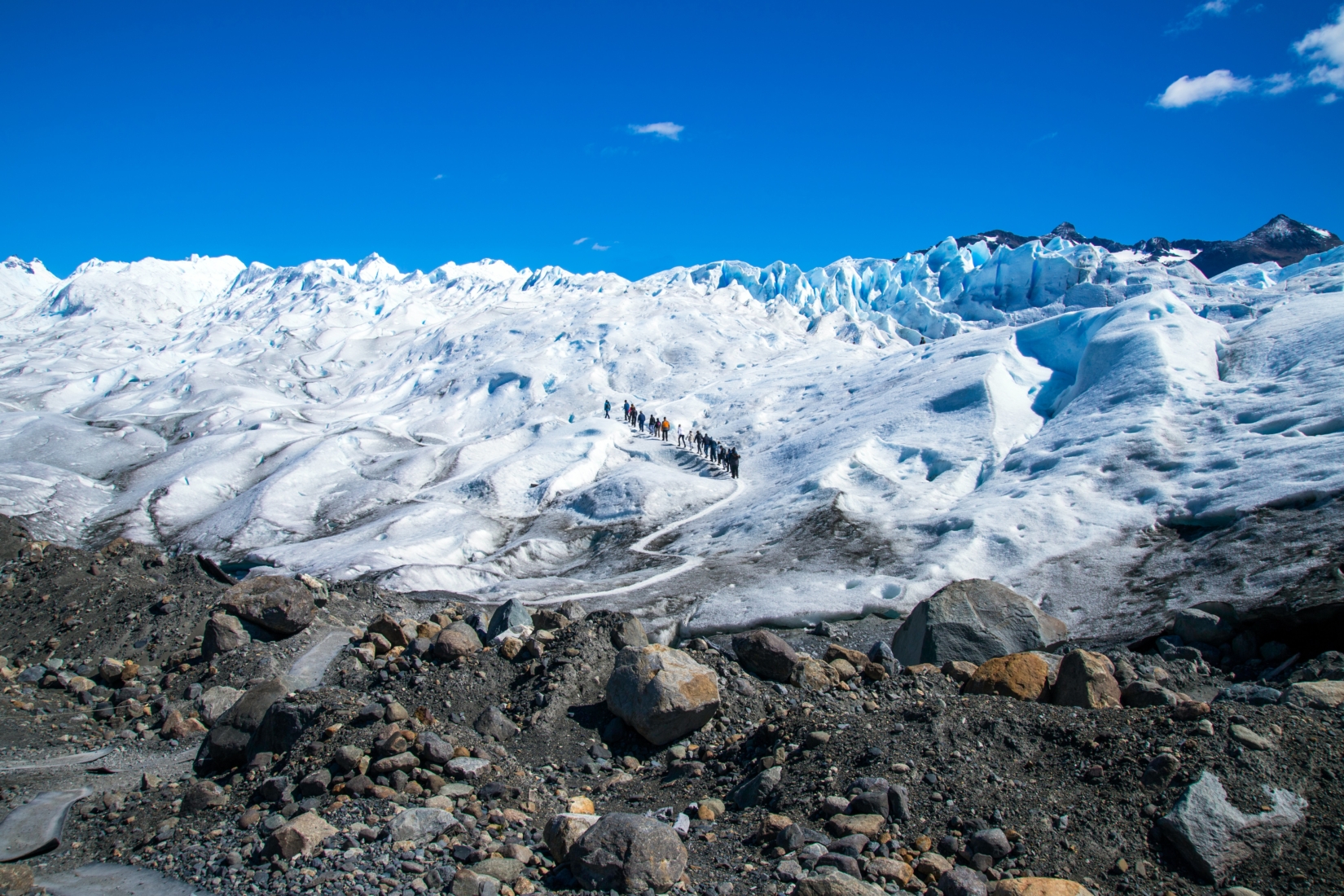
- Huemul Circuit – If you’re all about spying the vast white plains of the Southern Patagonian Ice Field, then there’s no better hike than the Huemul Circuit. It’s 4 days and 40 miles (64 km) of dramatic, high-altitude scenery in the depths of the Los Glaciares west of El Chaltén. This hike is a challenge, requiring river fording, use of a Tyrolean traverse, and 3,000-foot (91 m) ascents in a single day. Highlights along this hike in Patagonia include the Paso del Viento , a wind-blasted pass under Cerro Huemul, and sections along sky-blue Viedma Lake.
- Pliegue Tumbado – This Patagonia hike, taking you ever higher and higher from a starting point in a local visitors’ center to the Pliegue Tumbado plateau, is all about gaining a vantage point to survey El Chaltén’s unrivaled little crevice in the Andes. This hike is highly exposed and usually windy in the dominant summer westerlies. At 4,900 feet (1,494 m) up, you’ll gain a ridge that takes in the Fitz Roy to the north and glacier-draped Mount Huemul to the west.
This trip guide is just a taste of what you’ll experience on a remarkable visit to Argentine Patagonia. If you have more questions on visiting Argentinian Patagonia or need help planning your trip, let’s connect! Our knowledgeable Adventure Consultants would love to hear from you so contact us and let us show you what’s possible .
Why travel with The Explorer’s Passage?
We pride ourselves on delivering extraordinary tours based on travelers’ needs and are humbled by our guests’ testimonials . In fact, our dedication has earned us a 5-star rating on Tripadvisor , and awards by Travel+Leisure Magazine and Newsweek. Check us out and discover why so many travelers worldwide choose us . My team and I would love for you to join us in Argentine Patagonia or or any of our many other adventure trips !
Cheers, Jeff
Jeff Bonaldi Founder & CEO The Explorer’s Passage
About Jeff Bonaldi
Jeff Bonaldi is the Founder and CEO of The Explorer’s Passage, a premier adventure travel company. His mission is to provide travelers with the opportunity to transform their lives and the planet through the power of adventure.
Learn more about Jeff’s story and his company HERE .
Share This Amazing Location!
Related posts.
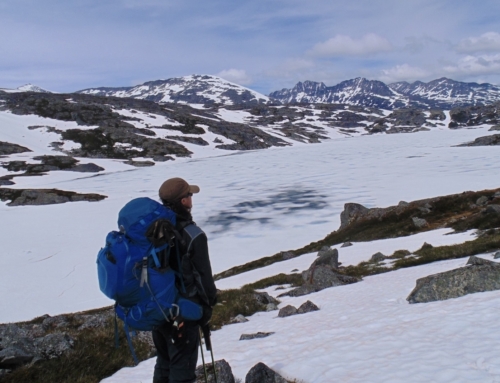
A Traveler’s Must-Read Guide to the Chilkoot Trail Hike
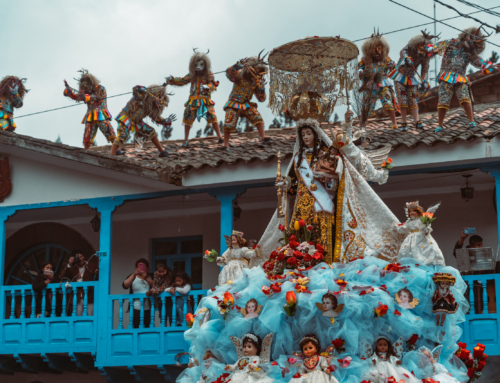
All You Need to Know About the Virgen del Carmen Festival in Peru
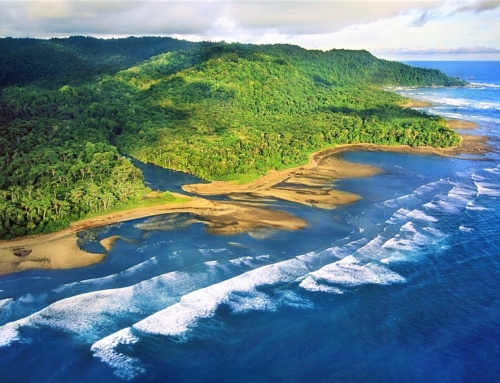
Top Attractions on the Osa Peninsula in Costa Rica

Ultimate Guanacaste Travel Guide – Explore Costa Rica’s Coastal Paradise
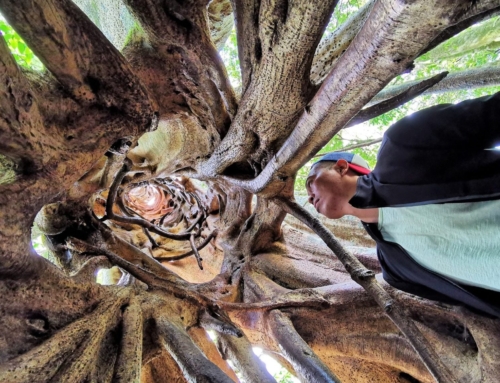
Top Things to Know Before Visiting Monteverde, Costa Rica

A Traveler’s Handbook to Manuel Antonio in Costa Rica – Everything to Know for Your Trip


Ultimate Patagonia 10 day itinerary that will knock your socks off
Jagged mountains, howling wind and the raw beauty of nature – that is Patagonia. This amazing part of the South American continent is one of the most scarcely populated, one of the windiest, and easily one of the most beautiful regions in the world.
Our Patagonia 10 day itinerary takes you through the most exciting parts of Chilean and Argentinian Patagonia and shows you why Patagonia is a true paradise for nature lovers, adventurers, and photography enthusiasts.
This Patagonia itinerary starts and finishes in Punta Arenas (Chile), however, depending on your previous and following travels, it may as well start and finish in El Calafate (Argentina) or you may make it as a one-way trip from Chile to Argentina or vice versa.
It is a 10 day itinerary, however, we’ve constructed it to remain flexible, allowing you to add or remove days at certain places according to your preferences, time schedule and budget.
You can thus easily make this into a one week or two week Patagonia itinerary. The itinerary offers a choice of self-driving a rental car or using public bus services.
In this article, we give you some comprehensive information on accommodation, restaurants, transportation and budget.
Now let’s have a look at those 10 fun-filled days, which include visiting Parque Nacional Torres del Paine and Los Glaciares, having a glass of whiskey on a glacier, hiking, and more!
This post may contain affiliate links, which means that if you purchase anything via them, we might earn a small commission – at no extra cost to you. Check our affiliate disclaimer for more information.
Our Patagonia 10 day itinerary
So let’s dive right in – here is the Patagonia trip that we did. After this, you’ll get our best tips for planning your own trip if you’d like to make any adjustments.
Day 1 of Patagonia itinerary – Arrive in Punta Arenas

If your flight arrives early enough (i.e. before lunch), you might continue this very same day to Puerto Natales (approximately 3 hours) or Torres del Paine (approximately 5 hours).
While Punta Arenas itself is not the highlight of your trip to Patagonia – you’ve come here for the breathtaking nature – the city is a pleasant surprise and feels different from Chilean cities further north. It is a unique mix of the South American version of Scandinavia with some Croatian influence and a local touch.
Hard to imagine this? Then why not use your free evening here to check it out for yourself – take a pleasant stroll and say hi to the monument of Ferdinand Magellan on Plaza de Armas.
Did you know it was him who named Patagonia Patagonia? His expedition thought the local tribes to be giants with huge feet and called them Patagons, derived from pata = foot.
For dinner try some local delicacies such as Patagonian lamb or king crab with a bottle of great Chilean wine – that will be a perfect start for your 10 days in Patagonia.
Day 2 of Patagonia itinerary – Have fun watching penguins on Isla Magdalena

Wanna see penguins? Well, we did!
If you stayed overnight in Punta Arenas, a half-day tour to Monumento Natural Los Pinguinos on Isla Magdalena is a great way how to start your Patagonian adventure.
Isla Magdalena is a small island in the Strait of Magellan, located about 30 km from Punta Arenas. It is home to a colony of about a hundred thousand Magellanic penguins. Take warm clothes (yes, even in the middle of summer) and your camera and have fun as you watch these cute little guys stumble clumsily right by your feet.
This tour is typically available in the morning, so you would be back in Punta Arenas by noon – a great time to have lunch, pick up your rental car (or take a bus), stock up on some food you might need in Torres del Paine (there are very few options for shopping and they are expensive) and set off to Torres del Paine.
Check availability:
Related: visiting the penguins on isla magdalena is one of the 7 unforgettable experiences not to be missed on your patagonia itinerary.
On the way, stop in Puerto Natales – the closest town to Torres del Paine with a pleasant atmosphere.
By the time you’ve made it here, you probably noticed that Patagonia is one of the windiest regions in the world. So it comes as no surprise that Puerto Natales has its monument dedicated to the wind – Monumento al Viento. Yup, there’s a lot to celebrate here, with winds of 100 km/h being nothing unusual.
If you’re driving, it’s a good idea to refuel here, and even take some extra fuel with you in the containers, as there is no fuel in Torres del Paine. Refuelled and re-coffee’d , continue to your accommodation in Torres del Paine.
Days 3, 4, and 5 of Patagonia itinerary – Enjoy the fascinating Torres del Paine National Park

Wherever you go and whatever you do, dress in layers.
Waterproof and windproof clothes will be your best friends, as the weather might be fierce – heavy rain-shower followed by a beautiful blue sky that will soon be turning dark-dark grey, hey, here comes a brief snow-shower and voila, it’s all sunny and warm again.
Related: What to pack to Patagonia
And the wind, oh yeah, that will be one hell of a blow! That is the typical Patagonian weather.
But don’t let that discourage you – Torres del Paine offers some of the best sceneries in the world.
What to do during these three days?
Hike, ride a horse like a Patagonian gaucho, kayak, walk to the viewpoints, take pictures and let the scenery knock your socks off (don’t let the wind knock your hat off, though). There are just so many things to do in Torres del Paine!
When we were here during our own Patagonia trip, the weather was rather bad. We managed a short hike to Lago Nordenskjold , but that was about it.
Other than that, we just drove around the park, stopping occasionally at some interesting spots, and enjoying the views – they were incredible even without hiking! And Michal did some morning photography.
Or are you just feeling lazy? Then open a bottle of Chilean Carmenere and enjoy the fresh air.
It’s pretty much impossible for us to tell you “you should do this hike on this day and that activity on that day”. The weather is wayyyy too unreliable, so the best way is for you to just check out what options are there that match your interests and your budget, make a list, and then make a solid plan for the specific day.
Day 6 of Patagonia itinerary – Drive from Torres del Paine to El Chalten

This will take approximately 6 hours, so you’ll be arriving in the trekking capital of Argentina in the afternoon.
The last kilometres of the road before El Chalten offer some of the best views in Patagonia with the breathtaking background of Mt. Fitz Roy.
Just before entering the small town of El Chalten, the information centre of the national park Los Glaciares is on the left – do pop in! T hey have the latest information about the condition of the trails and a detailed weather forecast.
Spend the rest of this day relaxing in El Chalten. This small mountain town has a pleasant atmosphere and, unlike Torres del Paine, a rather good and rich food and drink scene , even some artisanal breweries.
Day 6 and 7 of Patagonia itinerary – Enjoy El Chalten and Los Glaciares National Park

There’s a good reason why they call this place the trekking capital of Argentina – the hikes with some amazing scenery were the highlight of our stay here. Some of the best hikes in Patagonia are there .
There is a hike available for everyone here – from short walks to day hikes .
During our days in Los Glaciares National Park , we did a day hike to the Laguna de los Tres and a walk to the Mirador Los Condores. The weather didn’t permit anything more. Actually, my legs didn’t as well, haha!
Michal again did some amazing morning shots of the mountains around El Chalten – as you could see in the pictures before and in our Patagonia travel diary as well.
Finish off your days with a hearty meal and some artisanal beer – it will taste damn good after the long day of hiking.
Day 8 of Patagonia itinerary – Drive from El Chalten to El Calafate
This will take only about 3 hours, making this a relaxing day after those busy hiking days.
Explore El Calafate, a very pleasant town at the shore of the beautiful Lake Argentino, the biggest freshwater lake in Argentina.
Did you know the town got its name after calafate berries that are indigenous to Patagonia?
Try a calafate ice cream as you’re enjoying your afternoon in El Calafate – not only will it taste yummy but a legend says it will also guarantee your return to Patagonia.
Seriously. Ask any of the locals 😊
Day 9 of Patagonia itinerary – Have an unforgettable whiskey and ice experience on Perito Moreno glacier

Perito Moreno awaits you and it’s gonna be unforgettable. This glacier, located about 80 km from El Calafate, will inspire all of your senses. Watch its impressive 60-metre tall front wall, hear the roar as huge pieces of ice fall off to the lake – it will cause you goosebumps, touch this immense beauty, taste it – 12-year-old whiskey with 300-year-old glacial ice – why not ? and smell it – the air is as fresh here as it gets.
Whether you put on the crampons and walk on the glacier (we definitely recommend this) or just admire it from the shore or from a boat , it is going to be fun for the whole day.
Day 10 of Patagonia itinerary – Say bye to Patagonia
If you’re finishing your Patagonia itinerary in Punta Arenas, you will use this day to drive from El Calafate to Punta Arenas, which will take about 7 – 8 hours.
Refuel before setting off, and then perhaps again in Puerto Natales, which is also a good place where to stop for lunch.
It’s a rather long drive altogether, giving you enough time to reflect on all the amazing memories you’re now bringing with you from Patagonia.
Already feel like returning here? The calafate ice cream works miracles, doesn’t it? 😊
Tips for planning your Patagonia itinerary
In this section, we’ll give you some information to help plan your Patagonia trip .
Since Patagonia is quite a remote region, it’s better to plan your vacation there quite a bit ahead of going. There are limited amounts of accommodation, restaurants, and grocery stores. And let’s not even talk about the gas stations!
Plus, what to pack? How’s the weather? Where and when to go? We’re going to answer all of these questions here.
Flights to Patagonia
The two principal airports serving Patagonia are Punta Arenas in Chile and El Calafate in Argentina . There’s a small airport in Puerto Natales, which is the closest airport to Torres del Paine, however, it has only a few flights during summer. Overall, the cheapest flights to Patagonia are from Santiago to Punta Arenas operated by Sky Airline and Jetsmart .
Punta Arenas airport – PUQ
Punta Arenas has numerous daily flights to Santiago , a few of them with a stop-over in Puerto Montt. These are operated by:
- LATAM – usually expensive, unless the flight is part of an international trip, e.g. New York – Santiago – Punta Arenas,
- Sky Airline – low-cost, usually cheap, even ridiculously cheap when booked well in advance,
- Jetsmart – similar to Sky Airline.
Also, there are flights to Ushuaia operated during summer by DAP Airline .
We think this is the best way how to get to Torres del Paine – flying down to Patagonia and driving a car.
Puerto Natales (PNT)
Puerto Natales (PNT) has flights to Santiago operated by LATAM several times per week during summer. There are fewer flights available than from Punta Arenas. Also, it’s a more expensive option than flying to Punta Arenas.
El Calafate (FTE)
El Calafate (FTE) has several daily flights to Buenos Aires operated by Aerolineas Argentinas and LATAM (both similarly priced and generally more expensive than the low-costs flying to Punta Arenas).
Word of caution – most of these flights operate to the domestic airport Aeroparque Jorge Newbery in Buenos Aires, while the international flights arrive at Ezeiza airport. In case you’re transferring in Buenos Aires, take this into consideration.
Also, daily flights are available to San Carlos Bariloche and Ushuaia, operated by Aerolineas Argentinas.
Getting around in Patagonia
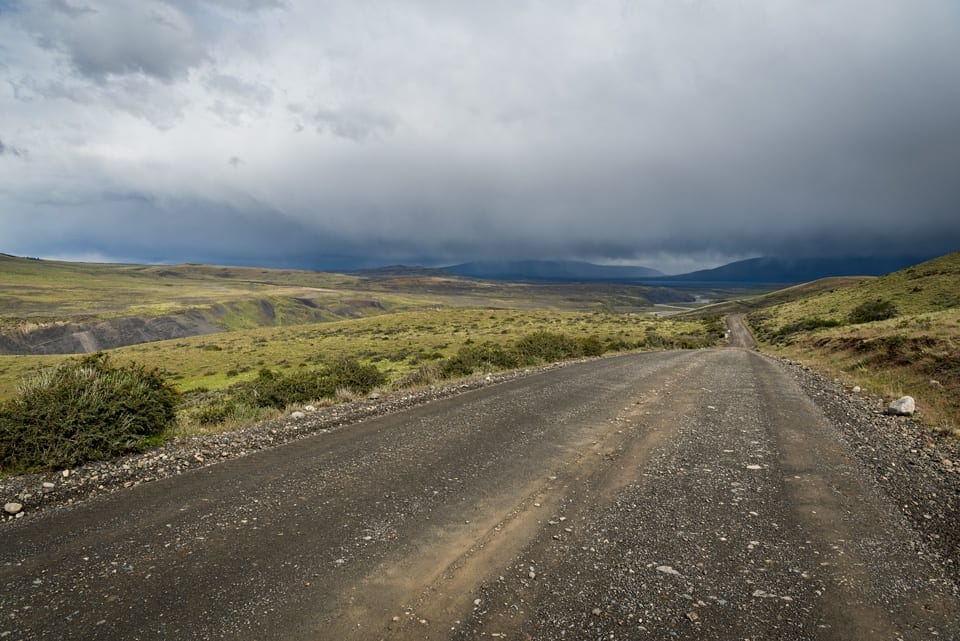
There are two options for how to move around the beautiful Patagonia: either self-driving a rental car or using the bus services.
Having a hard time deciding which one to go for?
While it mostly comes down to your personal preferences and budget, here’s our advice:
- If the highlight of your visit to Torres del Paine National Park is doing the classical 5-day W trek, we recommend the bus service – you wouldn’t use the car at all during these 5 days, so there’s no point in paying for it.
- If you prefer a mix of one-day hikes with the ability to explore some other interesting locations (not only) in Torres del Paine, we recommend renting a car. A car is a more expensive option but it gives you the freedom to move around and be flexible. This might be useful if you, for example, wish to make that one amazing hike in Torres del Paine on the day with the best weather. It should also be noted that if the car is shared by 4 people, the cost per person is actually very similar to the cost of taking the buses all the way.
Buses in Patagonia

While we don’t have personal experience with using bus services in Patagonia, the below-mentioned companies seem to get the best reviews. It is recommended to book tickets online in advance, especially in the high season.
Chilean Patagonia
For moving around Chilean Patagonia, Bus Sur offers the most frequent connections.
They operate:
- several times daily from Punta Arenas (either downtown or straight from the airport) to Puerto Natales (approximately 3 hrs),
- twice daily (might be different if you’re visiting in low season) between Puerto Natales and Torres del Paine (approximately 2 hrs, stopping at Laguna Amarga and Pudeto locations in the park)
- daily service between Puerto Natales and El Calafate, Argentina (approximately 6 hrs).
Argentinian Patagonia
For moving around Argentinian Patagonia, there are the options of Cal-Tur or Chalten Travel , both offering several daily connections between El Calafate and El Chalten (approximately 3 hrs).
For visiting Perito Moreno Glacier from El Calafate, Cal-Tur offers convenient connections, or you can book this transfer as part of a tour.
Renting a car and driving in Patagonia
There are several car rental agencies (not too many, though) in the main Patagonian hubs: Punta Arenas, Puerto Natales and El Calafate. Most of them are small local companies, with some international brands being available as well.
You can rent a car in Chile and take it to Argentina or vice-versa. The rental gets more expensive like this due to the required insurance, however, it is a very convenient way of exploring both the Chilean and Argentinian sides of Patagonia. This is the way we did it, and we definitely recommend exploring Patagonia this way.
We reviewed most of the agencies while deciding which one to choose for renting a car in this remote area.
Obviously, we were looking for a reliable company that would provide us with a middle-sized car and arrange all the paperwork required to take it across the Chilean-Argentinian border, all of this for a competitive price. Based on our email communications, we had the best feeling about renting from ADEL Rent a car based in Punta Arenas.
A 10-day rental of Renault Symbol from ADEL, including all the paperwork to drive to Argentina, amounted Duster SUV (the smallest car available when writing this article) for 10 days, including visiting Argentina, amounts to around 1090000 CLP. We were happy with this company and would recommend them.

Driving in Patagonia
Is driving in Patagonia easy and pleasurable? Yes, with just a few words of caution:
- The roads are generally empty and in good condition, except for the roads in Torres del Paine itself, which are gravel roads with some potholes.
- Also, a very short section in Argentina closest to the Chilean border is a gravel road and an old asphalt road with potholes. They were still perfectly ok for our 2-wheel-drive, though, just keep the speed down on bumpy sections.
- There’s a good chance it will be windy (or even bloody windy) while driving, so we recommend keeping both hands on the steering wheel, especially if meeting a bus or a truck in the opposite direction.
- The whole area has only a few gas stations – in Punta Arenas, Puerto Natales, Esperanza, El Calafate, and El Chalten, so it might be a good idea to have some extra fuel in a separate container (supplied by the rental agency).
- Also, the whole area is very sparsely populated and doesn’t have cell phone coverage in most of the unpopulated areas.
- None of the rental companies that we researched offered GPS (saying that GPS coverage is very unreliable in the area, so it is better not to use it), so we recommend using good old paper maps. It’s nothing to worry about, though, as there are only very few roads with mostly good signs, so the chances of turning onto the wrong one are very slim.
Accommodation in Patagonia
Punta arenas.
Punta Arenas has plenty of options for all budgets.
Puerto Natales
Again, plenty of options for all budgets.
If you’re considering staying here while visiting Torres del Paine, be aware that the driving time to Torres del Paine is between 1.5 – 2 hours (depending on where exactly in the national park you want to go) one way – that’s a lot of extra driving.
On the other hand, there are far more options for accommodation and food in Puerto Natales compared to Torres del Paine, and at cheaper prices.
Torres del Paine
As far as accommodation is concerned, the magnificent park is the trickiest part of the whole Patagonia itinerary – the options are few and expensive .
The highest season is January and February, and this period may require booking several months in advance. The options include
- hotels – either in the Rio Serrano sector, just outside the southern entrance to the national park, or scattered at a couple of locations inside the national park, as well as in Cerro Castillo at the Chilean-Argentinian border,
- refugios – located at convenient places around the main trekking paths. They offer only dorm rooms with shared bathrooms
- and campsites – located also at convenient places around the main trekking path, some of them located next to refugios.
We have a comprehensive article about hotels in Torres del Paine , where you’ll find descriptions of hotels available in the park and a separate article about refugios and camping sites in Torres del Paine .
Search for accommodation in Chilean Patagonia
The hiker’s paradise has plenty of options for all budgets .
However, during the main summer season (Jan – Feb) we recommend you book in advance, although you’re much more likely to find some last-minute options here rather than in Torres del Paine.
El Calafate
El Calafate has plenty of options for all budgets.
Search for accommodation in Argentinian Patagonia
Where to eat and what to eat in patagonia.
While the amazing outdoors is the highlight of this Patagonia itinerary, the local food certainly can rank high on the list of your experiences .
What’s a typical food in Patagonia you’re asking?
Patagonian lamb ( cordero Patagonico ) tastes awesome and is available almost everywhere. By the sea, try local seafood, such as the amazing southern king crab ( centolla , generally available from July to November).
As for where to eat, here are some options for each of the main places.
Punta Arenas has plenty of restaurant options. We can recommend the restaurant La Marmita offering Chilean home-style cooking with a modern twist.
Puerto Natale, again, has plenty of options. It’s another great place for trying out lamb or king crab. We recommend the restaurant Afrigonia offering an interesting and unique Patagonian-African (yup!) fusion.
Torres del Paine –
Just as with accommodation, again, Torres del Paine is the trickiest part of the whole Patagonia itinerary.
The options there are few and the prices are high.
There are no restaurants in Torres del Paine by themselves, so you’ll be limited to meals offered by hotels and refugios . Many hotels and refugios also offer packed takeaway lunches, which is a great option for trekking.
Other than that, there is a single cafeteria at Pudeto (close to Salto Grande waterfall) open during the daytime that offers soups, salads, and sandwiches.
If you wish to save a bit or prefer your own snacks for the trekking, grocery stores such as Unimarc in Punta Arenas (preferably) or Puerto Natales (smaller and more expensive) will be your friend – plan ahead.
While not directly in Torres del Paine, we can recommend the restaurant in Estancia El Ovejero Patagonico (the hotel is recommended as well) in Cerro Castillo. It’s about one hour’s drive from the eastern parts of the national park and right by the border crossing to Argentina. The hotel is an interesting option to consider, for example, for the last night in Torres del Paine, before driving to El Chalten.
There are various restaurant options available, most of them on the main street Av. San Martin.
We recommend La Cerveceria Chalten with its own microbrewery – a hearty meal and artisanal beer are exactly what you need after a whole day of hiking. The place is popular and gets damn busy in the evenings, so make sure to not arrive late.
Again, plenty of options are available.
We recommend La Tablita for some great Argentinian parilla (grilled meat) and La Zaina .
Best time to visit Patagonia
80 km/h, 100km/h, 80 km/h… These are not the speed limits on Patagonian roads, but rather the forecasted wind speed, written by chalk on the board inside the visitor’s centre in Torres del Paine.
Yup, Patagonia is one of the windiest regions in the world.
A typical day will be one when you’ll need your windproof and waterproof clothes as well as your sunglasses. If you have clear blue skies for the whole day, you’re extremely lucky. If it’s just pouring rain for the whole day (oh yeah, we remember this from Torres del Paine), you’re rather unlucky. Anything in between, and you have a rather typical day in Patagonia.
- Related: Most interesting animals in Torres del Paine
The region has four seasons, and it’s nothing unusual to experience all of them in one day. I remember asking the park rangers in Torres del Paine what season has the best weather… you should see how that question made them laugh!
Having said these facts about the wayward Patagonian climate, the answer to the question “When is the best time to visit Patagonia” would be that the most popular times to enjoy the wonderful Patagonia itinerary are spring, summer and autumn (October to April).
Summer (Jan – Feb) brings most of the crowds and (theoretically) the warmest temperatures and the strongest winds. Autumn ( March – Apr ) brings fewer crowds and mind-blowingly beautiful autumn foliage colours (mainly April). Many of the services are greatly reduced during winter (June – August).
If you plan to visit other places in Argentina or Chile, the best times to visit are pretty similar .
What to pack for Patagonia

For Patagonia, always pack things that are good for cold, windy, snowy, rainy, and sunny weather. Easy, right?
Well, don’t worry, we’ve got you covered. In this article, you’ll find everything you need to take with you when packing for Patagonia.
But in short, besides the essential things to pack for travelling , you should take:
- Clothes: No matter what season you’re visiting, you’ll need to dress in layers. As the weather is changeable, the ‘feels like’ temperature might change by as much as 20 degrees Celsius (36 deg Fahrenheit) within an hour. The outer layer should be waterproof and windproof. Proper trekking shoes and socks are needed for hiking, trekking poles may be useful as well for longer hikes. You might need a hat, scarf and gloves, as well as sunglasses, sun lotion, and lip balm.
- Camera and other photography gear that you use. A waterproof camera bag is recommended. Drones are not allowed anywhere in Torres del Paine and Los Glaciares national parks.
- Cash: while most hotels and restaurants accept credit cards, cash is needed to pay entrance fees in Torres del Paine (21,000 CLP) and Los Glaciares (south section – Perito Moreno – 500 ARS). There are no ATMs in Torres del Paine.
Budget for a 10 day Patagonia itinerary

Let’s face it: Patagonia, and especially Torres del Paine is not a cheap place. Having said that, there’s no need to worry, though – our Patagonia itinerary won’t bankrupt you, as there are always ways of finding cheaper alternatives.
The great news is that with the current availability of cheap low-cost flights to Patagonia (from Santiago to Punta Arenas), this amazing part of the world has never been cheaper and easier to reach.
Once in Patagonia, our biggest expenses were accommodation, food and transportation. Based on your preferences, it is possible to save considerably on these by staying in hostels or camping (in Torres del Paine and Los Glaciares) and buying food in supermarkets (none available in Torres del Paine, so plan ahead). Here’s an estimate of the budget for our suggested Patagonia itinerary:
Accommodation :
Accommodation will cost an average of 60 EUR/USD per person per night, based on double occupancy (double room) in mid-range hotels, breakfast included.
Can be as low as 12 – 17 EUR/USD per person per night if staying at hostels and campsites.
An average meal per one: 20 EUR/USD in good quality restaurants.

Getting around:
Bus tickets : Approximately 150 – 170 EUR/USD per person for the suggested itinerary.
Car rental : starting from 650 EUR/USD for the car for 10 days for the suggested itinerary + the cost of fuel.
Entertainment :
Entrance fees to national parks : Approximately 45 EUR/USD per person.
Activities/tours : Not cheap, but damn worth it! Starting from 150 EUR/USD per person for the suggested activities (visiting the penguins and trekking on Perito Moreno).
Health and safety precautions
Patagonia is among the safest places in South America. No special health precautions are necessary. We recommend taking out travel insurance – it’s always a good idea for any outdoor activities.
If you’re unsure which insurance to take out, check out Safety Wing . I’ve heard very good things about it, and, among other things, it covers hiking up to 4500m elevation, which is enough for Patagonia.
About driving in Patagonia – it’s safe as well, but make sure to follow basic safety tips .
National parks covered in this Patagonia itinerary

There are two national parks that we cover in this Patagonia itinerary: Torres del Paine and Los Glaciares.
Torres del Paine National park
There’s no argument that Torres del Paine is one of the most beautiful national parks in Chile, if not in the world.
Its towering mountains, turquoise blue lakes, vast grasslands, and shining glaciers are inviting adventure and ecology lovers, adventurous hikers and leisurely tourists alike.
Torres del Paine is located in the very south of Chile, in the Magallanes region – region Magallanes y Antártica Chilena.
There are loads of things to do in Torres del Paine , for every taste and activity level. You can go on walks or even dedicated tours to observe very interesting animals or go hiking, ride a kayak or take a boat to enjoy the glacier Grey up close, and much much more.
Los Glaciares National Park
Los Glaciares – literally “the glaciers”. Home to many glaciers, glacial lakes, and rugged mountains, it’s the largest protected area in Argentina.
The park is located in the southern end of Argentina, in the Santa Cruz province.
Just like Torres del Paine, a huge number of things to do are available in Los Glaciares . The hiker’s paradise – El Chalten – is located at the northern end of the Los Glaciares national park. You can don crampons and hike one of the numerous glaciers here; go horse riding; nature watching; and on and on.
Summary of our Patagonia 10 day itinerary
Patagonia is definitely one of the most incredible places left in the world.
The scenery – and weather – are wild, raw, and breathtaking!
Of course, we could have added some more things and more places to visit. For example, Tierra del Fuego or Cerro Torre. There is just so much to do that the trip could extend exponentially!
I’d say this Patagonia 10 day itinerary combines some of the best Patagonia has to offer – some incredible hikes and activities, but also a chance to relax. Isn’t that how vacations should be?
What is something that you would like to do most in Patagonia?
Like this post? Pin it!

Photographer & Local Expert
Michal Nizky is a guest author of Wanderlust Designers. He's visited over 300 places in 60 countries and is an expert on planning trips, all while working a full-time job. He knows he can teach others all about planning and travelling while still working full-time.
Similar Posts

Food in Patagonia you absolutely must try
When thinking of Patagonia, everyone probably imagines otherworldly landscapes, blue waters, maybe glaciers. Noone, I’d say, thinks – mmmm, I must try that incredible food in Patagonia! But nevertheless, in addition to the rugged peaks, there is some very interesting food available as well! We’ve collected some must-try local dishes and Patagonia food tips for…

Where to stay in Torres del Paine National Park – hotel, lodge, glamping, or ranch?
If you’re about to visit the Torres del Paine National Park in Chilean Patagonia, you might be wondering about accommodation. In terms of where to stay in Torres del Paine, there are not too many hotels in the park itself. On the other hand, although there is a limited amount of accommodation available, there’s something…

ADEL Rent a Car in Punta Arenas: a review
Finding a rental car in Punta Arenas – one of the main hubs in Patagonia wasn’t an easy feat. We checked many car rental options – both in Punta Arenas in Chile and El Chalten in Argentina. So we were very happy with how well it went with ADEL Rent a car in Punta Arenas….

Our Hiroshima Day trip – Is Hiroshima worth visiting?
At the beginning of our Japan trip, we spent one day in Hiroshima and Miyajima. It seemed ridiculous to go and enjoy the best of Japan but not visit one of the most tragic – and interesting – historical sites it has. Let’s see in this article what a Hiroshima day trip can provide you…

Activities in Torres del Paine for every taste
There are different activities in Torres del Paine National Park in Chilean Patagonia for different tastes and levels of physical ability. You can, obviously, do hiking – there are many trails that don’t require overnight stays in a tent or even a high level of endurance. There are even guided glacier hikes available! But there…

Patagonia car rental: best companies and 7 things to know
While renting a car in Patagonia doesn’t differ too much from renting in other places in the world, there are some things that you should be aware of. For example, things that are the same as everywhere else. You’ll probably get a sum of money blocked on your card for car insurance excess cover, so…
26 Comments
Great headline about your clothes being blown off. Didn’t realize it is so windy in Patagonia.
Haha, thanks!
I would love to talk to you. My wife and I are spending 10 days or more in Pategonia. If it is possible to call you let me know.
Hi Mark, I’m not doing calls at this time, but I’m happy to answer any questions you have in an e-mail! You can contact me at [email protected]
Best, Kristine
I love Puerto Natales area as theres a lot of option and a budget friendly for accommodation and have a lot of food options. I wanted to try the paella. I pinned this and added to our bucketlist! Thanks for sharing your experiences.
We wanted to travel to Patagonia a few years ago, but as you said it’s windy (and cold), and we both don’t like cold weather, haha! Also, the only months we can travel for a longer period is in July and August, but that’s not the best time to go to Patagonia… Who knows, maybe in December someday.
Yeah, it is cold there, haha! Hm, yeah, it might be troublesome to travel in July and August with the reduced services, so I hope that you can get some time off in December!
Patagonia is nuts. I have a hard time wrapping my brain around South America = Glaciers and Penguins
Right? It’s crazy!
Your article brings back wonderful memnories from our Patagonia trip. We did, however, only stay on the Chilean side of the border. In Torres del Paine, we were surprised how good the road conditions were. Yes, those are dirt roads, but they were in real good conditions and we were able to drive 30-50km/h. In Puntas Arenas, we enjoyed the Museo Nao Victoria and a stroll along the seafront. Puerto Natales is a beautiful small town with wonderful nature views.
I agree – although the roads are dirt, they are in a good condition! Sounds like you had an awesome trip as well!
Your post reminds me of my incomplete trip to South America. My plan was to travel from the Northernmost point in South America to the Southernmost point in South America. I did travel to the northernmost point before getting stuck in Colombia due to the pandemic. This is a really detailed post about Patagonia. Bookmarking it for my future trip 🙂
Ohhh, that sounds like it would have made an incrediblllle trip!!! I hope you manage to finish it one day! And thanks for bookmarking!
This looks like a really unforgettable trip! I would probably want to do the bus tour but for driving, did both Chile and Argentina accept an international license? I know especially in non-English-speaking countries their acceptance can be limited. I also had no idea that it was so windy in Patagonia! Dressing in layers sounds like good advice!
Hey, Kevin, about the driver’s licence – from what I can see, it actually depends on the country. For some, it’s ok to have a driver’s licence issued by their own country, and for some, an international licence is required. This article from Condor Campers has the list of countries.
Pack for the worst, hope for the best will forever be my packing mantra! I love that. Patagonia is way at the top of my bucket list, I really enjoyed reading this information post!
Oh, that’s a golden quote! I hope you manage to go there! It is an amazing place!
Great article. In the process of planning a trip to Patagonia with my 13 year old and this is really helpful. ☺️
I’m really happy that you found this helpful! I hope your trip goes really well!
Loads of great information. Thank you! We are travelling in Feb/Mar 2024. I may have missed it in the article but what time of year did you visit Patagonia?
Hi Sara, Thanks for your feedback, it’s really nice to hear it! We visited Patagonia in the middle of December, so summer. Cheers, Kristine
Hi Kristine! Question, you mention driving around TDP for 3 days before continuing on to El Chalten. How did you have enough gas for all that driving? Did you have to loop back to Puerto Natales at any point for gas? Going in December and managed to get accommodations in the park, but worries we’ll still need to go back anyway.
Hi Janneta, We had an extra container of fuel in our car that the car rental gave us. We filled the car and the container in Puerto Natales and then the car from the container in Torres del Paine. After that, there were gas stations in Argentina. So yeah, make sure to ask for a container for the fuel. Otherwise, it’s quite tricky. Going to Puerto Natales… yeah. Hope this helps! Kristine
I have never been come to Patagonia. your trip looks interesting. hope i can follow your tour itinerary
Hey Gede, I hope you can, too! Enjoy!
Cheers, Kristine
Leave a Reply Cancel reply
Your email address will not be published. Required fields are marked *
Save my name, email, and website in this browser for the next time I comment.
This site uses Akismet to reduce spam. Learn how your comment data is processed .

Essential guide to travel to Patagonia Argentina 2024
Thinking of travel to Patagonia Argentina ? We leave you the information and tips you need to know to plan your trip based on our experience traveling several times to this area.
Patagonia Argentina is one of those places where every landscape will dazzle you . Glaciers, snow-capped mountains, volcanoes, turquoise lakes, long beaches and native flora and fauna are among the main attractions.
If you are a foreigner, here is all the information you need to plan your trip to Patagonia .
Table of Contents
Where is Patagonia Argentina
Located in the extreme south of the country , Patagonia Argentina is spread over five provinces. Although there is no established limit, the Colorado River that flows through the steppe to the Atlantic Ocean can be taken as the beginning of Patagonia, everything to the south is already Patagonian soil.
The territory it covers is very extensive, about 2,500 kilometers from north to south and about 800 kilometers in its widest part from west to east.
What landscapes you will find in Patagonia Argentina
The Argentine Patagonia is delimited by the high mountains of the Andes Mountain Range in its western part with the presence of lakes and glaciers, and wide wild beaches in its eastern part on the shores of the Atlantic Ocean, with the presence of high cliffs in many of them.
In the center between the mountains and the Atlantic Ocean is the Patagonian steppe , a large arid and windy area with gentle undulations and where sheep and animals such as guanacos and rheas are raised.
In addition, the coasts of the Atlantic Ocean are excellent for the sighting of marine fauna such as whales, dolphins, orcas, penguins, sea lions and elephant seals.

Best time to travel to Patagonia Argentina
The best time to travel in Patagonia Argentina is from november to march ., when the weather is ideal for beach holidays on the Atlantic coast, such as Las Grutas or Puerto Madryn, trekking in the mountains of the Andes in Bariloche, El Chaltén, Ushuaia or El Calafate, enjoying the lakeside campsites and visiting the natural wonders without getting too cold. In addition, there are activities that cannot be done in the middle of winter, such as the hike over the Perito Moreno glacier .
At this time of year, there are noticeable temperature differences between northern Patagonia Argentina (Neuquen, Rio Negro provinces), with warmer weather and cooler nights, and southern Patagonia Argentina (Ushuaia and El Calafate). The latter two cities are cold and windy all year round.
Winter is ideal for lovers of snow sports . There are several ski resorts scattered throughout the mountains including Cerro Catedral in Bariloche, Cerro Bayo in Villa La Angostura, Cerro La Hoya in Esquel and Cerro Chapelco in San Martin de los Andes.
If you want to see marine wildlife, you have to go at certain times of the year. From may to november is the time for whale watching at Peninsula Valdes , from october to february is the time to see penguins at Punta Tombo , near Trelew.

How many days are needed to visit Patagonia Argentina?
According to our experience touring Patagonia, to see the essentials you will need at least two weeks in Patagonia Argentina. This is to visit Ushuaia, El Calafate, El Chaltén, Bariloche and surroundings.
If you only have 7 days in Patagonia Argentina , I recommend focusing on El Calafate, El Chaltén and Ushuaia.
If you want to do a more extensive tour and visit other places such as Puerto Madryn on the Atlantic coast, Cueva de las Manos and other more inhospitable places, I recommend you to stay in Patagonia Argentina for at least three weeks .
What are the requirements to travel to Argentina as a tourist?
The requirements to enter Argentina as a tourist are as follows:
- Valid passport with at least three months validity. If you are a Mercosur citizen you can enter with an identity card.
- Proof of financial means can be requested (50 dollars a day for the number of days of stay in the country). Proof can be in the form of cash, credit card or traveller’s cheques.
- A return flight ticket to the country of origin or a ticket to leave the country may also be requested.
- The maximum length of stay in the country is 90 days and a visa is not required for most nationalities (Europe, United States, Latin America, Australia, etc.).
- Travel insurance is not currently compulsory for foreign tourists visiting Argentina, but we recommend you take out one, especially if you are trekking in Patagonia .

Is it safe to travel to Patagonia Argentina?
There is a lot of talk about insecurity in Argentina when you travel as a tourist. It is true that in certain areas it is not advisable to walk at night (Buenos Aires, Rosario, Cordoba, Mar del Plata, Mendoza), but if you move around the city centres you are not likely to be at risk of robbery.
In Patagonia Argentina this situation changes completely , as it is an area of the country where robberies, especially armed robberies, are infrequent and you can walk around with complete peace of mind, even at night. With the exception of large cities such as Bariloche , in the rest of the touristic places of the Argentinean Patagonia such as Ushuaia, El Calafate, El Chaltén, San Martín de los Andes, Villa La Angostura, Esquel, El Bolsón, Puerto Madryn, Las Grutas and the small towns, security is total and life is very relaxed.
How to get to Patagonia Argentina and move between destinations
Due to the distances, it is advisable to take flights whenever possible . By bus, it takes about 23 hours from Buenos Aires to get to Bariloche, for example. By plane, on the other hand, it takes only two and a half hours.
There are flights from Buenos Aires to Ushuaia, Bariloche, El Calafate, San Martin de los Andes, Esquel, Comodoro Rivadavia, Rio Gallegos and Esquel. Also from inland cities such as Rosario or Cordoba there are some flights to Patagonia Argentina.
✈️ Check here for cheap flights to Patagonia Argentina .
In many occasions, the bus is the most convenient means of transportation to move between cities in Patagonia, such as going from Bariloche to San Martín de los Andes, Villa La Angostura or Puerto Madryn. The buses have spacious seats that allow for comfortable travel.

State of the roads in Patagonia Argentina if you travel by car
Argentine Patagonia has two main routes : the route 3 east side and bordering the Atlantic Ocean passing through Puerto Madryn, Las Grutas, Trelew, Comodoro Rivadavia until reaching Rio Gallegos, and the route 40 which runs along the Andes Mountains in the west, from the town of Chos Malal in Neuquén to Río Gallegos, passing through Bariloche, San Martín de los Andes, Villa La Angostura, El Bolsón, Esquel and El Calafate.
Route 3 is completely asphalted with some sections that are not in good condition. Route 40 is almost completely asphalted except for two sections : 48 kilometres between Río Gallegos and Río Turbio and 72 kilometres from Estancia Lucia to the junction with Lake Cardiel, both in the province of Santa Cruz.
🚗 Check here for rental car pricesin Patagonia Argentina .
There are several roads connecting Route 3 in the east with Route 40 in the west . Those that are fully paved are Route 22 in the north of the province of Río Negro, Route 26 in the south of the province of Chubut, Route 43 in the north of the province of Santa Cruz, Route 27 and 288 in the center of Santa Cruz and Route 5 that connects Río Gallegos with El Calafate.

Is it expensive to travel to Patagonia Argentina?
If we take as a reference the whole country from north to south, Patagonia Argentina is an expensive place to travel compared to other destinations in Argentina. However, due to the constant devaluation of the local currency, traveling to Patagonia Argentina for a foreigner nowadays is no longer expensive .
While some of the excursions if they are expensive and its price is more than USD 100 per person, such as walking over the Perito Moreno glacier or sailing through Los Glaciares national park, this is compensated by the prices of meals in a restaurant in Patagonia Argentina Depending on the city and the category, you can eat for about 10 to 20 dollars per person.
As for accommodation , you can get double rooms in mid-range hotels for about USD 40/50 per night, up to USD 150/200 in higher category hotels. This will vary according to the destination (El Calafate and Ushuaia are the most expensive) and the time of the year (New Year’s Eve and January are the most expensive).
Where to exchange and withdraw money in Argentina (2024)
Due to the constant variation of the Argentinean peso as a result of high inflation (more than 270% annually), the exchange rate against the dollar and the euro changes almost daily.
It should be clarified that in Argentina there is an official exchange rate (1 dollar= 910 pesos; 1 euro= 1.000 pesos as of May 2024). But because the purchase of foreign currency is restricted to only 200 usd per month, there is a more convenient parallel market to exchange dollars or euros.
At present, any expense made with a foreign credit card is quoted at the MEP dollar (a financial exchange rate), which is 1 dollar= 1,205 pesos. In other words, if you pay by credit card, the exchange rate applied is the one mentioned above, which is much more convenient than the “official” rate. This is completely legal and already functioning in the country.
Moreover, if you are a foreigner, you can exchange on the black market and they will give you 1,220 pesos for each dollar or 1,350 pesos for each euro, currently the same as paying with a foreign credit card. For this you have to go to the so-called cuevas (generally exchange houses) and ask what exchange rate they sell at. Even the hotels themselves can tell you where to change money on the black market. We should clarify that this is actually illegal, but that it is already widely used by Argentines . In the banks, of course, they change at the official exchange rate, so it won’t be convenient for you.
Our recommendation is that if you’re travelling in Argentina for about 15 days, take some cash to exchange on the parallel market and pay the rest by credit card . Bear in mind that the highest denomination banknote in Argentina is 10,000 pesos (by the end of the year, 20,000 peso notes will be issued) and if you exchange at least 1,000 dollars, you’ll get at least 122 notes on the black market.
Keep in mind that this can change week by week , until not so long ago it was convenient to exchange everything on the black market, because it was the most convenient exchange rate. Nowadays, exchanging cash on the black market and paying with a credit card from abroad have the same exchange rate. We will be updating this item month by month .

What to see in Patagonia Argentina, the essentials
Based on our experience, here are the essential things to do in Patagonia Argentina with the recommended days in each area:
- Bariloche area and surroundings : it is essential to do the Chico circuit, Mount Catedral, navigation on Lake Nahuel Huapi, the panoramic route of the Seven Lakes and Mount Tronador. You will need at least three days to see some of this, five days if you want to do the whole thing. Check here the best excursions to do in Bariloche .
- El Calafate and surroundings : the Perito Moreno glacier , navigation on the glaciers and a visit to El Chalten are a must. Minimum 3 days , but if you want to do trekking in El Chalten or visit a Patagonian estancia , we recommend at least five days.
- Ushuaia : a must: End of the World Train , TIerra del Fuego National Park , navigation on the Beagle Channel and the Presidio Museum. We recommend at least three days in Ushuaia .
- Puerto Madryn : whale watching is a must from July to November, penguin watching from September to April. In addition, it has extensive beaches to enjoy in summer and the town of Gaiman where you can drink Welsh tea. We recommend a minimum of three days.
There are many more places to visit in Patagonia Argentina, that’s why we have made this article with everything to see in Patagonia Argentina with recommended days in each place.

What to take to Patagonia Argentina
Depending on the time of the year you visit, the clothing to wear varies. Winters are very cold with snowfalls throughout the mountain range area and summers are hot during the day in the northern part of Patagonia Argentina, and temperate in the southern part of Patagonia Argentina.
At night, the temperature drops considerably in the southern area of Patagonia (El Calafate and El Chaltén) and you need warm clothes.
In general considerations if you visit several places in Patagonia Argentina do not forget:
- Bring warm clothes , even if you go in summer. The climate is windy and if you visit Ushuaia or El Calafate it is cold all year round.
- Wear thermal T-shirts and pants if you go trekking in winter or if you visit glaciers or Ushuaia at any time of the year.
- It is essential waterproof clothing , especially if you go to the mountains, the southern end of Patagonia or go on an excursion embarking on the Atlantic coast.
- Cap , sunglasses and sunscreen are indispensable at any time of the year. There is snow on the peaks in summer and the reflection of the sun on the ice masses of the glaciers burns the skin.
- Bring gloves and winter hat if you visit the southernmost area, it is windy and the temperature drops sharply at night.
- In summer, if you visit the beaches or the northernmost western area of Patagonia, such as Bariloche, you should also wear light clothing , since during the day temperatures exceed 20 degrees Celsius, even reaching 30 degrees.
- Don’t forget your bathing suit if you visit the beach area in summer . Although the water is cold, although with a certain microclimate in areas of Las Grutas, for example, it is worth swimming in the sea.

Tips for traveling to Patagonia Argentina
- If you are going to drive in Patagonia Argentina, try not to do it at night . The distances are long, many of the stretches are deserted and there are no gas stations, in addition to the presence of animals on the roads. If you suffer a car breakdown, it is very likely that you will be stopped on the road for several hours until the tow truck arrives or you receive help from another driver.
- Try to ensure that the minimum length of stay in Patagonia is adequate . There are many places to see and the distances are great, added to a not so frequent air connection. If you want to visit both eastern and western Patagonia Argentina and Ushuaia you need at least fifteen days .
- In high season (winter vacations in Argentina and the months of January and February) reserve your accommodations in advance . The number of Argentine and foreign tourists increases significantly during these dates.
- It is a good option to buy a SIM to have whastapp and phone in the country. There are prepaid subscriptions that are very cheap for foreigners.
- Prices for lodging, meals and excursions are more expensive in Patagonia than in the rest of the country . So if you are going to continue on your way through Argentina keep this in mind when budgeting. In any case, for a foreigner today it is cheap to travel around the country due to the devaluation of the Argentine peso.
🏨 See here where to sleep in Patagonia Argentina and the best excursions to do .

Comparte esta entrada:
Leave a comment cancel reply.
Save my name, email, and website in this browser for the next time I comment.

2 Weeks in Patagonia- Our Itinerary for Adventure in Argentina & Chile
Purchases made through links earn us a small commission, at no extra cost to you.
I’ve always thought of Patagonia as the quintessential destination for adventure travel. With wild, windswept landscapes of rocky mountains, sprawling ice sheets, turquoise lakes, and vast treeless plains, there’s an endless amount of far-flung places to explore.
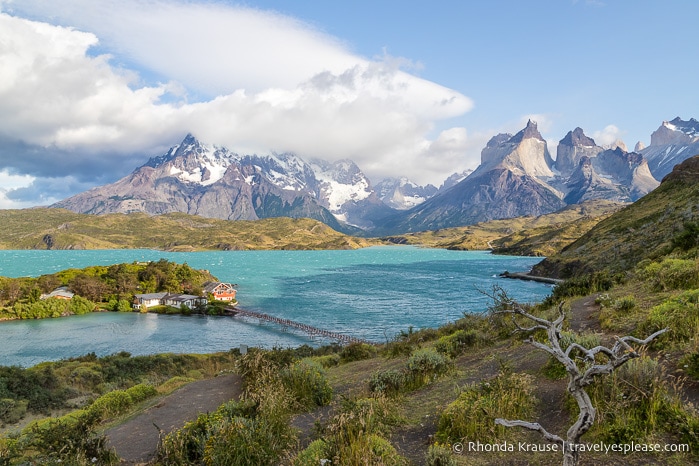
Visiting Patagonia had long been a dream of mine, and as a lover of nature and remote locations, it did not disappoint. During our two week Patagonia trip we went hiking in some incredibly scenic national parks, got up close to ancient glaciers, picnicked on the rocky shores of alpine lakes, went kayaking at sunset, and even crossed paths with a puma.
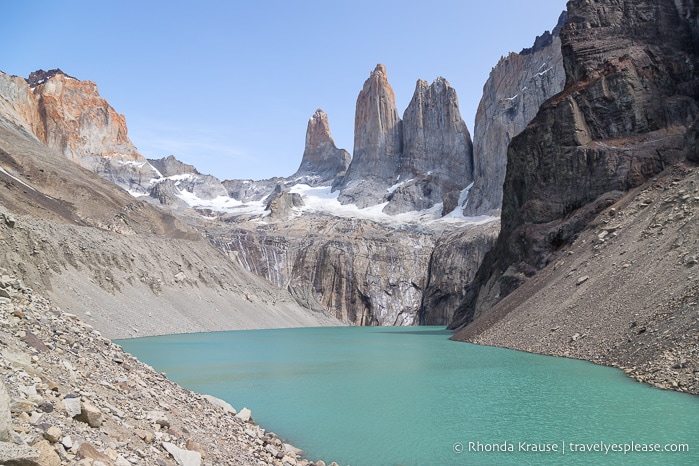
After 2 weeks in Patagonia, we can confidently say that it’s a paradise for outdoor adventurers. As you’ll see from our Patagonia itinerary below, we had no trouble finding exciting things to do and beautiful places to visit!
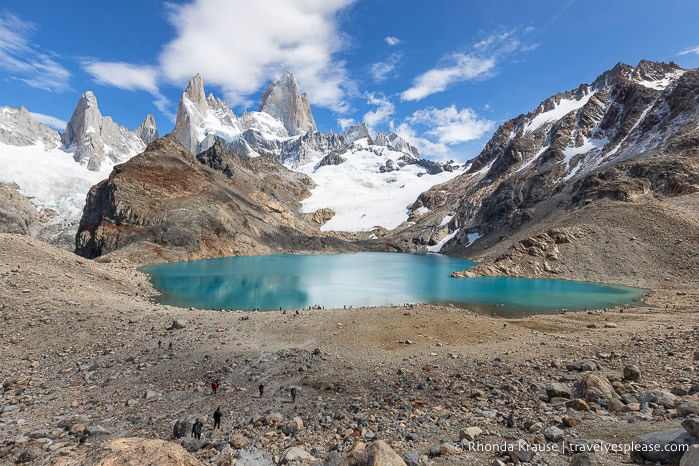
Two Weeks in Patagonia- Our Patagonia Itinerary for Argentina and Chile
As active travellers and nature lovers, we wanted our trip to Patagonia to focus primarily on hiking and visiting impressive natural wonders.
With that in mind, I went about creating a Patagonia itinerary that included road trips through the countryside, overnights in small mountain towns, visits to glaciers, boat rides on sparkling blue lakes, and plenty of time on the trails.
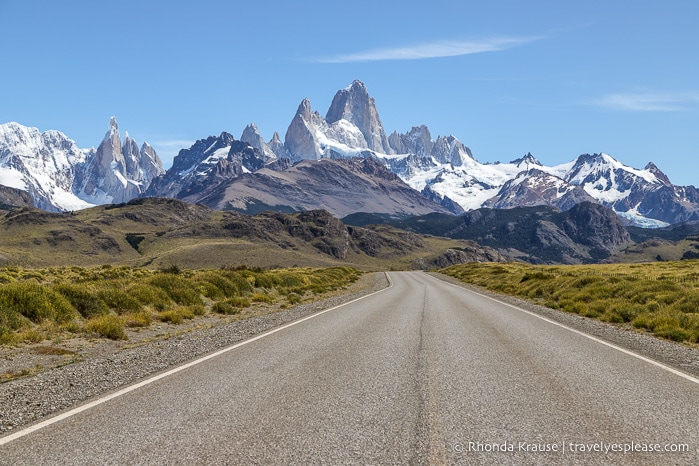
Since Patagonia encompasses such a huge area of land across two countries, far too much to explore in one trip, we decided to only visit southern Patagonia, where several of the region’s iconic landmarks and most famous attractions are.
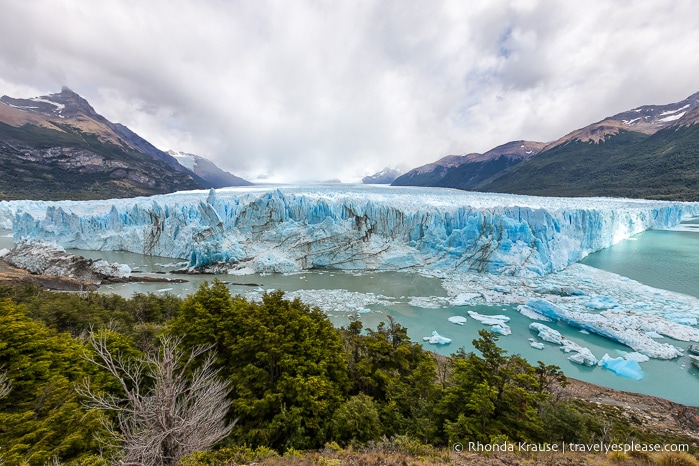
With almost 2 weeks in Patagonia, we had enough time to visit both the Chilean and Argentine sides, even making it to Argentina’s most southern city. Our Patagonia trip was divided up between three main areas- Tierra del Fuego, Torres del Paine National Park, and Los Glaciares National Park.
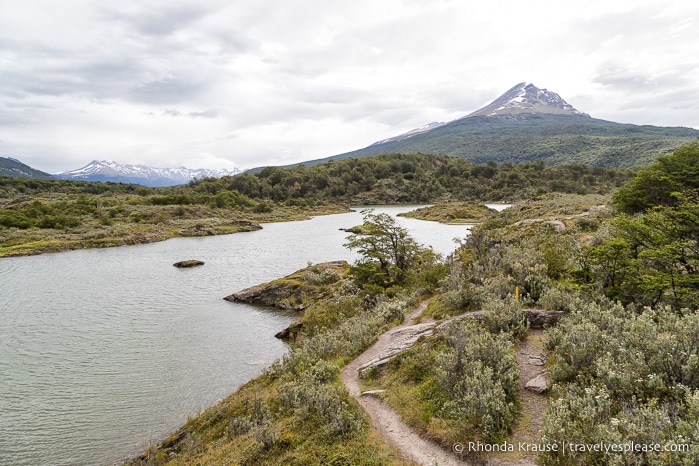
To help you with your Patagonia trip planning, here is our Patagonia itinerary packed full with outdoor adventures and some of the best places to visit in Patagonia!
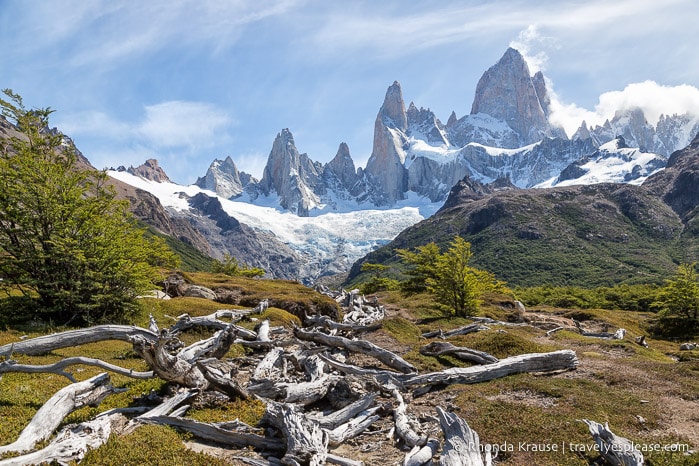
Map: Patagonia Trip
Here is a map of the places we visited on our Patagonia trip.
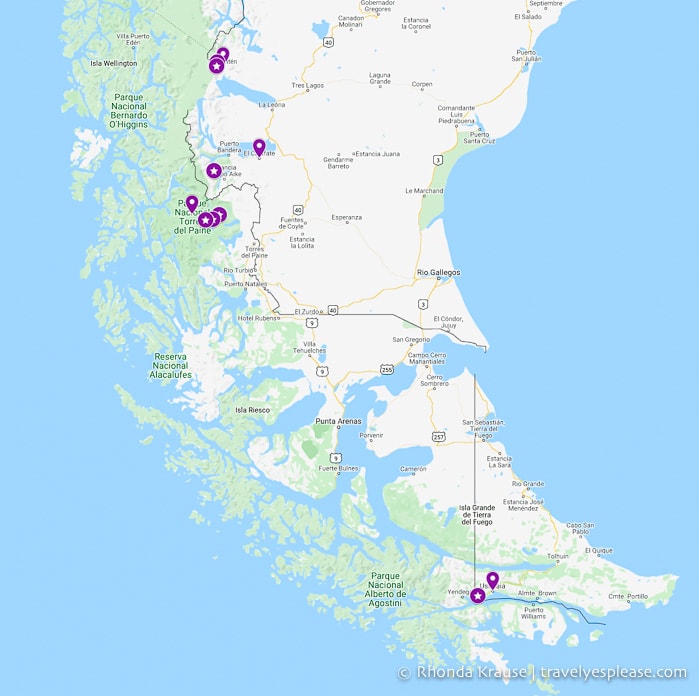
Day 1: Fly From Buenos Aires to Ushuaia
To start our trip to Patagonia we flew from Buenos Aires to Ushuaia, the southernmost destination on our Patagonia itinerary. Our flight arrived at 7:30 pm, so we didn’t do much exploring until the next day. We spent 3 nights in Ushuaia.
Approximate travel time: 3 hour 35 minute flight
Days 2 & 3: Ushuaia and Surrounding Area
We initially visited Ushuaia more out of necessity than desire, since it was the departure point for our cruise to Antarctica and South Georgia Island . Once we arrived, we confirmed that while the city itself doesn’t have much to offer other than a beautiful setting, it is a good base for exploring the surrounding nature.

Wedged between the Beagle Channel and Martial Mountains, Ushuaia doesn’t make you choose between coastal or mountain views. We got to enjoy both as we alternated between strolling along the waterfront and browsing outdoor gear shops on the central grid of streets.
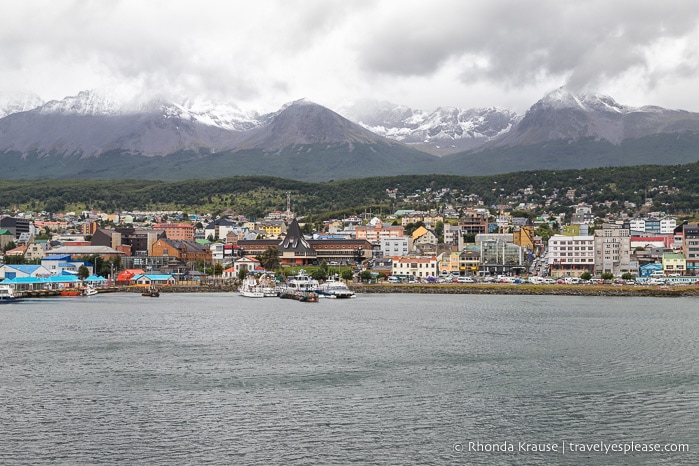
Ushuaia’s claim to fame is being the world’s most southern city. All around Ushuaia you’ll see signs and souvenirs proudly displaying its nickname “The End of the World”. This assertion and slogan is somewhat misleading because Puerto Williams in Chile is technically further south, but its population is way smaller than Ushuaia’s, so I guess it depends on what your definition of city is (we would consider Puerto Williams a town because it has less than 3,000 people).
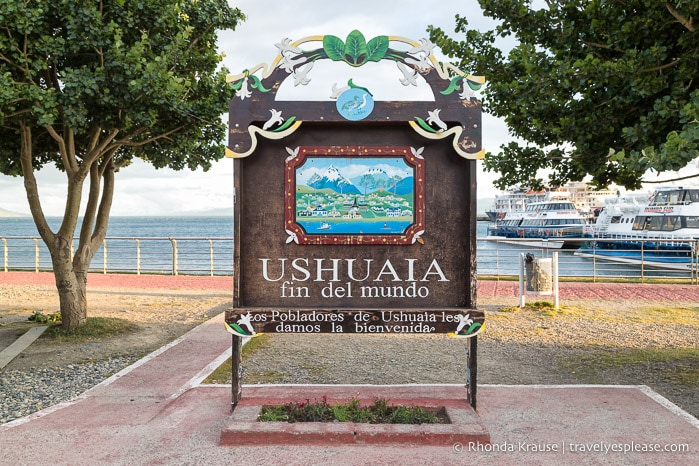
Since it didn’t take us long to get a feel for Ushuaia, we spent a day and a half going on excursions outside the city. The highlight was hiking in Tierra del Fuego National Park , but we also enjoyed a sunset kayak tour on Lake Escondido.
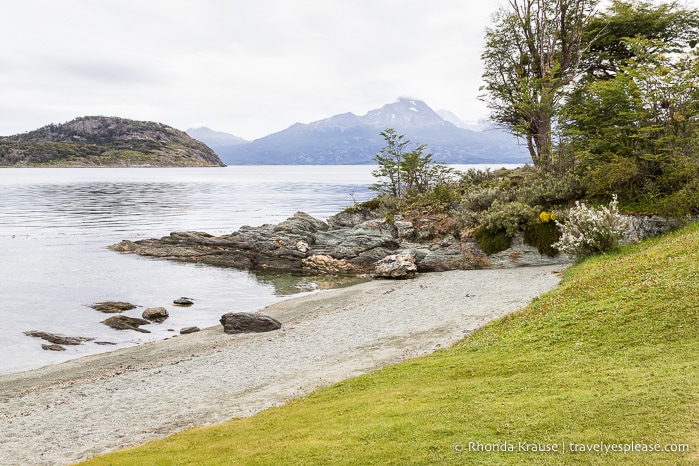
Tierra del Fuego National Park has ten marked hiking trails that showcase the park’s forests, mountains, rivers, lakes, and bays. We combined a few trails to create a route that took us almost the entire way across the park, experiencing a variety of scenery along the way. Our hike concluded at the famous sign marking the end of Route 3 and the Pan-American Highway.
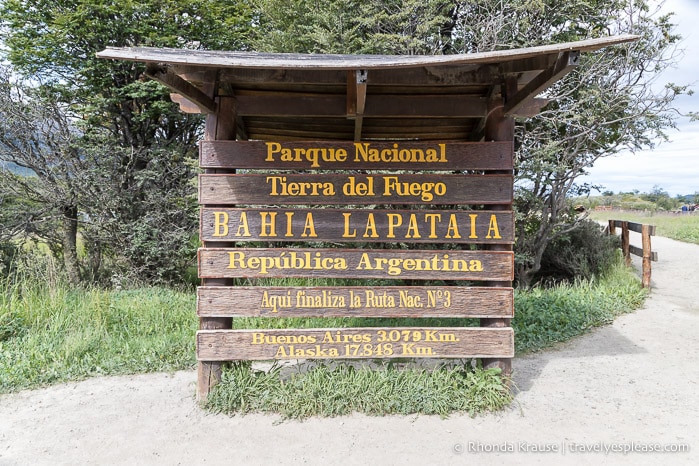
The next day we joined a tour that went kayaking on Lake Escondido. On the drive there we stopped at an observation deck at Paso Garibaldi to admire a view of the lake. Unfortunately, it was rainy and cold during our kayak trip, but the tour ended with a delicious dinner at a wooden shelter in the forest.
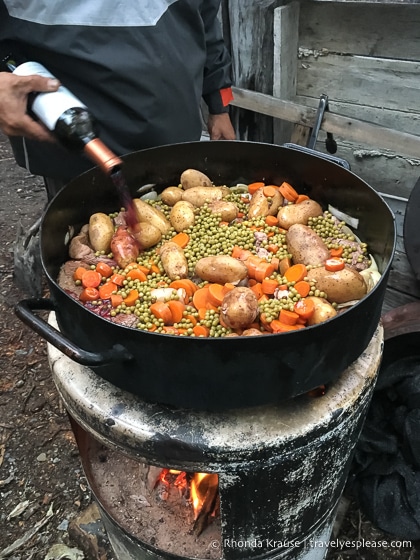
Some other things you can do in Ushuaia are go on a Beagle Channel cruise and visit the penguin colony on Martillo Island. We didn’t do this since we’d be sailing to Antarctica via the Beagle Channel and seeing thousands of penguins during our expedition.
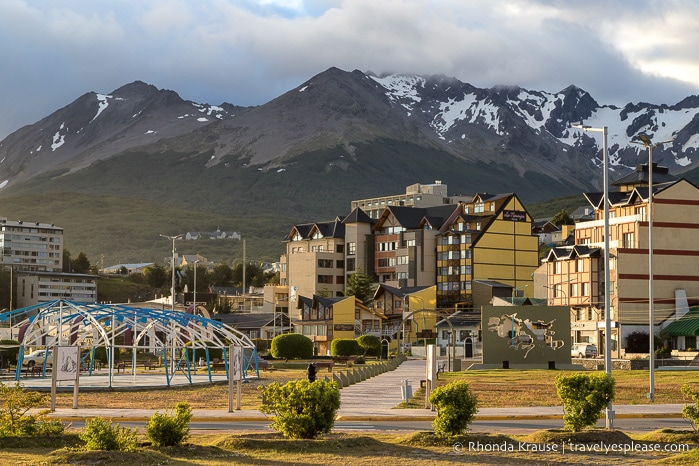
Day 4: Fly From Ushuaia to El Calafate
Since Ushuaia is so far away from the rest of the places to visit in Patagonia, we decided to fly to El Calafate then rent a car to use for the rest of our Patagonia trip. Once settled in, we explored this attractive city by foot, visiting some shops and restaurants on the main street. We spent 2 nights in El Calafate.
Approximate travel time: 1 hour 20 minute flight
Day 5: Perito Moreno Glacier
We visited Perito Moreno Glacier , in Los Glaciares National Park, as a side trip from El Calafate. We were so enamoured by the beauty of this famously huge glacier that we easily spent almost the entire day there.
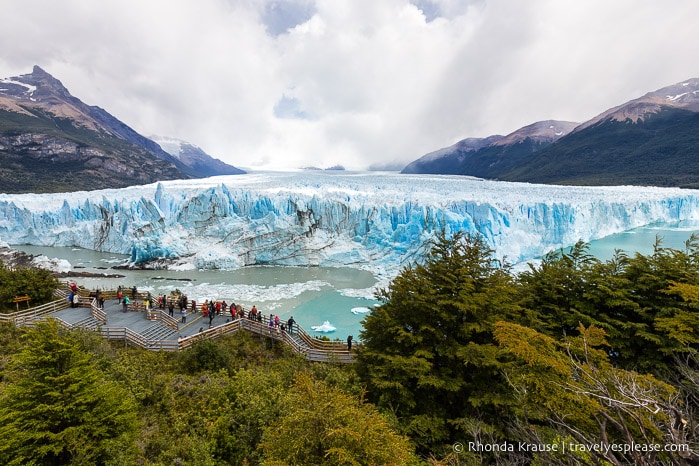
Perito Moreno Glacier is the third largest glacier in Argentina and the most accessible one in Los Glaciares National Park. This massive piece of ice can be admired from a network of paths and observation decks, from a boat, or while trekking on its surface during a guided tour.
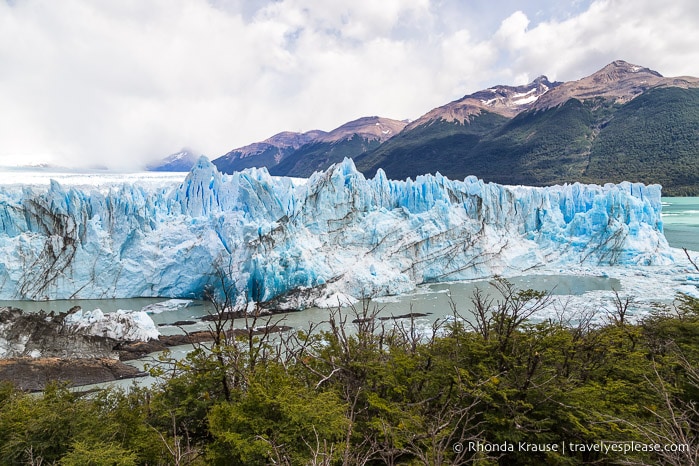
We opted to explore the paths and do the boat tour so we’d get close-up views of two different sides of the glacier. The glacier was especially active during our boat tour, calving several times to send chunks of ice splashing into the lake.
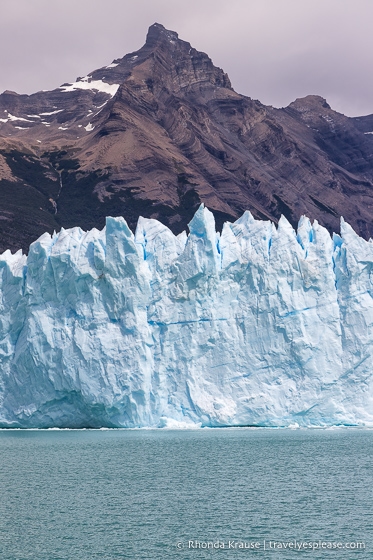
Even after all the time we spent at Perito Moreno Glacier, I still would go back for a second visit- it’s that impressive. Next time I would love to try the ice trekking experience and go kayaking in front of the glacier.
Day 6: Drive from El Calafate to Torres del Paine National Park (Chile)
The next destination on our Patagonia trip itinerary was Torres del Paine National Park in Chile. After checking in at our accommodations near the park gates at Rio Serrano, we took a sightseeing drive through the park. We spent 4 nights in Torres del Paine National Park.
Approximate travel time: 4 hour drive (allow extra for border crossing)
Days 7, 8, & 9: Hiking in Torres del Paine National Park
Our next three days in Torres del Paine National Park were spent hiking sections of the W Trek , the park’s most popular trekking route. The W Trek is typically done as a series of overnight hikes, but we conquered three of the top segments as self-guided day hikes.
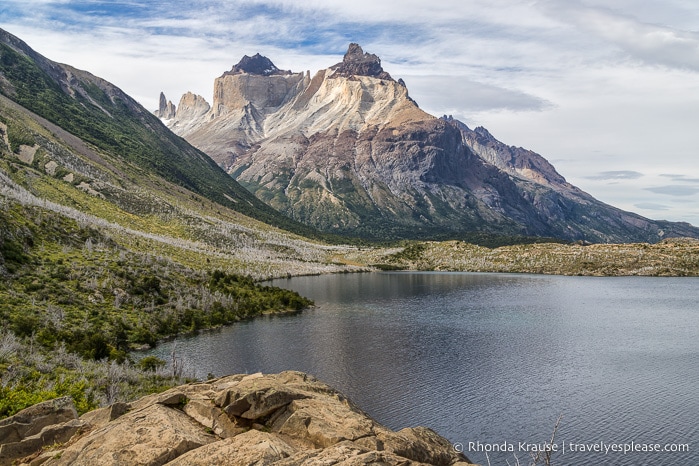
We did the park’s most notable hike first- the hike to Mirador las Torres. This hike took us to the gorgeous turquoise lake at the base of Torres del Paine, the rocky towers from which the park takes its name. This hike was challenging due to a significant amount of elevation gain, its rocky terrain, and some strong winds. Still, its difficulties are worth overcoming for the view that awaits at the end of the trail.
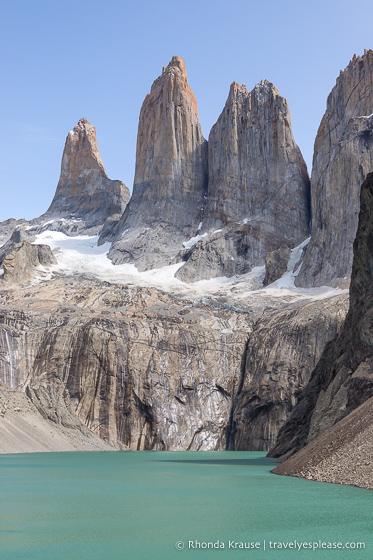
The second hike we did was the French Valley hike . Although the highlight is arriving at a viewpoint across from the French Glacier, the entire trail is a thing of beauty with vibrant lakes, rocky mountains, and picturesque grasslands. This was my favourite trail we hiked in the park.
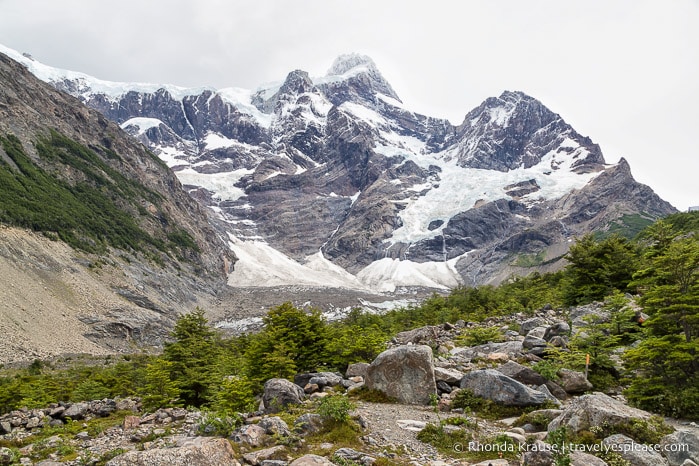
The last hike we did was the Grey Glacier hike . On this trail we visited two viewpoints that look out towards Grey Glacier and even got to see many small icebergs floating in Lago Grey.
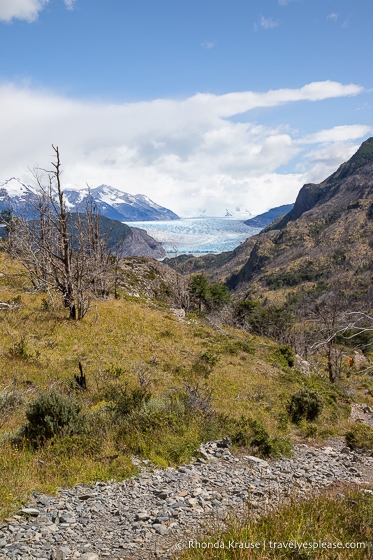
Day 10: Drive From Torres del Paine National Park to El Chalten
After hiking 62 km in three days, we welcomed the long drive to El Chalten, Argentina, the final destination on our Patagonia itinerary. Once we arrived, we stopped in at the visitor centre then wandered around this small mountain town. We spent 3 nights in El Chalten (but loved it so much we wished we stayed longer!)
Approximate travel time: 6.5 hour drive
Days 11 & 12: Hiking in El Chalten
Our time in El Chalten was spent hiking some of the nearby trails.
On the first day we hiked to Laguna Torre, where we were hoping to see a nice view of Cerro Torre, one of El Chalten’s most distinctive peaks. Unfortunately, it was very cloudy and misty from the rain, so all we could see were some small icebergs that had broken off from the glacier at the end of the lake. The trail was enjoyable though and I’d like to go back and hike it in better weather.
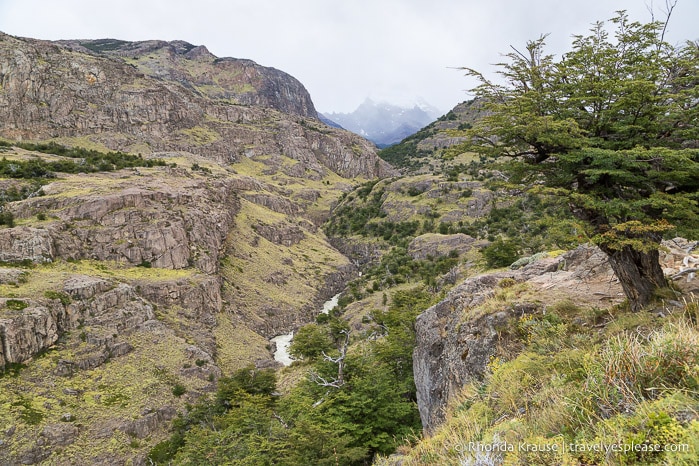
The next day conditions were perfect for our hike to Mt. Fitz Roy . This was a very long day hike, but so gratifying thanks to a parade of stunning scenery. We overlooked valleys, walked along lakeshores, passed through pretty meadows and shady forests, and gazed at glacier-covered mountains. Of course, the best part was seeing Mt. Fitz Roy looming large over the turquoise Laguna de los Tres. What an unforgettable view!
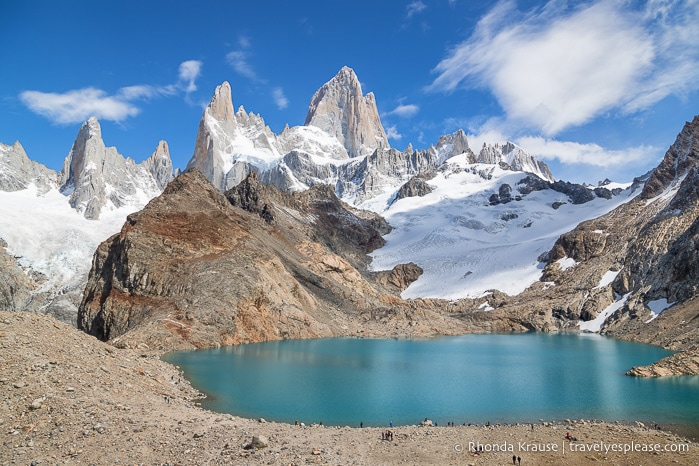
El Chalten is such a pleasant little town, and a great basecamp for both adventure and relaxation, that we couldn’t think of a better place to end our trip to Patagonia. We were so sad to leave!
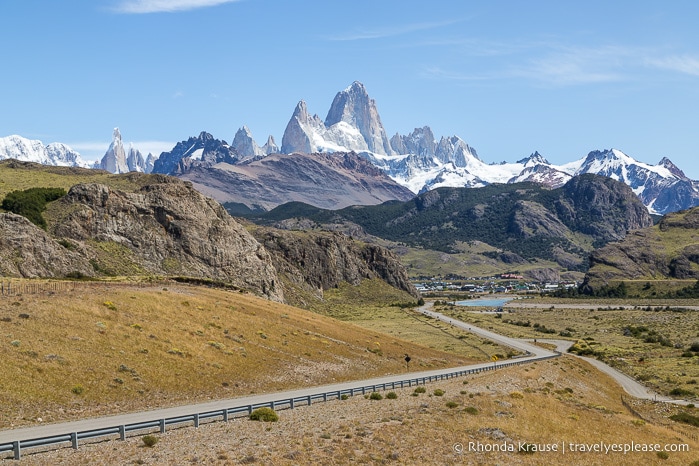
Day 13: Drive from El Chalten to El Calafate, Fly to Buenos Aires
As we said goodbye to Patagonia, we enjoyed a scenic drive back to El Calafate to return the rental car and catch our return flight to Buenos Aires. There isn’t much inside the El Calafate airport, so we wished we had a nice meal in town before our flight.
Approximate travel time: 3 hour 20 minute drive, 2 hour 55 minute flight
Final Thoughts About Our Two Week Trip to Patagonia
We had so much fun during our 2 weeks in Patagonia! From the exquisite landscapes and memorable hikes to the small towns and isolated locations, there was nothing we didn’t like.
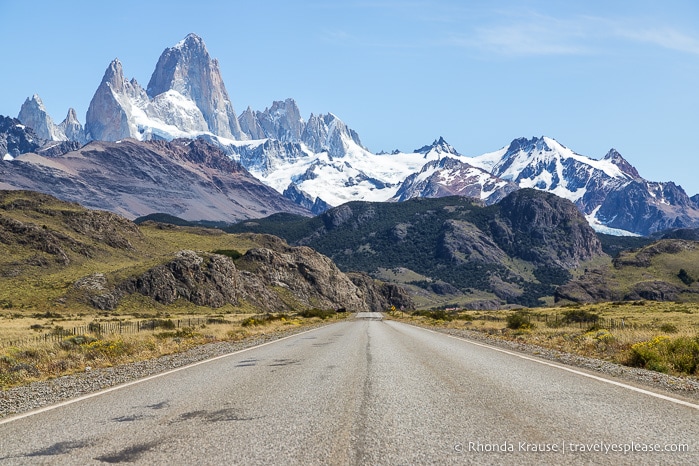
The driving wasn’t stressful for us, since Argentina has good roads, but we did worry a little about getting a flat tire on the gravel roads in and around Torres del Paine National Park (and running out of fuel since there are no gas stations close to the park). Thankfully everything went smoothly!
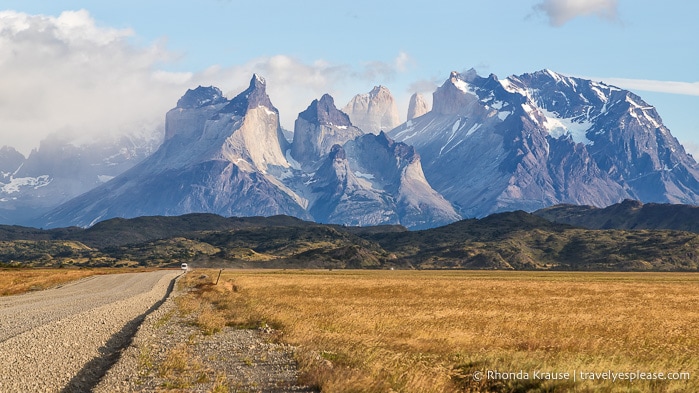
We felt like our Patagonia itinerary was loaded with must-see places and bucket list worthy hikes. There was just one destination that in hindsight seems mediocre compared to the rest- Ushuaia.
Even though Ushuaia didn’t “wow” us as much as the other places did, we still enjoyed our time there and like being able to say we visited the world’s most southern city. If you can’t make it all the way down to Antarctica, then Ushuaia provides a good opportunity to see penguins and a subantarctic landscape.
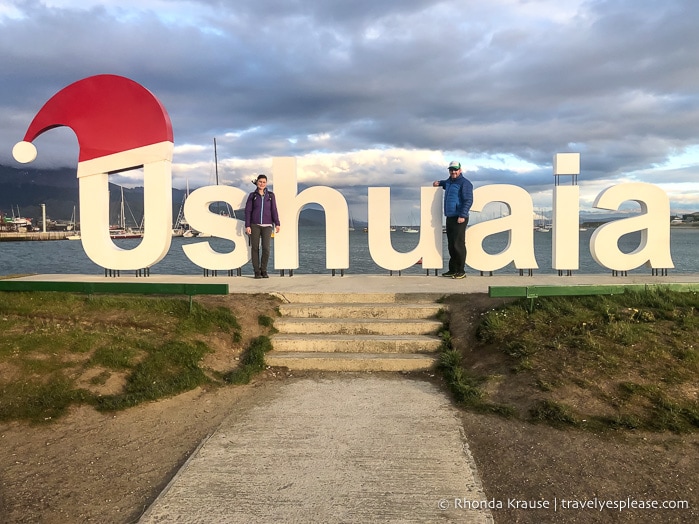
Reflecting on our Patagonia trip itinerary, there’s only one thing I’d change- add another day in El Chalten to see the Viedma Glacier in Los Glaciares National Park, or do another hike (but I don’t think my feet could have handled that!)
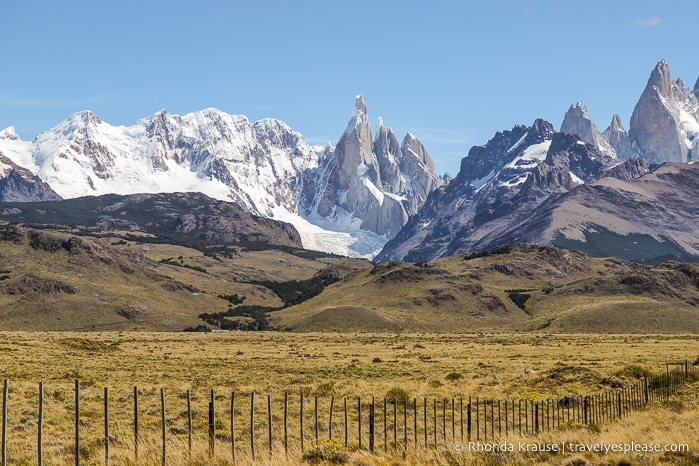
If you love nature, hiking, and experiencing small towns, then we definitely recommend travelling to Patagonia!
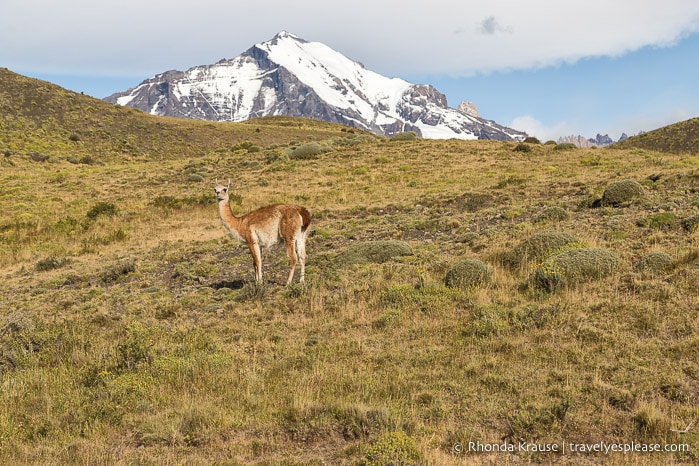
Tips for Visiting Patagonia
Best Time to Visit Patagonia: The best time to visit Patagonia is in summer (December to February) because of the warmer temperatures and long daylight hours.
Getting There: For international travellers to Argentina, you’ll probably arrive in Buenos Aires at Ezeiza International Airport (officially called Aeropuerto Internacional Ministro Pistarini). Most domestic flights are handled by Aeroparque Internacional Jorge Newbery (near downtown Buenos Aires), so you’ll likely have to change airports to get to Patagonia.
- We recommend scheduling your flight to Patagonia for the day after (or a few days after) you arrive in Buenos Aires in case there are travel delays or schedule changes. All our flights in Argentina had departure time changes in advance of our trip, but nothing more than 25 minutes.
- From Buenos Aires, you can fly direct to Ushuaia and El Calafate. You can also get flights to other towns in Patagonia, but for our itinerary this wasn’t necessary.
Getting Around: Patagonia is a huge area so flights are good for covering long distances in a short amount of time. For our itinerary, we used flights to get from Buenos Aires to Ushuaia, Ushuaia to El Calafate, and El Calafate back to Buenos Aires.
- There are bus routes connecting towns and popular tourist destinations in Patagonia, but some places are still only accessible via private vehicle. We didn’t use any buses other than the shuttle from Ushuaia to Tierra del Fuego National Park, but my guidebook said buses in Argentina are fast, frequent (less so in Patagonia), comfortable, and reasonably priced.
- Renting a car is a great option for independent travellers who don’t want to rely on public transportation schedules. A car was necessary in Torres del Paine National Park, since there is no park shuttle and buses from the nearest town make limited stops.
Renting a Car in Patagonia: The most convenient place to rent a car was at the El Calafate airport. There were several companies to choose from.
- We recommend renting from a company that offers unlimited kilometres, since there are significant distances between towns in Patagonia. It will be more expensive, but worth it to not worry about unexpected costs.
- Confirm with the rental agency that they allow the car to be driven into Chile. If they do, this permission will come with an extra cost ($100 US in our experience) and some additional paperwork (we had to email copies of our driver’s licence and passport). You will be given a border crossing permit that you have to get stamped when entering into Chile and back into Argentina. Don’t forget to ask the border agent to stamp this paper for you, as it has to be returned with the rental car.
- An International Driving Permit wasn’t required.
- Gas stations aren’t common outside of towns, so fill up whenever you get a chance. On a few occasions we encountered gas stations that were either sold out of fuel or had very long lines at the pumps (especially in El Calafate).
Driving from El Calafate to Torres del Paine National Park: Google Maps may suggest a route that takes Highway 40, but this “shortcut” turns into a bumpy dirt road that almost nobody drives (we took part of it by accident on the return trip and didn’t see a soul). We suggest taking Highway 40 then Highway 5 to Esperanza because it’s paved. From Esperanza, take Highway 7 west until it rejoins 40.
- Make sure you fill up with gas in Esperanza (and save enough fuel to get back here), because there are no gas stations beyond this point. If you need fuel in Torres del Paine National Park, your accommodation may be able to sell you some (or direct you to a place that will), but you’ll pay a premium. I wouldn’t assume you’ll be able to find gas in the park.
- The border crossing was a different experience for us because at the gate you had to exit your car and go into a building to show your documents. Then you had to wait for someone to come out and open the gate so you could drive away. If you have a rental car, be prepared to show the paperwork and border crossing permit from the rental agency.
Information was correct at the time of publishing, but can change without notice. Please confirm directly with service providers.
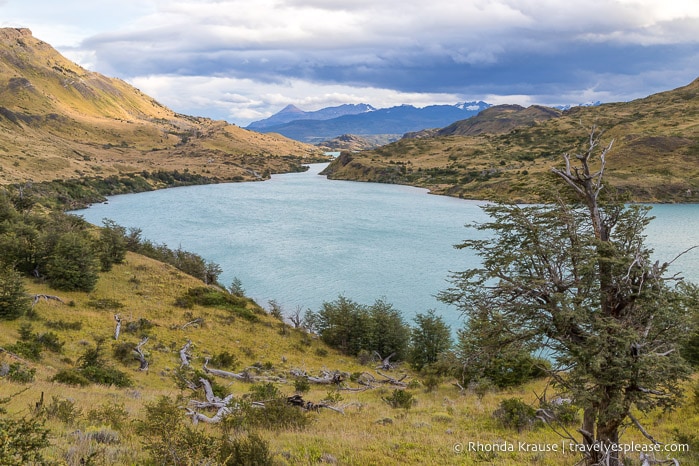
Accommodations in Patagonia
For your convenience, here is a list of hotels for the stops on this Patagonia trip itinerary. Please consider booking your accommodations through the included link. It costs nothing extra and helps support this website. Thank you!
- El Calafate
- Torres del Paine National Park
Tours and Activities in Patagonia
Here is a trusted site that has a large selection of tours and tickets for activities in Patagonia . Below are ones for the places mentioned in this post:
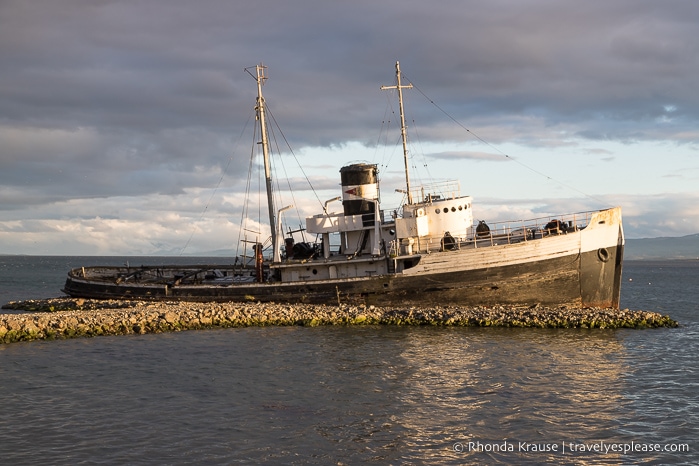
More Argentina and Chile Destinations and Travel Guides
- Buenos Aires Bike Tour- Exploring Buenos Aires by Bike
- 4 Days in Easter Island- A Self-Guided Tour of Rapa Nui
- Rano Raraku- Carving Site of Easter Island’s Moai
- Walking Tour of Santiago- Photo Series
Follow Us On Social Media
Facebook | Instagram | X | Pinterest
Join the Facebook Group
Argentine Patagonia Travel Guide
Courtesy of George Pachantouris | Getty Images

Best Times To Visit Argentine Patagonia
The best times to visit Argentine Patagonia are October through November (springtime in the southern hemisphere) and December through February (summertime). During these months, the weather is mild, and spectators can view natural attractions in their full splendor. You should make your spring and summer travel arrangements far in advance since visitors flock to Argentina for the optimal hiking conditions. Pack layers to combat Patagonia's heavy winds (especially if you're planning a visit to Southern Patagonia ). January and February draw the largest crowds, but October, March and April are also good times for sightseeing, boasting sunshine and temperatures in the 40s, 50s and 60s.
Weather in Argentine Patagonia
Data sourced from the National Climatic Data Center
Find Flight and Hotel Deals
Navigate forward to interact with the calendar and select a date. Press the question mark key to get the keyboard shortcuts for changing dates.
Navigate backward to interact with the calendar and select a date. Press the question mark key to get the keyboard shortcuts for changing dates.
Popular Times to Visit Argentine Patagonia
Tourism volume is estimated based on in-market destination search query interest from Google and on travel.usnews.com in 2015-2016. Hotel prices are sourced from a sample of U.S. News Best Hotels rates through 2015-2016.
Explore More of Argentine Patagonia

Things To Do

Best Hotels

You might also like

# 2 in Best Places to Visit in Spring

# 7 in Best Places to Visit in July 2024

Chilean Patagonia
# 2 in Best Places to Visit in Central and South America in 2023
If you make a purchase from our site, we may earn a commission. This does not affect the quality or independence of our editorial content.
Recommended
The 28 Best Water Parks in the U.S. for 2024
Holly Johnson|Timothy J. Forster May 8, 2024

The 18 Best Napa Valley Wineries to Visit in 2024
Lyn Mettler|Sharael Kolberg April 23, 2024

The 25 Best Beaches on the East Coast for 2024
Timothy J. Forster|Sharael Kolberg April 19, 2024

The 50 Best Hotels in the USA 2024
Christina Maggitas February 6, 2024

The 32 Most Famous Landmarks in the World
Gwen Pratesi|Timothy J. Forster February 1, 2024

9 Top All-Inclusive Resorts in Florida for 2024
Gwen Pratesi|Amanda Norcross January 5, 2024

24 Top All-Inclusive Resorts in the U.S. for 2024
Erin Evans January 4, 2024

26 Top Adults-Only All-Inclusive Resorts for 2024
Zach Watson December 28, 2023

Solo Vacations: The 36 Best Places to Travel Alone in 2024
Lyn Mettler|Erin Vasta December 22, 2023

26 Cheap Beach Vacations for Travelers on a Budget
Kyle McCarthy|Sharael Kolberg December 4, 2023

- USA/Canada 1-888-232-3813
- Walking & Hiking
- Wildlife and Nature
- Multiactivity
- Photo Safari
- Excepcional Journey
- Water Adventures
- Food & Wine
- City Escapes
- Winter Adventures
- EcoCamp Patagonia
- Argentine Patagonia
- Chilean Patagonia
- Atacama Desert
- Santiago and Central Valley
- Easter Island
- Lake District
- Multidestination
- Northwest Argentina
- Uyuni Salt Flats, Bolivia
- For Families
- For Couples
- For Friends
- For Solo Travelers
- Central Valley
- Wildlife & Nature
- News & Awards
- Sustainability
- Outdoor Sports
- Yoga & Wellness

5 Things I Wish I Knew Before Visiting Argentine Patagonia
Posts by tag.
- Patagonia (78)
- Inspire (50)
- Wildlife & Nature (29)
- News & Awards (25)
- Outdoor Sports (21)
- Food & Wine (20)
- Central Valley (16)
- Atacama Desert (14)
- Culture (14)
- Sustainability (8)
- Lake District (5)
- Yoga & Wellness (5)
- Easter Island (3)
- Bolivia (1)
Guest Post Written By: Marina Yoveva
Marina is originally from Bulgaria, but she considers herself a citizen of the world. Having traveled to over 20 countries and counting, she loves writing about her adventures, experiences and advice on Exploreist .
Argentine Patagonia is pristine and wild—the definition of an adventurer’s dream. Located at the southernmost tip of South America, this region is defined by its dramatic landscapes, incredible wildlife and unique pockets of culture.
I’ve been to Argentine Patagonia a number of times now and learn something new with each visit. From activities to accommodation, this guide will help ease your journey to the wonderful and remote corners of Argentine Patagonia. Read on to discover what I wish I knew before visiting Argentine Patagonia.
1. The Best Way to Get to Argentine Patagonia
No matter where you are flying from, you will first need to stop in Buenos Aires, Argentina. From there, you can travel to Patagonia.
Bariloche, a city roughly 994 mi (1,600 km) southwest of Buenos Aires, is the entry point to the Argentine Patagonia. Two-hour flights from Buenos Aires to Bariloche (BRC) are about $70 (USD) with Fly Bondi or Norwegian Air. It is also possible to fly to El Calafate (FTE)—a three-hour flight from Buenos Aires and to Ushuaia (USH), which is a three and a half hour flight.
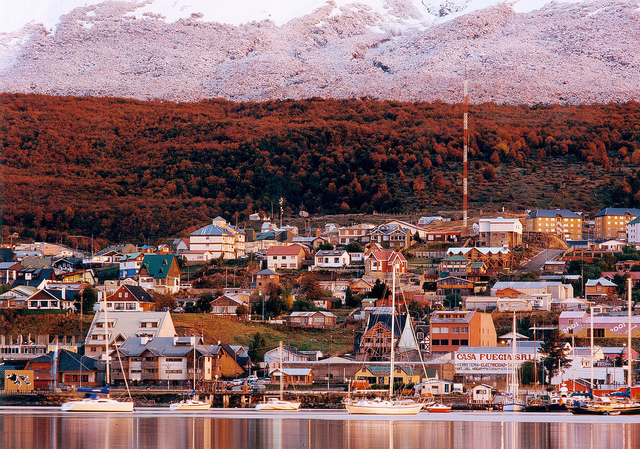
It is also possible to go through Chile and then onwards to Argentine Patagonia. Chile has Sky Airlines, a budget airline, which flies into Punta Arenas Airport (PUQ). From there, you can cross to El Calafate, Argentina by bus.
2. Must-See Attractions in Argentine Patagonia
Argentine Patagonia is comprised of three main districts: The Lake District, Atlantic, and Southern Patagonia. Each is unique in its own way, with natural wonders as a common factor.
The Argentine Lake District is an absolute must, with stunning views in every direction. The Lake District is best accessed from Bariloche and one of the top highlights is Nahuel Huapi Lake—one of the largest lakes in the region. Additionally, if you’re here to ski, check out the slopes at Cerro Catedral’s mountain resort.
Also be sure to visit the Atlantic section of Argentine Patagonia, home to unique natural havens such as the Punta Tombo Wildlife Sanctuary. Watch the Magellanic penguins at Punta Tombo, whose population in Patagonia actually outnumbers humans! This area of Argentine Patagonia has local Welsh culture, which can be found in small towns such as Trelew. The Welsh immigrated to Patagonia in the 1860s in search of a new life and a way to preserve their cultural heritage. Stop in for a spot of tea or come for Eisteddfod, a celebration of Welsh arts and literature. Trelew is also home to the Egidio Feruglio Museum of Paleontology, where you can learn more about the region’s impressive history of dinosaurs.
Southern Patagonia is another impressive area to visit when touring Argentine Patagonia. Sitting below the Lake District, Southern Patagonia offers unforgettable sights such as Perito Moreno Glacier (you’ve got to see at least one glacier while in Patagonia). El Calafate is where you can dig into that rugged nature and get off the grid. Additionally, in the far south of Argentine Patagonia, you’ll find Puerto San Julian, where Ferdinand Magellan touched down in 1520.
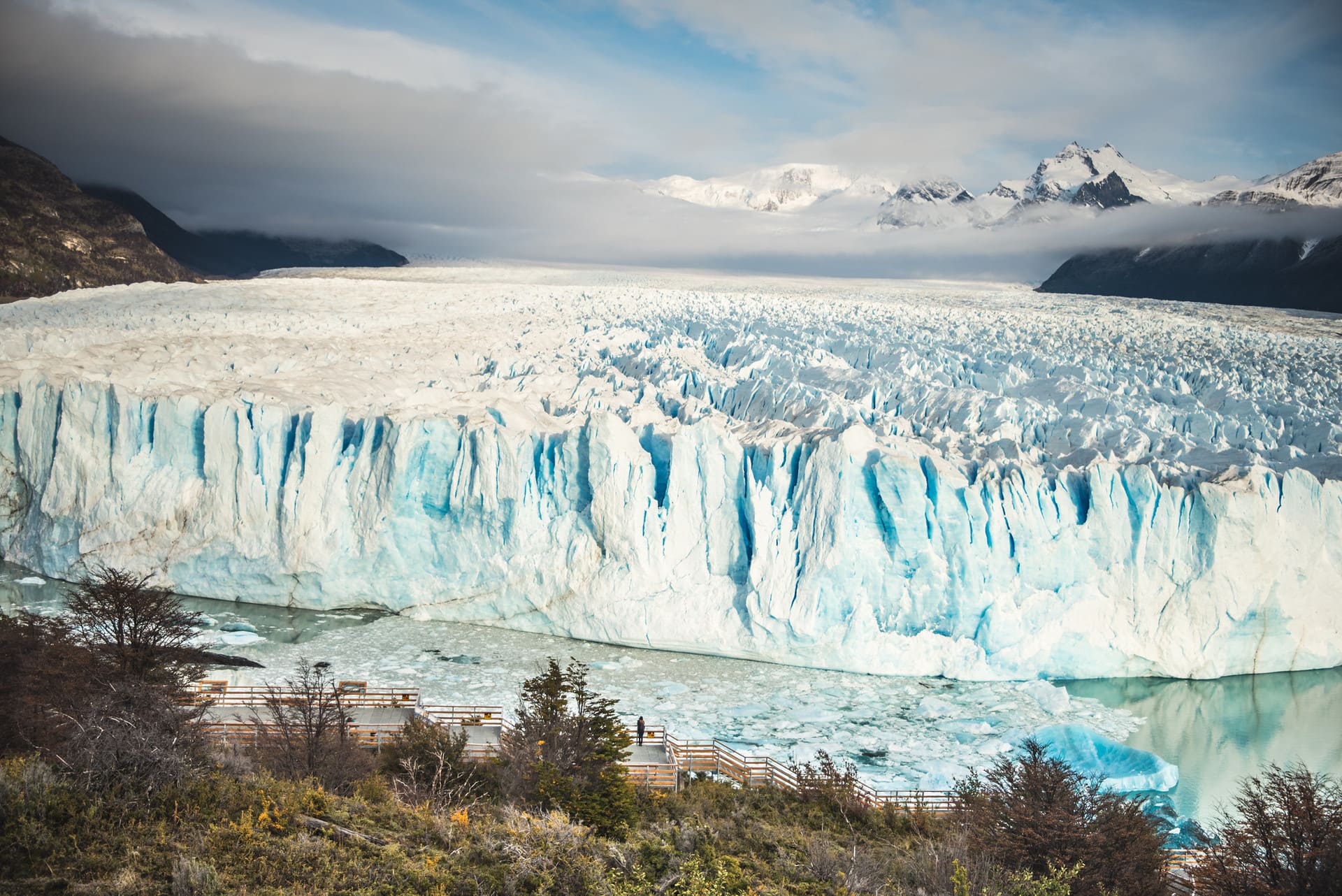
3. Where to Stay
Estancia Monte Dinero is a 100-year-old working sheep farm and such a cool experience to have while visiting Argentine Patagonia. The food at Monte Dinero is noteworthy and rooms are quaint with fireplaces. Now in the fifth generation, Estancia Monte Dinero is a family-owned operation from descendants of Scotch immigrants.
Rio Hermosa is a bit more upscale and right on the shores of the beautiful Nahuel Huapi Lake. Surrounded by woods, this hotel is great for those who love that cabin feel. Enjoy the gardens in warmer months or cozy up to the fireplace when it’s chilly.
Hotel Tunqueley is perfect for those seeking a more affordable nightly rate, while still enjoying a relaxing stay. Just 0.6 mi from Lacar Lakeshore in San Martin de Los Andes, Hotel Tunqueley is a convenient and central location. Enjoy the amenities of home such as WiFi, breakfast included and free parking. Also, being just 12 mi from the Chapelco Ski Center, this is a great option for those coming to ski.
Another option is to look into a travel package. This is great if you are looking to enjoy the most of Argentine Patagonia and not worry about the logistics. Check out some unique multi-day trips here .
4. How to Pack
A general rule of thumb when heading to Patagonia is to dress in layers. Wicking materials help keep you warm in rain or shine. Long underwear is a great base to work from when really heading into the wild. Also, Patagonia has high winds, so a protective outer-layer jacket is really key. Warm socks and an extra pair of lighter socks can also save you from having cold or wet feet.
Here’s a great video to check out that covers all the bases for packing for Argentine Patagonia:
Look for proper clothing at hiking companies, such as Patagonia Inc. or The North Face. Additionally, it is wise to bring a small first aid kit along when on the trail. These vary in size and quality, however, bandages for blisters are probably the number-one item to make sure is in there.
5. Who Actually Lives in Patagonia
Patagonia has more wildlife and open land than actual people. Certainly, this is part of the charm for those visiting Argentine Patagonia. However, people really do live in Patagonia, and quite the hearty stock they are. The largest city in Argentine Patagonia—and all of Patagonia—in Neuquen, home to roughly 345,000 people. Patagonia as a whole has a total population of 2 million people, with the majority living in Argentina.
The Tehuelche indigenous group are the native people of the region, which like many native groups were overtaken and assimilated by European explorers. Argentina is famous for its gaucho, or cowboy culture, which extends into the southern part of Argentine Patagonia. The gauchos are marked by their thick ponchos made of wool, with necks that button up to protect the cowboys in Patagonia’s cold. As previously stated, there is also a population of Welsh in Patagonia namely along the ocean and speak a unique dialect called Patagonian Welsh.
.jpg?width=1920&name=Gauchos%20(8%20of%201).jpg)
Argentine Patagonia feels like the ends of the earth, and in a sense, it is. Without hesitation, I recommend heading to Argentine Patagonia, a wild land of one’s imagination. Whether you love to ski, want to see wildlife or just want to admire the breathtaking views, you will definitely not regret visiting this epic place.
For more information on visiting Argentine Patagonia,
Subscribe to our Newsletter
Related posts.
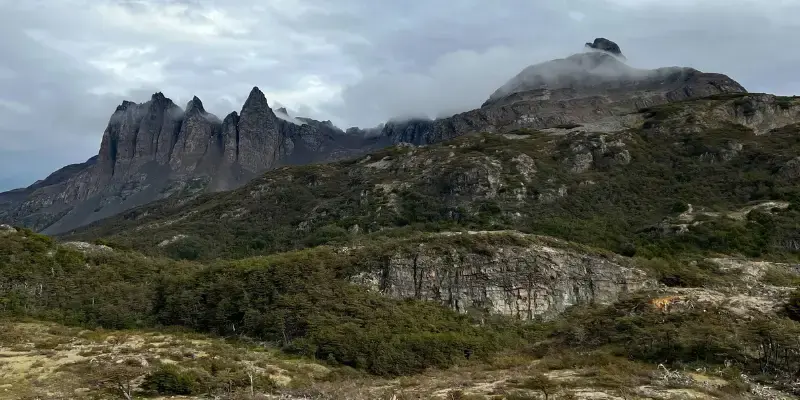
Team Cascada Insights: Javiera and Daniela explored Dientes de Navarino, the southernmost circuit in the world
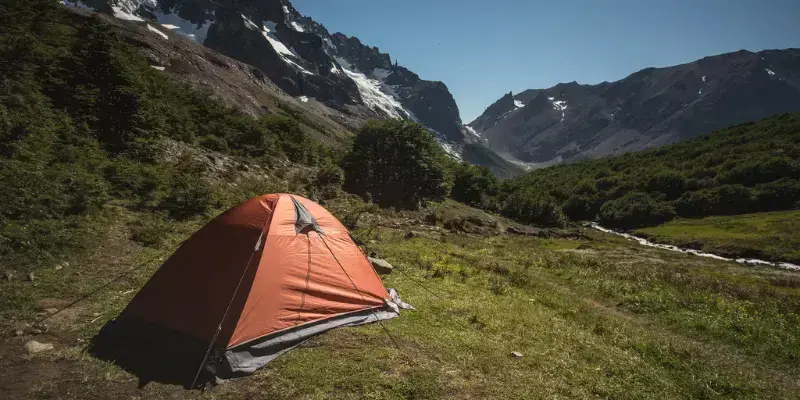
Chilean Patagonia: remote destinations to discover
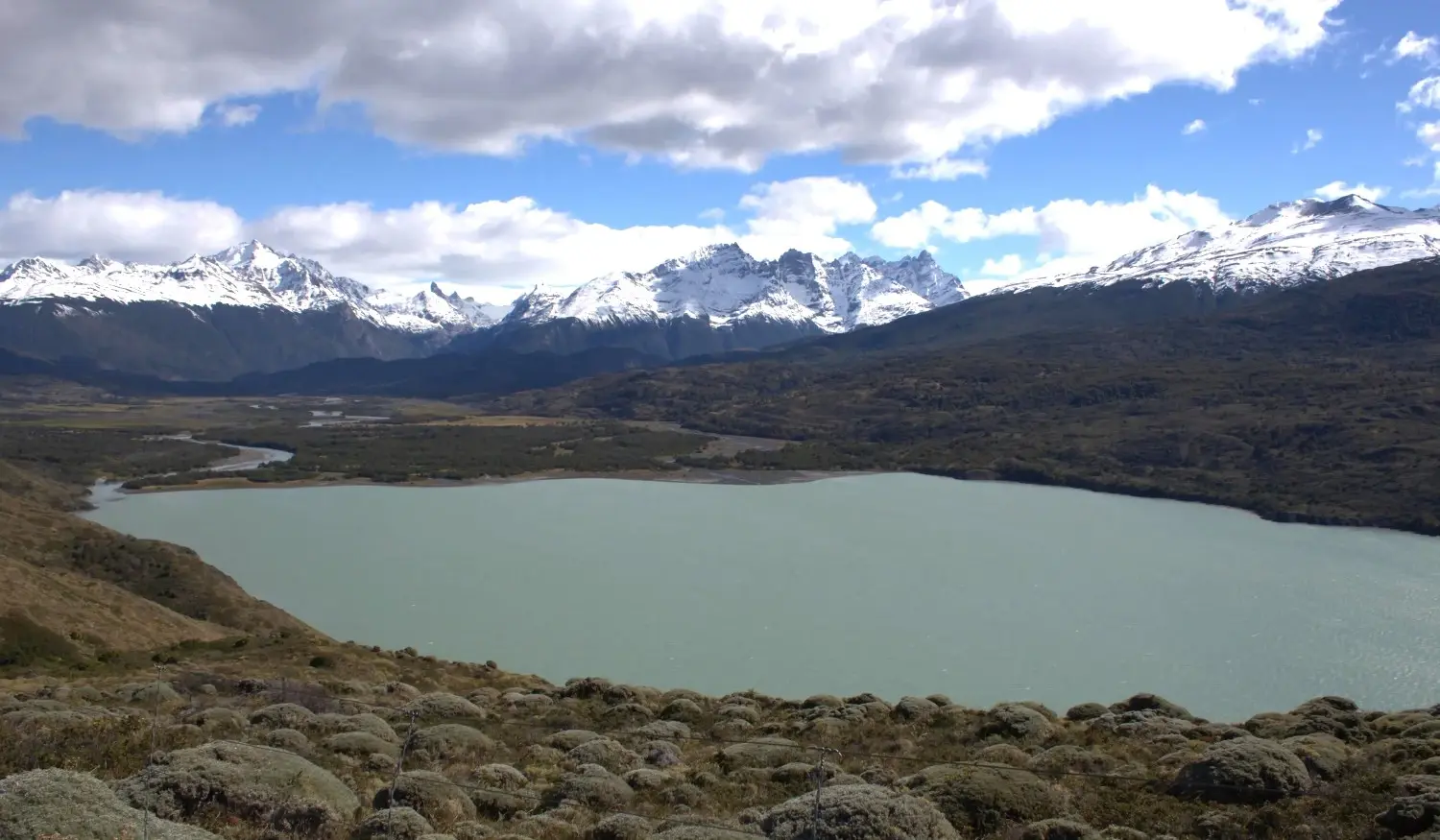
Team Cascada Insights: Matias hiked the O Circuit in Torres del Paine

The Chilean Way
Want to learn more about the beautiful country of Chile? Download our insider’s guide to learn all the best travel tips and tricks.

- TERMS & CONDITIONS
- PRIVACY POLICY
Destination
- Multi Destination
- Salta Argentina
Experiences
- Multi-activity
- Exceptional Journeys
SOCIAL NETWORKS

Updated October 4th, 2022
Dear Traveler,
We are very happy to announce that there are currently no travel restrictions in Chile. Together with the above mentioned, it is mandatory to comply with the following requirements:
- You only have to present the vaccination certificate issued in your country when boarding to Chile. Those who do not have their vaccinations must present a negative result in a PCR test dated less than 48 hours from departure to enter Chile. Those who are under 18 years of age do not have any requirements to enter Chile
- A negative PCR upon arrival is not compulsory any more but diagnostic tests will be carried out randomly at the entry point to Chile. Confirmed cases shall be isolated according to the general health regulations.
- Medical insurance covering any expenses caused by COVID-19 is not compulsory any more
- The use of a face mask is voluntary
In case you have any questions, we will be happy to help you!
The Team at Cascada Expediciones & EcoCamp Patagonia
- National News
- Politics & Policy
- Sustainability
- Social Impact
- Movies & TV
- Celebrities
- Going There
- Relationships
- Mental Health
- Next Question
- Live Events
- Original Content
- Home & Decor
- Gift Guides
All Aboard! See Katie and John’s Full Itinerary for a 10-Day Escape to Patagonia
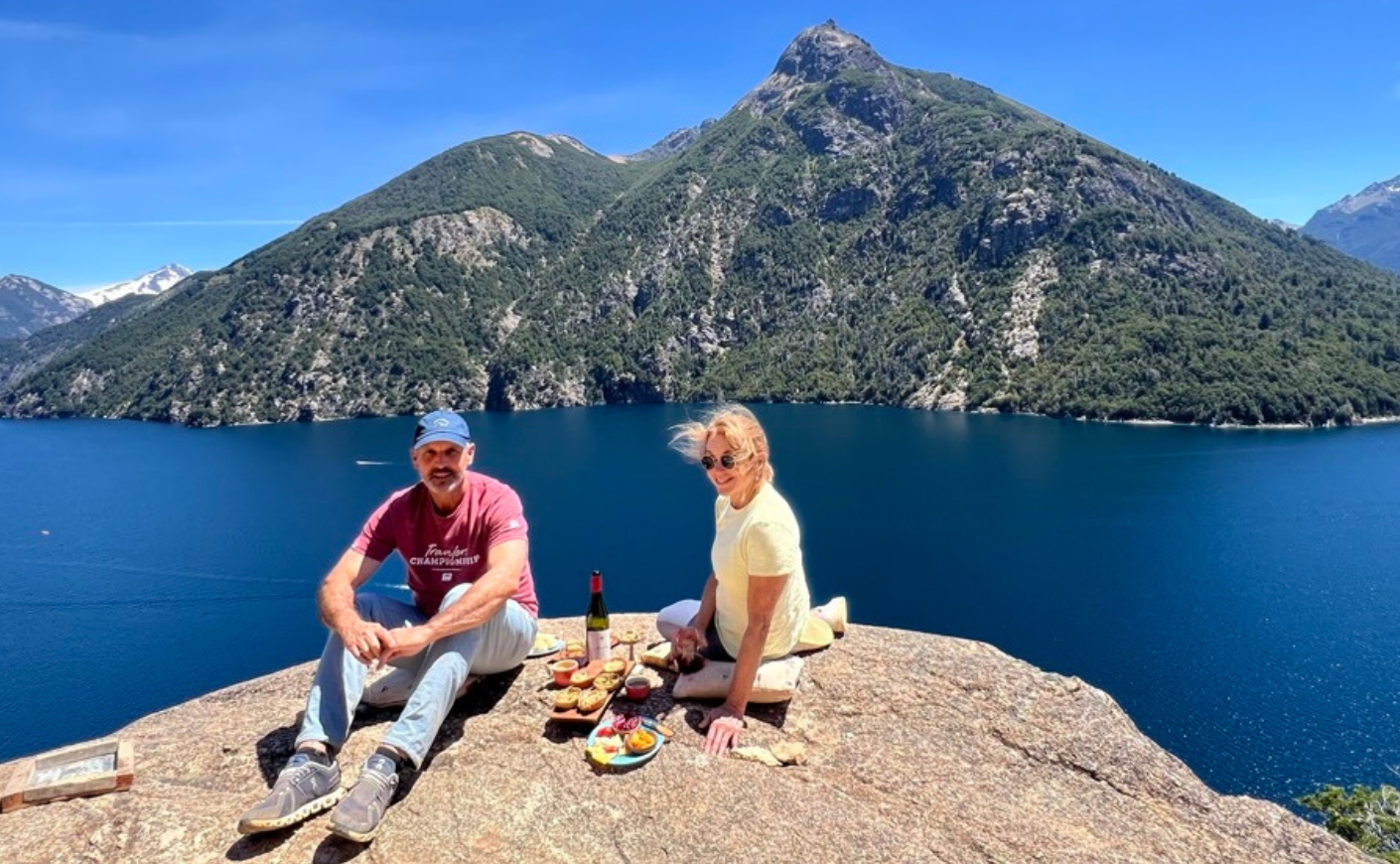
Recreate their hikes, cultural encounters, and meals.
Who’s ready for an unforgettable Argentinian vacation?
After Katie shared the highlights of the trip to Patagonia that she just took with Molner, we got lots of requests to see their entire itinerary. We highly encourage you to read Katie’s full essay if you’d like a first-person sense of the sights and sounds — and food! — from this beautiful part of the world, since no one can capture it quite like her. Speaking of food, Katie notes they tried to eat local instead of at tourist spots (which definitely turned up some amazing cuisine, as you’ll see), and she enjoyed trying local specialties like Mate, an herbal drink, and Rapuni , a famous Argentinian chocolate.
If you’ve already checked out Katie’s travelogue and want a quick and easy point of reference for where they stayed and what they saw, we’ve got you covered. Below, get a look at Katie and John’s day-by-day agenda in this jaw-dropping region. It’ll give you a great head start on planning your own trip! (And if you’d like to design your visit with the same folks who planned Katie’s vacation, check out Blue Parallel Luxury Travel — and, of course, Carla Thorson , her trusty travel agent.)
View this post on Instagram A post shared by Katie Couric (@katiecouric)
Katie Couric and John Molner’s 10-Day Patagonia Itinerary
Arrive in Buenos Aires and check into the hotel, the Palacio Duhau – Park Hyatt Buenos Aires .
1 p.m.: Lunch at Los Salones del Piano Nobile, one of the hotel’s stellar foodie offerings . This one specializes in modern international cuisine, and it offers lovely views for al fresco dining.
3 p.m.: Walking tour of Recoleta , which Vogue called the city’s “most elegant neighborhood.” Sights include the opulent Recoleta Cemetery , Plaza Francia , and the National Museum of Fine Arts .
8 p.m.: Dinner at Fervor , an elegant restaurant in the Recoleta neighborhood that serves delicious charcoal-grilled meat and fish specialties.
10 a.m.: Following breakfast, begin the day with a tour of the world-famous Teatro Colón , a historic opera house that’s considered one of the best in the world. Then continue the sightseeing in the Plaza de Mayo, including the Metropolitan Cathedral, the Cabildo, and Casa Rosada (or “the pink house”), the official workplace of Argentina’s president.
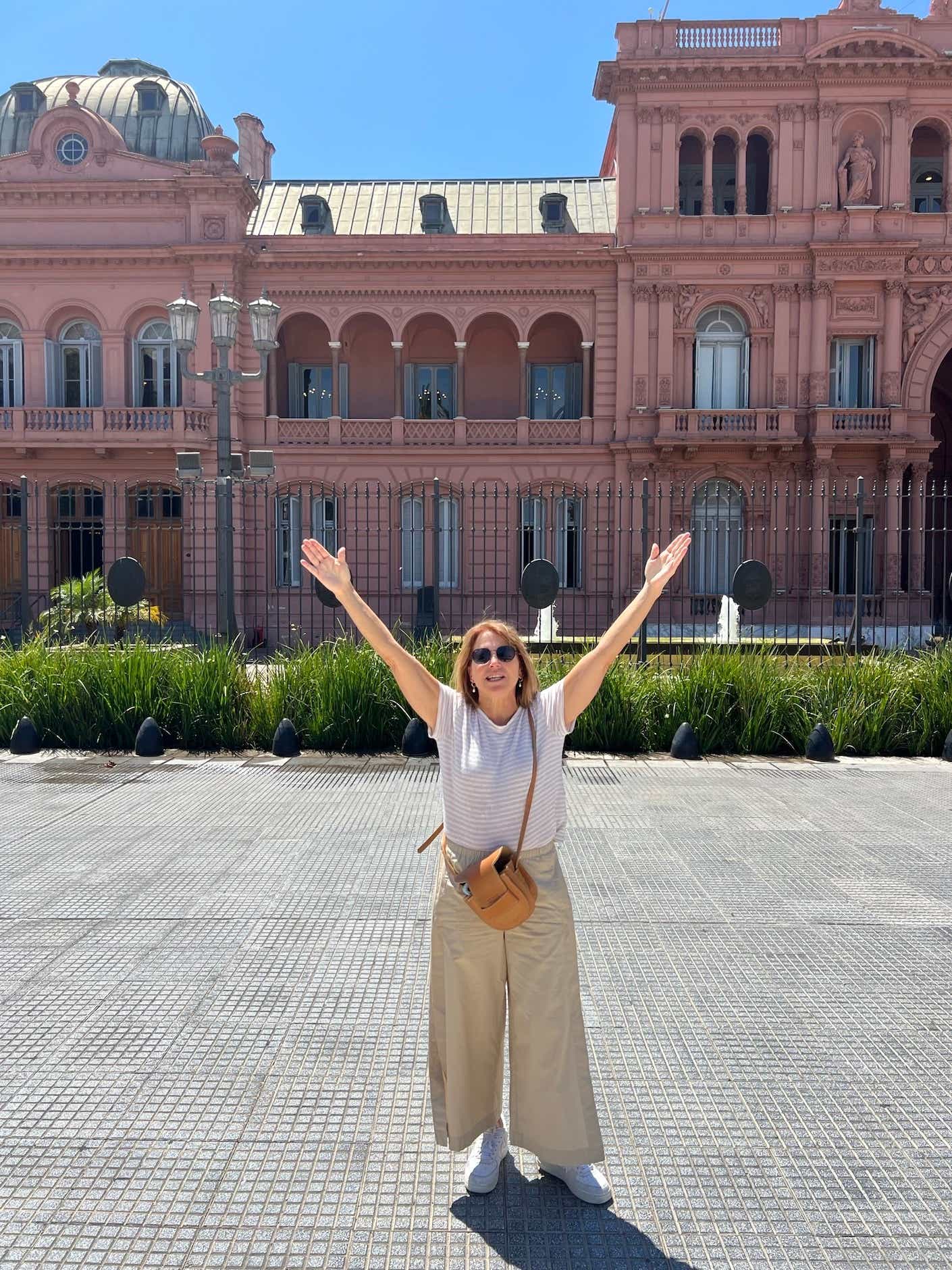
1 p.m.: Lunch at Caseros , a neighborhood favorite providing a tastefully crafted menu focusing on local flavors in a vintage, yet modern atmosphere.
Afternoon: Explore San Telmo , the city’s oldest neighborhood and the birthplace of tango. Stroll through its historic streets browsing the quirky antique shops, or sit and enjoy a coffee in Plaza Dorrego.
8:15 p.m.: Dinner at Anafe , a renowned restaurant by Mica Najmanovich and Nico Arcucci. The chefs incorporate Asian techniques into Italian dishes, using Middle Eastern flavors, and French preparations as a representation of their heritage, travels, and every country in the world. Katie says this was one of her favorite meals of the trip: “Delicious steak, fresh tomato salad, wonderful bread, and all kinds of small plates in a very residential neighborhood. Delish!”
Late evening: Cocktails at Rey de Copas , a renowned bar located in the vibrant neighborhood of Palermo Soho.
Take a domestic flight to Bariloche , “Patagonia’s most charming town,” according to Travel + Leisure. Check into the second hotel of the trip, the beautiful Villa Beluno .
1 p.m.: Lunch at Avellana , the hotel’s restaurant, which specializes in dishes inspired by French and Italian cuisine and uses fresh ingredients from the villa’s very own greenhouse.
4 p.m: Head to the Llao Llao Peninsula for a hike through the Coihue forest, enjoying the placid views of the lake through the clearings in the evergreen trees. Along the way, Katie and John stopped in the middle of the woodlands for a tasting of Mate , an herbal beverage whose name rhymes with “latte.” Katie felt it was an acquired taste, but she was glad to give it a try!
8 p.m.: Dinner at Anima , one of the top restaurants of Bariloche’s culinary scene, focusing on simple yet exquisite dishes using local ingredients. Guests feel at home in the cozy, cabin setting of the restaurant, tucked into the woods in the Circuito Chico area of the Llao Llao Peninsula.
10:30 a.m.: After breakfast, head to López Bay, a beautiful area along the shores of Lake Nahuel Huapi to enjoy a hiking excursion. Head up the peaks to the Los Palotinos, a spectacular look-out point over the Tristeza arm of Lake Nahuel Huapi, where you will have a panoramic view of the area, or take an easier route. Either way, a picnic in this breathtaking spot is a must!
Late afternoon: Return to the hotel to clean up, rest, relax, and perhaps even enjoy a spa treatment.
8 p.m.: Dinner at La Masia , an intimate lakeside restaurant located on the Llao Llao Peninsula, offering a cozy atmosphere with simple, yet satisfying meals and excellent service.
10 a.m.: Following breakfast, take a boating excursion to Lake Nahuel Huapi. Stop at Victoria Island to hike through the wooded areas and trails facing the blue lake, then enjoy a picnic lunch.
Late afternoon: Return to your hotel for a swim, a massage, or just a rest.
8:30 p.m.: Dinner at Il Gabbiano , an intimate Italian restaurant serving both international and regional cuisine with a Mediterranean approach.
8:30 a.m.: Head to Rincón Chico for a fishing excursion in the Limay River, the largest drainage basin in the region. It usually yields both medium-sized migratory rainbows and brown trout.
Early afternoon: Disembark at Estancia Rincón Grande, a captivating Patagonian ranch flanked by a picturesque landscape and majestic mountains in the distance. Enjoy a Patagonian lunch cooked using the traditional curanto method, which involves cooking food underground, with meals prepared in a 30-centimeter pit.
Late afternoon: Go horseback riding to explore the semi-arid region near the property with low vegetation, adapted to limited rainfall and known for its unique wildlife.

8:30 p.m.: Dinner at Cerveceria Patagonia . Bariloche is the center of Argentine beer culture, thanks in part to its German and Swiss heritage. Patagonia is one of its finest breweries, with excellent beers and a beautiful location on the wooded peninsula.
Morning: Take a domestic flight to El Calafate , a city on the southern border of Lake Argentino. Check into Eolo , a small and intimate hotel with unbelievable vistas of the surrounding landscape, and enjoy lunch at the lodge.
Afternoon: Choose between hiking or horseback riding on the mountainside of the surrounding valley, providing you with an excellent introduction to the Southern Patagonian landscape. Then return to the hotel to freshen up.
7 p.m.: At the hotel lodge, enjoy a wine tasting followed by a gourmet dinner with expansive views of the sun setting over the Patagonian steppe. Eolo’s restaurant utilizes regional Argentine produce while applying international gastronomic techniques and aesthetics.
10 a.m.: Head to Los Glaciares National Park , a UNESCO World Heritage Site. Enjoy a boating tour around the south face of the Perito Moreno Glacier and witness pieces of ice “calving” from it. As you glide along parallel to the glacier, you will be struck by the sheer height of this spectacular wall of ice.
Afternoon: Transfer to the spectacular catwalks and balcony facing the Perito Moreno Glacier to enjoy the panoramic perspective of this natural wonder. Afterward, enjoy a picnic lunch on the catwalks in front of the glacier itself.
Evening: Once you’ve returned to your hotel, take a load off and enjoy a delicious dinner at Eolo’s restaurant.
8 a.m.: Head to Puerto Bandera, where you will board a boat to Estancia Cristina for a day of stunning exploration. On the way, cruise toward Upsala Glacier for a frontal view. On the way you will navigate through breathtaking scenery, dodging icebergs. Keep an eye and ear out for falling ice pieces and moving icebergs!
Mid-morning: Arrive at Estancia Cristina for a 4×4 excursion up the mountains through the forest. Along the way, enjoy an incredible panoramic view of the Upsala Glacier.
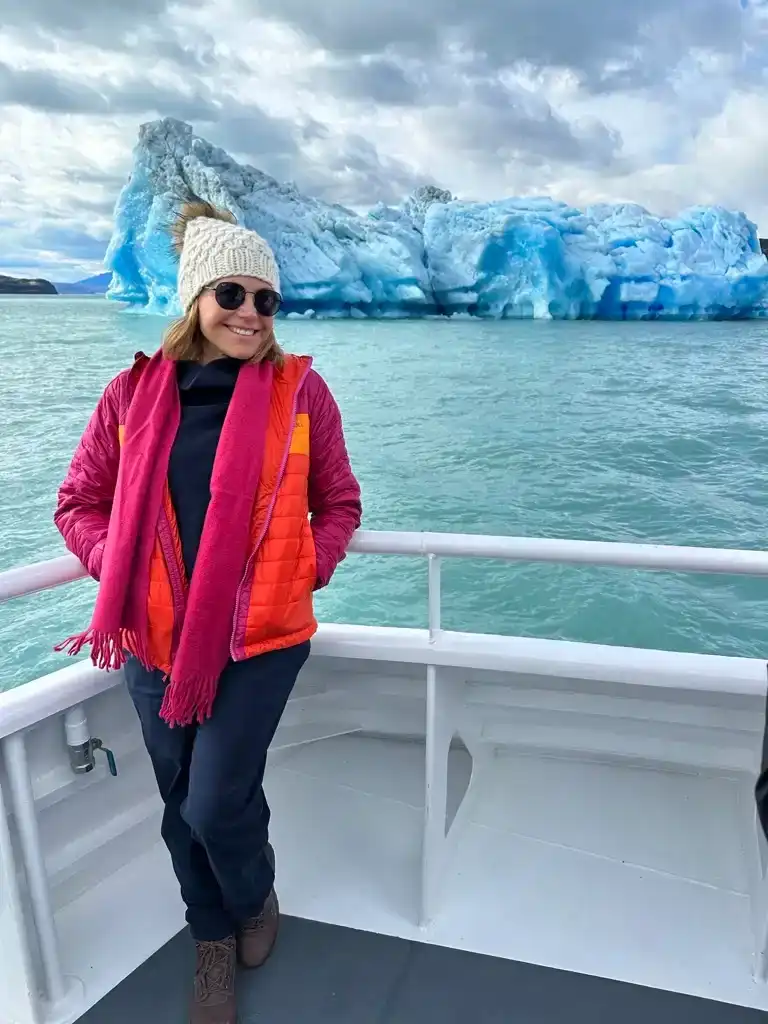
Afternoon: Hike to the top of the mountain and back down to the estancia, a four-hour trek downhill through the forest, surrounded by impressive views of the beautiful Patagonian landscape, and witness ancient fossils in the rock formation. Along the way, stop mid-hike and enjoy a boxed lunch.
Late afternoon: Finish the day with a boat ride back to Puerto Bandera, then return to the hotel.
Evening: Enjoy yet another magnificent dinner at the Eolo lodge.
Morning: Check out from Eolo and take a domestic flight back to Buenos Aires.
1 p.m.: Lunch at Casa Cavia , a boutique, mansion-house restaurant that brings together a somewhat unusual combination of local tastemakers — a florist, a chef, and a bookseller — under one historic roof.
3 p.m.: Visit MALBA , a beautiful museum also known as Museo de Arte Latinoamericano de Buenos Aires. One of Katie and John’s favorite finds here included a self-portrait of Frida Kahlo.
5:30 p.m.: After wrapping up at the museum, head to the airport and have a quick dinner while you prepare to board your flight home.
Want more great content?
Sign up here to jumpstart your mornings with Katie's dynamic daily newsletter, Wake-Up Call.
Sign up here:
By joining you accept KCM Terms of Service & Privacy Policy
Trending Products

Dermelect Neck Cream

J.Crew Bathing Suit
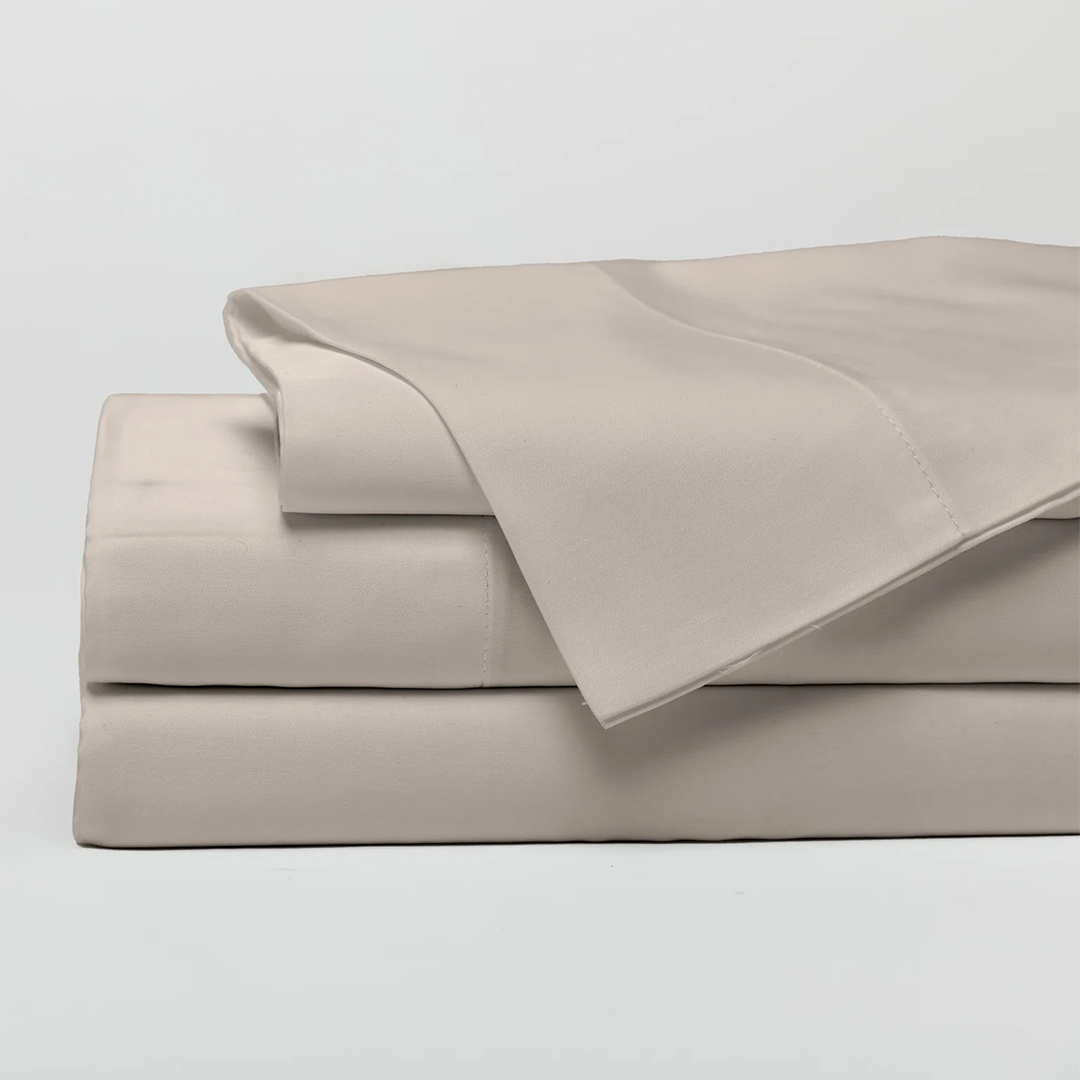
Cozy Earth sheets
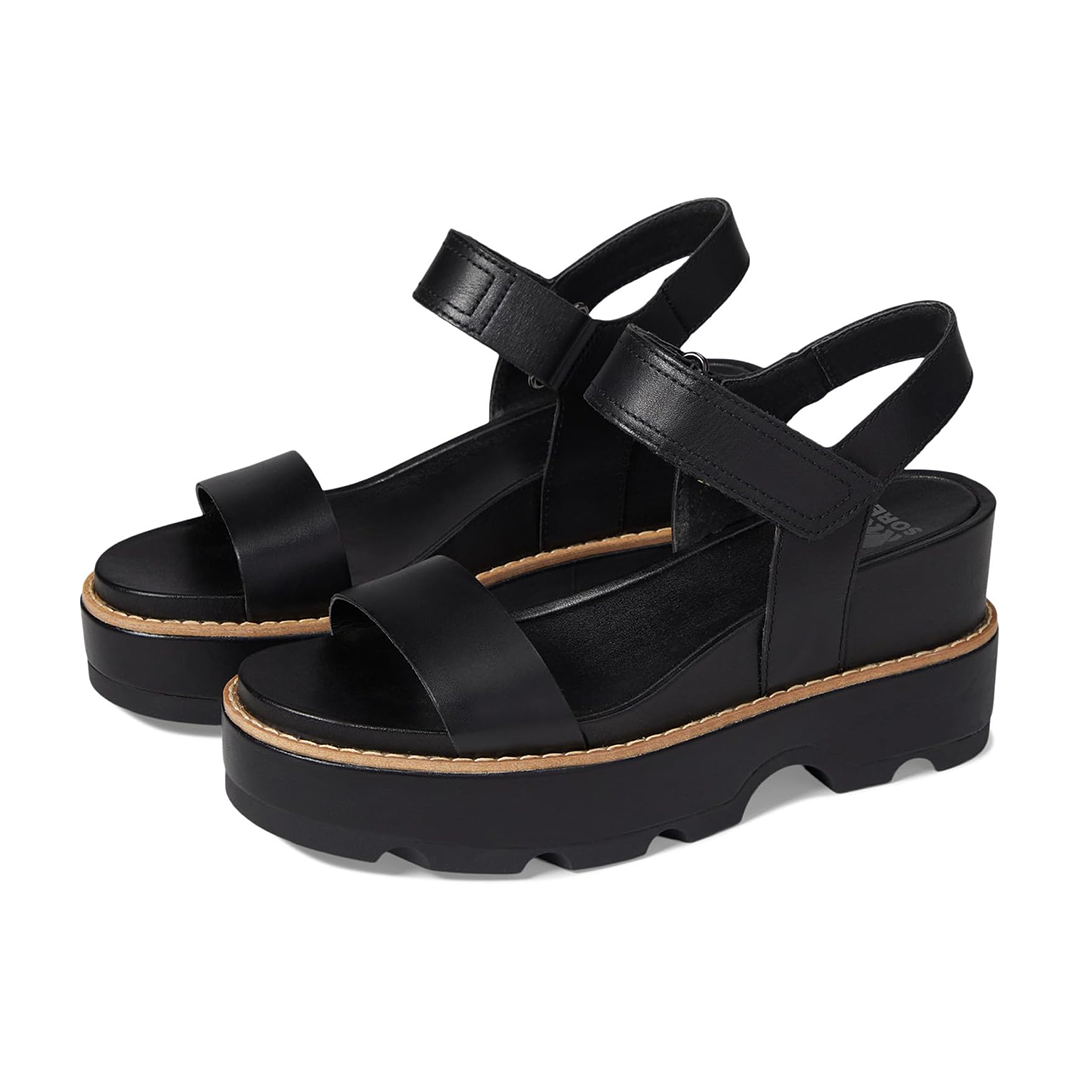
Sorel Sandals
News by katie, right in your inbox..
Know It All™! Daily updates from me, Katie Couric, on the news that matters most to you.
By registering for this event you accept Katie Couric Media’s Terms of Service & Privacy Policy . You also agree to receive email communications including Katie Couric's morning newsletter, Wake-Up Call.
You're registered to this event, you'll find all the details in your inbox

Passing Thru Travel
15 Best Places in Patagonia To Visit in 2024
Posted: February 24, 2024 | Last updated: February 24, 2024
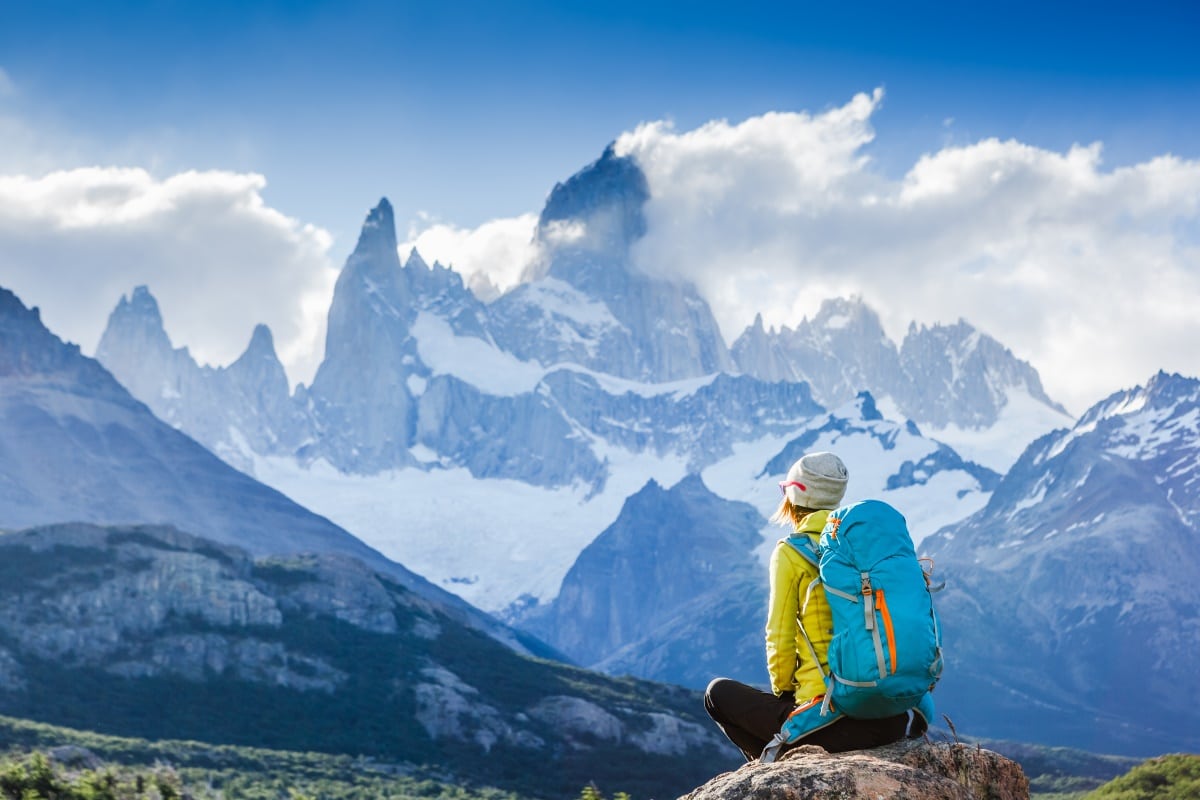
Patagonia, a region shared by Argentina and Chile, is a land of awe-inspiring natural beauty. Known for its rugged landscapes, towering mountains, and pristine glaciers, Patagonia is a haven for adventurers and nature lovers alike. This guide takes you through the most breathtaking destinations in Patagonia, each offering a unique experience of this wild and untamed region. Patagonia’s diverse landscapes promise an unforgettable journey from the iconic Torres del Paine to the remote Tierra del Fuego.
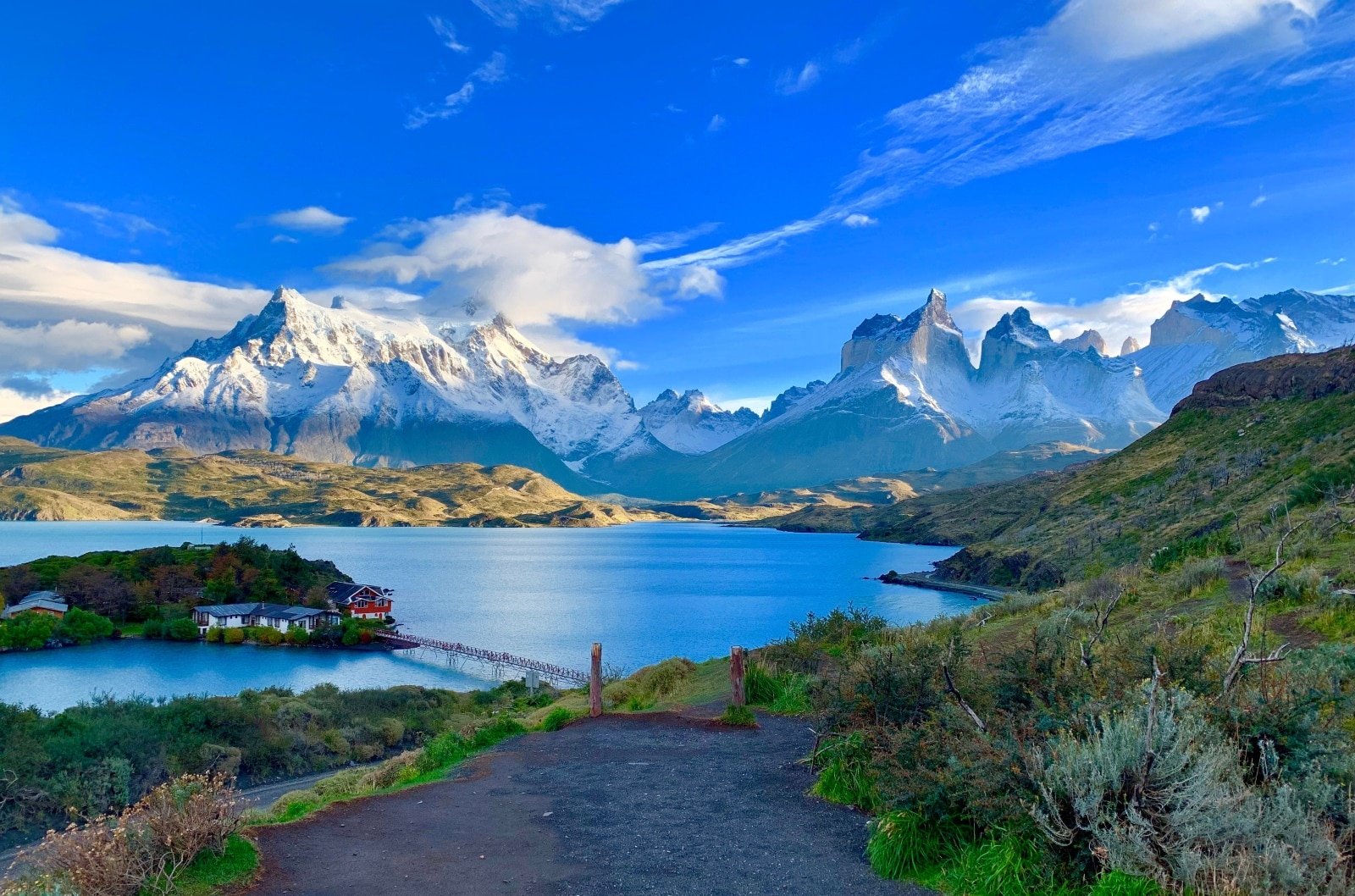
1. Torres del Paine National Park, Chile
Torres del Paine National Park, a highlight of Chilean Patagonia, is renowned for its dramatic peaks, bright blue icebergs, and vast pampas. The park’s network of trails, including the famous W Trek and the O Circuit, offers some of the world’s best trekking experiences. Hikers are treated to stunning views of the park’s namesake towers, the Paine Massif, and the Grey Glacier. The diverse ecosystems within the park, from steppe to subpolar forests, are home to an array of wildlife, including guanacos and condors.
Insider’s Tip: Book refugios or campsites well in advance if you plan to trek.
When To Travel: The best time to visit is during the Southern Hemisphere’s summer, from November to early March.
How To Get There: Fly to Punta Arenas in Chile and then take a bus or a rented car to the park.
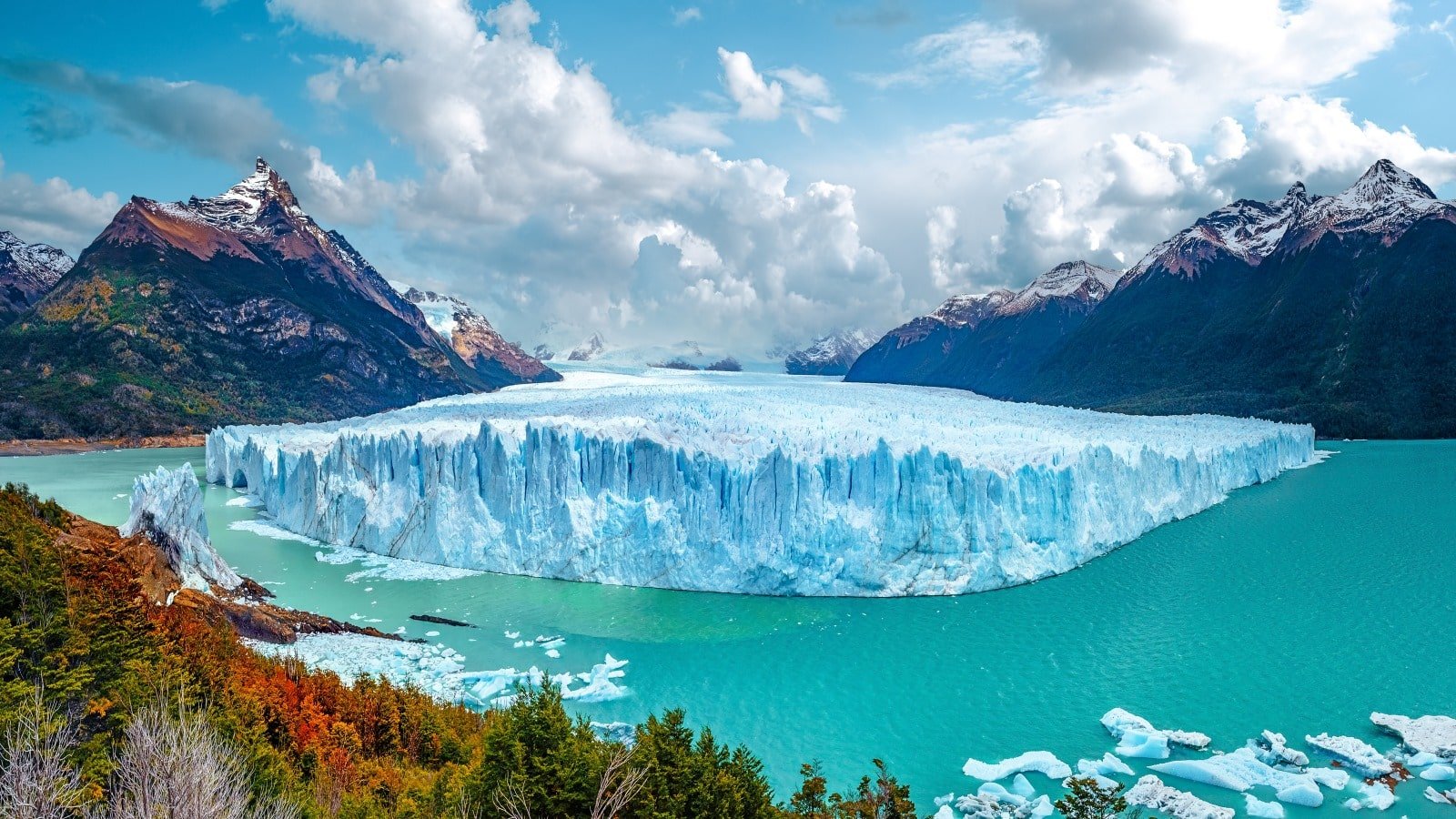
2. Perito Moreno Glacier, Argentina
The Perito Moreno Glacier, part of Argentina’s Los Glaciares National Park, is one of the most accessible and dynamic glaciers on the planet. Visitors can witness the awe-inspiring sight of ice calving from the glacier into Lake Argentino. The park offers various viewing platforms and boat tours for different perspectives of this natural wonder. Unlike many other glaciers worldwide, Perito Moreno is one of the few still growing, making it a particularly fascinating site for glaciology enthusiasts.
Insider’s Tip: Take a guided glacier walk on the ice for a memorable experience.
When To Travel: Visit between October and April for milder weather.
How To Get There: Fly to El Calafate in Argentina, and then it’s a short drive to the glacier.
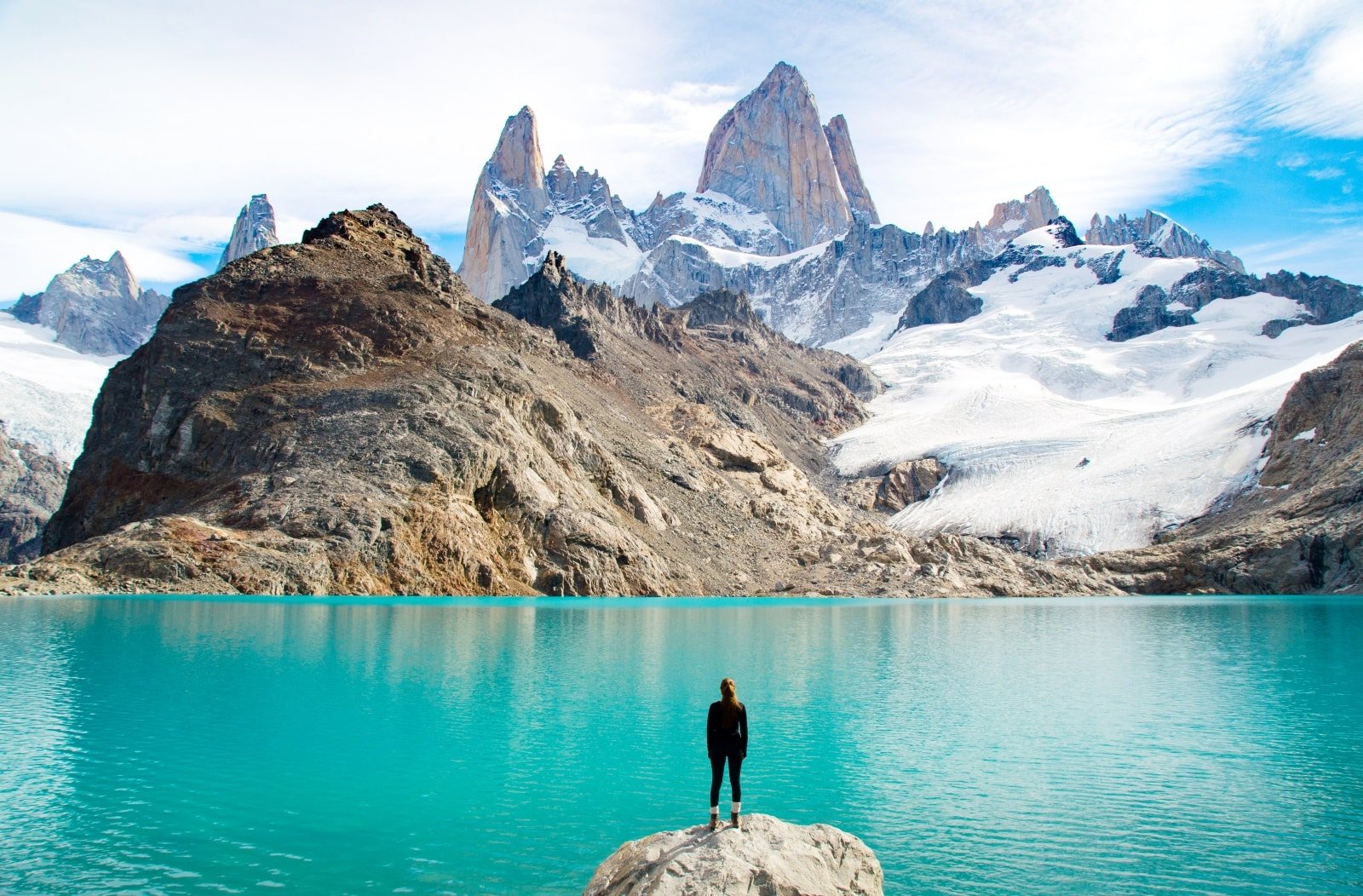
3. Fitz Roy Mountain, Argentina
Fitz Roy Mountain, near the small town of El Chaltén, is a paradise for experienced hikers and climbers. The mountain’s iconic jagged peaks present one of the world’s most challenging and rewarding climbs. For those seeking less strenuous activities, numerous trails like Laguna de los Tres offer breathtaking views of Fitz Roy and the surrounding Patagonian landscape. The town of El Chaltén itself is a charming base for exploring the region, with cozy accommodations and local eateries.
Insider’s Tip: Start your hike early in the morning to avoid crowds and enjoy the best views.
When To Travel: Trekking season runs from November to April.
How To Get There: Fly to El Calafate and then take a bus to El Chaltén.
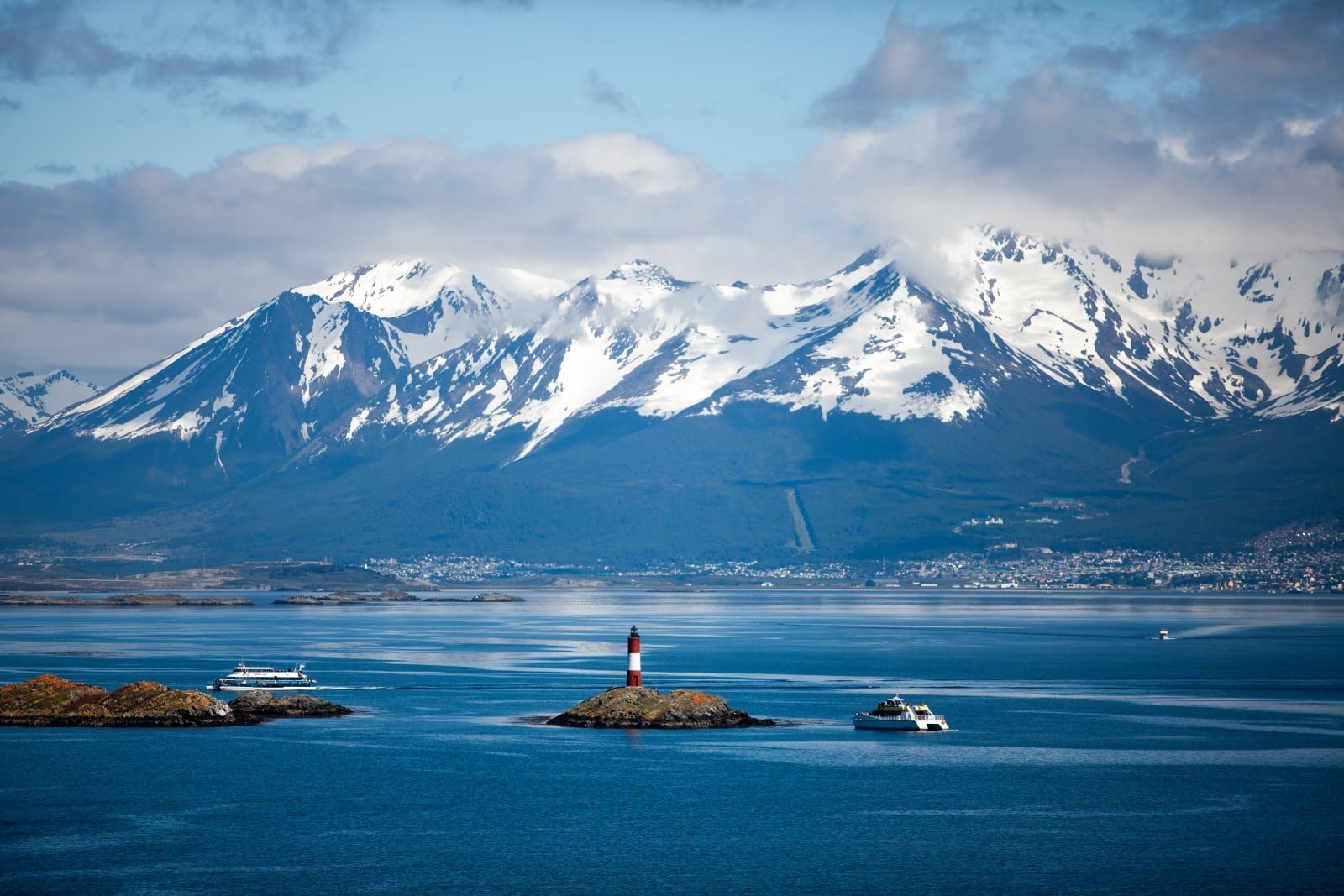
4. Tierra del Fuego, Argentina and Chile
Tierra del Fuego, an archipelago off the southern tip of South America, is a land of stark contrasts and extreme beauty. Ushuaia, the world’s southernmost city, is the gateway to this remote region. Here, visitors can explore the Tierra del Fuego National Park, take boat trips along the Beagle Channel, or embark on expeditions to Antarctica. The region’s unique flora and fauna, including Magellanic penguins and Andean foxes, make it a fascinating destination for wildlife enthusiasts.
Insider’s Tip: Visit the End of the World Museum in Ushuaia to glimpse the area’s history.
When To Travel: The best time is during the Southern Hemisphere’s summer, from December to March.
How To Get There: Fly to Ushuaia from major cities in Argentina or Chile.
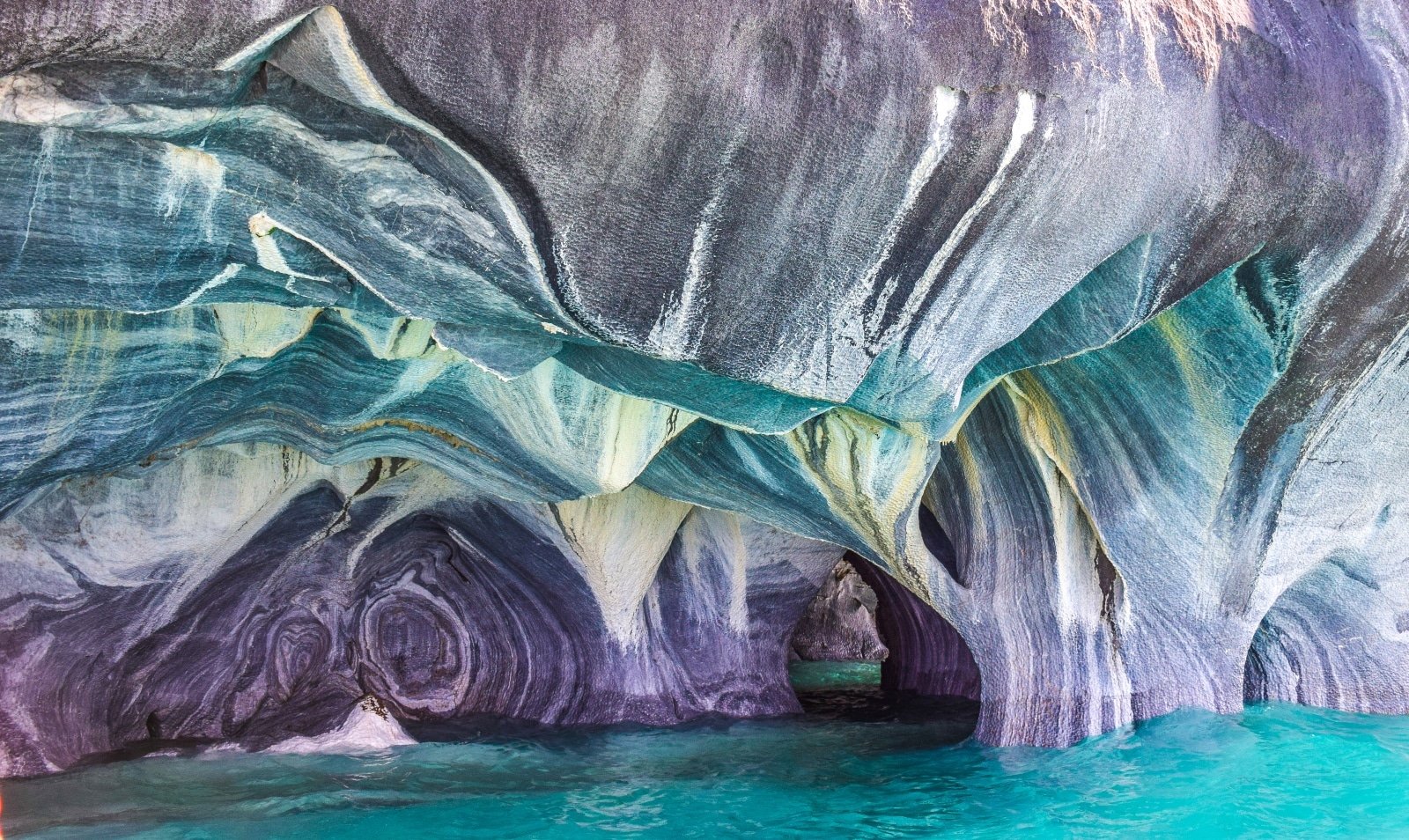
5. Marble Caves, Chile
The Marble Caves on Lake General Carrera are a breathtaking natural formation. Millennia of waves washing against calcium carbonate have sculpted these caves into stunning formations. The caves’ walls, with their swirling patterns of blue and grey, are a photographer’s dream, especially when reflected in the lake’s azure waters. Accessible only by boat, the caves offer a serene and otherworldly experience.
Insider’s Tip: Take a boat or kayak tour for the best views of the caves.
When To Travel: Visit between September and February for the best weather.
How To Get There: Fly to Balmaceda, then drive to Puerto Río Tranquilo, where tours to the caves are available.
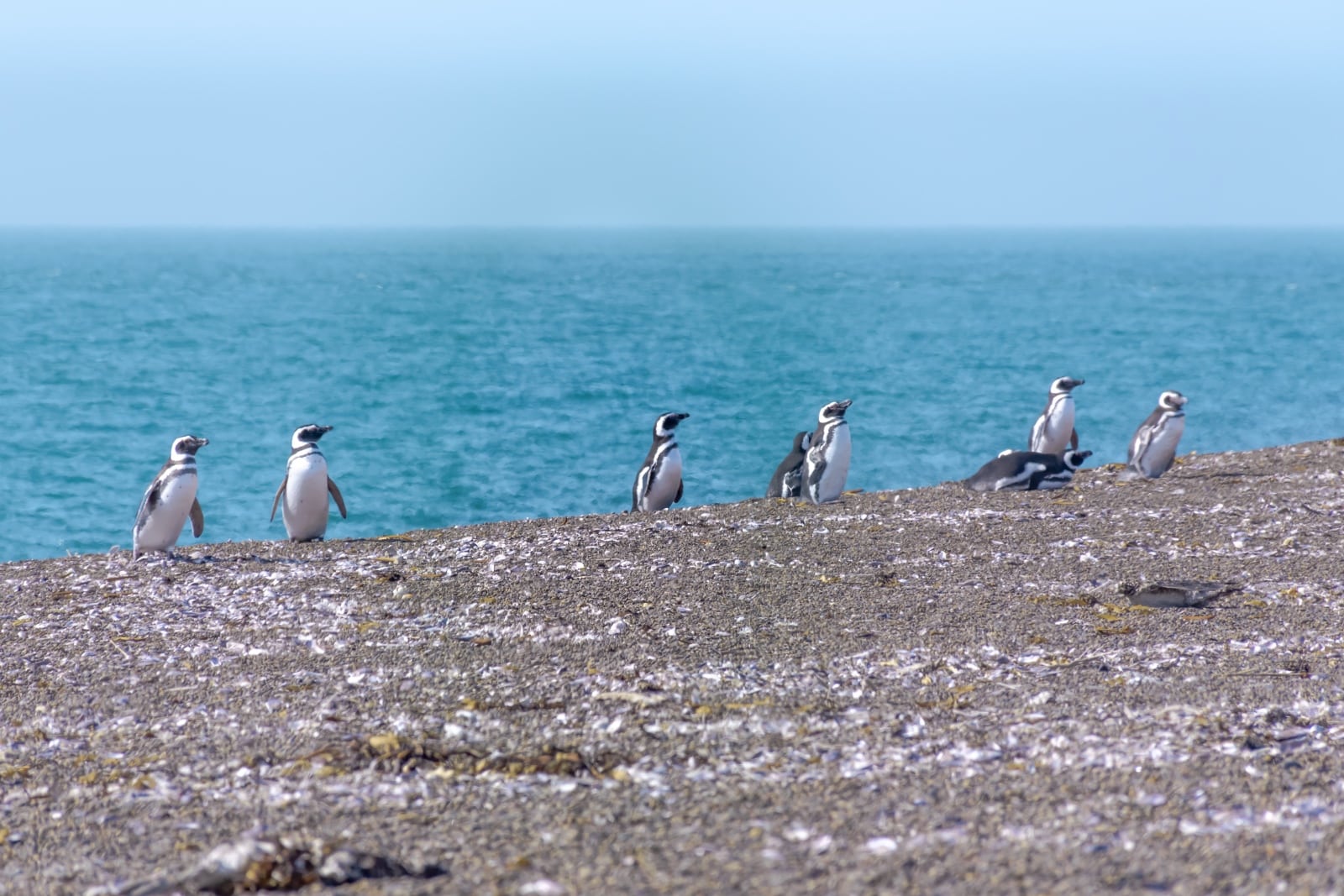
6. Valdés Peninsula, Argentina
Image Credit: Shutterstock / Natalia Di Marco The Valdés Peninsula is a UNESCO World Heritage Site celebrated for its unique marine wildlife and rugged coastline. It’s one of the best places in the world to see Southern Right Whales, which come close to shore between June and December. The peninsula also hosts large colonies of sea lions, elephant seals, and various bird species. Its steppe-like interior and dramatic coastline offer stunning landscapes and excellent wildlife viewing opportunities.
Insider’s Tip: Take a whale-watching tour between June and December to see Southern Right Whales.
When To Travel: Wildlife viewing is best from September to March.
How To Get There: Fly to Puerto Madryn or Trelew, then drive to the peninsula.
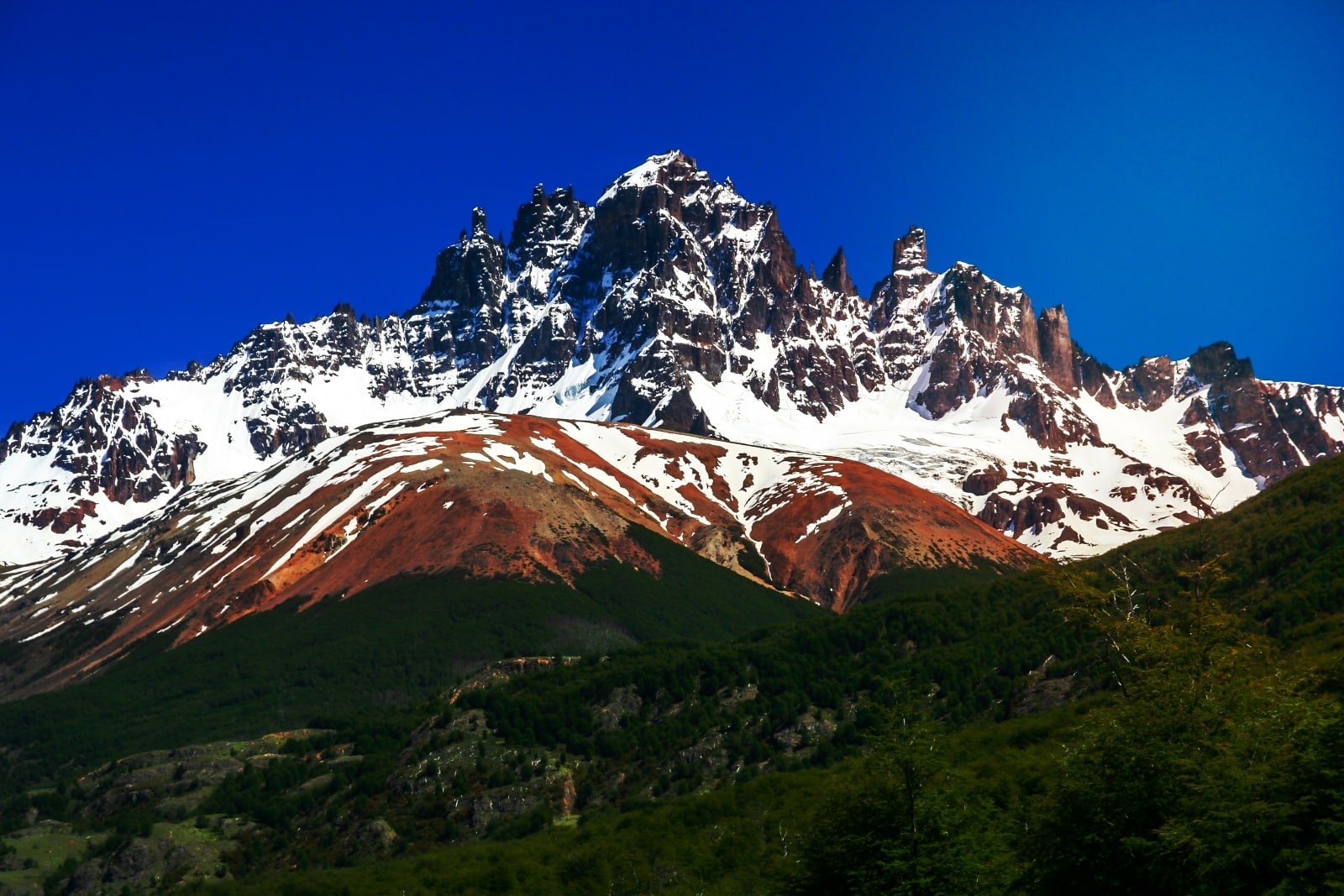
7. Cerro Castillo, Chile
Cerro Castillo, less crowded than Torres del Paine, offers equally stunning scenery for those willing to venture off the beaten path. The trek around Cerro Castillo takes you through diverse landscapes, including forests, alpine meadows, and high mountain passes, with the castle-like peaks of Cerro Castillo as a constant backdrop. The trek is challenging but rewards hikers with incredible views of glaciers, turquoise lakes, and the Patagonian wilderness.
Insider’s Tip: Pack for all weather conditions, as the weather can change rapidly.
When To Travel: The trekking season is from November to April.
How To Get There: Fly to Balmaceda and then drive or take a bus to Villa Cerro Castillo.
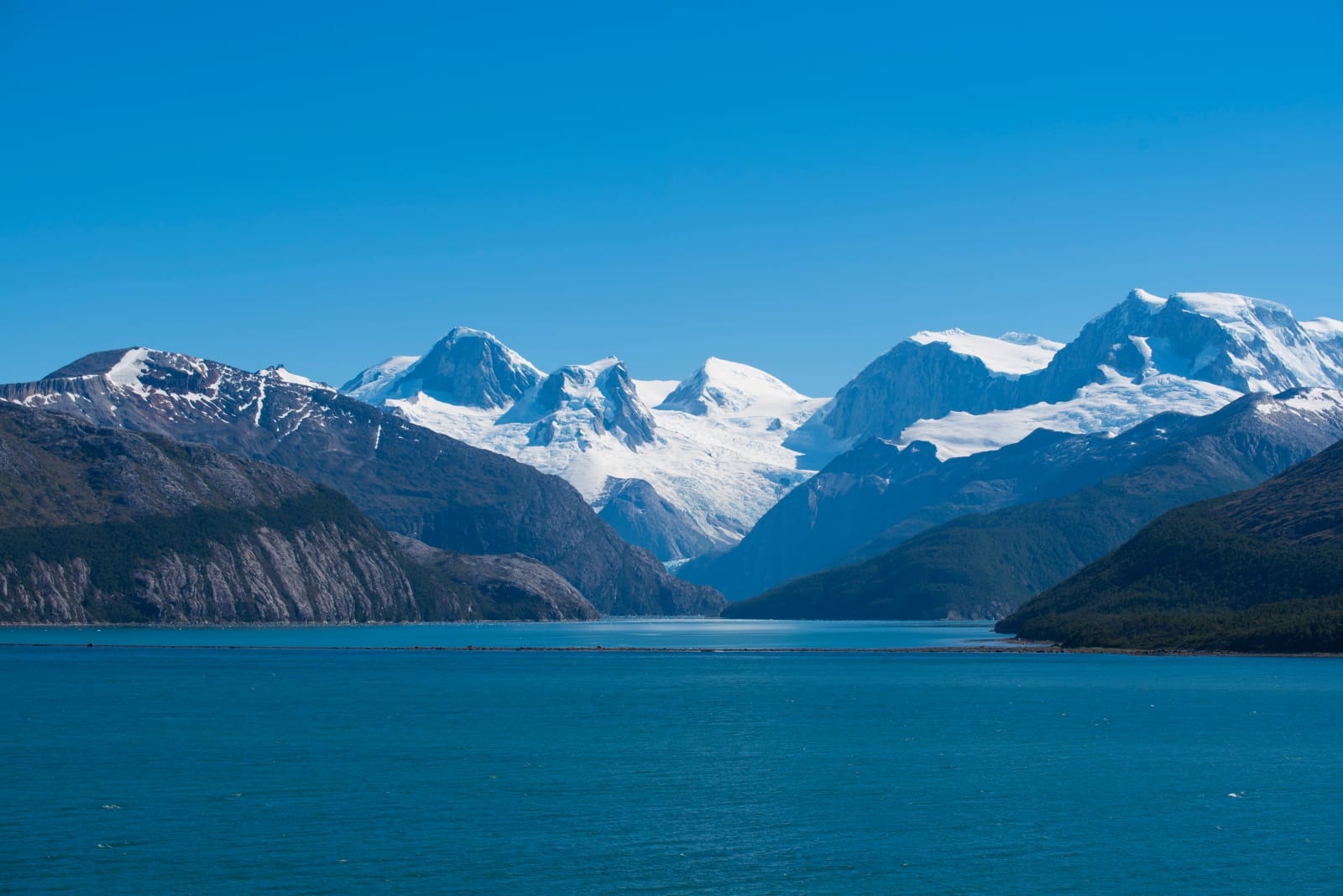
8. Cape Horn, Chile
At the southernmost tip of the South American continent, Cape Horn is a legendary location known for its challenging sailing conditions and rich maritime history. Cruises to this remote area offer a unique opportunity to experience the wild beauty of the southern seas and the sense of adventure that comes with reaching the “end of the world.” The area is also significant for its unique flora and fauna adapted to harsh conditions.
Insider’s Tip: Choose a cruise that includes lectures on the region’s history and wildlife.
When To Travel: Cruises run during the Southern Hemisphere’s summer, from December to March.
How To Get There: Cruises to Cape Horn typically depart from Ushuaia.
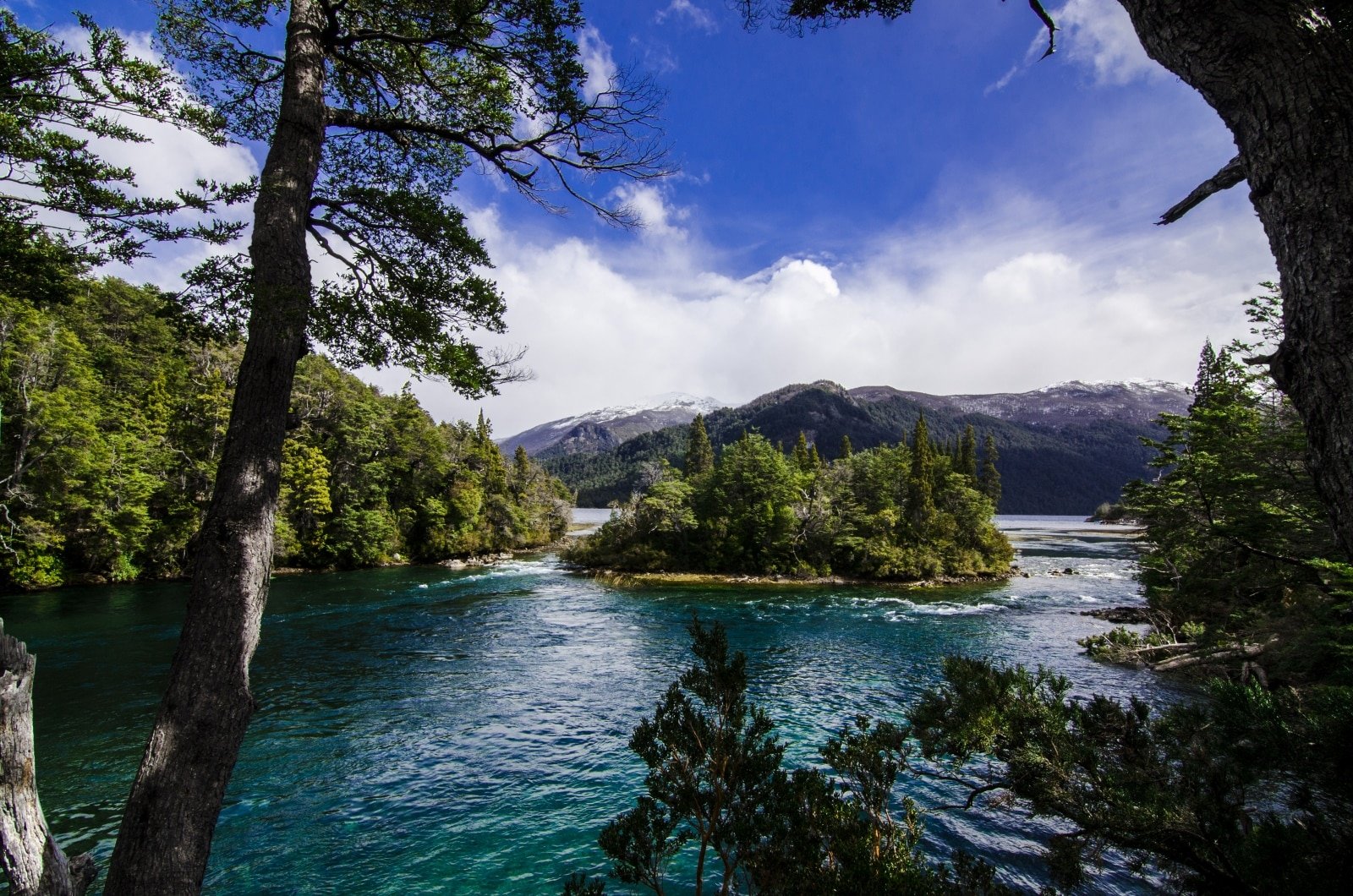
9. Los Alerces National Park, Argentina
Los Alerces National Park, a UNESCO World Heritage Site in Argentina, is known for its ancient Alerces trees, some of which are over 3,000 years old. The park’s lakes, rivers, and forests offer a serene setting for hiking, kayaking, and fishing. The park is a testament to Argentina’s commitment to conservation, with well-maintained trails and minimal-impact tourism practices. The park’s diverse ecosystems are home to various wildlife, including deer, pumas, and several bird species.
Insider’s Tip: Explore the Arrayanes Forest for a magical walk among unique cinnamon-colored trees.
When To Travel: Visit from October to April for the best weather.
How To Get There: Fly to Esquel and then drive to the park.
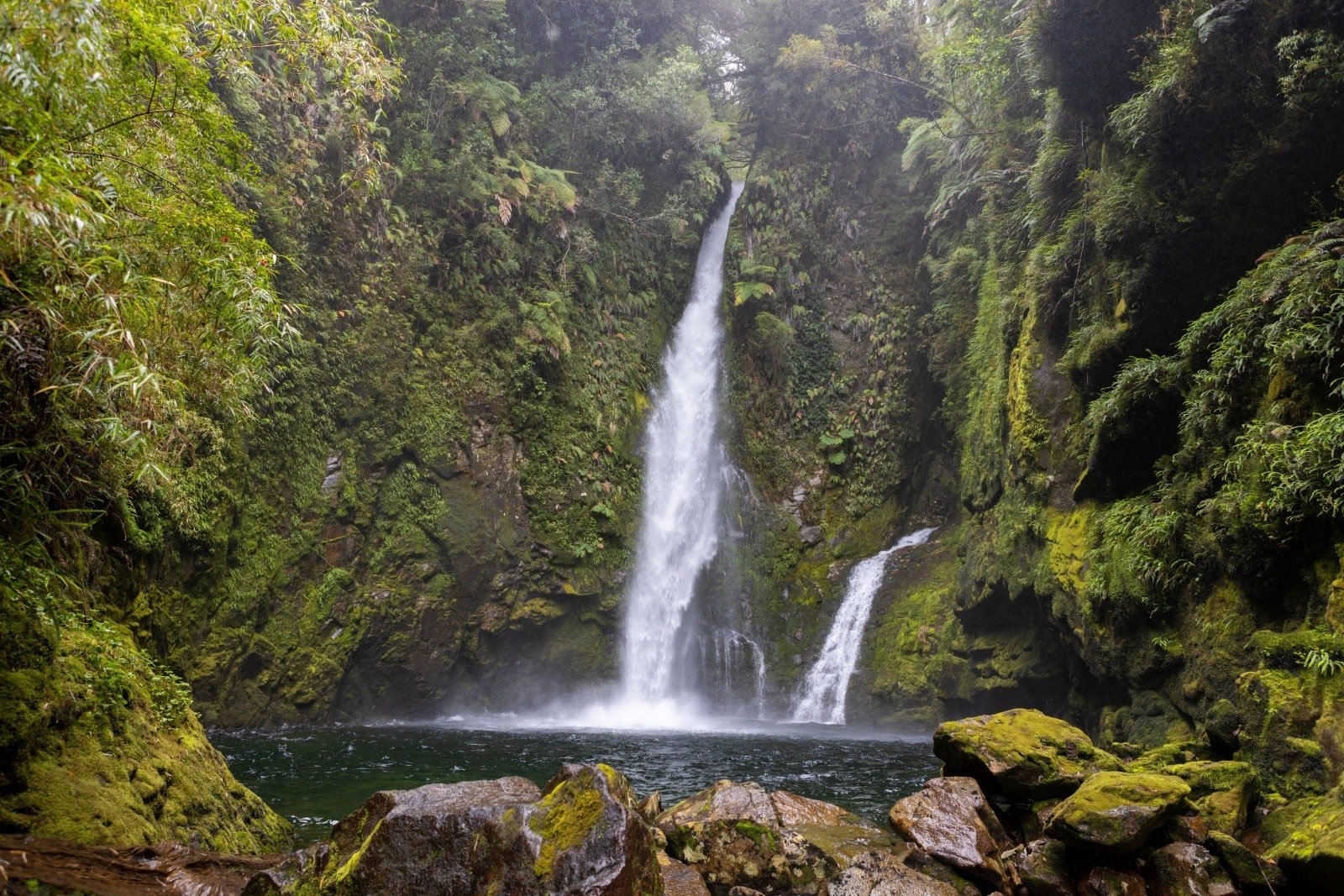
10. Pumalín Park, Chile
Pumalín Park, one of the largest private parks in the world, is a testament to conservation efforts in Chilean Patagonia. Created by conservationist Douglas Tompkins, the park spans over 400,000 hectares of temperate rainforests, fjords, and waterfalls. Visitors can hike through pristine forests, kayak along untouched fjords, and witness the park’s commitment to environmental preservation firsthand. The park’s infrastructure, including trails and campgrounds, is designed to minimize human impact on the environment.
Insider’s Tip: Visit the park’s environmental information centers to learn about its conservation efforts.
When To Travel: The best time to visit is from December to March.
How To Get There: Fly to Puerto Montt, then drive or take a ferry to the park.
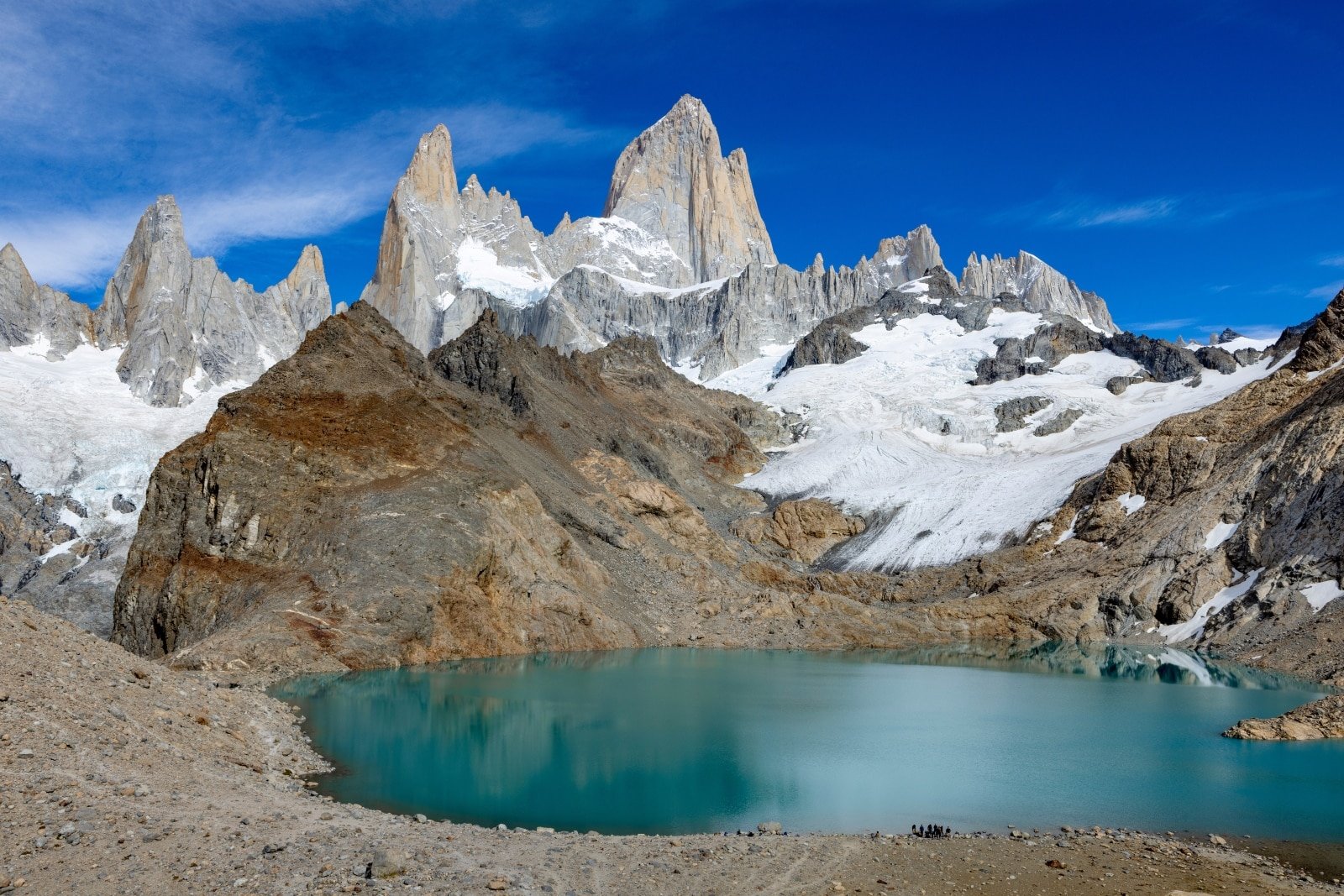
11. El Chaltén, Argentina
El Chaltén, often called Argentina’s trekking capital, is the gateway to some of Patagonia’s most iconic trails. The town offers a range of trekking options, from easy day hikes to challenging multi-day expeditions. The surrounding landscapes of glaciers, lakes, and mountains provide a stunning backdrop for outdoor activities. In addition to trekking, visitors can enjoy rock climbing, horseback riding, and fishing.
Insider’s Tip: Visit the Los Condores viewpoint for a stunning panoramic view of the town and surrounding peaks.
When To Travel: Trekking season is from October to April.
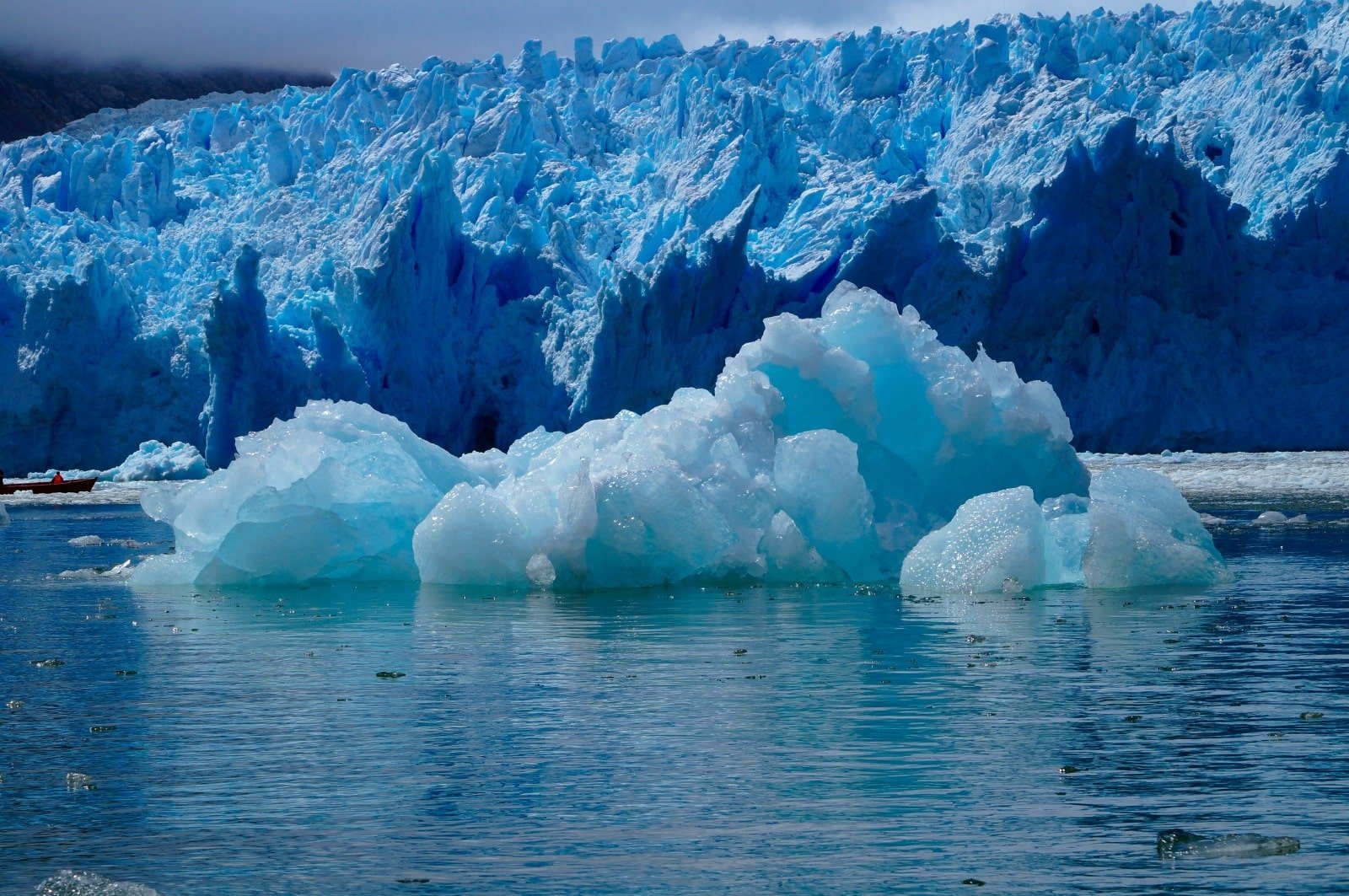
12. Laguna San Rafael National Park, Chile
Laguna San Rafael National Park is home to the San Rafael Glacier, one of the largest and most actively calving glaciers in the Chilean Patagonia. The park offers boat tours that provide close-up views of the glacier and the icebergs in the lagoon. The park’s remote location and stunning ice landscapes make it a must-visit for adventure seekers and nature enthusiasts. Visitors can also explore the surrounding rainforests and spot wildlife such as sea lions and dolphins.
Insider’s Tip: Take a boat tour that includes visiting the hot springs at Quitralco Fjord.
When To Travel: The best time for boat tours is from October to April.
How To Get There: Access is mainly by boat or plane from Coyhaique or Puerto Chacabuco.
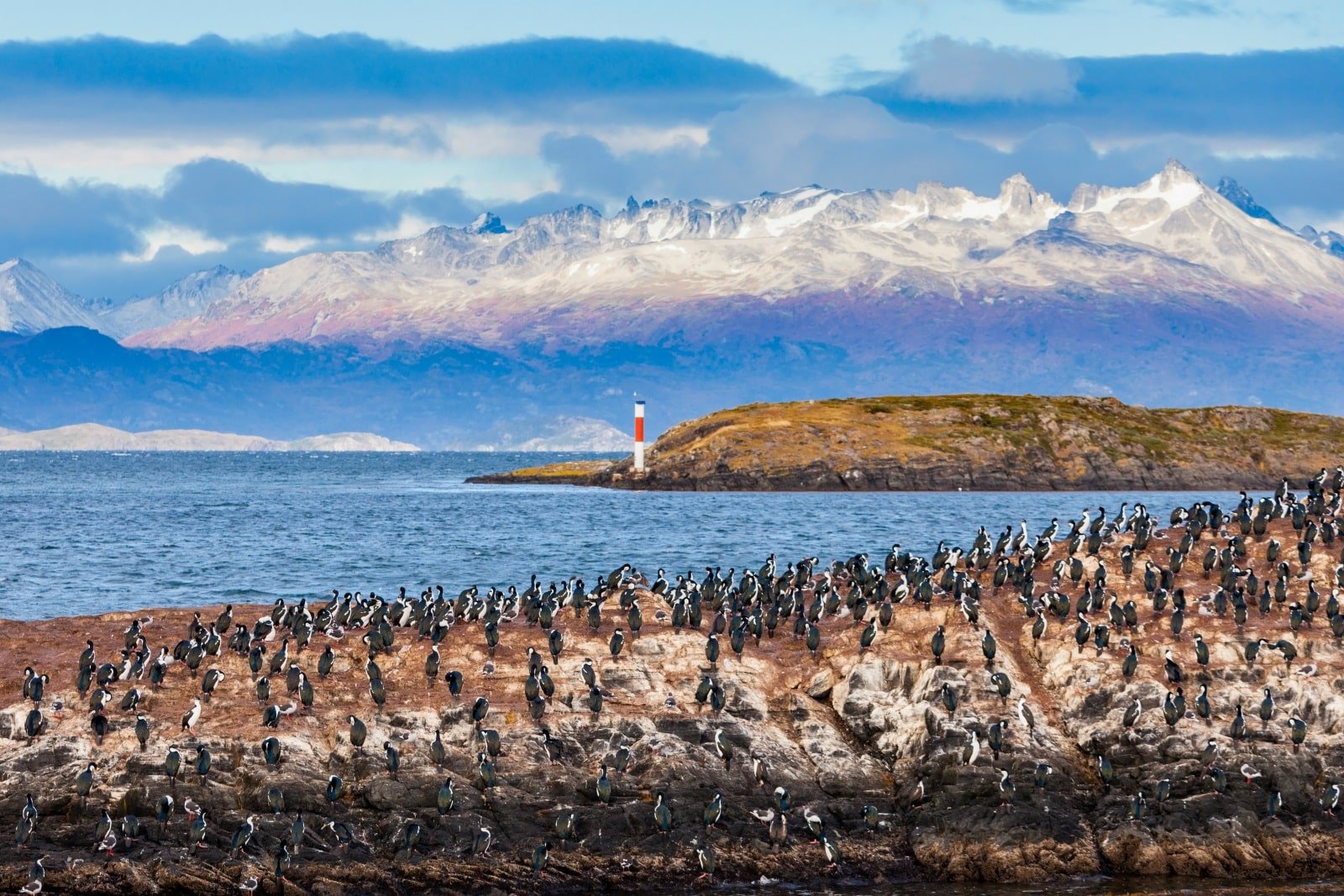
13. King Penguin Colony, Tierra del Fuego, Chile
The King Penguin Colony on the Chilean side of Tierra del Fuego offers a unique opportunity to observe these majestic birds. Located at Parque Pingüino Rey, the colony is one of the few places outside Antarctica where you can see king penguins in their natural habitat. The park provides a respectful and sustainable way to observe the penguins, with designated viewing areas to minimize disturbance.
Insider’s Tip: Respect the penguins’ space and observe them from a distance to avoid disturbing them.
When To Travel: Penguins can be seen year-round, but the best time is during the breeding season, from September to March.
How To Get There: Fly to Punta Arenas, take a ferry and drive to the park.
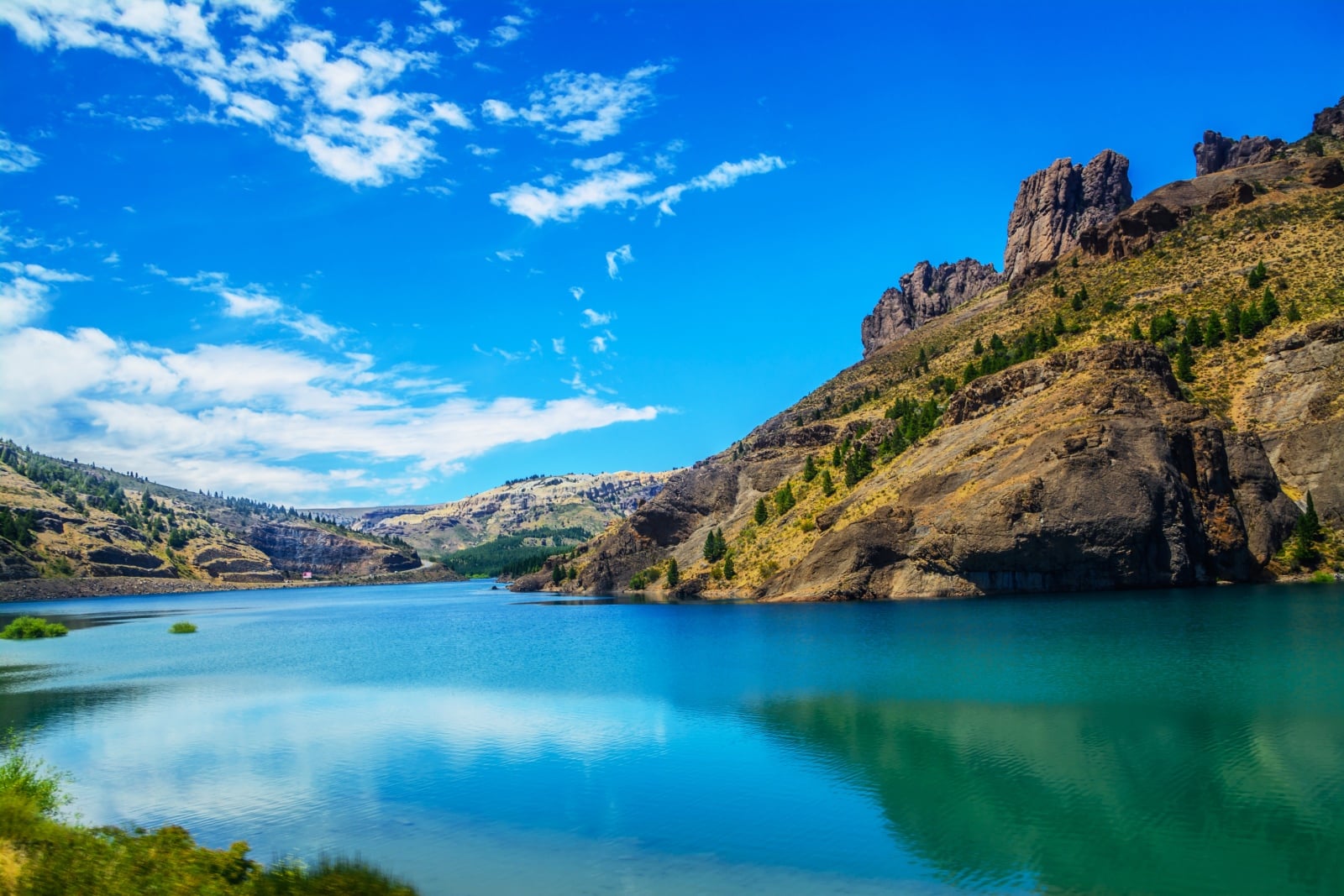
14. Bariloche, Argentina
San Carlos de Bariloche, known simply as Bariloche, offers a unique combination of stunning natural landscapes and a lively city atmosphere. Bariloche is located in Argentina’s Lake District, a hub for outdoor activities like hiking, kayaking, and mountain biking. The city’s Swiss-style architecture and renowned chocolate shops add to its charm, making it a popular destination year-round. In winter, Bariloche transforms into a ski resort, while the summer months are perfect for exploring the surrounding lakes and mountains.
Insider’s Tip: Take the cable car to Cerro Campanario for one of the best views in the region.
When To Travel: Visit from December to March for outdoor activities and pleasant weather.
How To Get There: Fly to Bariloche Airport, with regular flights from Buenos Aires.
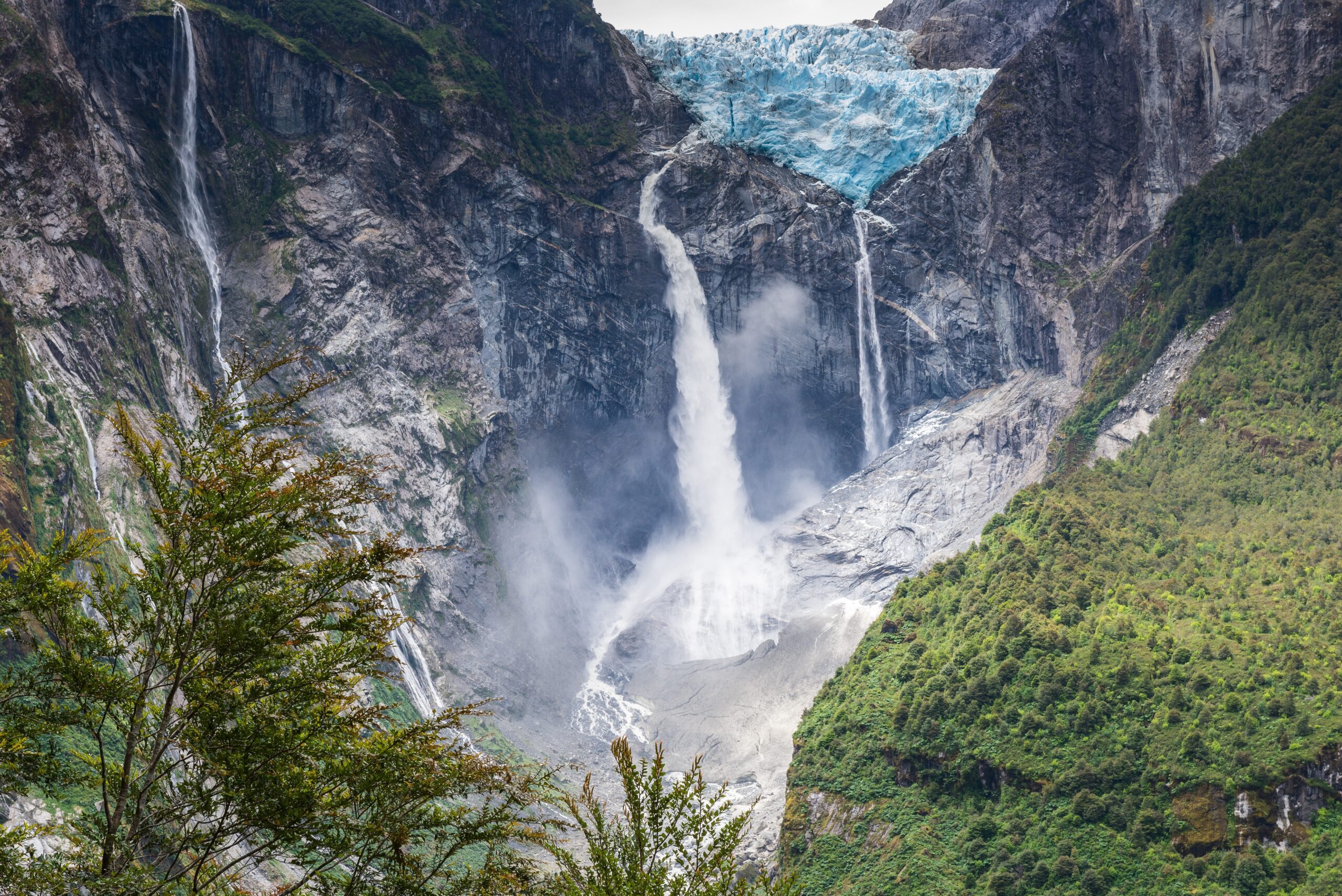
15. Aysén Region, Chile
The Aysén Region in Chilean Patagonia is a secluded paradise for adventurers. Less crowded and largely untouched, it offers a wilderness experience that includes the Northern Patagonian Ice Field and numerous fjords. The Carretera Austral, a scenic route through the region, leads to remote beauty spots ideal for hiking, kayaking, and fishing. Aysén’s rugged terrain and pristine landscapes are perfect for those seeking an immersive nature experience away from tourist trails.
Insider’s Tip: Plan a road trip along the Carretera Austral for a unique way to explore the region’s diverse landscapes.
When To Travel: The best time to visit is during the Southern Hemisphere’s summer, from December to March.
How To Get There: Fly to Balmaceda Airport and rent a car for the best exploration experience.
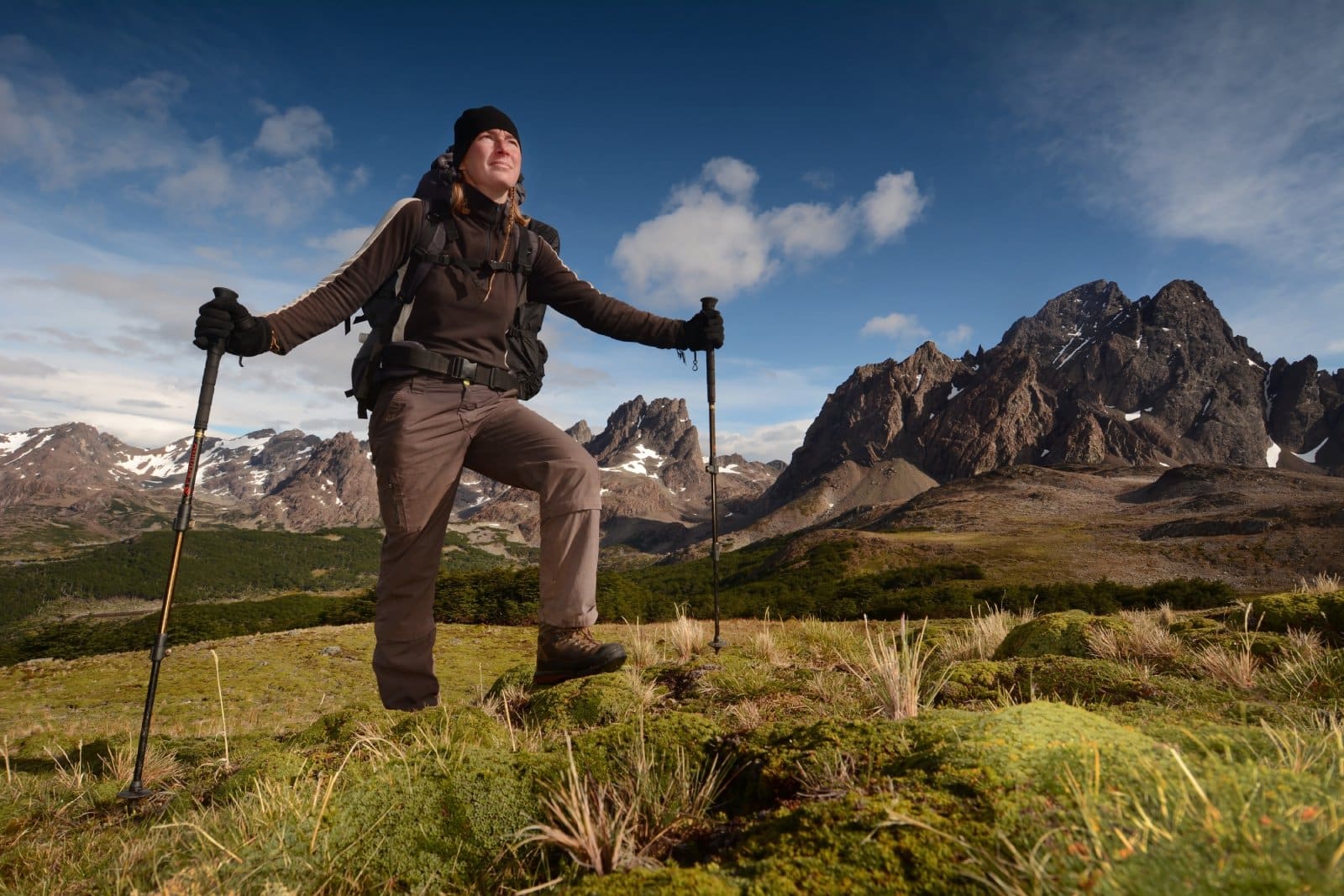
The Bottom Line
Patagonia is a land of endless natural wonders, offering experiences that range from witnessing colossal glaciers to trekking through pristine forests. Each destination in this vast region presents an opportunity to connect with nature and witness the raw beauty of one of the world’s most spectacular landscapes. As you plan your journey through Patagonia, remember that the true essence of this place lies in its wild and untamed spirit, inviting you to explore and discover its many treasures.
More Articles Like This…
Barcelona: Discover the Top 10 Beach Clubs
2024 Global City Travel Guide – Your Passport to the World’s Top Destination Cities
Exploring Khao Yai 2024 – A Hidden Gem of Thailand
The post 15 Best Places in Patagonia To Visit in 2024 republished on Passing Thru with permission from The Green Voyage .
Featured Image Credit: Shutterstock / Olga Danylenko.
For transparency, this content was partly developed with AI assistance and carefully curated by an experienced editor to be informative and ensure accuracy.
More for You
Fact Check: Rare Photo Depicts Country Music Icon Dolly Parton Without Signature Full Face of Makeup?
14 Decent Paying Jobs That Most People Think They Are Too Good For
Coffee recalled nationwide due to risk of fatal food poisoning
This Is the Average 401(k) Balance for Ages 55 to 64
How to Remove a Tree Stump Painlessly
Elon Musk confirms 12th child as he and Shivon Zilis welcomed new baby earlier this year
A millennial couple who ditched van life to buy a $150,000 hoarder house said it's worth it. Take a look inside.
Here’s how much profit McDonald’s makes on its new $5 meal
So THAT'S Why Singers Lose Their Accent When They Sing
Health expert shares best times for breakfast and dinner if you want to lose weight
Forgotten Fame: 20 Celebrities Who Disappeared from Hollywood
A Better Way to Zero and Sight in Your Rifle
I’m a Bank Teller: 7 Reasons You Shouldn’t Keep More Than $3,000 in a Checking Account
Ranked: America’s most beautiful cars
Dog Treat Recall Prompts Nationwide Warning to Pet Owners
We’ve been accidentally cooling the planet — and it’s about to stop
‘I feel slighted’: My husband and I are in our 70s. We married 3 years ago. He’s leaving his $1.8 million home to a 10-year-old relative. Is that normal?
8 Tips for Reducing Sodium
I spent 6 years living on The World, a cruise ship for millionaires. It was like the Four Seasons on steroids — readjusting to reality was tough.
Tesla owner discovers frustrating scene at supermarket charging station: 'It happened the day before as well'
An ex-Wall Street banker who's visited every country shares 6 places where you can spend less and still travel in luxury
- Lee Abbamonte, 45, is an ex-Wall Street banker who has visited every country in the world.
- When it comes to destinations where dollars go the furthest, Southeast Asia is his go-to.
- In Bangkok, Abbamonte paid less than $50 a night for a Shangri-La hotel and loved the street food.

This summer is shaping up to be one of the hottest on record for the US economy .
Household wealth is at a record high, the job market is strong, and wages are rising faster than inflation. Meanwhile, the dollar has steadily gained against rival currencies. Simply put, Americans have dollars to spend. One question they might have: Where, oh where, to spend it?
Lee Abbamonte has some suggestions. Abbamonte, who quit his Wall Street finance job to become a travel blogger in 2002, has visited every country in the world, every US state , plus the South and North Poles.
Abbamonte's go-to for getting the most bang for your travel buck is Southeast Asia .
In countries like Thailand, Vietnam, and Cambodia, luxury hotels can cost under $100 a night and street food can be as delicious as fine dining, Abbamonte said.
One downside is that traveling to Southeast Asia from the US can take anywhere from 15 hours to more than a day.
"The hardest part is getting there," added Abbamonte, who last visited the region between 2017 and 2019. "But once you're there, you're in heaven."
Here, Abbamonte shares six countries — in Southeast Asia and beyond — where your vacation budget can buy some indulgent splurges.
During a past trip to Thailand, Abbamonte stayed in a five-star hotel for less than $50 a night.
Thailand is one of Abbamonte's favorite destinations in Southeast Asia, for good reason.
In Bangkok, he said, street food is world-class and high-quality yet inexpensive compared to comparable meals in the US. Abbamonte stayed at several stunning hotels along the Chao Phraya River, which flows through the heart of the city.
"I remember I paid like $39 for the Shangri-La," he said.
A one-night stay at the Shangri-La in Bangkok is a bit more expensive now, according to its website : $162 as of June 2024.
Outside Bangkok, Abbamonte can't get enough of Phuket, an island off the west coast of mainland Thailand brimming with rainforest and white sandy beaches that look straight out of a postcard.
"Some of the best hotels I've ever stayed at in my life are in Phuket," he said. His favorite is Kata Rocks, an oceanfront five-star hotel that is "one of the most beautiful places" Abbamonte has ever been.
"I don't remember exactly what it cost, but it wasn't that much," Abbamonte said, estimating that he spent "around $100" a night.
In July 2024, a one-night stay at Kata Rocks in Phuket costs more than $490 according to its website . That may not seem cheap, but villas in more expensive locations like the Caribbean can cost a lot more.
Vietnam is exceedingly affordable for its stunning vistas and delicious delicacies, he said.
Vietnam is one of Abbamonte's top countries in South Asia, where "the food is cheap and easy, and it's fantastic."
The country is home to some awe-inspiring natural wonders, including Ha Long Bay, which you can explore via luxury overnight cruises with amenities like pools, jacuzzis, and wine cellars from about $190 a night.
"Ha Long Bay, near Hanoi, is one of the most beautiful places in the world," Abbamonte said.
Tourists can also get great deals, he added, in the artsy and history-rich city of Hanoi, the coastal city of Da Nang, and Vietnam's southern capital, Ho Chi Minh City.
In Ho Chi Minh City, Abbamonte recommends stopping by the War Remnants Museum. Known locally as the American War Museum , an adult ticket costs 40 Vietnamese dong, or around $1.50.
Home to exhibits on the Vietnam War and the First Indochina War, Abbamonte said it's his "favorite" museum outside the US.
Money goes a long way in Cambodia, home to a world-class beach scene that relatively few know about.
Another one of Abbamonte's favorite places to splurge without spending too much is Cambodia.
Sandwiched between Thailand and Vietnam, the country is affordable in all the ways that its neighbors are but is more off the beaten path.
"There aren't the tourists you get in Thailand and Vietnam," Abbamonte said.
Most tourists visit Cambodia to see Angkor Wat, an ancient Hindu-Buddhist temple complex near the city of Siem Reap. Abbamonte said the temple, which costs $37 to visit for a day, is worth seeing, but added that the country has so much more to offer.
"There's a lot more going on outside Angkor Wat," he said. "They have nice beaches, and they've really improved their infrastructure."
Some of the most idyllic seaside spots are situated on the tiny islands off of the coastal city of Sihanoukville, like Saracen Bay, a beach on Koh Rong Samloem.
Argentina has some amazing steakhouses that are generally more affordable than their US counterparts.
Abbamonte said many Americans sleep on Argentina, but that it's one of the most affordable, exciting, and pleasant places to visit in South America.
He's particularly fond of Patagonia, a region of mountains, glacial lakes, grasslands, and rainforests that runs through both Argentina and Chile across the southernmost tip of South America.
It's as close to paradise as it gets for Abbamonte, who loves being outdoors — and it doesn't hurt that food and accommodation are inexpensive.
"You can go down there and live it up real cheaply," he added.
The capital of Buenos Aires is also a must-see, Abbamonte added, because it's home to an array of luxury hotels and high-quality steakhouses where American dollars go a long way.
One of his favorite eateries is La Cabrera, a steakhouse in the trendy Palermo Soho neighborhood of Buenos Aires that offers a daily 40% happy hour discount on food and drinks between 6:30 p.m. and 8 p.m. (One blogger who reviewed their La Cabrera meal during a 2023 trip said, at the time, a 21-ounce ribeye cost the equivalent of $45.)
"I'm a meat eater," Abbamonte admitted. "So if you like steak, there's really nowhere better."
Ethiopia offers affordable safari options in awe-inspiring wildlife reserves.
"Ethiopia is one place that I love," Abbamonte said. "It's definitely in my top five African countries."
In the past, he's flown into the capital city of Addis Ababa and stayed in five-star hotels for $100 a night. "They're really, really nice, and you can eat world-class meals for virtually nothing," he added.
While booking safari-type vacations can be "pretty expensive," Abbamonte said more adventurous travelers can always consider camping, which he did during his first trips 20 years ago.
At the time, he said, buying supplies, organizing transport within the park, and getting camping permits cost him between $100 and $200.
For example, foreign tourists visiting the Simien Mountains National Park pay 90 birrs, or around $1.50, for a 24-hour pass and an additional 40 birrs, less than $1, to camp in a tent with up to four people.
Compared to some luxury lodges, it's incredibly affordable, and "you get all the same animals," Abbamonte said, adding that he felt completely safe, given all the park rangers roaming around.
Abbamonte said there's never been a better time to visit Japan, one of his favorite countries in the world.
Japan isn't typically the first country that comes to mind for affordable travel, but Abbamonte said it's never been a better time to book a trip because, as of June 25, $1 buys 159.72 yen.
It's one of the best conversion rates in recent history.
"It's as cheap as it's ever been for the American dollar right now," Abbamonte said. "In Tokyo, the hotels are slashed to a third less than they normally are."
For example, at the Hilton Tokyo, a five-star hotel in the bustling Shinjuku district, one-night stays start at under $300 a night, according to its website .
Abbamonte said Japan is worth the trek — and the steeper prices compared to Southeast Asia — for the unique experiences it offers.
From the Kobe beef in Kobe and the bustling streets of Tokyo to the omakase scene in Osaka and the tranquility and history of Kyoto, there's "nowhere" in Japan Abbamonte doesn't like.
"It's probably the best country in the world," he said.
- Main content

IMAGES
VIDEO
COMMENTS
For an overland trip, you can rent a car, organize a private transfer, or catch a bus. The bus company Bus-Sur connects Puerto Natales, Chile, and El Calafate, Argentina, daily during the tourist ...
A first-time guide to Patagonia, Argentina. Sep 26, 2023 • 7 min read. Expert travel advice for first-time travelers to the Patagonia region of Argentina, including top destinations, when to go, must-do activities and more.
The Patagonia region of Argentina, which includes the southernmost third of the country all the way south to Ushuaia, the most southerly city in the world, delivers all of that and more. Travel to Patagonia - a geographic area divided between Argentina and Chile at the bottom of South America - can be tricky to plan and confusing to navigate.
Covering a massive chunk of southern Chile and Argentina, Patagonia is packed with outdoor adventure. It has some of South America's best hiking, white water rafting, horseback riding, and wildlife-spotting, but it also gives you the opportunity to dig deeper - into its history, into cowboy culture, and even into the unexpected world of fusion dining at the end of the world.
Kyle McCarthy|Sharael Kolberg December 4, 2023. Ranking of the top 12 things to do in Argentine Patagonia. Travelers favorites include #1 Argentine Lake District, #2 Atlantic Patagonia and more.
When it comes time to compensate your guide, the official currency is the Argentine peso (ARS). The peso is weak compared to the U.S. dollar: 1 ARS amounts to approximately $0.25 USD. Seafood is a ...
From Buenos Aires to Bariloche and the northern tip of Patagonia, it's a 22-hour journey that can cost from $38,000 ARS ($108 USD). From Bariloche, it's a further 26 hours to 23 hours to El Chaltén ($62,000 ARS ($177 USD), where there are onward connections to El Calafate and Ushuaia.
Patagonia is the place that bucket lists were made for. Stretching across the southern tip of both Chile and Argentina, Patagonia is rugged, sparsely populated, and astonishingly beautiful.
El Chalten and Perito Moreno Glacier are some of the not-to-miss attractions in Argentinian Patagonia so is Torres del Paine in Chile. The suggested 10-day Patagonia itinerary gives you enough time to explore the area. You can join an organized 9-day tour that starts and finishes in El Calafate.
Visiting this region is a one-way ticket to a parallel world where the landscape captivates everyone, the gastronomy delights all taste buds, and the stimuli increase every second. Land of native fauna, national parks, and fairy-tale villages: this is what the places in Argentinian Patagonia offer. 1. 3. Must-see Attractions.
A Patagonia trip is a naturalist's dream for its rugged and untouched beauty. Argentina and Chile form the southern cone of South America, and the best Patagonia tours include both countries, with their diverse and incredible landscapes.Visit Perito Moreno Glacier in the Calafate region, take a Torres del Paine tour to explore its towering granite peaks, or take a trip to Ushuaia, the world ...
These two Patagonia travel itineraries for one week include hiking Patagonia's most famous trails, such as the W trek in Torres del Paine National Park, Chile and around El Chaltén, Argentina, as well as a visit to the mesmerising Perito Moreno Glacier. Patagonia itinerary for one week of travel: Hike the W in Torres del Paine National Park
My Patagonia highlights. Day 1: Buenos Aires to El Chalten: Hike to Mirador Condores. Day 2: Laguna de Los Tres hike (El Chalten) Day 3: Laguna Torre (El Chalten) Day 4: Perito Moreno Glacier (El Calafate) Day 5 Patagonia itinerary: Puerto Natales. Day 6 - 10: W Trek (Torres Del Paine) Other places to visit in Patagonia.
A vast and remote region in South America that 402,000 square miles across Argentina and Chile, Patagonia is naturally divided by the Andes, though most of it — about 90% — is Argentinian. ... Long-distance buses that are very comfortable and designed for trips of 24 hours or more are a great way to travel between these small southern ...
1. Bariloche and Nahuel Huapi National Park, Argentina. Argentine Patagonia's northernmost tip, Bariloche (sometimes known as San Carlos de Bariloche) is the country's self-declared capital of hiking. Bariloche is easily one of Patagonia's adventure hubs, with hiking, cycling, skiing, and much more on offer.
Top travel destinations while visiting Argentinian Patagonia. Patagonia isn't just one destination. It's hundreds. They're all wedged into this 400,000-square mile (1,036,000-sq km) block of South America, ranging from the spiked Andean peaks to wave-lashed shorelines.
More Argentina & Chile travel info. For more ideas on travel in Patagonia, check out our guide to 10 beautiful places in Patagonia and this article on visiting Patagonia in every season. If you could use some one-on-one help planning your itinerary, schedule a Patagonia travel consultation with our Local Expert! Best places to visit in Argentina
Our Patagonia 10 day itinerary. Day 1 of Patagonia itinerary - Arrive in Punta Arenas. Day 2 of Patagonia itinerary - Have fun watching penguins on Isla Magdalena. Days 3, 4, and 5 of Patagonia itinerary - Enjoy the fascinating Torres del Paine National Park. Day 6 of Patagonia itinerary - Drive from Torres del Paine to El Chalten.
According to our experience touring Patagonia, to see the essentials you will need at least two weeks in Patagonia Argentina. This is to visit Ushuaia, El Calafate, El Chaltén, Bariloche and surroundings. If you only have 7 days in Patagonia Argentina, I recommend focusing on El Calafate, El Chaltén and Ushuaia.
Perito Moreno Glacier. With almost 2 weeks in Patagonia, we had enough time to visit both the Chilean and Argentine sides, even making it to Argentina's most southern city. Our Patagonia trip was divided up between three main areas- Tierra del Fuego, Torres del Paine National Park, and Los Glaciares National Park. Tierra del Fuego National Park.
The best times to visit Argentine Patagonia are October through November (springtime in the southern hemisphere) and December through February (summertime). During these months, the weather is ...
From there, you can travel to Patagonia. Bariloche, a city roughly 994 mi (1,600 km) southwest of Buenos Aires, is the entry point to the Argentine Patagonia. Two-hour flights from Buenos Aires to Bariloche (BRC) are about $70 (USD) with Fly Bondi or Norwegian Air. ... Sustainable Active Travel in Chile, Argentina and Patagonia since 1991.
Katie Couric and John Molner's 10-Day Patagonia Itinerary Day 1. Arrive in Buenos Aires and check into the hotel, the Palacio Duhau - Park Hyatt Buenos Aires.. 1 p.m.: Lunch at Los Salones del Piano Nobile, one of the hotel's stellar foodie offerings.This one specializes in modern international cuisine, and it offers lovely views for al fresco dining.
Patagonia, a region shared by Argentina and Chile, is a land of awe-inspiring natural beauty. ... When To Travel: Penguins can be seen year-round, but the best time is during the breeding season ...
Japan isn't typically the first country that comes to mind for affordable travel, but Abbamonte said it's never been a better time to book a trip because, as of June 25, $1 buys 159.72 yen.